
THE ART AND CRAFT BEHIND THE CAMERA ISSUE 017 SEPTEMBER/OCTOBER 2023 ED LACHMAN ASC•LAURENT DAILLAND AFC•TOBY STRONG•SHABIER KIRCHNER•MOLLY MANNING WALKER•ROBBIE RYAN ISC BSC MONIKA LENCZEWSKA PSC•HARIS ZAMBARLOUKOS BSC GSC•SIMON BEAUFILS AFC•DAVID PROCTER BSC•JOSÉE DESHAIES INSIDE THIS ISSUE
WINNING TIME: THE RISE OF THE LAKERS DYNASTY THE HBO ORIGINAL WINNING TIME IS NOW STREAMING ON MAX


SHOOT FILM AND STAND OUT
SHOT ON KODAK SUPER 8MM, 16MM, AND 35MM #WINNINGTIME
NEW SEASON NOW STREAMING


© Kodak, 2023. Kodak and the Kodak logo are trademarks.
©2023 Home Box Office, Inc. All rights reserved.
Rascals Publishing & Media Ltd!
Red Lion Yard, Odd Down, Bath United Kingdom BA2 2PP Tel: +44 (0) 1428 746 375
Editor-in-Chief RON PRINCE ronny@cinematography.world
Special Consultant ALAN LOWNE alan@cinematography.world
Editorial Assistant KIRSTY HAZLEWOOD kirsty@cinematography.world

Advertising Manager CLAIRE SAUNDERS claire@cinematography.world
Subscriptions & Social Media CHLOÉ O’BRIEN chloe@cinematography.world
Web Manager IAIN HAZLEWOOD iain@cinematography.world
Art Direction & Creative Kinda Stuff JAM CREATIVE STUDIOS adam@jamcreativestudios.com tim@jamcreativestudios.com
CONTACT US

News hello@cinematography.world
Ad sales & Subscriptions +44 (0) 1428 746 377
Artwork artwork@cinematography.world +44 (0) 1428 746 375 www.cinematography.world
EDITORIAL TEAM
Ron Prince has over three decades of experience in the film, TV, CGI and VFX industries, and has written about cinematography for 20 years. In 2014, he won the ARRI John Alcott Award from the BSC. He also runs the international content marketing and PR communications company Prince PR.

Darek Kuźma is a film and TV journalist, translator/interpreter, and a regular collaborator/programmer of the EnergaCamerimage Film Festival. He is an ardent cinephile who has a lifelong romance with the visual language of cinema.
Iain Hazlewood has three decades of experience in marketing and media, across music, TV/film and electronics. He writes extensively about the UK’s folk and roots music scene, and interviews DPs and manufacturers in the film world.
Kirsty Hazlewood has over two decades of editorial experience in print/ online publications, and is a regular contributor to folk/roots music website Spiral Earth.
Larissa Mori is a trained VFX artist who also writes about filmmaking, computer graphics and associated technologies. She is currently based in Lisbon.
Michael Burns has covered film, broadcast, VFX, animation and interactive design, in print and online, for 20 years, for publications including IBC Daily, Digital Arts, TVB Europe and Broadcast Tech.
Natasha Block Hicks is an artist/designer/maker, who spent a decade as a freelance film and TV camera assistant, and indulges her love for cinema and cinematography through research and writing.
Oliver Webb is a freelance journalist based in the UK, and is the founder/ editor of CloselyObservedFrames. His interests include screenwriting, British New Wave cinema and the works of Ingmar Bergman.
Seth Emmons is an American writer and communications professional who has explored the intersection of art and technology through production tools and techniques for nearly two decades.
SOMETHING’S GOTTA GIVE
Impasse. Several weeks ago, in the June/July edition of Cinematography World, we noted the Hollywood strikes. At the time of writing this column, things have not changed, despite tentative talks, and the deadlock continues. We send our thoughts to everyone who has been negatively impacted, and hope for a swift resolution.
In this edition we have gone globetrotting once again and, despite movie releases getting shifted around the calendar like never before, these pages are filled with smashing articles that focus on cinematographers and their latest work on some superb productions, that you can catch on a screen near you.
We also take a look at agents, asking why you might want one and revealing some salient advice about how you can do your best to make them want you too.
Plus, we have a world-exclusive from IMAGO’s Technical Committee as they thoughtfully discuss the whys and wherefores of baking-in looks and other attributes into your images on-set.
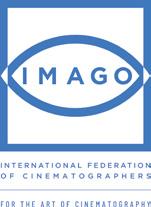
If we don’t see you at IBC 2023 in Amsterdam (check out our pavilion in Hall 12.G71), then we sure hope we will at Camerimage in Toruń, Poland, 11 to 18th November, when we also hope to report on better days ahead.

In the meantime, stay strong. Happy reading and very best wishes to you from all of us.
Ron Prince Editor in Chief
SUBSCRIBE
You can subscribe to the print, digital, or print and digital, versions of Cinematography World. This will cover you for the six issues delivered over a 12-month period. Your email will also be added to our monthly newsletter update, unless you decide to opt out of these news feeds.
Cinematography World is part of Rascals Publishing & Media Ltd! The publishers emphasise that opinions expressed within Cinematography World Magazine are not representative of Rascals Publishing & Media Ltd!, but are the responsibility of individual contributors.
Cinematography World is created using responsibly sourced paper. All inks used during the printing process are vegetable based and virtually free from volatile organic compounds. Waste, paper, ink and consumables are recycled. Where this is not possible waste is sent to specialist centres for safe disposal.
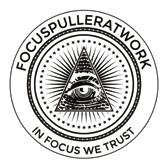
CINEMATOGRAPHY WORLD SEPTEMBER/OCTOBER 2023 3
Cover Image: El Conde, shot by DP Ed Lachman ASC. Image courtesy of Netflix.
ISSUE 017•CINEMATOGRAPHY WORLD
Cinematography World is created using responsibly sourced materials RECYCLE
When you cut your reel to show agents, choose the pieces that you feel most proud, those that represent you the most
DP Natasha Braier ADF ASC
Ron Prince photo by Joe Short www.joeshort.com
Official Media Partners
Anywhere Anytime Camera Tracking
ZEISS CinCraft Scenario

Meet the only real-time camera tracking system that works indoors and outdoors, on film sets, with green and blue screens and in LED volumes. That uses natural markers, reflective markers, and even digital markers on LED screens. That provides camera tracking data for real-time use and records it for post-production. And that integrates lens characteristics to skip the cumbersome lens calibration process. Meet ZEISS CinCraft Scenario.
zeiss.ly/cincraft-scenario


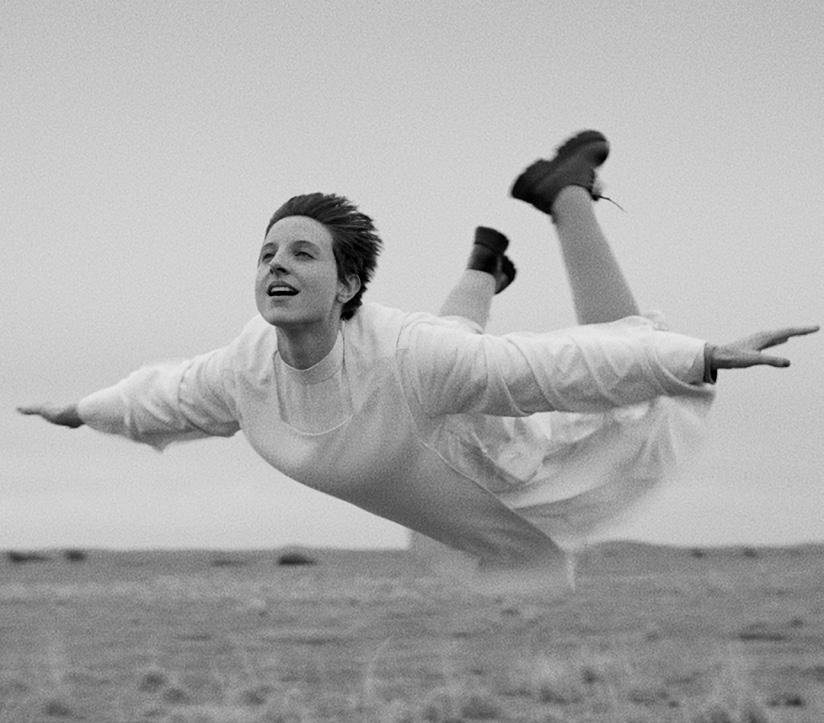


CINEMATOGRAPHY WORLD SEPTEMBER/OCTOBER 2023 5 ISSUE 017•CINEMATOGRAPHY WORLD
58 A HAUNTING IN VENICE
54 EL CONDE
66 ANATOMY OF A FALL
INSIDE ISSUE 017 SEPTEMBER/OCTOBER 2023 6 PRODUCTION NEWS 14 STUDIO NEWS•STUDIO ROUND-UP 16 WHO, WHAT, WHEN & WHERE 24 SMOOTH OPERATOR•JONATHAN ‘CHUNKY’ RICHMOND 26 GREAT GEAR GUIDE•IBC 2023 HIGHLIGHTS 30 SPECIAL REPORT•IMAGO - ITC ARTISTIC DECISIONS – PART ONE 34 MOLLY MANNING WALKER•SCRAPPER 38 SHABIER KIRCHNER•PAST LIVES 40 DAVID PROCTER BSC•ELLIE GOULDING ’LIKE A SAVIOUR’ 42 MONIKA LENCZEWSKA PSC•ANIMAL 44 TOBY STRONG•SECRETS OF THE ELEPHANTS 48 SPECIAL REPORT•AGENTS 52 ONE TO WATCH•HARRY WHEELER 54 ED LACHMAN ASC•EL CONDE 58 HARIS ZAMBARLOUKOS BSC GSC•A HAUNTING IN VENICE 62 ROBBIE RYAN BSC ISC•THE OLD OAK 64 JOSÉE DESHAIES•PASSAGES 66 SIMON BEAUFILS AFC•ANATOMY OF A FALL 68 LAURENT DAILLAND AFC•JEANNE DU BARRY 72 STUDENT UNION•SCAD - SAVANNAH COLLEGE OF ART AND DESIGN 74 ON TOUR•SUNBELT RENTALS 76 GAFFER’S CAFÉ•HARLON HAVELAND 68
40 LIKE A SAVIOUR
JEANNE
DU BARRY
ICG REVEALS RECIPIENTS OF EMERGING CINEMATOGRAPHER AWARDS
The International Cinematographers Guild (ICG, IATSE Local 600) has announced its two special award recipients for the 25th Annual Emerging Cinematographer Awards (ECA).
Cinematographer/director Janusz Kamiński will be honoured with the Distinguished Filmmaker Award, and cinematographer Stephen Lighthill ASC will accept the ASC Mentor Award.
“We’re delighted to award two of the most influential film artists and practitioners of our craft at this year’s ECA ceremony,” said ECA chairs Steven Poster ASC and Jimmy Matlosz in a joint statement.
Kamiński is an Oscar-winning cinematographer and director. He has worked as Steven Spielberg’s director of photography since 1993. He won the Academy Award for Best

ASC 2023
STUDENT HERITAGE AWARDS
The American Society of Cinematographers (ASC) has announced the 2023 Student Heritage Awards nominees. The awards are just one of many educational programmes offered by the organisation to support a new generation of talent, and winners will be revealed on October 8th, 2023.
To be considered, a student’s undergraduate, graduate or documentary project is submitted and judged, by an ASC blue-ribbon panel, for demonstrating exceptional cinematographic skill. The 2023 ASC Graduate Award is named in recognition of the legendary Owen Roizman ASC (1936-2023).
This year’s Undergraduate Award honours George Spiro Dibie ASC (1931-2022), whose groundbreaking camerawork earned him five Emmy Awards and seven additional nominations for multi-camera, episodic television series between 1985 and 1998. The Documentary category is enduringly dedicated to Oscar-
Cinematography for his work on Spielberg film’s Schindler’s List and Saving Private Ryan
Lighthill began his career shooting network news and documentaries, including the Oscarnominated documentary Berkeley, Gimme Shelter and CBS 60 Minutes. His credits include HBO’s Vietnam War Story, NBC’s Earth 2, and CBS’s Nash Bridges
The ECA showcase event takes place Sunday, Oct 1st, at the Television Academy’s Saban Media Center Wolf Theater in North Hollywood. Lighthill will accept the ASC Mentor Award on Friday, Sep 29th at the ASC Clubhouse in Hollywood.
In addition to these awards, ICG announced eight honourees earlier this summer. The eight winning filmmakers, selected from 106 nationwide submissions, are:
winner Haskell Wexler ASC (1922-2015), whose credits included Who’s Afraid of Virginia Woolf? and Bound For Glory
Contenders for the 2023 ASC Student Heritage Awards, sponsored this year by Sony are:
Owen Roizman Student Heritage Award - Graduate Category
Timur Guseynov for Seraphim (University of Southern California)
Borneo Sedeu Nishevikj for Gnomes (Jacksonville University)
Hannah Platzer for Im Finstern (American Film Institute)
Isue Shin for Dosh (American Film Institute)
Madilyn Macy Witherspoon for The Sunlight From Your Tongue (Florida State University)
George Spiro Dibie Heritage AwardUndergraduate Category
Ariano Trevino Angelone for Sammy, Without Strings (University of North Carolina School Of The Arts)
Thomas Bolles for Drawn Into Darkness (Loyola Marymount University)
Joshua Campbell for The Chaperone
Petros Antoniadis, camera operator –Flickering Souls Set Alight.; Connor Van Bodell, film loader ¬– Nisei; Drew Dawson, camera operator – For Those Who Don’t Know How; Edward Guinn, camera operator – TORN; Brook Lee Karner, digital utility – The Coop; Grant MacAllister, camera operator – Blood Positive; Sarah Anne Pierpont, camera operator – Juliet; Yusuke Sato,
(University of North Carolina School Of The Arts)
Scott Larson for Relapse (Chapman University)
David Zhang for The Butterflies Of Love (Chapman University)
Yu (Jason) Zheng for Promises, Promises (Loyola Marymount University)
Haskell Wexler Documentary Category
Matthew Cheung for Balancing Act (Loyola Marymount University)
Robert Denfeld for California Light (University of California Los Angeles)
Christopher MacPherson for My Years With Prospero (Emerson College)
Jon McCormack for Down The Road (University of Southern California)

PGGB OPENS NOMS FOR DUKE OF EDINBURGH AWARD
The Production Guild of Great Britain (PGGB) has announced that nominations are now open for The Duke of Edinburgh Film & TV Inclusion Award, which will once again shine the spotlight on inspirational work that is progressing talent and inclusion in the British screen production workforce. The award will be presented by PGGB’s Royal Patron, HRH The Duke of Edinburgh.
The annual award was launched in 2022, to recognise an organisation or individual in the UK production industry finding a successful way of inspiring local talent or skills, widening access or being more inclusive.
Eligible nominees for The Duke of Edinburgh Film & TV Inclusion Award include those whose work has generated outcomes that foster inclusivity in the film and TV production workforce directly (such as by developing or recruiting crew or providing training in key skills) and/or indirectly (such as by creating an initiative or practice which can be adopted by others). Local, regional and national organisations and individuals are all eligible for nomination.
Lyndsay Duthie, PGGB CEO, said, “We are very proud to open nominations
for The Duke of Edinburgh Film & TV Inclusion Award. We had a phenomenal response to the award’s creation last year and were able to hold up exemplary work being achieved by our first round of shortlisted nominees, to inspire others across the industry.”
The first winner of The Duke of Edinburgh Film & TV Inclusion Award was 6ft From The Spotlight, which was praised for its work to improve mental health and well-being in the UK film and television production workplace.
Nominations for The Duke of Edinburgh Film & TV Inclusion Award are now invited from PGGB members. Closing date for entries is Monday 25th September 2023.
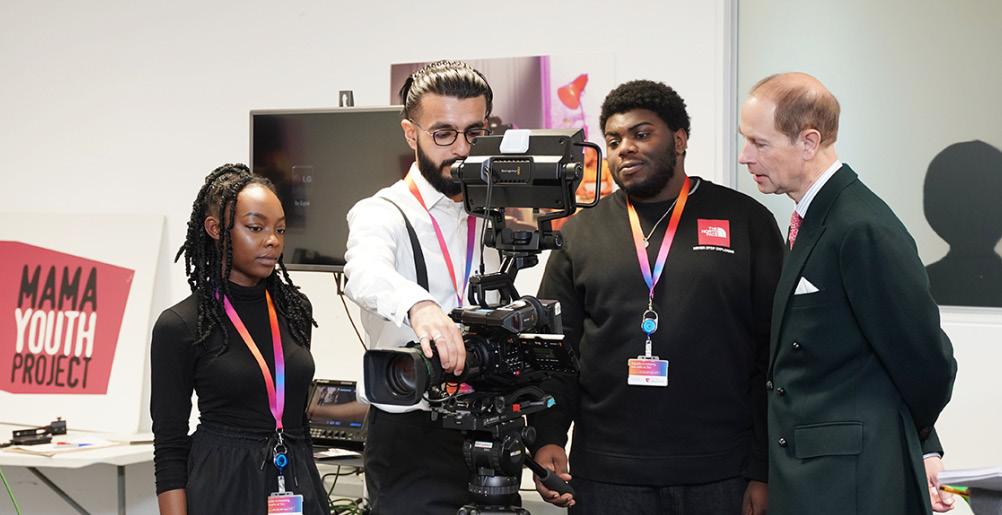
PRODUCTION & POST NEWS 6 SEPTEMBER/OCTOBER 2023 CINEMATOGRAPHY WORLD
1st AC – White Now Please.
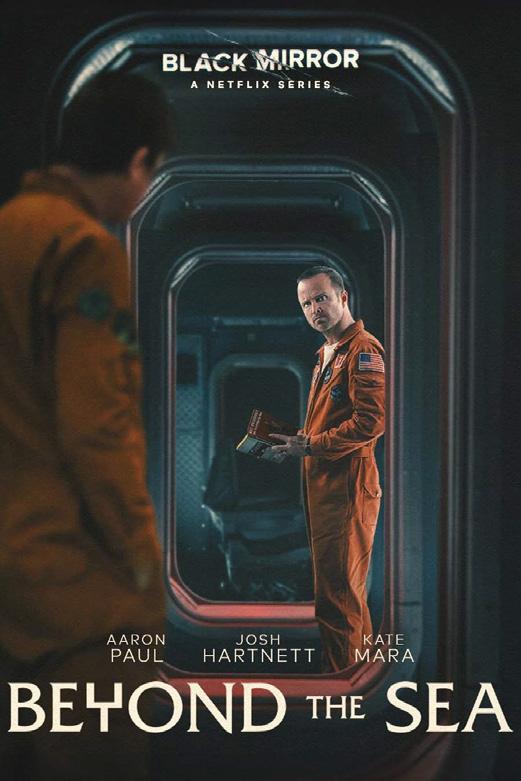

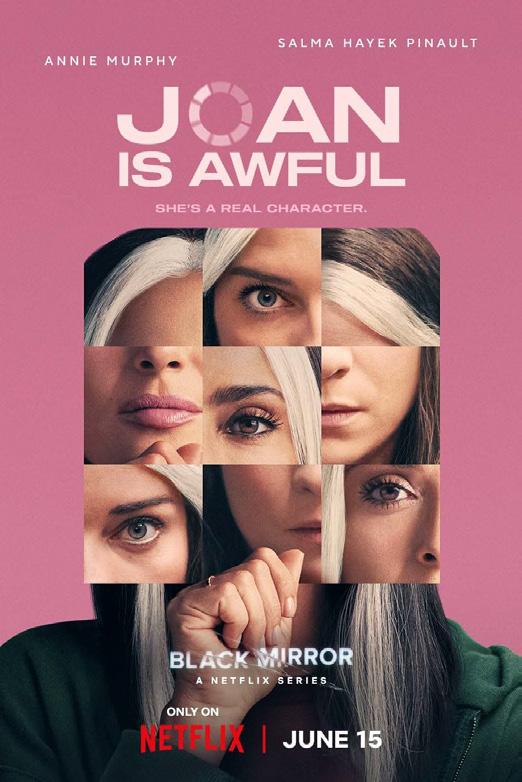

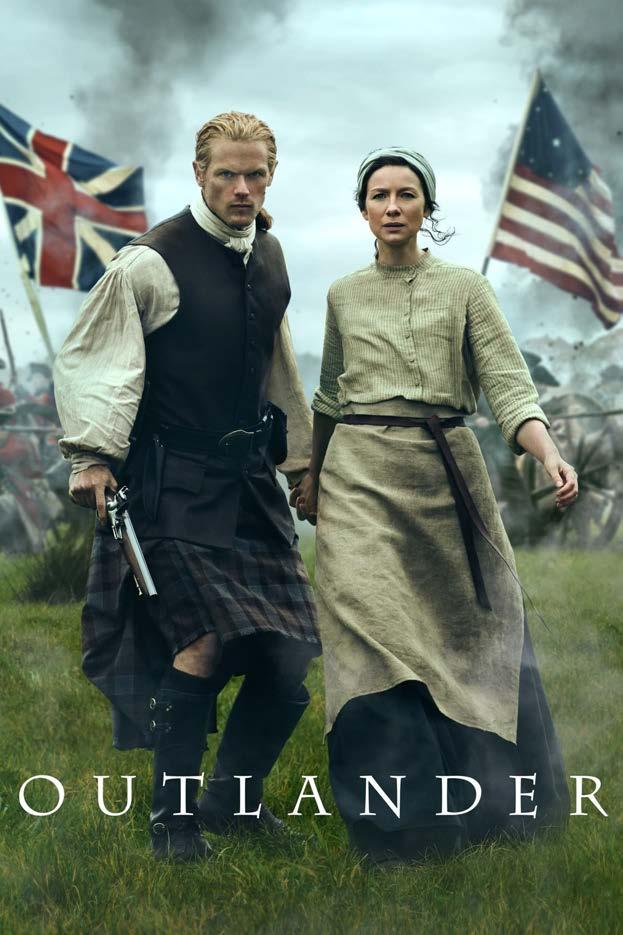
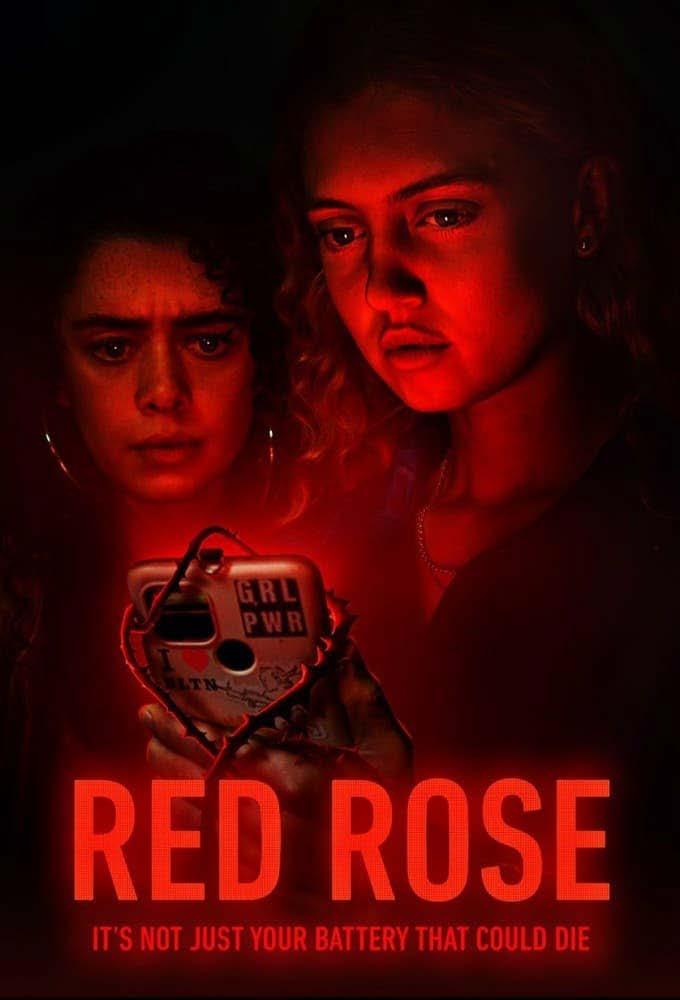
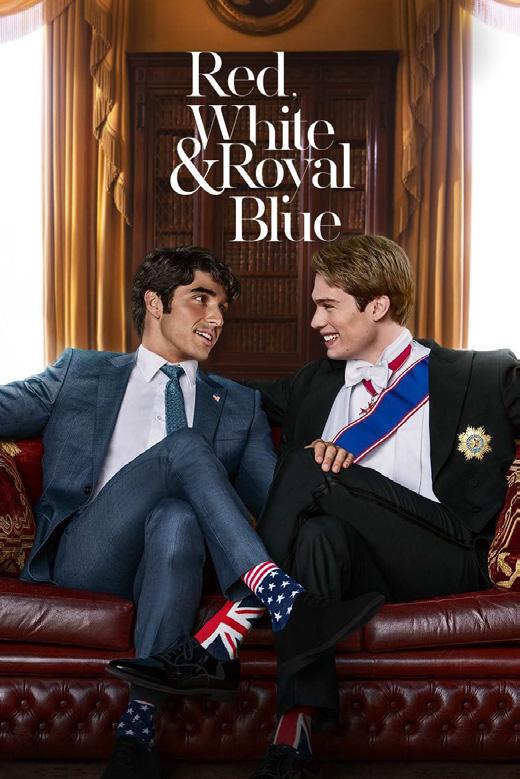



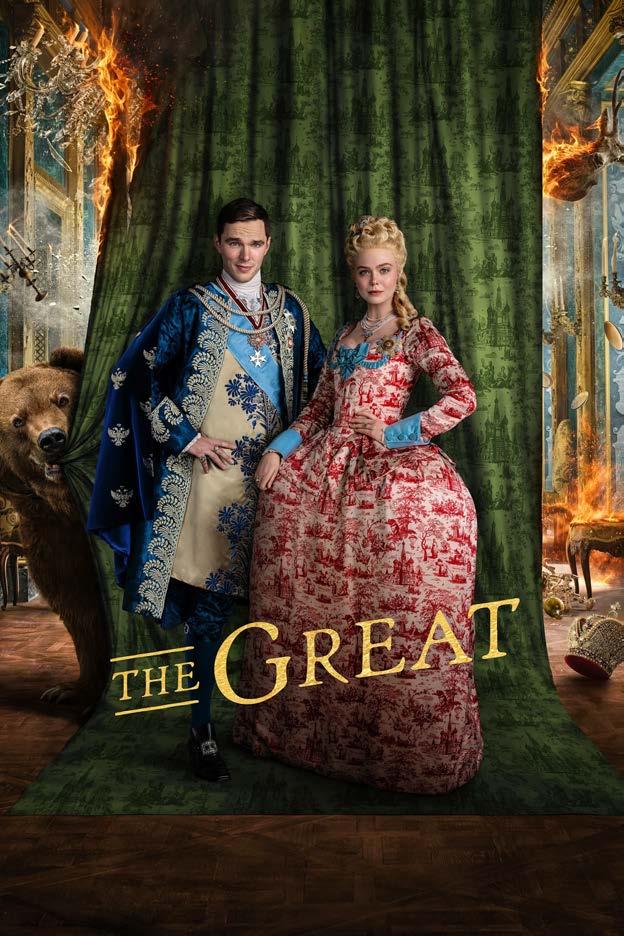

THAN K YO U FO R CHOOS IN G WW W.PANALUX.BIZ WHAT’S LOVE GOT TO DO WITH IT? BLACK MIRROR , SEASO N 6, EP 3 DoP STUART BENTLEY BSC GA FF ER DAVID NYE OUTLANDER, SEASON 7 GREAT EXPECTATIONS RED, WHITE & ROYAL BLUE RED ROSE THE GALLOWS POLE SEX EDUCATION, SEASON 4 BLACK MIRROR , SEASO N 6, EP 5 DoP STEPHAN PEHRSSON BSC GA FF ER CHRIS STONES DoP CATHERINE LUTES CSC GA FF ER BERNIE ROSTOSKI THE GREAT , SEASO N 3 DoP CATHERINE DERRY GA FF ER LEE KNIGHT BLACK MIRROR , SEASO N 6, EP 1 SILO, SEASON 1 BSC DoP MARK PATTEN GA FF ER BRANDON EVANS GA FF ER MARTIN COX DoP RICARDO DE GRACIA GA FF ER ALAN MILLAR BSC DoP DANNY COHEN GA FF ER JON BEST BSC DoP REMI ADEFARASIN GA FF ER IAN BARWICK DoP ANDREW MCDONNELL GA FF ER GARY CHAISTY DoP NIC LAWSON DoP ALASDAIR WALKER GA FF ER SCOTT NAPIER DoP DAN ATHERTON BSC DoP KATE REID GA FF ER STUART KING DoP STEPHEN GOLDBLATT ASC, BSC
PALME D’OR WINNER ANATOMY OF A FALL GRADED ON DAVINCI RESOLVE STUDIO
Graded at M141 on DaVinci Resolve Studio and the winner of the Palme d’Or at the 2023Cannes Film Festival, Anatomy Of A Fall, is a family drama that tells the story of a normal family’s sudden implosion.
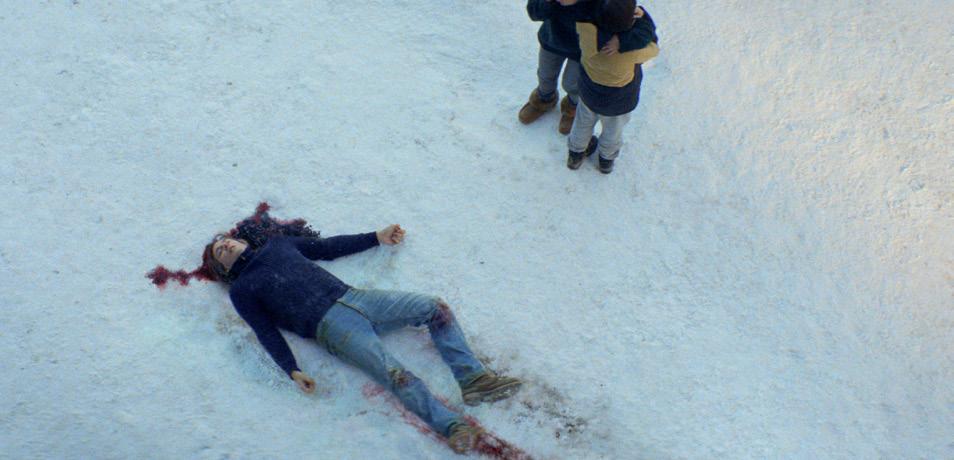
Shot by DP Simon Beaufils, the film is director Justine Triet’s fourth feature, a dizzying portrait of a woman accused of murdering her husband, in a stifling atmosphere. Colourist Magali Léonard takes us behind-the-scenes of her work on the film, reviewing its artistic and technical challenges.
“Justine and Simon contacted me early-on during their camera tests, before filming even started for Anatomy Of A Fall,” says Léonard. “I had done the grade for Justine’s previous film Sibyl, for which Simon was also DP. This is my second collaboration with Justine and sixth with Simon.”
“They were very much involved throughout picture finishing, and thanks to this close collaboration, dialogue and listening, Leonard was able to translate the film’s singular atmosphere into the grade. It was a stimulating and exciting process,” she reveals.
“For Anatomy Of A Fall, Justine wanted a raw, contrasty visual that captured imperfections and flaws while creating something carnal and sensual, with reddened
skin, sweat and exhaustion, particularly in the trial scenes.
“I took that and Simon’s words and translated it into the visuals, paying particular attention to the faces and skin. We collaborated closely in establishing a look, starting with extensive camera test involving hair, make-up and costumes.”
In the early stages of the project, Beaufils shot tests on 2-perf 35mm film so that Leonard could get close to how film looked when calibrating the digital camera tests.
“It was our starting point to find the film’s mood and visual identity,” she notes.
Triet and Beaufils chose the Alexa Mini LF with Hawk V-Lite Anamorphic lenses, even though the film’s aspect ratio was 1.85 reveals Leonard.
“The V-Lites bring a certain softness, a richness of colours, flares and special blurs, which cut the digital sharpness. Simon was fantastic to collaborate with, crafting beautiful images that convey very complex emotions.”
“I worked on the visuals in an iterative way, playing with contrast using DaVinci Resolve’s custom curves, and then the colours, saturation, and highlights. I’d then added grain to create a more pronounced look, which we applied from the rushes onward, giving us a good basis for the film’s general mood.”
CINELAB FILM & DIGTAL EXPANDS DIGITAL SERVICES WITH KEY APPOINTMENTS

Cinelab Film & Digital, the UK’s only fullservice film and digital dailies facility, has appointed Adam Coles as commercial director and Daniel Kraus as head of business development. In the newly-created roles, Coles and Kraus will be responsible for the development and expansion of Cinelab’s digital services. Coles will oversee sales growth and new marketing endeavours. His appointment is part of Cinelab’s expansion of its digital operations. On
joining Cinelab, he commented, “I am really looking forward to working with the whole team and this exciting next stage of the journey.”
In his new role Kraus will focus on innovating services, developing new strategies, and introducing new customers to Cinelab.
Kraus said, “I’m thrilled to join Cinelab and contribute to a company that puts such an emphasis on the history of filmmaking. I am looking forward to applying my knowledge and enthusiasm to see where it can grow, in an evergrowing digital space”.
PIXIPIXEL WELCOMES JASON HERITAGE IN NEW SALES ROLE
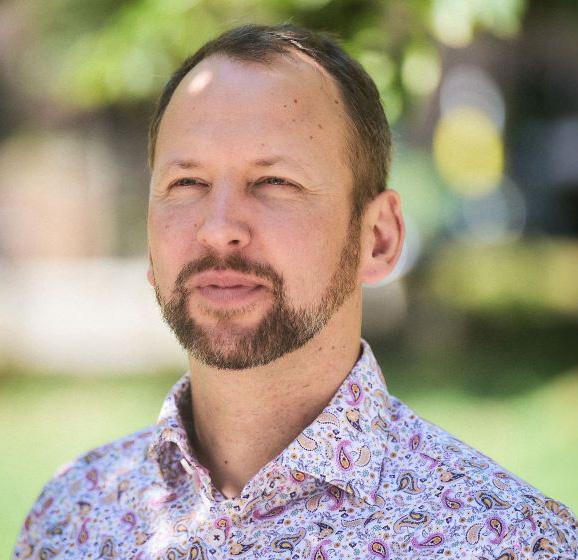
Pixipixel has appointed Jason Heritage as head of sales for camera and grip rental, working across features and TV drama. Heritage will have the responsibility for all UK-based productions.
With an industry track-record and over 16 years’ service at Procam/ Take 2, he joins Pixipixel bringing a wealth of experience. As part of his role at Pixipixel, Heritage will be a key point of contact for cinematographers and producers. He will focus on nurturing and developing key relationships and will support productions throughout the production process by
LITEMOVER LAUNCHES NEW ADAPTORS
itemover has launched a new set of adaptors for large panel lights, including ARRI Skypanel 360 and Creamsource Vortex, as well as reflectors, adding to the growing number lighting solutions the unit can be applied to.

Current adaptors and fixtures encompass: ARRI and Filmgear HMIs (included in kit); ARRI Skypanel S360; Cineo Reflex 15; Creamsource Vortex8 (when used in multi-yokes); Dedolight Lightstream reflector 1m x 1m; Lightbridge CRLS C100; Film Gear Power Beam; K5600 Alpha range HMIs; Matthews Xeno Mirror Reflector 42” x 42”; with more to be announced.
leveraging his equipment knowledge and years of experience working with camera crews.
Heritage commented on his new role, “Pixipixel is a well-respected rental company, renowned for its sustainable ethos, innovation and tailored services, leading the way with the latest kit on the market. It’s a fantastic opportunity and I look forward to working alongside the team.”
Litemover is a lighting system that combines cutting-edge technology with user-friendly features. Quick to set-up, the Litemover can handle any standard HMI light, either on a stand or in a hang position. Users can effortlessly adjust the pan, tilt and flood, via the supplied manual controller, DMX or wirelessly via CRMX.
“Litemover represents a significant leap forward in lighting technology, offering users unparalleled control and customisation options,” said company director, Erno Das. “We believe that Litemover will revolutionise the way we illuminate spaces, providing a new level of efficiency and new options for DPs and gaffers on-location and film sets.”
PRODUCTION & POST NEWS 8 SEPTEMBER/OCTOBER 2023 CINEMATOGRAPHY WORLD
L
Introducing Blackmagic Pocket Cinema Camera 6K Pro!

Advanced digital film camera with built in ND filters, HDR screen, and optional viewfinder!
Blackmagic Pocket Cinema Camera is better than a simple video camera because it has professional features allowing you to create the same “look” as Hollywood feature f ilms. The combination of high dynamic range, great low light performance and Blackmagic RAW gives you feature film images. The new 6K Pro model adds ND filters, adjustable HDR display, a much larger NP-F570 battery and more!
High Resolution Cinematic Digital Film Sensor!
The Blackmagic Pocket Cinema Camera 6K Pro has a native resolution of 6144 x 3456. Whether you’re shooting in bright sunlight or almost no light, the 13 stops of dynamic range with dual gain ISO up to 25,600 provide stunning low noise images in all lighting conditions. Plus the Super 35 sensor allows shooting with shallower depth of field and anamorphic or EF photographic lenses.
Multifunction Grip with Fingertip Controls!
The multifunction handgrip features an ergonomic design that puts important functions such as ISO, WB and ND filter controls at your fingertips. The Blackmagic Pocket Cinema Camera features easy to reach recording and still buttons that are placed exactly where you expect, including user assignable function keys allowing buttons for high frame rate, focus zoo m, false color and more.

Built in Motorized ND Filters
The 6K Pro model features high quality, motorized IR ND filters that let you quickly reduce the amount of light entering the camera. Designed to match the colorimetry and color science of the camera, the 2, 4 and 6 stop filters provide you with additional latitude even under harsh lighting. Settings can even be displayed as either an ND number, stop reduction or fraction on the LCD!
Large 5" HDR LCD Monitor
A large, bright 5 inch touchscreen makes it easy for you to frame shots and accurately focus. On screen overlays show status and record parameters, histogram, focus peaking indicators, levels, frame guides and more. The HDR display can be tilted up and down so it ’s easy to monitor your shot from any position. Plus the 1500 nit display is ideal for use in bright sunlight!
Blackmagic Pocket Cinema Camera 6K Pro
£2,069
Learn More!
www.blackmagicdesign.com/uk
SRP is Exclusive of VAT. Camera shown with optional accessories and lens.
NANLITE RELEASES NEW PAVOTUBE II 15C/30C


Upgraded from end-to-end and inside-out, the vastly-improved new PavoTube II 15C/30C greatly expands the possibilities of creatives.
Nanlite has listened to feedback from commercial production teams, film crews and photographers all around the globe over the past few years when designing the new PavoTubes. The PavoTube II 15C/30C features technological upgrades, both internally and externally, and utilises RGBWW colour mixing technology with top-drawer colour rendition and accurate colour reproduction, making it capable of bringing colourful visions to life.
A wider CCT range of 2700-7500K, with G/M±150 adjustment, allows for more comprehensive lighting options during different times of the day, making it easier to shoot photos and videos in varied environments. The two tubes output more power compared with the previous versions, although they come in almost the same dimensions.
To be exact, PavoTube II 15C and PavoTube II 30C are 10% and 20% brighter respectively.
Users will have more confidence in terms of intensity for use as a key
light, fill light, and other applications. On-board control of PavoTube II 15C/30C has been optimised with a more intuitive two-knob operation. For example, one short press of the dimmer button reinstates the previous intensity setting instantly. All improvements allow for a more convenient and smooth lighting control experience. PavoTube II 15C/30C has built-in Bluetooth and 2.4G modules with Nanlink App controllability.
BROMPTON POWERS EXTENDED REALITY FOR HONG KONG’S VOTION STUDIOS
Votion Studios, a technology-driven creative agency, has launched a new virtual production studio that centres around an Aoto LED display powered by LED video processing from Brompton Technology.
Votion Studios, a technology-driven creative agency, has launched a new virtual production studio that centres around an Aoto LED display powered by LED video processing from Brompton Technology.
As one of Hong Kong’s foremost XR and VP studios, Votion Studios combines a strategic fusion of cutting-edge technologies and collaborative alliances to provide content creators with a solution that spans the entire production cycle.

In February 2022, Votion embarked on a
strategic manoeuvre and reinvested in its LED volume during the year, replacing the original LED configuration with advanced Aoto LED panels and Brompton’s Tessera LED processors.
At the heart of the studio’s capabilities are three Aoto LED displays: an RM 2.3mm curved LED wall, measuring 10 x 3.5m; an 8.5 x 5m AE 2.3mm LED floor; along with an M3.7mm height-adjustable LED ceiling, which spans an impressive 4 x 3m. The entire set-up is driven by five Brompton Technology Tessera SX40 LED processors, complemented by four Tessera XD 10G data distribution units to deliver a unified data distribution solution.
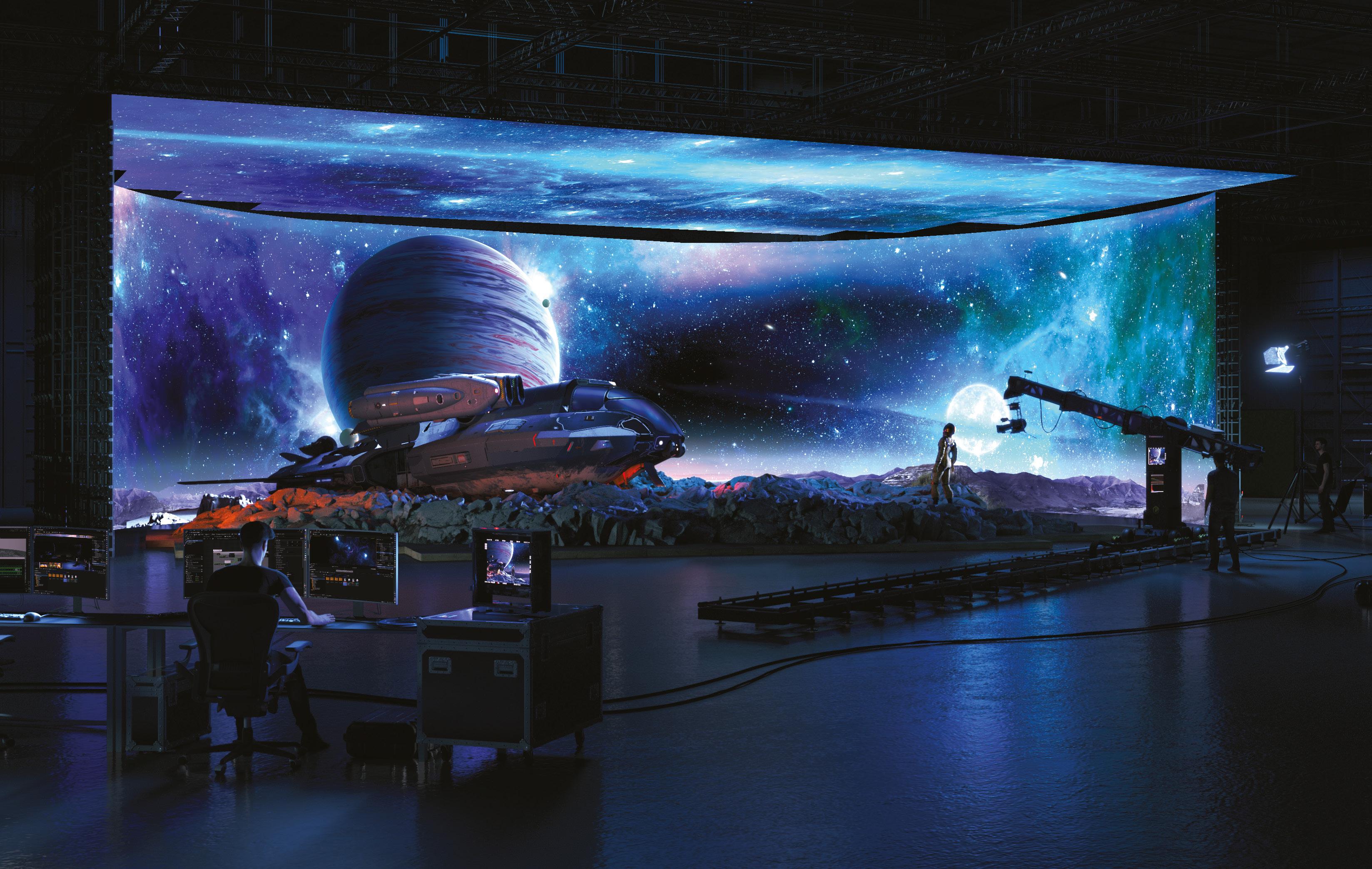
“Adopting Brompton LED processing marked a pivotal moment in our commitment to provide cutting-edge, innovative visuals throughout our projects,” says Roger Proeis, co-founder at Votion Studios. “The inclusion of full, 4K support and remarkable LED video processing, encompassing HDR, dynamic calibration and HFR+, ensures consistently stunning and accurate visuals.”
FIILEX LAUNCHES FULL-COLOUR TRACK LIGHTS
Fiilex has launches its highlyanticipated product line – Fiilex full-colour Track Lights, which the company hopes will redefine the way professionals and enthusiasts illuminate their spaces.
Fiilex has launches its highly-anticipated product line – Fiilex full-colour Track Lights, which the company hopes will redefine the way professionals and enthusiasts illuminate their spaces.

The lights are designed to provide exceptional lighting quality, versatility and ease-ofuse and offer a wide range of benefits for various applications, including photography studios, film sets, art galleries and retail spaces.
Fiilex Track Lights deliver precise and consistent lighting, allowing users to achieve
the desired ambiance and highlight specific areas with ease. The adjustable beam angles and customisable light intensity ensure optimal illumination for any environment.
The Track Lights are engineered to deliver exceptional colour accuracy, ensuring that the lighting accurately represents the true colours of objects and subjects, whilst the modular design enables users to easily configure and adapt the lighting setup to their specific needs. With a wide range of accessories and mounting options, the lights can be integrated into any space, providing new possibilities for creative lighting arrangements.
By utilising the latest LED technology, Fiilex Track Lights are highly energy-efficient, consuming significantly less power compared to traditional lighting solutions.
PRODUCTION & POST NEWS 10 SEPTEMBER/OCTOBER 2023 CINEMATOGRAPHY WORLD
VERONA
• Available in P1.5mm and P2.3mm pixel pitch
• Deep black and anti-reflection surface technology
• Easy & flexible installation for permanent and temporary stages
Discover more: pro.sony/virtualproduction

Crystal LED
SMALLHD HONOURED WITH 2023 EMMY
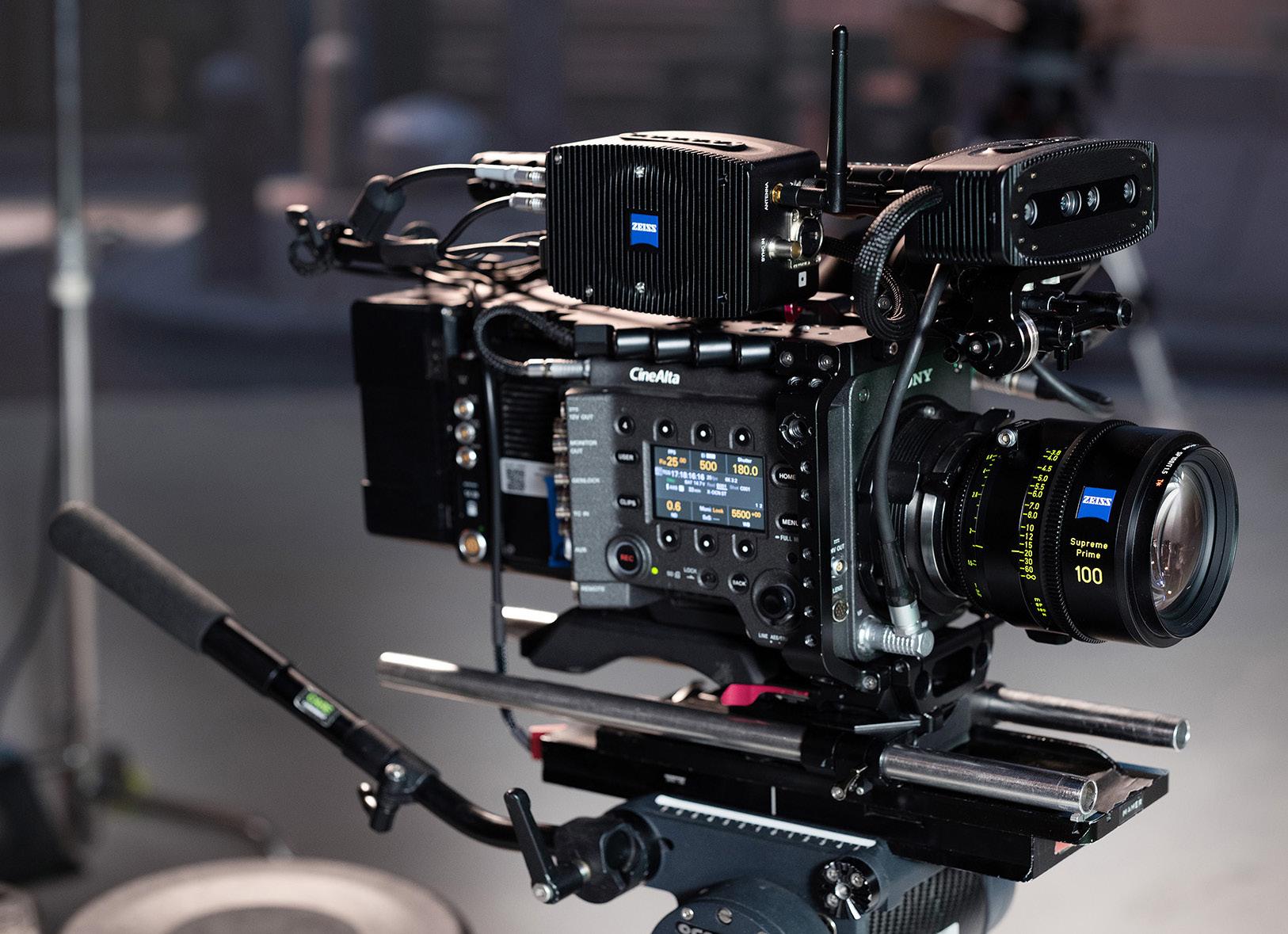
SmallHD has announced that its monitor platform has been awarded a 2023 Engineering, Science & Technology Emmy from the Television Academy. This prestigious accolade recognises SmallHD’s significant contributions to advancing the television industry through its engineering, scientific achievements and technological breakthroughs.
Receiving the Emmy for the SmallHD team were Jeffrey Gray, Russell Hocken, Barrett Phillips, and Greg Smokler. Additional key contributions were made by Norbert Ingram, Mike Claes, Blake Johnson, and the entirety of SmallHD’s research and development team.
GATORBUDDY FROM MATTHEWS STUDIO EQUIPMENT
Gatorbuddy was designed by a photographer as a better way to handle the bounce and fill cards that are a mainstay on photo shoots. It can also help create instant walls and dividers, and be equipped with a laptop for use as a portable viewing station.
“SmallHD has always been laser-focused on one goal: to build the best-possible tools for technicians and artists to monitor their creative vision,” says Greg Smokler, VP of cine products for creative solutions. “Our teams put so much love and care into every aspect of this technology, so it really is a huge honour to see that effort recognised by the Academy.”
SmallHD’s monitors have become ubiquitous in the production landscape, empowering crews with unparalleled image quality, brightness, rugged durability and universal connectivity –all powered by the intuitive PageOS software. SmallHD focusses design and ergonomics on deeply collaborative relationships with professionals on-set.
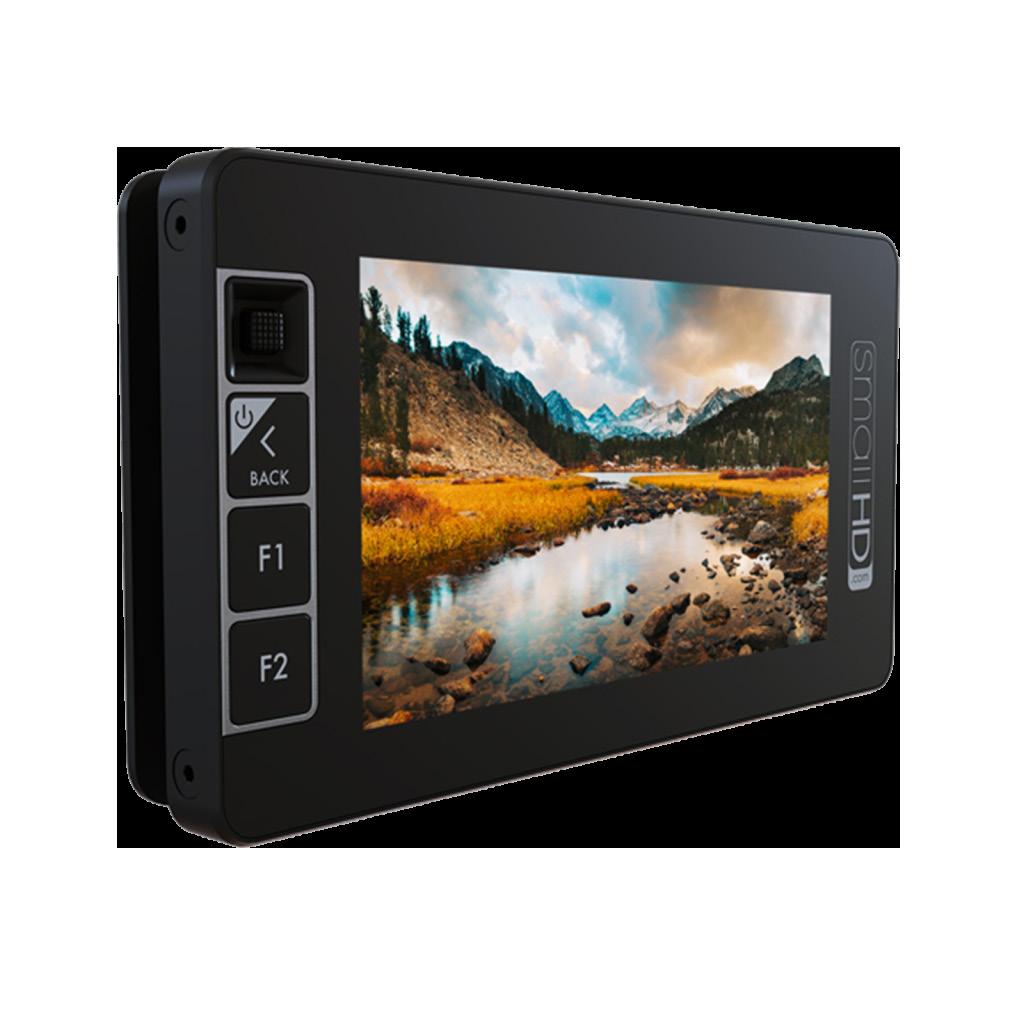
Gatorbuddy contains a rugged wheeled base with a low centre of gravity that keeps it stable. With a stable steel base and four Tente caster wheels, Gatorbuddy glides, and swivels then locks safely in place. Like a dolly, it can help move panels and V-Flats easily in and
out to swap backgrounds.
Gatorbuddy ships complete with rolling base, three baby risers, and two V-Flat holders that are attached with three washers, 3 screws, and one pin. Gator Board / V-Flat not included.
ZEISS PRESENTS CINCRAFT SCENARIO CAMERA TRACKING
With CinCraft Scenario, Zeiss presents a new, powerful and flexible cameratracking system as part of its CinCraft ecosystem. Built upon Ncam’s unique tracking technology and Zeiss’ expertise in lens data, the camera-tracking system is easy-to-use and introduces a user-experience designed to match the film crew’s workflow.
Zeiss CinCraft Scenario provides cameratracking data for use in real-time rendering engines for virtual production or live compositing. In addition, it lets the user record tracking data for post-production.
“Whilst camera-tracking is known to be extremely useful for pre-visualisation and virtual production, CinCraft Scenario can bring major benefits to any production that includes VFX as it can record the tracking data on set to be then used in post-production, where it can help significantly optimise an artist’s workflow,” explains Tom Evans, product manager and camera tracking specialist at Zeiss.
The new system can be used in practically every environment, indoors and outdoors, on film sets, with green or bluescreens and in LED volumes. This is made possible by its hybrid tracking technology that not only allows for tracking specially-placed reflective markers – the industry standard – but also tracks features of the surroundings, such as object edges. In addition, CinCraft Scenario also works with digital markers on LED walls that are invisible to the main camera.
Designed to work with regular off-the-
shelf equipment, CinCraft Scenario is natively compatible with major camera and lens encoder systems to provide all the data the system needs to track properly. It is comprised of several hardware and software components that can be individually configured to exactly match the users’ needs.
Users will be able to configure their CinCraft Scenario camera-tracking system according to their specific needs or choose one of four preconfigured bundles. The system will be available through select dealers and the Zeiss CinCraft website by late 2023.

PRODUCTION & POST NEWS 12 SEPTEMBER/OCTOBER 2023 CINEMATOGRAPHY WORLD
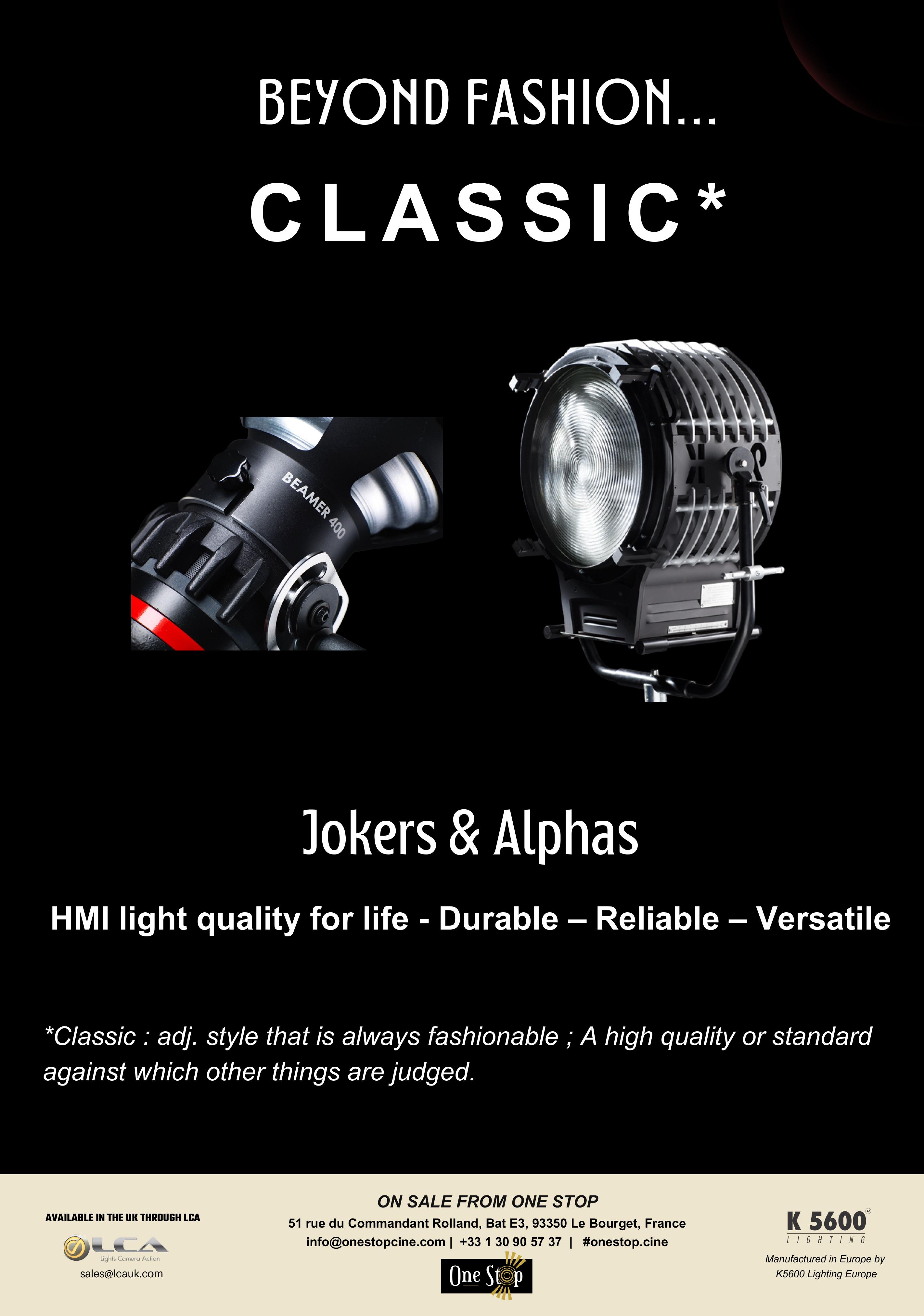
STUDIO NEWS
By Kirsty Hazlewood
3 MILLS STUDIOS SUPPORTS EMERGING TALENT OF FEMALE DPS
3 Mills Studios, which has provided sound stages for numerous world-class TV series and films for the past 30 years, recently set the stage for talented DPs who are shaping the industry.
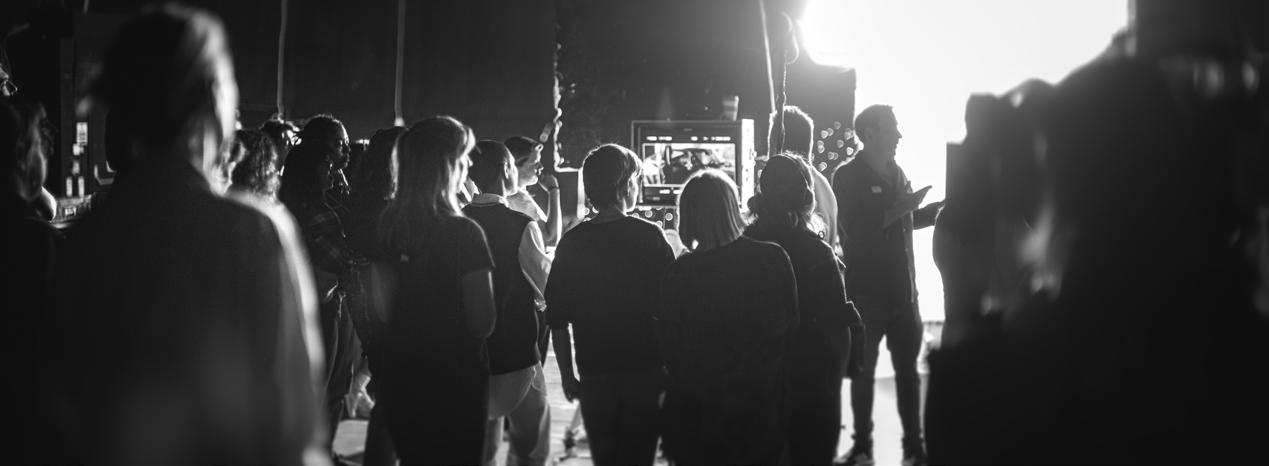
Resident rental house One Stop Films put together a specialist masterclass in lighting for Illuminatrix, the collective of female cinematographers based in the UK. The event supported increased diversity within the film and TV industry and the iconic London studio was delighted to host the event within one of its nine sound stages on site.
Fresh from their BAFTA and Oscar wins for All Quiet On The Western Front, cinematographer
James Friend BSC ASC and camera operator
Danny Bishop ACO Associate BSC SOC led the masterclass. The workshop covered a range of key production knowledge, from Friend and Bishop’s approach to the working relationship between DP and operator, to a practical demonstration of a live scene. Lights were supplied by Pro Light.
The attendees were able to see Friend in action, as the cinematographer set up a day to night lighting transition with a backdrop of London, supplied by Rosco, using an ARRI Alexa 35 fitted with Lensworks Neo-AO Anamorphic lenses. The Illuminatrix

GARDEN STUDIOS NOW CERTIFIED AS A B-CORPORATION
Established in February 2020, Garden Studios has announced that it has achieved B Corp certification. This recognition positions the company amongst a global community of businesses committed to high standards of social and environmental impact, transparency, accountability, and the transformation of the global economic system.
“Becoming a B Corp signifies our ambition to not just being the best in the world, but the best for the world,” said Julie Hoegh, head of sustainability. “By aligning our business practices with our core values, we join a group of inspiring companies that lead the transformation towards a more inclusive, equitable, and regenerative economy.”
B Corp Certification is a rigorous process managed by B Lab, a non-profit organisation that serves the global community of people using businesses as a force for good. The certification verifies that a company meets B Lab’s high standards for social and environmental impact and has made a legal commitment to stakeholder governance.
cohort got the chance to test these top-of-the-range cameras and unique lenses, supplied by One Stop, as well as an invaluable chance to network with industry peers.
3 Mills Studios is a supporter of diversity,
inclusion and opportunity with the industry. The site has recently completed major upgrades via a grant allocated by the Mayor of London, which went towards adding more than 10,000sq/ft of creative workspace to the film and TV studio hub.


Certified B Corps are required to undertake the assessment and verification process every three years, demonstrating continuous improvement and commitment to B Lab’s evolving standards.
Garden Studio’s B Corp status reflects its commitment to the environment, innovation, and
social responsibility. The company has prioritised environmental stewardship, with robust initiatives to reduce its carbon footprint, promote energy efficiency, and support sustainability in the film and TV studio industry.
STUDIO ROUND-UP•3 MILLS STUDIOS•GARDEN STUDIOS
14 SEPTEMBER/OCTOBER 2023 CINEMATOGRAPHY WORLD
Photo: Peter Marsden
Photos: Suzanne Szturc
INDUSTRY SUPPORT GROWS FOR MARLOW FILM STUDIOS
Leading lights of the film and television industry have pledged support for the proposed Marlow Film Studios state-of-the-art film studio and filmmaking campus, as the decision approaches from Buckinghamshire Council.
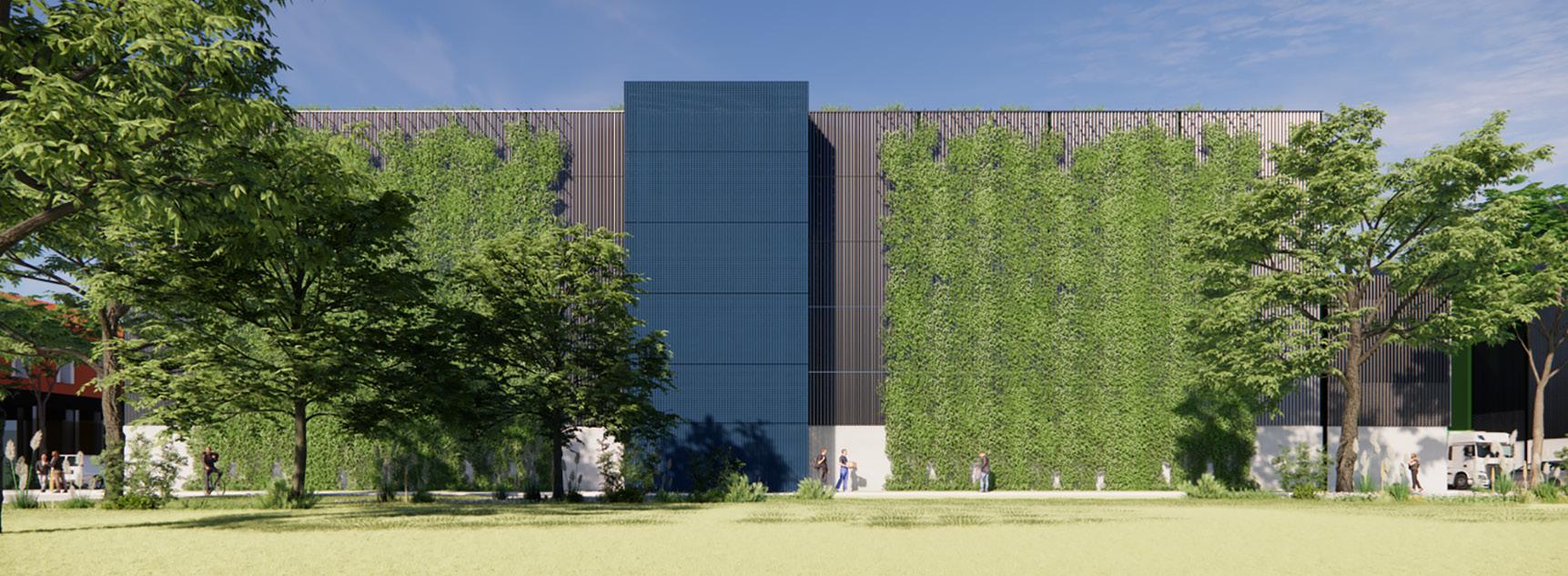

The British Film Commission, Lionsgate, Producers Alliance For Cinema & Television (PACT), the Production Guild Of Great Britain, ScreenSkills, Creative England and other individuals working in the industry, have written to express their support for the planning application to turn a former landfill and quarry site into a top tier creative workspace near Marlow in Buckinghamshire.
The industry support comes on top of more
to learn and train for careers in the film and television industry. This is critical for the sustainable growth of the industry; ScreenSkills and the BFI estimate that the industry will require more than 15,000 new workers by 2025.
Hayley Armstrong, head of production services for Creative England, stated: “ The Marlow Film Studio development offers the opportunity to ensure local communities enjoy the profile, job opportunities and economic benefits that the sector generates.”
Creative England, the national agency endorsed by the Department for Culture, Media and Sport and
responds to the shortage of studio space in the UK that Creative England have seen over the last number of years.”
These messages were reflected in Tim Marshall OBE’s letter of support which stated: “ The UK’s film and television industry has experienced substantial growth over the last decade and is now a major contributor to the UK economy. Not only that, but the industry’s constantly developing production resources and methods mean that a highly-skilled workforce is needed to provide the human resources to support these state-of-the-art studios in a world class production environment.
“ This presents an incredible opportunity for the people in the area, and their children, to develop skills which will enable them to participate in one of the most exciting and rewarding industries in the British economy ”
Tim is a Buckinghamshire resident, former chair of Royal Television Society Thames Valley, head of BBC TV Events and senior vice-president at The Walt Disney Company.
than 3,000 letters of public support in favour of the proposal for a new state-of-the-art film studios with 18 stages, capable of filming two high-end productions simultaneously which will create over 2,000 onsite jobs.
The application also includes an on-site culture and skills academy for the next generation of talent
ABU DHABI’S TWOFOUR54 TO BUILD MAJOR PRODUCTION STUDIOS
Twofour54 Abu Dhabi, part of ADNEC Group, has unveiled plans to build a major film studio –Twofour54 Studios – to reinforce Abu Dhabi ’s standing as a global epicenter for filmmaking. Set to span over 100 acres, Twofour54 Studios is designed as a futureproof, virtual production-ready, metaverseenabled and fully-fledged production destination, addressing high demand in the regional and global production landscape.
Spanning 400,000sq/m (4,400,000sq/ft), Twofour54 Studios will offer an impressive range of features including 11 best-in-class soundstages, a 3,000sq/m (32,000sq/ft) exterior water tank and six versatile standing sets offering filmmakers ample opportunities for inventive storytelling.
Complementing the lot will be 7,000sq/m (over 75,000sq/ft) of office space and an array of other production facilities, encompassing post-production, permanent tenancies and screening rooms, in an overall environment that has been carefully designed to nurture creativity and ensure efficient production processes.
The studio’s commitment to community and collaborative spirit extends beyond its production facilities as it can also house permanent tenants and companies that cater to the production industry, providing a holistic destination for everyone involved – a true creative ecosystem for the Middle-East.
Humaid Matar Al Dhaheri, board member, managing director and CEO of ADNEC Group, said: “The creative industries have been identified
funded by the British Film Institute, said: “Despite the UK’s success in attracting unprecedented levels of production, the supply of studio space has not been in-step with demand.
“ The current renewed demand for content has never been on a greater trajectory and the Marlow Film Studio development proposals directly
as one of Abu Dhabi’s priority sectors given the important economic and social value they create.
We are proud to drive Abu Dhabi’s vision of becoming a leading global destination for content creation through Twofour54 Studios. It will take film and TV production to the next level, creating jobs and contributing to the local economy following its completion in 2025.”

CEO Mark Whitehead, added, “Twofour54 has facilitated thousands of productions over the last 15 years, establishing a compelling track record and building a deep expertise of the global film industry’s demands. Leveraging this invaluable experience, Twofour54 identified an opportunity in the MENA region –the demand for an integrated, future-ready production destination.
We remain steadfast in our mission to foster creativity, nurture talent and provide a worldclass platform where visionaries can bring their cinematic dreams to life.”
Since its inception, Twofour54 has played a part in bringing some of the most popular
The proposed Marlow Film Studios near Marlow, Buckinghamshire, sits at the heart of the world-renowned West London Film and High-End TV cluster, well placed to contribute to this globally renowned sector generating jobs and prosperity in the UK and Buckinghamshire in particular. A decision is expected later this year.
blockbusters to the big screen, including Hollywood franchises such as Mission: Impossible, Dune, Star Wars and Fast And Furious, as well as Bollywood hits such as Bharat and Tiger Zinda Hai, alongside many regional productions.
Twofour54’s latest destination for the creative industries complements the company’s flagship campus at Yas Creative Hub and its diverse set of production facilities across the emirate. Through its bespoke destinations, twofour54 makes any type of content production an unforgettable experience in Abu Dhabi.
CINEMATOGRAPHY WORLD SEPTEMBER/OCTOBER 2023 15 MARLOW FILM STUDIOS•TWOFOUR54 STUDIOS•STUDIO ROUND-UP
PICTURE THIS...
CREATIVE MEDIA MANAGEMENT:
Sam Thomas is filming a six-part drama, title currently under wraps, using Sony Venice 2 and Cooke S5i’s lenses, for Buffalo Pictures/ITV, with director Marc Evans and writer Ed Whitmore, with whom he previously worked on BBC’s Steeltown Murders
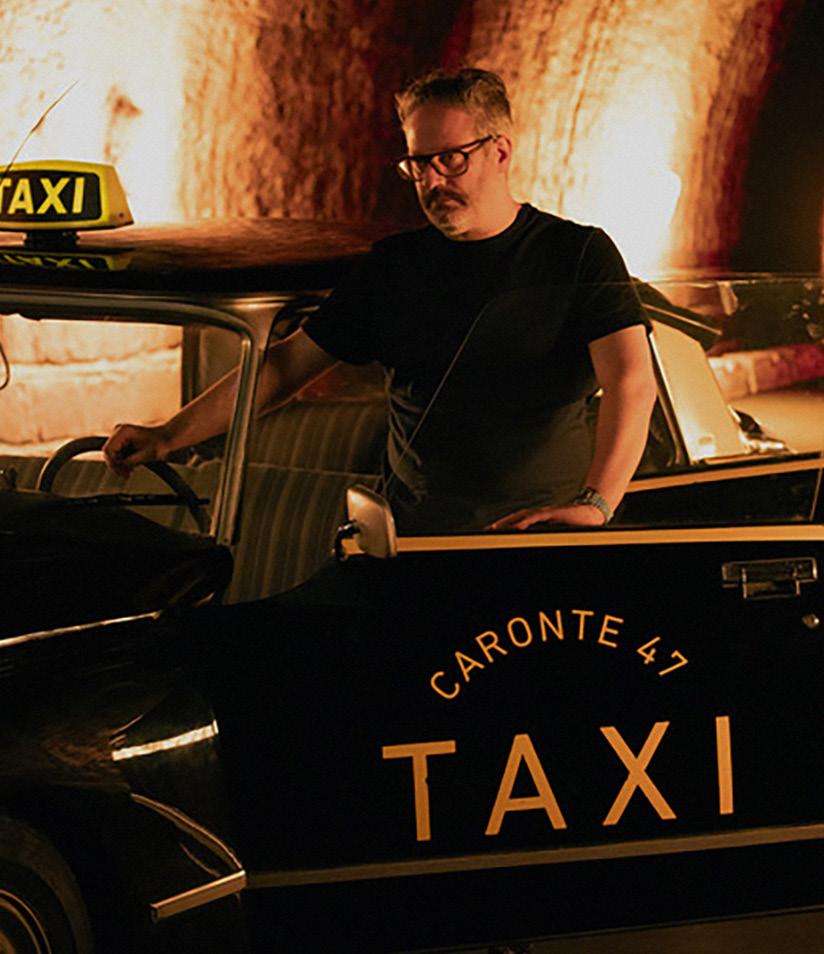

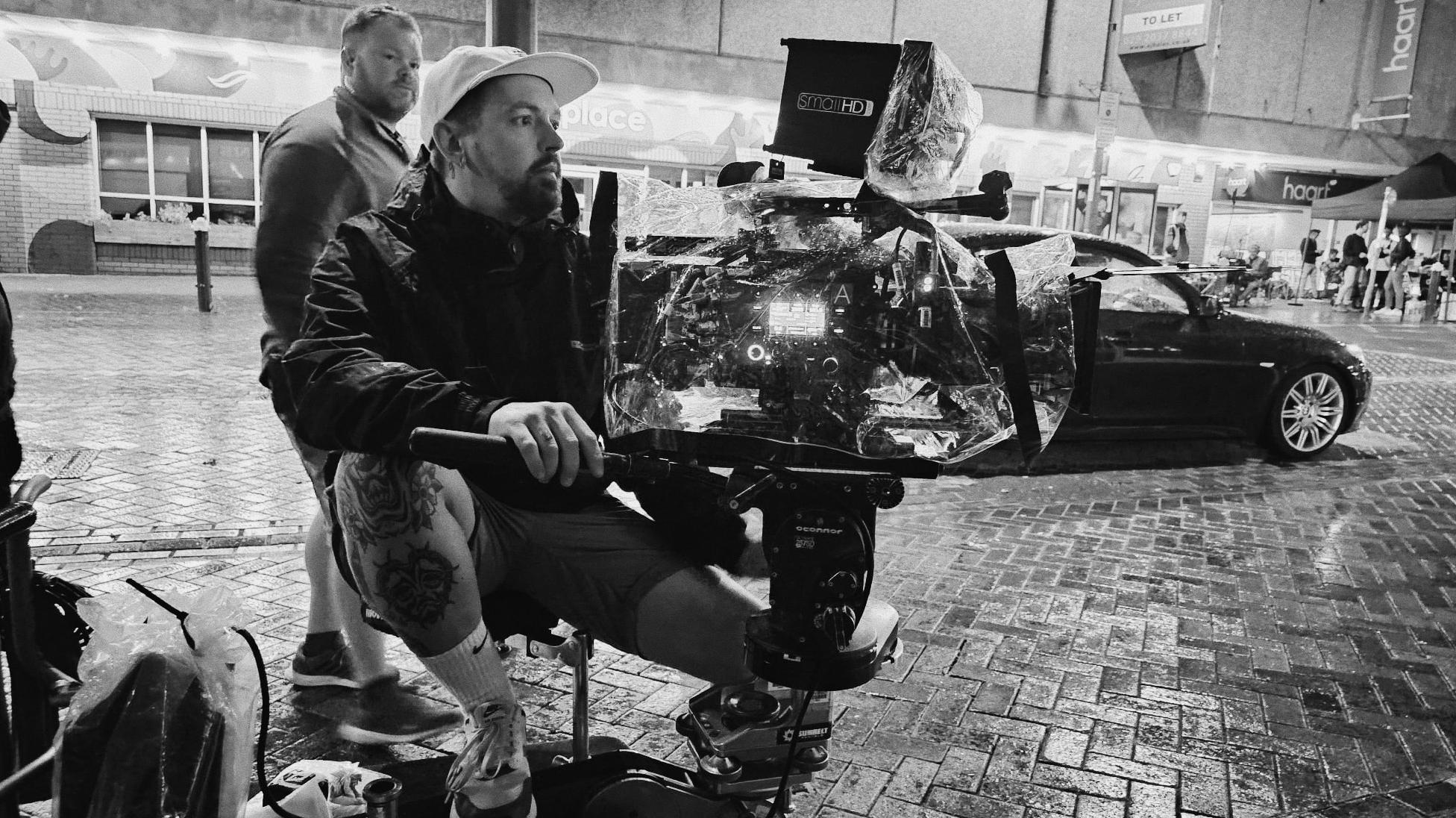

BERLIN ASSOCIATES:
Edward Ames shot the opening block of Waterloo Road S12 for Wall To Wall/BBC.
Al Beech shot BBC’s Silent Witness S27 with directors Toby Frow and Rob Bangura. Claudio Cadman is shooting Phoenix Ris e for BBC.
Nick Cox is working on the second block of Waterloo Road S12. Len Gowing recently lit So Awkward S8, for Channel X North/CBBC, and is now on Granite Harbour for LA Production/ BBC Scotland. Annemarie Lean-Vercoe recently shot episode two of Call The Midwife with director Avril Evans and episode five, directed by Sarah Esdaile. Trevelyan Oliver worked on The Marlow Murder Club for Monumental TV/ UKTV with director Steve Barron. Benjamin Pritchard lit the BBC’s Conan Doyle Project Andrew Rodger has wrapped on BBC’s Odd Squad Pete Rowe recently completed shooting Beyond Paradise 2 for Red Planet/BBC. James Swift is shooting the second block of new TV series Protection for New Pictures/ITV,
directed by Sasha Ransome. Alistair Upcraft lensed on Dead Hot for Quay Street Productions. Matt Wicks has finished on Vigil S2 for World Production/ITV with director Andy De Emmony. Phil Wood shot on After The Flood, for Quay Street Productions/IT, and is now on The Bay S5 for Tall Story Pictures/ITV.
INTRINSIC:
Gareth Munden has been lighting the delayed Italian extravaganza, The Opera. Malcolm McLean operated on See No Evil. James Mather ISC has been shooting Trad in Ireland, where Philip Blake has also been shooting Ready Or Not Bebe Dierken finished the Brian Epstein biopic Midas Man in Liverpool,
16 SEPTEMBER/OCTOBER 2023 CINEMATOGRAPHY WORLD
Our regular round up of who is shooting what and where
W HO, WHAT, WHEN & WHERE
This page: Oscar Faura on The Young Woman And The Sea (photo by Joachim Rønning); Sam Thomas at the camera; Pete Rowe GBCT on Beyond Paradise; and Gareth Munden shooting The Opera.

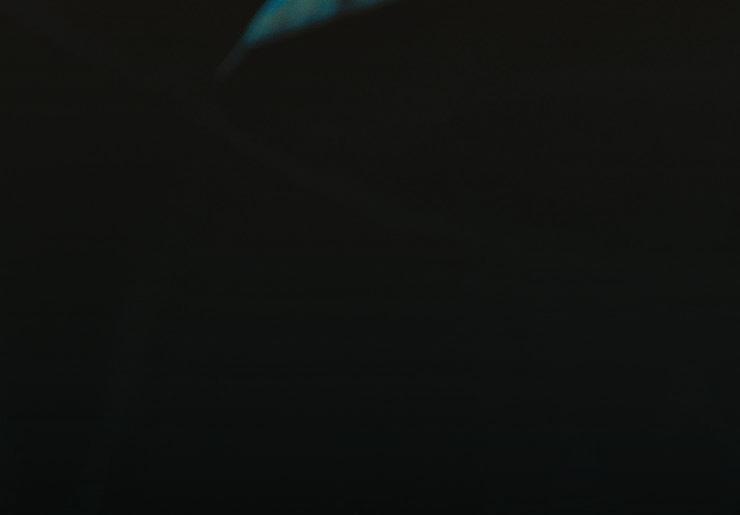
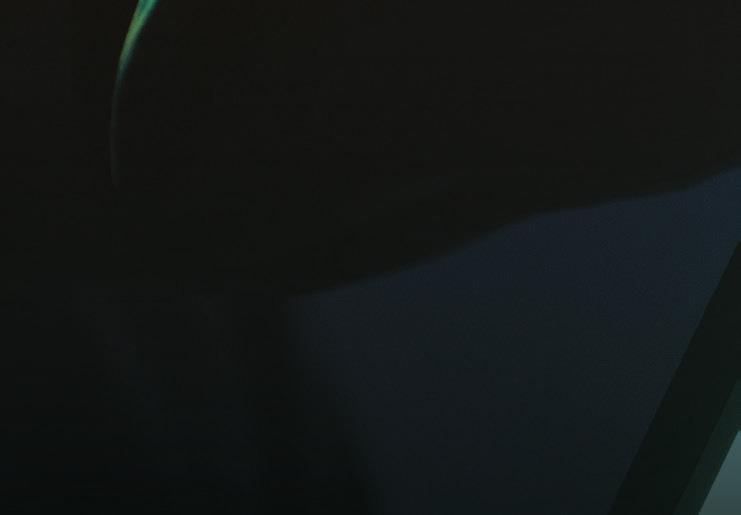




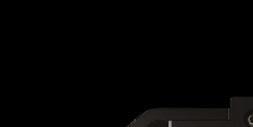





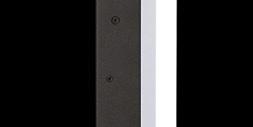

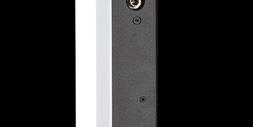
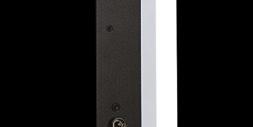









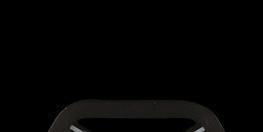









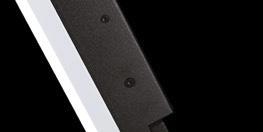



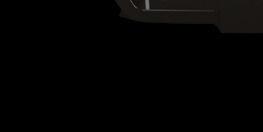















IN ANY WAY SHAPE OR FORM APUTURE.COM NOW AVAILABLE IN 30, 60 & 120 CM MEET US AT STAND 11.B22
and returned to Germany to shoot the Iraq War drama The Second Attack In TV drama, Michal Sobocinski has been shooting The Serpent Queen David Liddell lit the Blue Unit on Band Of Spies in Hungary and Malta. Rasmus Arrildt DFF finished on A Thousand Blows, where Gabi Norland has been operating Tom Hines started his block of Beyond Paradise after some Midsomer Murder s. Andrew Johnson has been back at Casualty Nic Lawson shot on Vigil Simon Hawken FNF, Martin Roach and Lynda Hall have all been busy with commercials, trailers, idents and corporate films.
ECHO ARTISTS:
Nadim Carlsen DFF has wrapped on the feature Locust, directed by Keff. Carlos Catalan is shooting Alexandra Brodski’s episodes of upcoming Disney+ series Rivals Federico Cesca ASK shot the first and third block of HBO/BBC/Bad Wolf’s Industry S3, directed by Isabella Eklöf. Andrew Commis ACS is lighting Charles Williams’ upcoming feature Inside Nick Cooke is lensing Tom George’s episodes of BBC’s Sherwood S2. Evelin van Rei NSC has graded her episodes of ITV/Sister Pictures’ Passenger Korsshan Schlauer recently lensed the first block of BBC3 series Boarders, directed by Ethosheia Hylton.
Bartosz Swiniarski is shooting the feature China Sea, directed by Jurgis Matulevicius for Lava Films. Felix Wiedemann BSC lensed Michael Kofler’s feature Second Hand Land. Sean Price Williams is shooting the feature Harvest, with director Athina Rachel Tsangari for Sixteen Films. Stuart Bentley BSC, Nicolas Canniccioni, David Chizallet AFC, Rachel Clark, Ruben Woodin Dechamps, Edgar Dubrovskiy,
Bonnie Elliott ACS, David Gallego ADFC, Charlie Herranz, Jo Jo Lam, MacGregor, Anders Malmberg, Patrick Meller, Lachlan Milne ACS NZCS ASC, Michael Paleodimos, Will Pugh, Noël Schoolderman, Niels Thastum DFF, Chloë Thomson BSC and Maria von Hausswolff have all been shooting commercials.

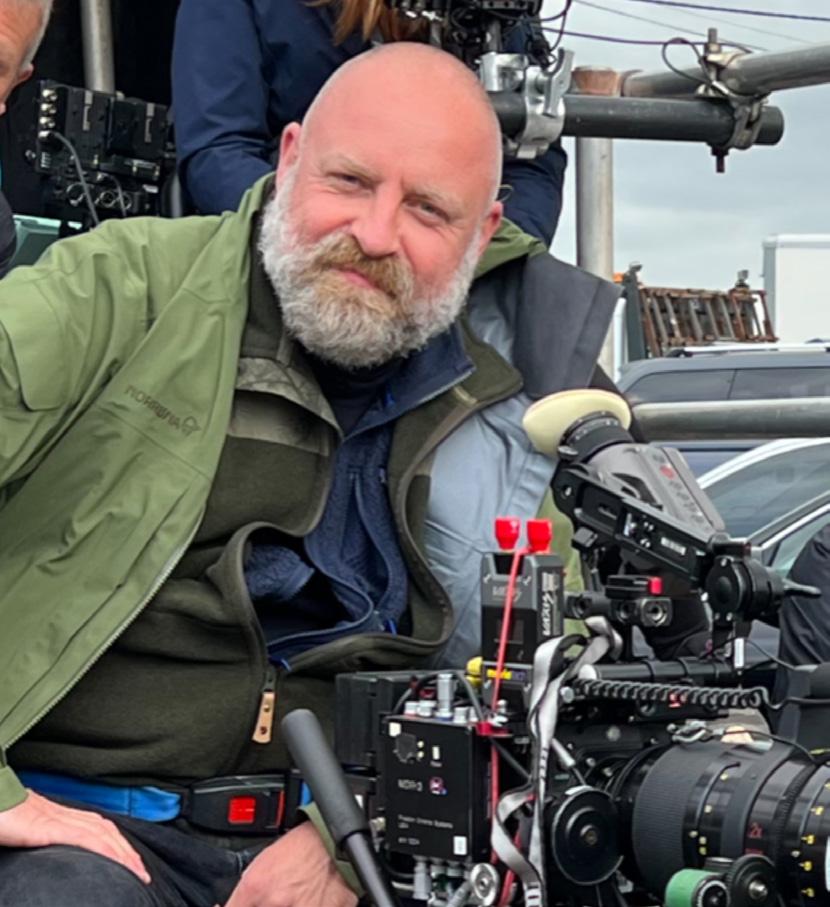

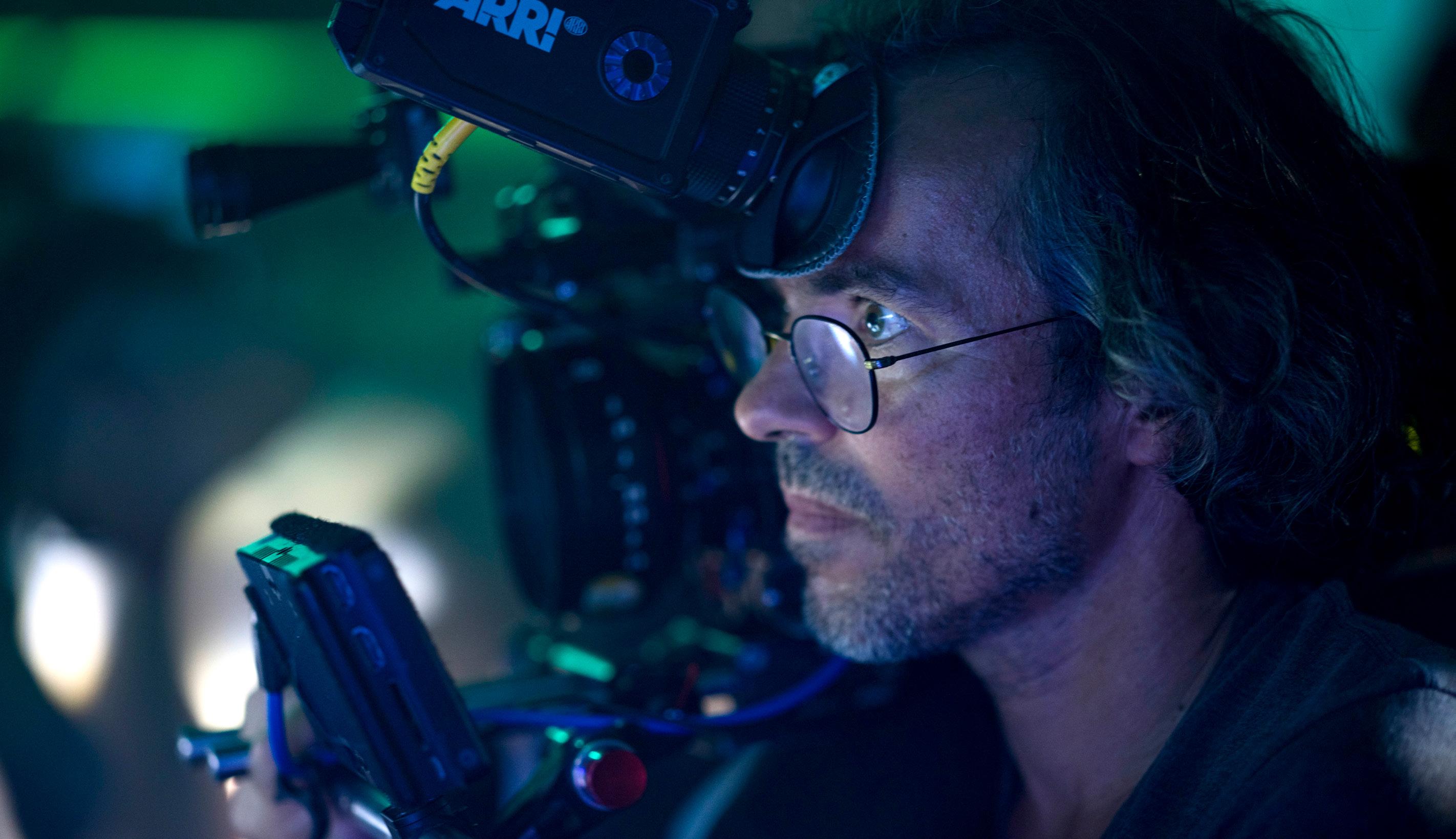
18 SEPTEMBER/OCTOBER 2023 CINEMATOGRAPHY WORLD WHO, WHAT, WHEN & WHERE
This page: all photos of DP Nicolas Canniccioni shooting How To Have Sex , directed by Molly Manning Walker; except for, Rasmus Arrildt at the camera.



LUX ARTISTS:
Rob Hardy BSC ASC shot a McDonalds ad directed by Ninian Doff, and an Uber Eats spot directed by Steve Rogers. Arnaud Potier AFC lit a Cathay Pacific commercial directed by We Are From LA. Mauro Chiarello Ciardo framed an Indeed ad directed by Ian Pons Jewell and a Playstation TVC directed by Henry Hobson. Jarin Blaschke has wrapped on Nosferatu directed by Robert Eggers, starring Aaron Taylor-Johnson and Lily Rose-Depp. Michael McDonough BSC ASC has wrapped on The Decameron with director Michael Uppendahl. Pat Aldinger shot Sodastream, Makers Mark and KFC spots all helmed by Henry Scholfield. James Laxton ASC lensed a Quaker TVC directed by Charlotte Wells. Henry Braham BSC has wrapped on The Instigators with director Doug Liman, starring Casey Affleck and Matt Damon. Kasper Tuxen shot a Zalando ad directed by Pantera. Justin Brown lensed a Balenciaga TVC for director Mau Morgo. Arseni Khachaturan is prepping for Luca Guadagnino’s upcoming feature and shot an NDA commercial with Kathryn Bigelow. Sebastian Blenkov shot a McDonald’s ad for Sam Brown. Alejandro Martinez has been shooting on HBO’s House Of The Dragon S2. Olan Collardy has wrapped on The Last Swim, with director Sasha Nathwani. Christopher Aoun is shooting Cherien Dabis’ feature All That’s Left Of You Tasha Back shot ITV’s The Tower S3 directed by Rene van Pannevis. Nicholas Bolduc CSC is shooting The Count Of Monte Cristo, helmed by Matthiew Delaporte and Alexandre Patelliere. André Chemetoff lit a Burberry spot for Tyrone Lebon. Crystel Fournier AFC has wrapped on Ollie directed by Antoine Besse. Eric Gautier AFC shot a Eurostar commercial directed by Francois Rousselet. Pat Golan framed a Louis Vuitton TVC for Albert Moya, an Orange ad directed by Sam Pilling, and a Zara spot directed by Rubberband. Daniel Landin BSC shot a Hornbach commercial with Steve Rogers. Monika Lenczewska PSC shot Under Armour and Sephora spots, both directed by Jonas Lindstroem. Julien Poupard AFC has wrapped on the feature Les Indésirables, directed by Ladj Ly. Mattias Rudh FSF lensed an EE ad directed by Sam Pilling. Adolpho Veloso
ABC lit a Kia spot directed by Frederik Bond. Jake Scott shot an NDA promo and an Evian ad, both directed by Camille Summers Valli. Nanu Segal BSC has wrapped on The Radleys with director Euros Lyn, starring Damian Lewis. Harry Wheeler shot a TVC directed by Mau Morgo, a McDonalds spot directed by We Are From LA, and an Adidas commercial helmed by Daniel Wolfe.
MCKINNEY MACARTNEY MANAGEMENT: Ben Butler and Alessandra Scherillo have been shooting commercials. Denis Crossan BSC is shooting on The Rig S2 for Amazon. Jean Philippe Gossart AFC is filming Wheel Of Time S3 for Amazon. Dale Elena McCready BSC NZCS is filming Sky Studios’ Day Of The Jackal Richard Stoddard is shooting The Red King for ITV. Gavin Finney BSC prepping on Wolf Hall S2 for BBC2. Mick Coulter BSC is prepping Hallmark’s A Scottish Love Scheme (working title). Steve Lawes has finished on Partygate for C4. Richard Mott is filming The Gathering for C4. Robin Whenary is filming Storyland for RTE.
WORLDWIDE PRODUCTION AGENCY: PJ Dillon ISC ASC continues principal photography on House Of The Dragon S2 with director Alan Taylor for HBO. Pedro Cardillo is shooting the new ITVx series Joan with director Richard Laxton. Jamie Cairney BSC is shooting the feature film Joy with director Ben Taylor for Wildgaze Films, Pathé and Netflix. Bryan Gavigan has started on the new ITVx series Ruth with director Lee Haven Jones. Paul Morris continues on BBC’s Blue Lights S2 with directors Adam Patterson and Declan Lawn. Mattias Troelstrup DFF is lighting Sleepover with director Eva Husson for Quay Street Productions, Star/Disney+. Kanamé Onoyama AFC shot a block of the new FX series Say Nothing with director Alice Seabright. Stephen Murphy ISC BSC has prepped the final episodes of FX’s Say Nothing with director Micheal Lennox. Anna Patarakina FSF is shooting the six-part series Insomnia with director Börkur Sigthorsson for Left Bank Pictures/Paramount+.
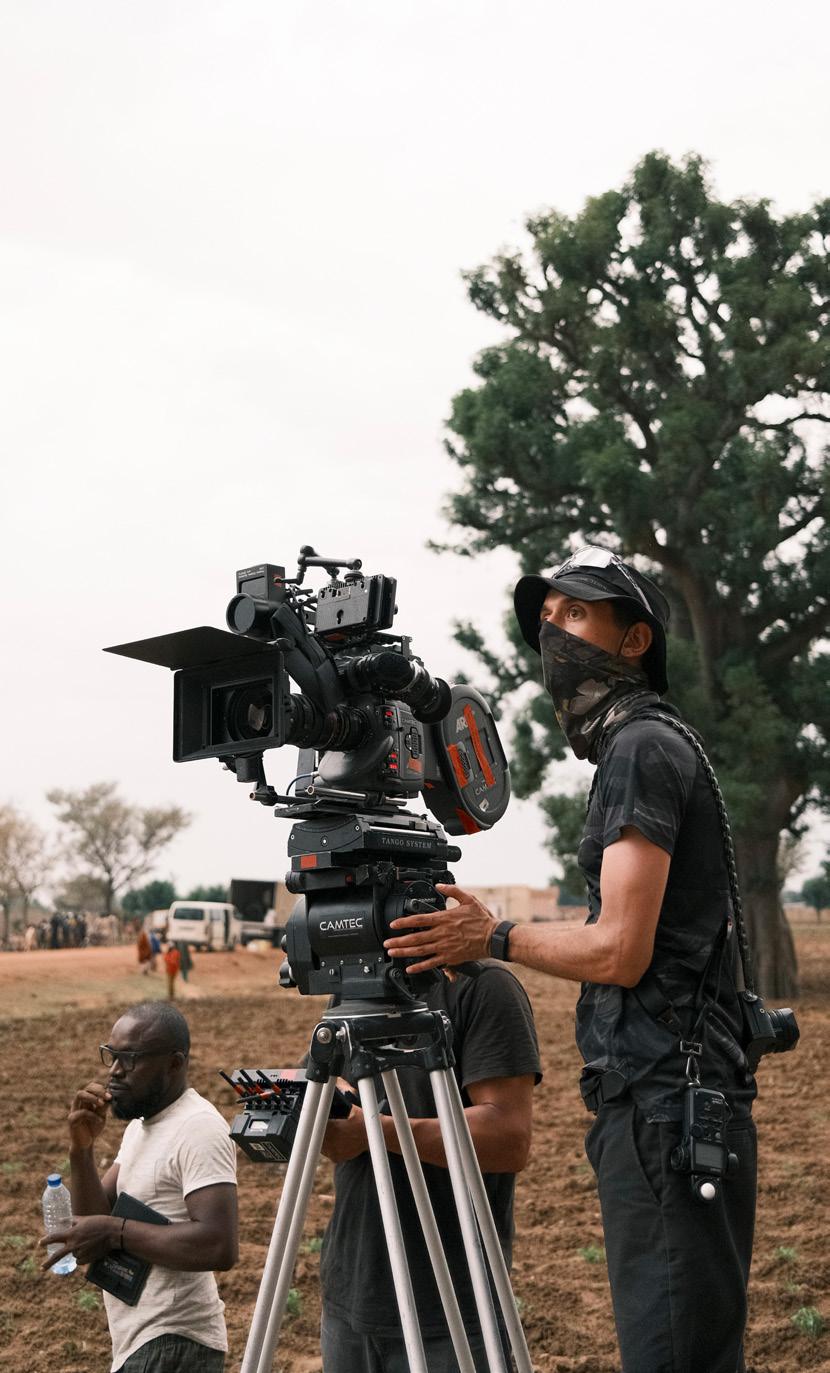
Ruairí O’Brien ISC BSC is shooting on the new

Playground Entertainment/Sky series Small Town, Big Story with writer/director Chris O’Dowd. Tony Slater Ling BSC is lighting Bad Sisters S2 with director Dearbhla Walsh for Apple TV+. Richard Donnelly ISC has started on the new HBO Max series Dune: The Sisterhood with director Richard J. Lewis. Robert Binnall is prepping for the feature, The Morrigan, with director Colum Eastwood for Cowboy Cosmonaut Films. Catherine Derry has completed principal photography on A Thousand Blows with director Nick Murphy for Disney+/Hulu. Simon Archer BSC has wrapped on Viaplay’ s Rebus with director Fiona Walton. Björn Charpentier SBC has graded Netflix’s The Gentlemen with director Nima Nourizadeh. Callan Green ACS NZCS has also graded The Gentlemen with directors Eran Creevy and David Caffrey.

20 SEPTEMBER/OCTOBER 2023 CINEMATOGRAPHY WORLD WHO, WHAT, WHEN & WHERE
Vanessa Whyte has completed final colour on Apple TV+’s Horseface with director George Kane. Pieter Snyman travelled to Madrid with Pulse directing duo The Rest for a large EA spot. Matthew Emvin Taylor shot with director Patrick Killingbeck and Studio Yes for Roland Printers. Thomas Hole wrapped with Will McCullen for a branded DAZN campaign, and shot with director Keane Shaw for Asahi via Gunga Production Agency. Dan Holland lit for This Is Annex on a Ninja TVC with director Abbie Stephens. Joel Honeywell travelled to Jamaica with director William Stefan Smith and ZRD Productions for an Adidas campaign. Carl Burke shot multiple jobs, including Nissan, Conde Nast and Vogue for Stadium and director Giorgio Bruni. Edward Gibbs shot with Trizz and director Oriol Puig for Tries in Madrid. Alexandre Jamin shot with Be Sweet director Nick Bartleet in Chile for Oysho.


VISION ARTISTS:

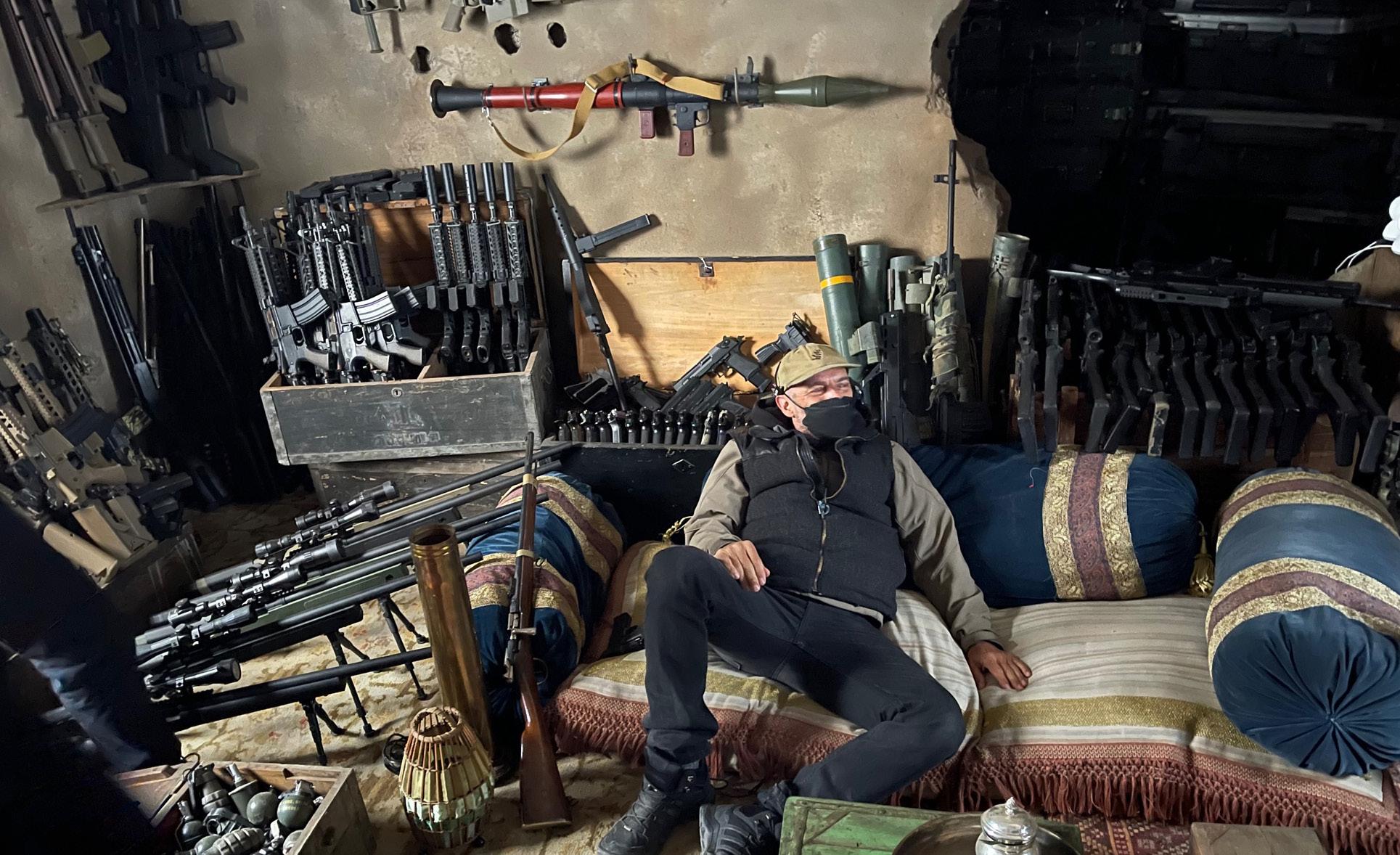
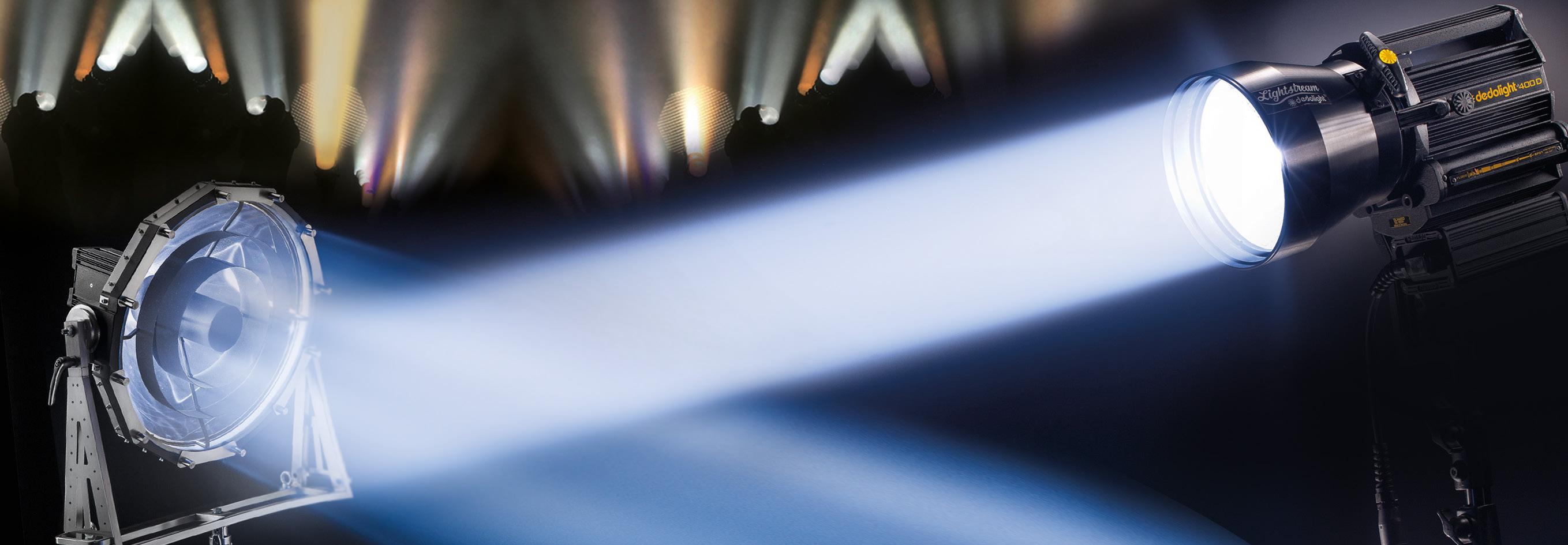
Anna MacDonald’s feature documentary Asog, directed by Sean Devlin and executive produced by Adam McKay and Alan Cumming, premiered at the Marché Du Film in Cannes and screened at Tribeca. The docu-drama hybrid follows Rey, a non-binary Filipino school teacher, on a road trip to compete in a drag pageant. Nick Morris is shooting
Sweetpea for See-Saw Films, directed by Ella Jones, based on the serial-killer-with-a-twist book from CJ Kuse. Benedict Spence has graded the new Netflix series Eric starring Benedict Cumberbatch, directed by Lucy Forbes. Jaime Feliu-Torres is grading tests for the BFI feature Free, directed by David Alexander for Dark Pictures. Watch out for Jonas Mortensen’s work on the TV special of Merman’s There She Goes, starring David Tennant and directed by Toby Trackman. Jonas has also been shooting a comedy pilot with Catherine Morshead at Fudge Park. Kia Fern Little shot the short Good Vibes Only, following an affable radio DJ who after his friend dies by suicide, broadcasts a show in his memory, produced through Primary Colour Pictures and directed by Christopher Rogers. Will Hanke has now wrapped a new comedy pilot for Avalon Television/BBC and directed by Alice Sneddon. Lorena Pagès saw the release of her second unit work on The Greatest Days, the Take That-inspired musical directed by Coky Giedroyc, now released theatrically worldwide. Stephen Dunn saw the release of short documentary Out There on online platform Nowness, which focusses on the real stories of youths who were used and trafficked by county lines drug gangs. Courtney Bennett premiered his short music film Dirt In The Diamond at Tribeca Film
THE MAGIC +500%

CINEMATOGRAPHY WORLD SEPTEMBER/OCTOBER 2023 21
Opposite: Rina Yang eyeing-up a couple of shots; and Arseni Khachaturan on an upcoming project with Andrew Dosunmu.
This page: André Chemetoff on a Burberry job, (photo by Tyrone Lebon); Ben Seresin BSC ASC relaxing on the set of The Mother; John Lynch shooting Rivals, with director Elliot Hegarty; and Erik Henriksson the runway for Koenigsegg, directed by Nim Kyong Ran.
UK and Ireland Rental and Sales Distribution: www.cirrolite.com Visit the dedolight website: www.dedoweigertfilm.de ANZ_CineWorld_02-22.indd 1 21.02.22 13:14 WHO, WHAT, WHEN & WHERE
WHO, WHAT, WHEN & WHERE
Festival, directed by Renee Maria Osubu directed film, produced by Somesuch and nominated for the Tribeca X Award. Eoin McLoughlin’s Two For The Road, directed by Locky McKenna, won best short and best cinematography at Galway Film Festival. Ryan Eddleston has been shooting second unit on the new series of Doctor Who in Wales. Rhys Warren was part of a longform doc about Britpop band Blur, directed by Simon Lane. Arthur Loveday has been shooting sports content for Adidas. Ian Murray has been lighting promos for Raye with Otis Dominique at Kode Films. James Watson worked with VCCP on spots for Tango, with regular collaborator Ben Tonge. Jim Jolliffe lit for Rogue Films and Max Fisher on a piece for the Royal Marines. Jack Wilkinson has been shooting Coop spots with Charlotte Regan. James Blann teamed-up with Hauke Hilberg to shoot for Czar films in Germany. Luke C. Harper has been shooting sports promo for Riff Raff Films. Moritz Moessinger lit gin spots for Mert Alas via January Productions. Luke Scott reteamed with advertising partners Hogarth to shoot content for Soap and Glory. Martin Hill is shooting food and supermarket pieces for Rattling Stick. Spike Morris has been lensing fashion spots for LuluLemon and Hugo Boss. Tim Fok has been lighting a range of food with Greenroom and Agile.
LOOP TALENT:
The agency welcomes DP Dave Miller to its roster. Dave is successful in narrative and short form with credits including the upcoming Netflix feature T.I.M., directed by Spencer Brown through Stigma Films. Jon Muschamp is shooting Siobhan McSweeney›s Spudbad for Lookout Point. Matt Gillan is prepping a feature. Emma Dalesman is also prepping a feature, shooting in Scotland. Lorenzo Levrini is prepping a feature too. Matt North is shooting on ITV’s Tell Me Everything S2. Ali Little has graded a C4 drama. Chris Fergusson is working on Bad Education Nicholas Bennet, Rik Burnell, Martyna Knitter, Kyle Macfadzean, Chris
Gary Kent have been operating Steadicam on short form projects.

CASAROTTO RAMSEY & ASSOCIATES:
Annika Summerson BSC is shooting the new series of Bad Wolf’s Dope Girls with director Shannon Murphy inspired by Marek Kohn’s nonfiction book ‘Dope Girls: The Birth Of The British Drug Underground’. Hélène Louvart AFC has wrapped principal photography in Brazil on Motel Destino with director Karim Aïnouz, and is shooting Annemarie Jacir’s All Before You in Palestine. Tim Palmer BSC has wrapped principal photography on RubyRock Pictures’ Geek Girl, a Netflix series based on Holly Smale’s novel.
WIZZO & CO:
The agency welcomes Scott Coulter to the roster, who is currently shooting G’Wed alongside director Akaash Meeda, with whom he also shot Man Like Mobeen S4. Congratulations to Peter Simonite whose feature Day Of The Fight, directed by Jack Huston, received its world premiere at the Venice Film Festival. Nicola Daley BSC ASC has wrapped and will shortly grade Halo S2. Susanne Salavati has wrapped the final eps of True Love alongside director Carl Tibbetts, and has graded the opening episodes of The Lazarus Project S2. Tim Sidell BSC shot an episode of an embargoed Apple drama alongside director Jon East, lit the short, Catching Crayfish, directed by Eion Doran, and also shot artist Karen Russo’s film Sinkholes Oli Russell is with director Kieran Hawkes on the drama Red Eye Steven Ferguson is shooting Dinosaur directed by Niamh McKeown. Chas Appeti is prepping an embargoed project. Charlie Goodger has graded Big Boys S2. Christophe Nuyens SBC is on a Disney+ embargoed drama. Kiaran Hawkes has graded Netflix’s Supacell, directed by Rap Man. Matthias Pilz has now wrapped an episode of Grace S4, directed by Dan Zeff. Jan Richter-Friis DFF is shooting an embargoed drama in Italy. Sverre Sørdal FNF shot the short For Fox Sake, directed by Minah Kim.
Arran Green worked with director Samuel Douek, and Ben Magahy shot with Zac Ella. Molly Manning Walker shot with Billy Boyd Cape, Dmytro Nedria shot with Paul Akinrinola. Hamish Anderson shot with Tom Day. Karl Oskarsson IKS worked with Martin Aamund, Murren Tullett with director Dominic O’Riordan and David Procter with Joe Connor.
PRINCESTONE:
Of the agency’s DPs… Diego Rodriguez was in Australia shooting Astronaut Films’ documentary The Reggae Girlz, following the fortunes of the Jamaican women’s soccer team at the 2023 World Cup, with director Sharmeen Obaid Shinoy. He has also been filming Poised, a feature-length doc about ex-MMA champion Steven France, directed by Toby Robson for Two Yanks and a Brit UK. Of the agency’s camera/Steadicam operators Junior Agyeman ACO shot dailies on Mary And George for Hera Pictures, starring Julianne Moore and Nicholas Galitzine, with Oliver Hermanus directing and Alexander Dynan as the DP, and also filmed on Tim Burton’s Beetlejuice 2 with DP Haris Zambarloukos BSC GSC. Simon Baker ACO worked on the final series of The Crown with directors Christian Schwochow, Alex Gabassi and Stephen Daldry and DPs Adriano Goldman ABC BSC ASC and Sophia Olsson for Left Bank Pictures/ Netflix. Michael Carstensen ACO has been shooting on House Of The Dragon S2, starring Matt Smith, Graham McTavish and Eve Best among others. Rob Hart ACO is filming on Sleepover, a five-part suspense drama produced by Quay Street Productions for Disney+ with director Eva Husson, DP Mattias Troelstrup, and starring Denise Gough and Ambika Mod. Tony Jackson ACO has returned from Bucharest and Spain where he was shooting the 20 th Television/Hulu mini-series We Were The Lucky Ones with director Thomas Kail and DPs Tim Ives and David Pimm, starring Joey King, Logan Lerman and Robin Weigert. Tony Kay ACO shot dailies on the new series of Rebus with DP Simon Archer, operated Trinity on Mary And George for DP Alexander Dynan, and also shot dailies on The Radleys for DP Nanu Segal BSC, directed by Euros Lyn, starring Damian Lewis and Kelly Macdonald. Dan Nightingale ACO shot on the new series of Sherwood with DP Simon Tindall, directed by Clio Barnard, starring David Morrissey, Lesley Manville, David Harewood and Robert Lindsay, and is B-camera operator on the live-action feature How To Train Your Dragon, shooting in Titanic Studios in Belfast, with director Dean Blois and DP Bill Pope ASC. Joe Russell ACO shot on Andor S2 with DPs Christophe Nuyens SBC, Mark Patten BSC and Damia n Garcia, and directors Ariel Kleiman, Janus Metz and Alonso Ruizpalacios. Sean Savage
O’Driscoll, Bertrand Rocourt are shooting commercials. Ali Asad, Aman K Sahota, Tom Turley, Tom Watts, Olly Wiggins, Paul MacKay,
Natalja Safronova and Jerry Amadi Pradon are working in short form. Camera Operator Jem Rayner
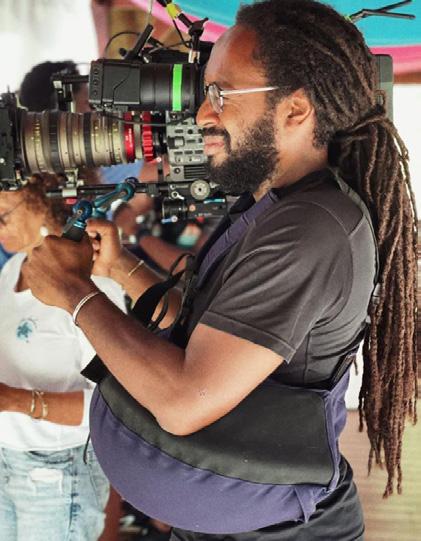
GBCT ACO operated dailies on The Gentlemen James Anderson ACO did dailies on Boat Story Jack Smith and Alice Sephton have been operating on commercial projects. Grant Sandy-Phillips is on The Famous Five as Steadicam operator. Michael Eshun-Mensah did dailies on Queenie, Joan and Mr Bates vs The Post Office Sebastien Joly ACO, Laura Seears, Michael Vega and
Ashley Barron ACS shot an embargoed project alongside director Margot Bowman. Carmen Pellon Brussosa shot the short film Guts, directed by Florence Winter Hill. Nick Dance BSC has graded Sky’s Joy To The World Gary Shaw is prepping an embargoed drama. Darius Shu has graded the short film Stone, directed by Jake Graf. Luke Bryant has done the DI on Extraordinary S2. Franklin Dow shot with director Kathryn Ferguson on a doc about Humphrey Bogart. Adam Gillham has wrapped A Gentleman In Moscow alongside director Sam Miller. Ryan Kernaghan completed on the feature Kneecap, directed by Rich Peppiat, and is now shooting Wreck S2 alongside director Chris Baugh. Antonio Paladino has graded the feature Dance First, directed by James Marsh. Will Bex lit for Chris Balmond, Theo Garland with Henry Littlechild and Joe Douglas for Benji Weinstein. Henry Gill shot with Jess Colquhoun, and Fede Alfonzo with Vadim Jean.
Associate BSC ACO SOC is on the Fire Unit on House of the Dragon S2 for HBO, working with directors Alan Taylor and Andrej Pakereh and DP Alejandro Martinez. Fabrizio Sciarra SOC
Asociate BSC GBCT ACO recently shot on Tim Burton’s Beetlejuice 2 with DP Haris Zambarloukos
BSC GSC, and also worked on the feature Speak No Evil, starring James McAvoy and Mackenzie Davis for director James Watkins and DP Tim Maurice Jones BSC.
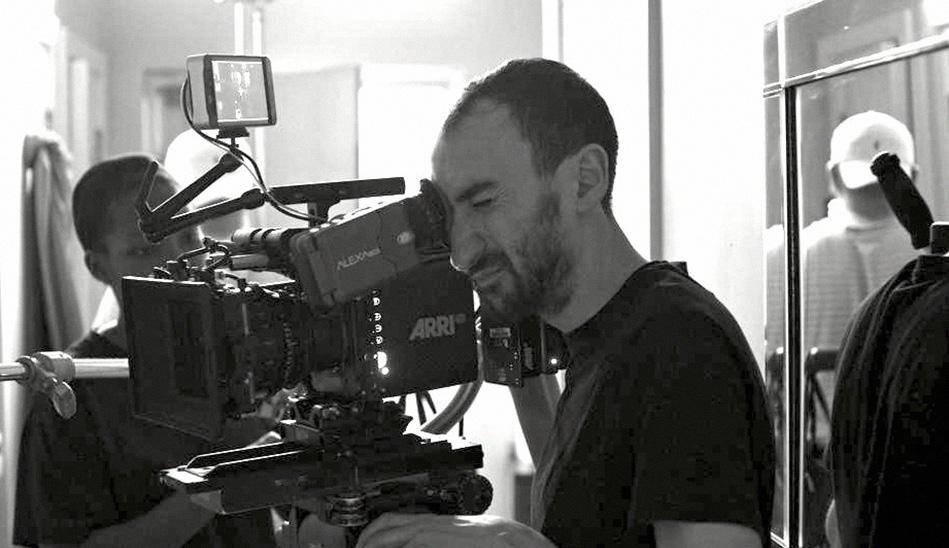
EB Comms:
Matias Boucard AFC shot Les Sentinelles for French Canal+ in Paris. Matthew Chuang
ACS – lit Chief Of War for AppleTV in Hawaii and New Zealand. Ana M. Amortegui worked on Quantum Leap for NBC, and Mihai Malaimare
Jr. ASC lit Francis Ford Coppola’s up-coming sci-fi drama Megalopolis
22 SEPTEMBER/OCTOBER 2023 CINEMATOGRAPHY WORLD
This page: Matt Gillan; Tim Sidell BSC; and Jerry Amadi Pradon in Guadeloupe.
EVERYTHING YOU NEED IN ONE TAKE
Sunbelt Rentals are specialist suppliers of professional end-to-end solutions for content creators in the Film and TV production industry. With a comprehensive and technologically advanced rental inventory of lighting, camera, access, grip, power and infrastructure, we offer a full production solution from prep to wrap.
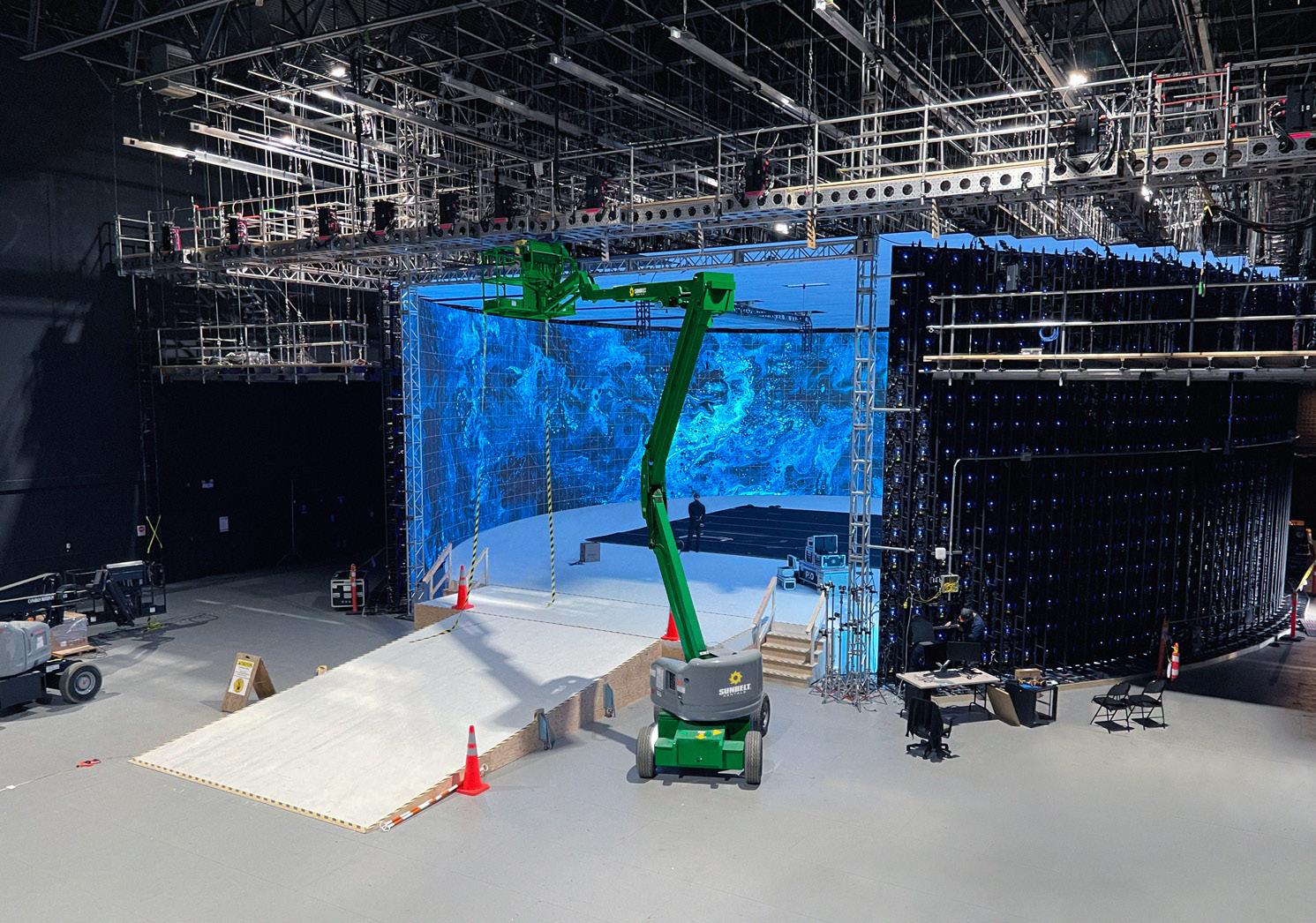

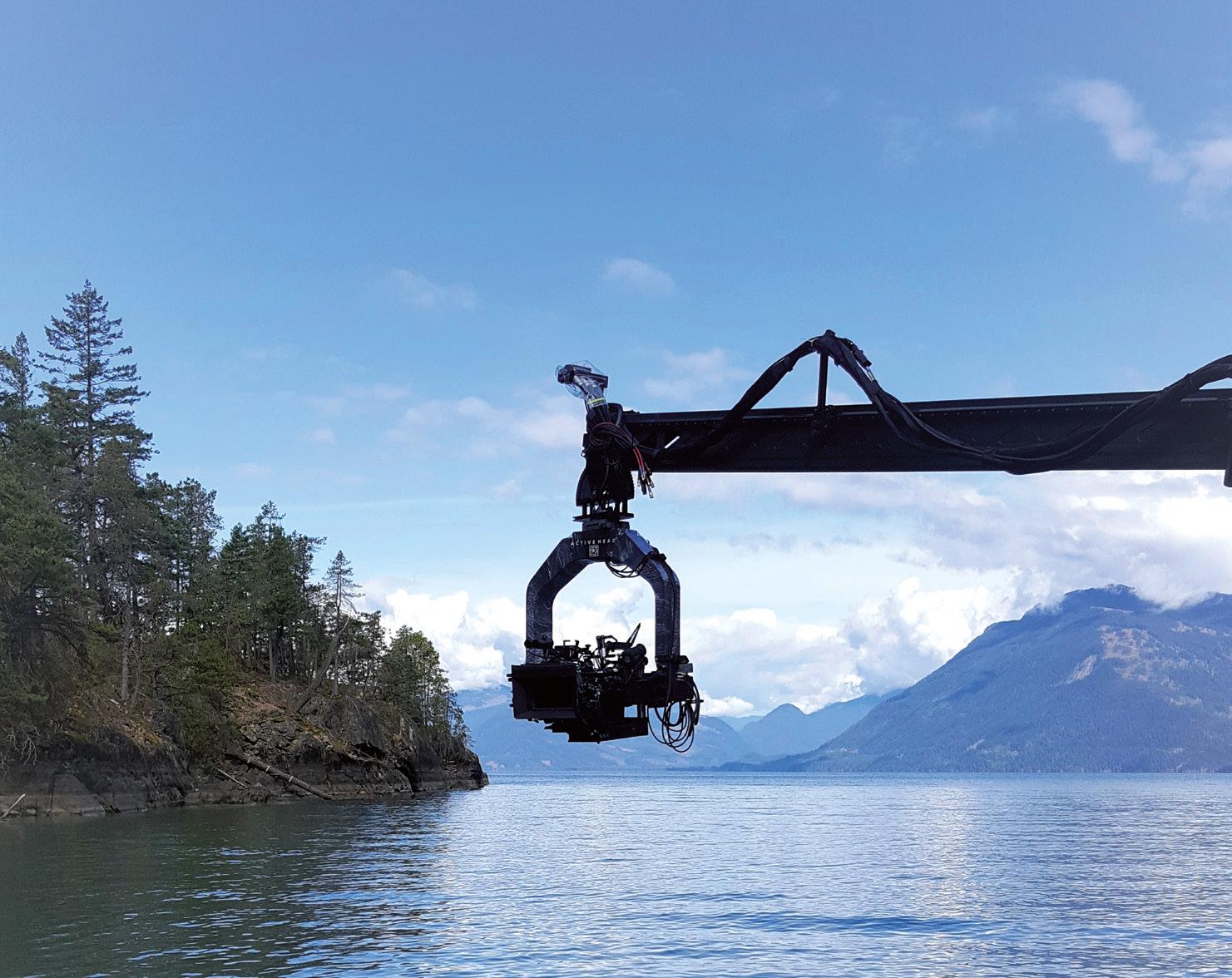
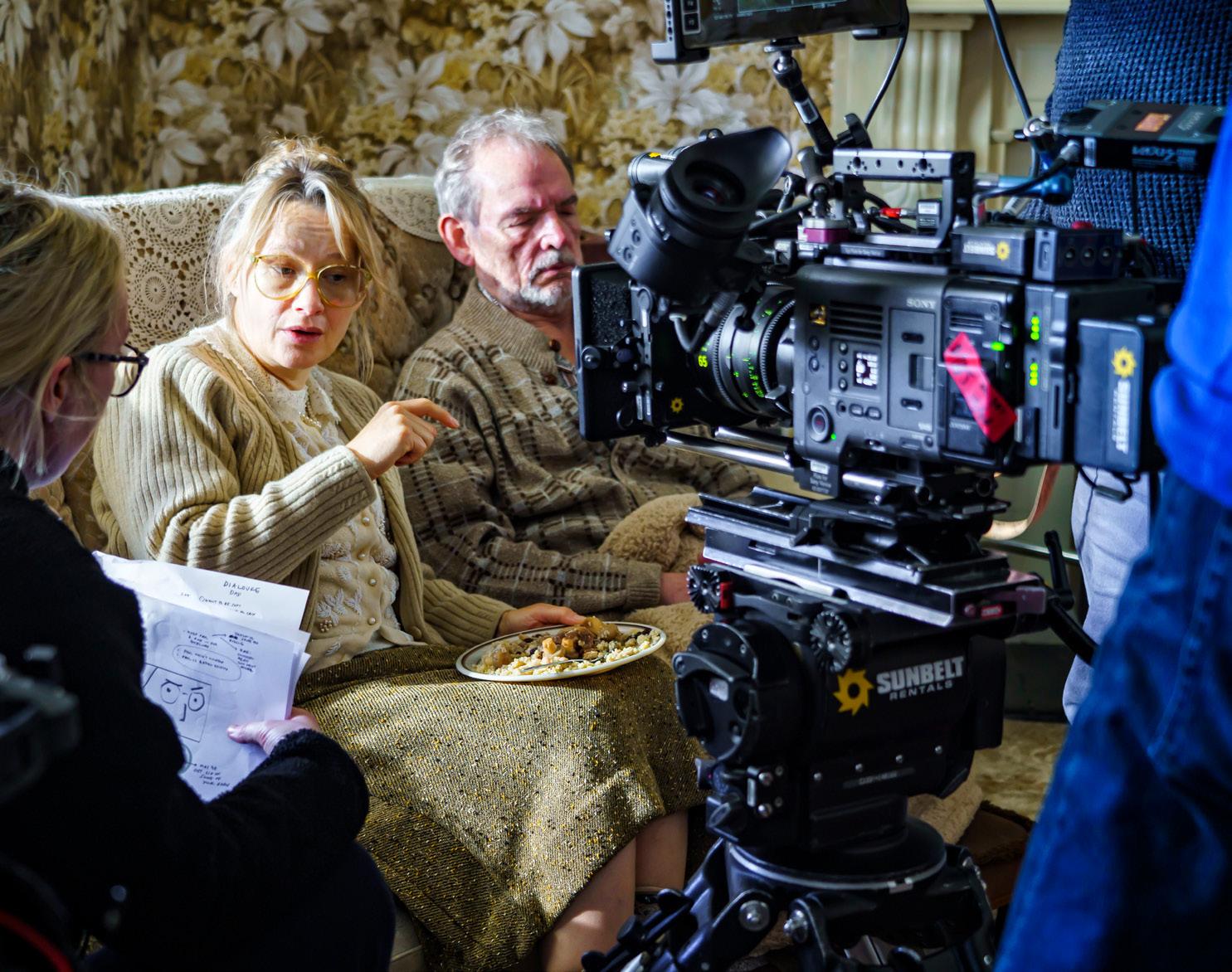
CHIP OFF THE OLD BLOCK
By Natasha Block Hicks
femme cinema’s archetypal romcom Legally Blonde (2001, dir. Robert Luketic).
I’ve never been called Jonathan at any point in my life,” relates camera operator Jonathan ‘Chunky’ Richmond, relaxing on a rare day off at his mum’s house in France. “My family and friends have always called me Chunky.”
As the second son of acclaimed British cinematographer Anthony B. Richmond BSC ASC and make-up artist Linda DeVetta, the name ‘Chunky Richmond’ was likely uttered on a movie set long before Richmond ever held a camera himself.
“I knew my parents didn’t have office jobs,” Richmond recalls of his childhood, “but I never imagined the magnitude of it all until I saw them at work.”
Richmond describes “snippets of memories” travelling to see his father on-location in Europe, and accompanying his mother to Elstree Studios where she was working on Indiana Jones And The Temple Of Doom (1984, dir. Steven Spielberg, DP Douglas Slocombe OBE BSC ASC).
“Through one of the stage doors I glimpsed the cockpit of the Millennium Falcon,” he recalls, “I’m very grateful to have seen that era.”
During his A-Levels, Richmond realised that he had
ambitions of an industry career himself. By this point Richmond Snr was living in LA, having split from DeVetta when Richmond Jnr was six. Camera being his key interest, it was only natural for Richmond to reach out to his father.
“I was 18 when I went out to LA,” relates Richmond, “it was the beginning of a truly formative time in my life.”
Richmond Snr offered his son a summer job as a camera loader on coming-of-age baseball film The Sandlot Kids (1993, dir. David Mickey Evans).
“I turned-up on the camera truck on the first day,” Richmond relates, “and someone said, ‘Right, you take this roll of film in the dark, put it into the magazine like this in the dark, and when the magazine comes back you unload it in the dark, and whatever you do, make sure you do it in the dark!’.”
The Sandlot Kids remains one of Richmond’s favourite jobs to date.
“My father made the crew play softball on our days off,” recalls Richmond. “We had Joe Dunton T-shirts made-up with our names on the back and played a double header on the last day of the film. This is where I first truly saw the unity and camaraderie in the camera department and I loved being a part of it.”
At age 23, Richmond was invited by Richmond Snr to pull-focus for the first time on the crime thriller Playing God (1997, dir. Andy Wilson). Richmond’s older brother George, also in the industry, was stepping-up to operator around this time, and the Richmond family trio: DP Anthony, operator George and 1st AC Chunky, would collaborate regularly over the next seven years.

Their work spanned movie genres, going from high school slasher Cherry Falls (2000, dir. Geoffrey Wright) to the Robert De Niro/ Cuba Gooding Jr military memoire Men Of Honor (2000, dir. George Tillman Jr.) to high
“I realise how fortunate I was,” Richmond acquiesces of this filmic ‘upbringing’, “but both George and I were 100% committed to working hard and being good at our jobs, to make sure it was not just handed to us on a plate.”
Then, historical epic Alexander (2004, dir. Oliver Stone, DP Rodrigo Prieto ASC AMC), introduced Richmond to filmmaking on another level.
“I’ll never forget that first day being out in the desert and seeing three articulated lorries handing out spears and shields,” recalls Richmond.

“For the first two months of the film, we would come back to our hotel at the end of the day absolutely caked in blood. The other hotel guests would be aghast at the sight of us.” He laughs at the memory, “that was a truly amazing job.”
In the mid-2000s, Richmond gravitated back to the UK. Still in an operator/1st AC team with his brother George, they worked on films such as the cult football film Goal! (2005, dir. Danny Cannon, DP Michael Barrett ASC) and the dystopian near-future drama Children Of Men (2006, dir. Alfonso Cuarón, DP Emmanuel Lubezki AMC ASC) starring Clive Owen and Julianne Moore.
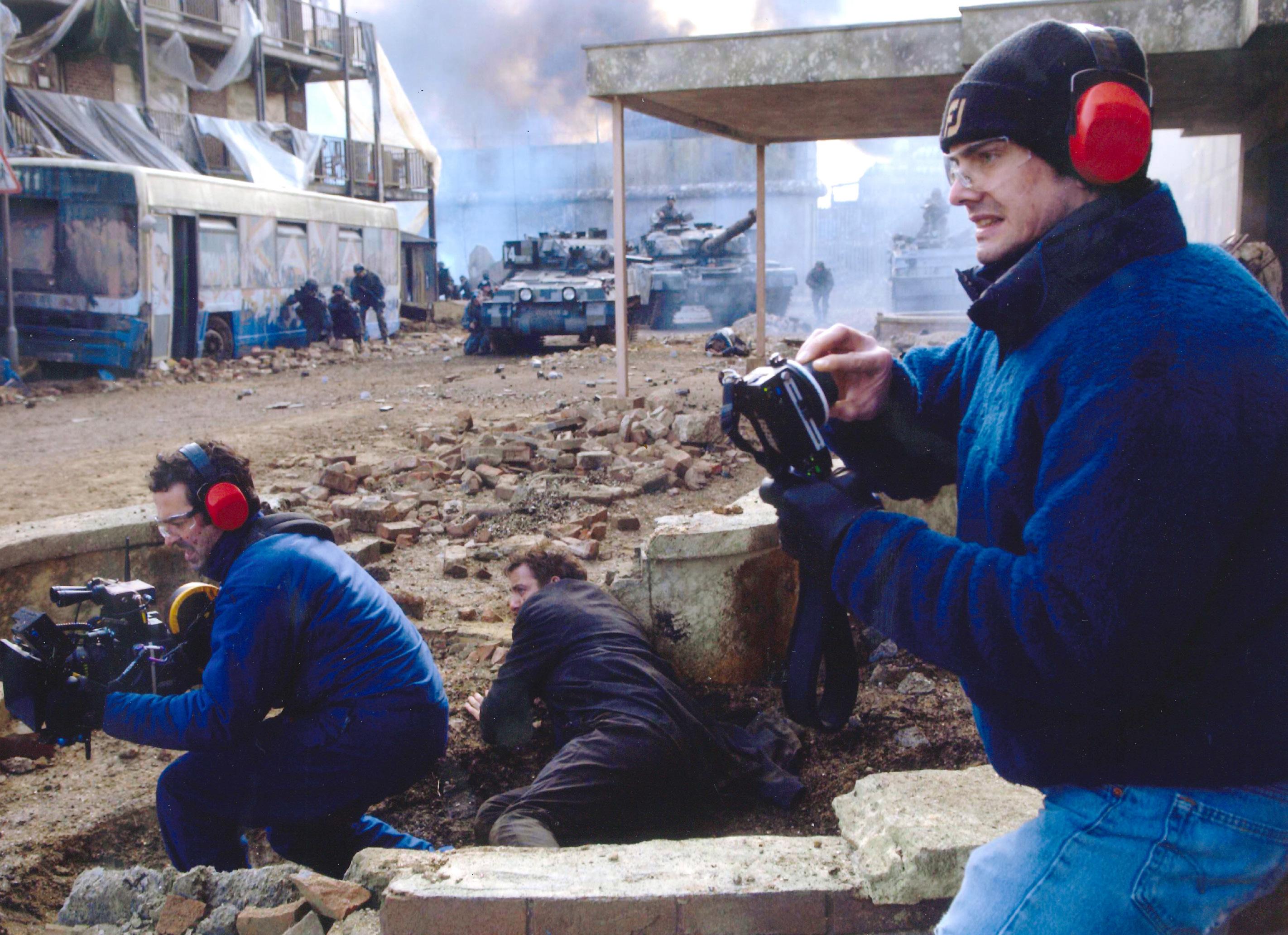
“That is a magnificent piece of cinema,” extols Richmond of the latter, “I can’t tell you how difficult it was to make. Before we started shooting, Chivo (Lubezki) told me, ‘Chunky, this is all going to be shot on the 21mm, but if you think that’s going to be easy, you are mistaken’. Even during production, we knew it was one of those films that would be studied for years to come.”
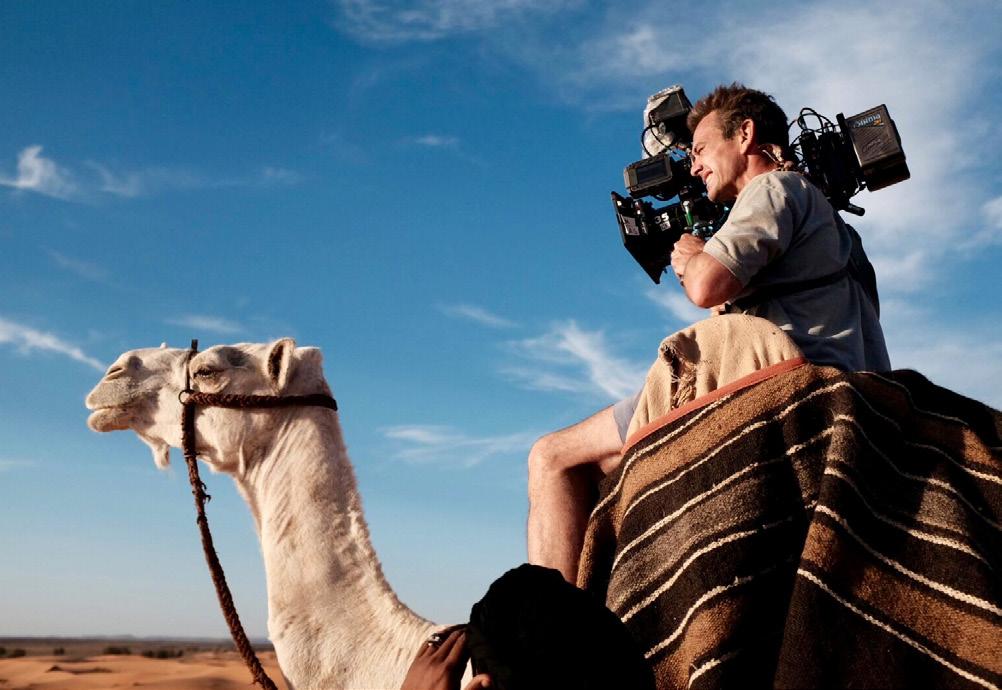
Change was in the air. Whilst shooting additional photography on The Bourne Ultimatum (2007, dir. Paul Greengrass) Richmond met DP Oliver Wood BSC, “one of the most amazing DPs and human beings,” he says.
“I was carrying the camera and Oliver
SMOOTH OPERATOR•JONATHAN ‘CHUNKY’ RICHMOND
24 SEPTEMBER/OCTOBER 2023 CINEMATOGRAPHY WORLD
“
If I’m half the operator that my brother George was before he moved to DP, I’ll be very happy with that
looked at me and said, ‘You would make a good operator’. And I said to him, ‘You could make that happen’.”
Richmond would indeed eventually operate for Wood on Grimsby (2016, dir. Louis Leterrier) and Holmes & Watson (2018, dir. Etan Cohen), one of his most significant collaborations with a DP.
Back in 2007 however, he was finding it tricky to make the leap. Though he took-up the camera operator role for the first time on the sports parody
The Comebacks (2007, dir. Tom Brady, DP Anthony B. Richmond ASC BSC), which he “thoroughly enjoyed”, the offer of working as A-camera 1st AC on Quantum Of Solace (2008, dir. Marc Forster, DP Roberto Schaefer ASC AIC) was an opportunity too good to miss.
“To be part of a 007 James Bond film, that travelled to so many places globally, was a truly magnificent experience,” says Richmond wistfully. “Seeing the Milky Way in the Atacama Desert at the European Space Observatory is an experience that will stick with me for life: a true wonder of the world.”
Richmond eventually made War Horse (2011, dir. Steven Spielberg, DP Janusz Kaminski) his final farewell to the role of 1st AC, thereafter cementing his new operator position with movies such as A Fantastic Fear Of Everything (2012, dir. Crispian Mills, DP Simon Chaudoir) and Kingsman: The Secret Service (2014, dir. Matthew Vaughn) working with his brother George, who was by then a DP.
“My brother was an extremely talented operator,” says Richmond with great affection, “if I’m half the operator now that he was before he moved to DP, I’ll be
very happy with that.”
With a few credits under his belt, and knowing that adding Steadicam to his repertoire would increase his opportunities, Richmond undertook a training course and saved to buy a rig. Flying it out in Eastern Europe for nine months at a time – shooting the first seasons of on-demand streamer shows such as The Alienist (2018, DPs PJ Dylan ASC ISC, Gavin Struthers ASC BSC, Chris Seager BSC, Larry Smith ASC BSC) and The Witcher (2019, DPs Gavin Struthers ASC BSC, Jean Philippe Gossart AFC) –became Richmond’s Steadicam boot camp.



“Over three years, I spent half of it in Budapest: what a great city,” says Richmond, “The Alienist, although it was very dark, had amazing sets and fantastic DPs. Getting into Steadicam really took my enjoyment of operating up a notch.”
When probed on the highlight of the operating chapter of his career to date, Richmond doesn’t hesitate, he is living it right now: Mission: Impossible – Dead Reckoning Part One (2023, dir. Christopher McQuarrie, DP Fraser Taggart) and the upcoming Mission: Impossible – Dead Reckoning Part Two
“I’m so grateful to Fraser for giving me this opportunity, and for my relationship with Christopher McQuarrie,” says Richmond, although he alludes to the fact that – with 70% of the high-intensity action franchise being shot on Steadicam – it has tested him both physically and mentally.



On one occasion, Richmond was required to run backwards along a platform extending outwards from a 150-foot tower, tracking a base-jumping Tom Cruise.
“To say I was emotional on the way into work that
day would be an understatement,” he laughs, “I couldn’t even get up the stairs. Everyone was taking the piss. The only person who was supportive was Tom; he’s absolutely focussed on doing whatever necessary to achieve the shot and I respect that.”
Although a few 2nd Unit DP opportunities have come Richmond’s way, such as the five-plus weeks he spent in that role for be a camera operator”.
“Never say never,” Richmond smiles, “but George would often tell me how camera operating is the best job in the film industry, and I would agree without a shadow of a doubt. There’s so much involvement and it’s enjoyable.”
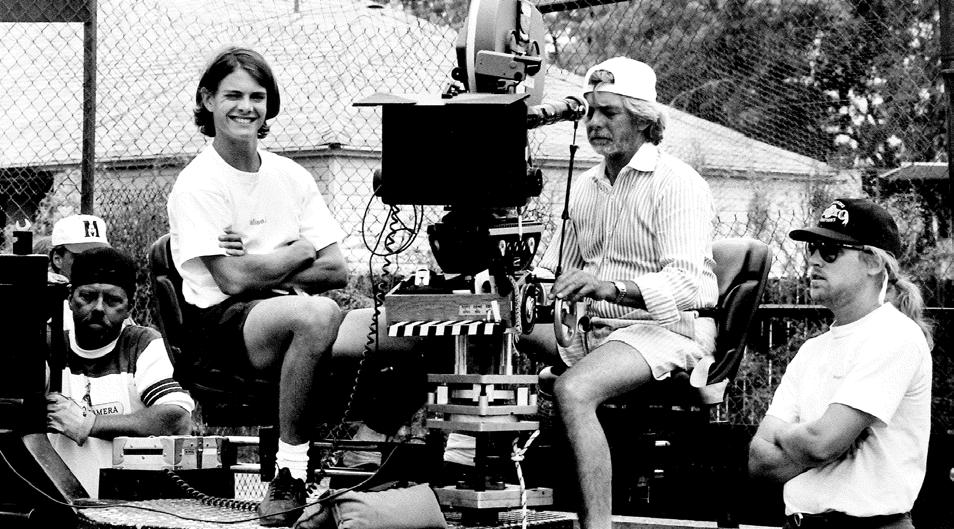
Once someone who felt “slightly dysfunctional” when not at work, Covid has taught Richmond to enjoy his downtime.
“Now, any chance I get, there are certain places around the world that I love to go with my family to chill,” he comments, “my mum’s place in France being one of them.”
CINEMATOGRAPHY WORLD SEPTEMBER/OCTOBER 2023 25 JONATHAN ‘CHUNKY’ RICHMOND •SMOOTH OPERATOR
Camera operating is the best job in the industry… there’s so much involvement and it’s enjoyable
Opposite: Chunky pictured on Children Of Men; Alexander; Vikings; and on the set of Cherry Falls with George and Tony Richmond.
This page: on Jack Reacher – Never Go Back with Tom Cruise; with DP Fraser Taggart & gaffer Martin Smith on MI7; on Men Of Honor, with gaffer Russ Engals, George Richmond operator, Tony Richmond DP and actor Robert De Niro; working on War Horse; Men Of Honor again; and with Tom Cruise on MI7.
SHOWSTOPPERS…
Some of the latest technologies and widgets for DPs and gaffers at IBC2023 in Amsterdam.
By Kirsty Hazlewood
SONY BURANO CAMERA & VERONA CRYSTAL LED
Just before IBC 2023, a small group of cinematographers, technicians and journalists gathered at Pinewood Studios to listen as Sony unveiled an entirely new camera system. Sebastian Leske, head of cinema business development, delivered an introduction to the Sony Burano system and its capabilities in the John Barry Theatre.
Aptly-named after the small island in the Venetian Lagoon, the Sony Burano is a new addition to the CineAlta range and acts as the new, smaller sibling to the Sony Venice 2. The Burano comfortably bridges the gap between the company’s CineAlta and FX ranges, providing the look and operability of a cinema camera whilst enabling high-mobility for small crews and solo operations.
The Burano packs an 8.6K Full Frame, 16:9 Exmor RS sensor. It’s the first time a Sony camera in the Cine Alta line-up features a full frame sensor combined with autofocus. With serious colour capabilities, the Burano utilises internal 16bit XOCN LT and 8K XAVC-H for a variety of shooting situations, as well as sporting 16-stops of dynamic range. Colour reproductions are synced with the Venice 2 for an intuitive postproduction workflow. It supports a variety of frame rate and resolution options, including 8.6K FF 30fps, 6K FF 60fps and 4K Super35 120fps, as well as a Dual Base ISOs of 800 and 3200 for low-light situations.
Notably smaller and lighter than the Venice 2, the Burano is made of a magnesium alloy housing at a very manageable 3kg. This is particularly impressive considering the system is the world’s first to offer inbody optical image stabilisation for PL lenses. Due to an innovative design of the sensor module, the in-body image stabilisation is also featured alongside a variable ND, ranging from ND 0.6 to 2.1. It hasn’t yet been possible to feature both of these capabilities within a single camera system, but the sensor design cleverly allows room for both of these features in the Burano.

The autofocus capabilities are supported by over 70 available E-Mount lenses,
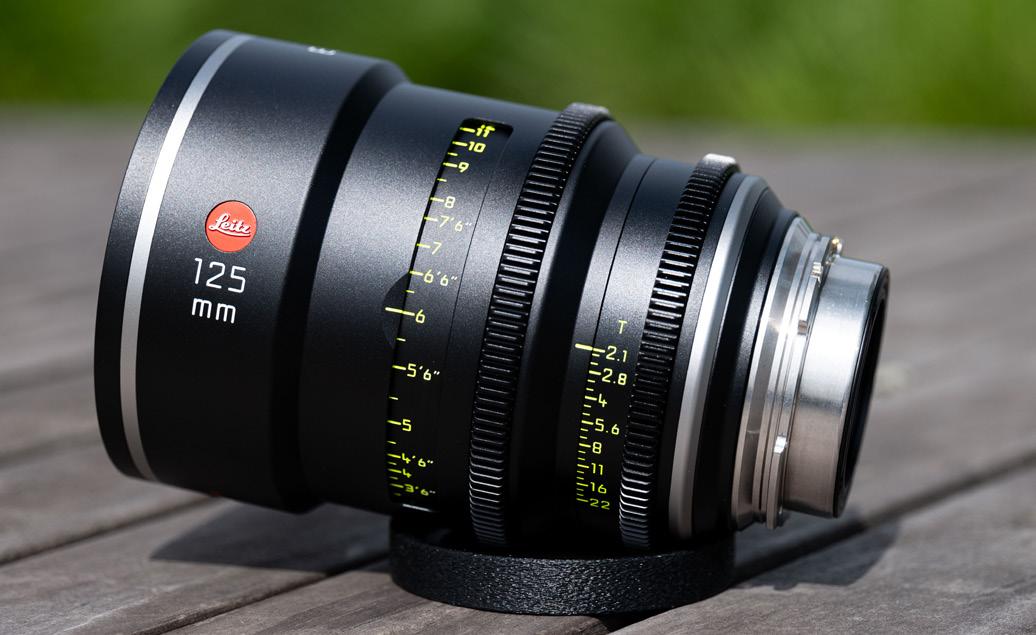
LEITZ SHOWS ELSIE
The Leitz Elsie line of lenses has grown by one, with the addition of a new 125mm focal length now delivering. With this lens the total set of T2.1 full frame prime lenses stands at ten focal lengths: 18, 21, 25, 29, 35, 40, 50, 75, 100, and 125mm. Known for their character-rich interpretation of a traditional Leitz lens, the Elsie series features a gradual fall-off of focus, resolution and illumination toward the edges of the frame, for a gentle centerweighted feel, as well as a more gradual focus fall roll-off throughout the image, that creates the impression of softer edges without any loss in detail or resolution where it counts.
including an eye-tracking autofocus feature. Sony’s XD Linear Motor technology delivers smooth, quiet and accurate autofocus in conjunction with the camera body.
Accessories include a push-andrelease style, modular grip control as well as new CFexpress Type B recording media. This is VPG400-certified (400 MB/s) to guarantee stable writing speed for 8K & X-OCN LT. These cards will come in 1TB and 2TB flavours.
Following the introduction were a series of three visually striking documentaries, shot by filmmakers
This allowed them to take creative risks without worrying about whether the Burano would keep-up.
As explained by the cinematographers, the Burano bridges a gap between the solo operator and larger shooting crews. The new system can easily function as a B or C-camera to the Venice 2, whilst also working brilliantly as a smaller A-camera in its own right.
It will be interesting to see in which kinds of productions the Burano finds it home. The body alone is looking to sell at around the £25K region, with a 12th September release date.
Alongside the Burano, a new crystal LED Series for virtual production was also introduced. Verona incorporates a huge amount of customer feedback on Sony’s previous Crystal LED Series. There will be different versions of Verona for a mixture of production needs, including modular 1.5x and 2.3x pixel pitch options.

Paolo Sodi, Chris Schmid and Thierry Donard. The documentaries were a mixture of wildlife and sports, shooting in the UK, France and Zambia.
Pushing the camera to its limit, Donard attached the Burano to a wing-suit pilot, explaining, “We tried to break the camera, but we couldn’t!”
He adds that it simply wouldn’t have been possible to manually retain focus for the pilot flying over camera, but the auto-focus capabilities make this achievable. All three cinematographers praised the Burano’s usability and trustworthiness in a fast-paced shooting environment.
Designed and manufactured at the Leitz factory in Germany, the Elsie series comes in LPL mount with coverage optimised for but exceeding full frame. The lenses exhibit an excellent close focus capability as well as the smooth skin tones and accurate colour reproduction that Leitz is known for. The lenses are available now.
Notably, Verona features a shorter installation time and is aimed at productions that would be shooting for a couple of weeks at a time. An antireflection coating and overwhelming black level combine features of both the Crystal C-Series and B-Series to create an original surface technology that aids the mixture of real and virtual reality.
It’s an exciting time for Sony with two major technologies on the way, the Burano and Verona are sure to cause interesting waves in the world of cinematography. The new Verona will make its debut at IBC on the Sony booth 13.A10 in Hall 13. (Report by Dylan Bruce)

GREAT GEAR GUIDE•IBC 2023 HIGHLIGHTS 26 SEPTEMBER/OCTOBER 2023 CINEMATOGRAPHY WORLD
MARSHALL PRESENTS NEW MINI CAMERAS
Marshall Electronics has four new NDI HX3 models as well as recent updates to the line. The new Marshall POV cameras, the CV570/CV574 miniature cameras and CV370/CV374 compact cameras, all feature low-latency NDI HX3 streaming as well as standard IP (HEVC) encoding with SRT. The cameras feature H.264/265 and other common streaming codecs along with a simultaneous HDMI output for traditional workflows.
Developed around highly-optimised Sony sensor technology, the CV570/CV574 and CV370/CV375 models achieve impressive results with improved video performance for cleaner, crisper images, greater sensitivity and better colour reproduction. Complementing the new sensors with
high-end processors further refines signal structure and enhances adjust and match capabilities. The CV570 miniature and CV370 compact NDI HX3 cameras both contain a new Sony sensor technology with larger pixels and a square pixel array that Marshall is implementing into all its next generation POV cameras.

The step-up CV574 miniature and CV374 compact NDI HX3 cameras add a new Sony 4K (UHD) sensor to the 570 and 370 profiles. All four cameras provide NDI HX3 and NDI HX2, as well as standard IP with SRT and streaming codecs such as H.264/265. Simultaneous HDMI output is available for local monitoring or low latency transmission.
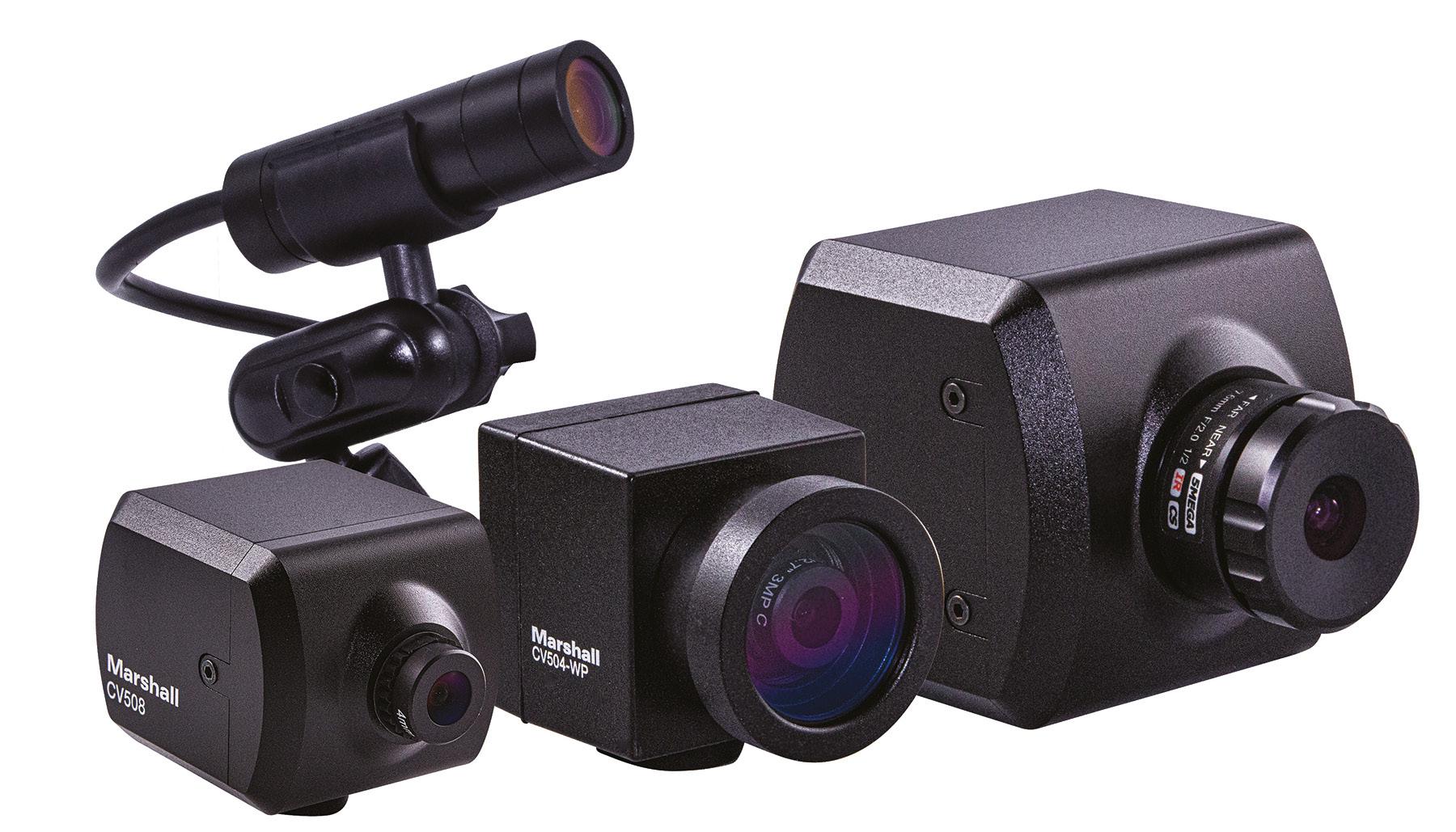
ANGENIEUX’S NEW ZOOM
Angénieux is introducing the new EZ 3 lens for the first time in Europe in collaboration with its long-time partners Band Pro Film & Digital Inc and Jebsen Consumer Products Co Ltd. The third of a series of successful multi-format lenses first introduced at IBC 2016, the new EZ3 lens will increase the possibilities of cinematographers looking for the best value for money to pair with their Full Frame or S35 cameras, thanks to its longer range and specifications.
The new 45-165mm T2.3/T3 (S35) or 68250 T3.5/T4.5 (FF) EZ3 is a Tele-lens addition to the versatile, future proof EZ series. Originally designed for independent filmmakers and productions, Angénieux EZ zooms have enjoyed success with cine rental houses and professional cinematographers too.

Using Angénieux’s IRO (Interchangeable
APUTURE AQUIRES PROLYCHT
Aputure has aquired Prolycht, a strategic union designed to fortify Aputure’s legacy of groundbreaking film and TV lighting technology and heralding a transformative chapter for both companies.
Prolycht, acclaimed for its strides in colour science and software algorithms, will become an integral part of the Aputure family, infusing fresh momentum and innovation into the field of film lighting. Aputure’s pursuit of cutting-edge excellence resonates with Prolycht’s product offerings, bringing in an era of ‘revolutionary’ advances in colour science for the film and television lighting landscape.
With this acquisition, Aputure has assumed stewardship of Prolycht ’s colour science and technical talent as the two companies now embark on a new collaborative journey together.

Ian Xie, founder & CEO of Aputure, says, “The Prolycht acquisition marks a pivotal juncture for Aputure, reaffirming our unwavering commitment
Rear Optics) technology, the EZ series features dedicated rear optical groups customised for both S35 and Full Frame sensors, and provide interchangeable PL, RF, EF & E-mount compatibility on-demand. Their S35/FF modularity and flexibility makes them the preferred lens choice of all levels of filmmaking.
Importantly, the new EZ3 lens includes improvements such as a new quick IRO mechanism (user configurable) and a dual focus scale ring (feet/meters). On the EZ3 lens, the change from S35 to FF is much faster than on EZ1 and 2 and can be done in only five minutes, thanks to an ingenious new design. Same for the focus scale, it is extremely quick to swap from meters to feet and vice versa. Last but not least, the lens is also compatible with the accessories of the EZ series.
to shaping the future of film lighting technology.”
Anqing Liu, founder of Prolycht, adds, “Over the past six years, Prolycht has been a catalyst for innovation in film and television lighting technology.
Aputure has shaped our industry with great products, and always shared our goal of creating value for every filmmaker through innovation. Driven by
’ s technology and spirit will live-on in Aputure’s future products and technologies.”
CINEMATOGRAPHY WORLD SEPTEMBER/OCTOBER 2023 27 IBC 2023 HIGHLIGHTS•GREAT GEAR GUIDE
this common philosophy we are certain Prolycht
ASTERA’S CREATIVE POTENTIAL
Astera is using IBC2023 to not only demonstrate its full range of LED-driven lights and accessories, but to highlight the creative potential these combined solutions have in real-world contexts. The Astera team will talk about the ways in which Astera lights have been deployed in recent productions, including seasons one and two of The Witcher, along with upcoming films Back In Action and Deadpool 3.
Astera lighting products are actively championed by a range of highly-respected
BROMPTON TECHNOLOGY’S LATEST LED PROCESSING
IBC sees Brompton Technology demonstrating an array of LED video processing solutions as well as offering product demos, panel sessions, and technology masterclasses throughout the show.
Focused on driving future innovation, Brompton will showcase its latest TrueLight technology, along with other industry firsts, Frame Remapping and ShutterSync. All of this will be available at the Brompton Technology booth 3.B23, which the company will be sharing with one of UK’s leading suppliers of video technology, White Light.
Propelling transformation across the sector, TrueLight builds upon Brompton’s Dynamic
DEDOLIGHT SHINES WITH THE NEW V-FLECTOR
Dedolight introduces the V-flector, in which the ‘V’ stands for ‘variable’; the surface can now be changed from completely flat to a bent shape and this allows the operator to control the spread angle in terms of width, be it horizontal or vertical.
What is unique about the V-flector, unlike every other reflector on the market, is that it is designed to bend. This has the effect of shaping the light coming from the reflector and on to the subject in a way that can be varied by moving an adjustment handle. Circular or elongated shapes, or anything
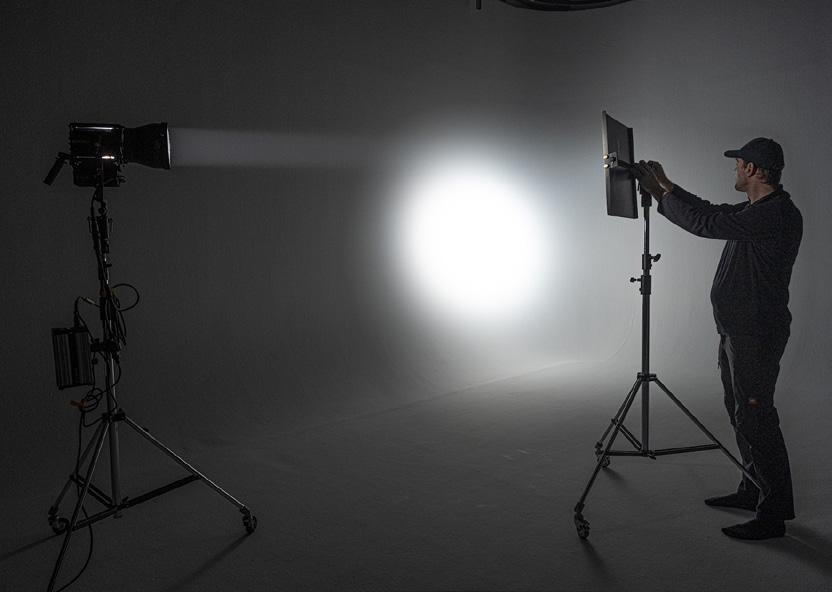
FILMSTICKS ACCESSORIES
Filmsticks designs and manufactures the highest quality, all-weather clapperboard sticks, slates and accessories for the film Industry.

At IBC, Filmsticks is exhibiting its general accessories used by ACs worldwide, including its industry standard Clapper Sticks, ClapperBoard Kits, TPU FCASE Pouches, T-Handle screwdrivers for all camera plates, T-Marker kits for camera and actor/talent marks, hex key kits and cable ties.
NANLITE’S NEW FC SERIES
Nanlite’s FC series lights tap into new potentials for content creators, photographers and filmmakers to unleash their unlimited creativity.

The rated power of FC-300B/500B are 350W and 520W respectively, sufficient power to bring them high output with 37340 lux@1m (FC300B w/reflector, 5600K) and 65640 lux@1m (FC-500B w/reflector, 5600K). A professionalgrade emitter provides a high-quality and even beam spread. The surface of the COB is equipped with glass protection to ensure professional performance.
FC-300B/500B have a wide colour
gaffers and lighting technicians within the TV and film industry such as Wayne Shields, who worked with Astera products in 2023 on the productions listed above.

Speaking in a recent interview, Shields highlighted the fact that with up to 20 hours of built-in battery life – and the possibility to extend this with the addition of an Astera RuntimeExtender – lights such as the Titan Tube offer the possibility of a wire-free lighting set-up, which significantly increases the creative potential of the lights, but – most crucially – frees-up room
Calibration technology to empower panels with extra emitters, such as RGBW, to be fully per-pixel colour-calibrated and ensure colour accuracy is maintained at all times.
Frame Remapping enables multiple cameras to each capture a rendered virtual background with the correct perspective, ultimately unlocking a myriad of in-camera visual effects possibilities to be realised for XR or virtual production. Additionally, when filming an LED screen, it is crucial to precisely match the camera’s shutter speed to the LED screen refresh rate to avoid unsightly artefacts, and Brompton’s ShutterSync feature allows for precise adjustment of the LED refresh rate to synchronise with the camera, just one of many tools for fine-
in-between, can be easily created. Flip the reflector from horizontal to vertical for even more variations. Beautiful graduation on the edges, unusual and useful shapes can be created and manipulated extremely quickly.

The amount of spread created from the reflector can be adjusted by using the handle positioned to the side of the V-flector. This causes the reflector to bend. The result is a modifiable shape which can be set or adjusted to a circle or a much longer strip of light, with many other permutations possible. The V-flector is available in Dedolight Lightstream reflectors No.2 or No.3.
on the set floor in order to maximise the space available to actors.
Shields also highlighted how this wireless functionality –combined with the fact that Astera lights run from a single unified control system – makes on-set workflows quicker, easier and more efficient.
The company is also showing the new concept Hinge Design to allow camera assistants to attach a clapperboard behind their back whilst working on set and keeping their hands free. Designed by Max Graham, this system works with Filmsticks’ medium and small sticks, and has already been used on many production sets.
Filmsticks is also launching the new collaboration between 4130 and Filmsticks, Gripsticks, a new design of patented clapper stick
temperature range of 2700K-6500K, with two output modes built-in. The maximum output mode ensures output of maximum brightness for the chosen colour temperature, releasing the full performance of the light. The constant output mode guarantees consistent brightness across the entire CCT range. Based on various tests including colour rendering, fidelity and saturation, the colour reproduction abilities of FC- 300B/500B have been comprehensively evaluated and optimised.
Coming with the standard Bowens mount, FC300B/500B are fully compatible with Nanlite’s Bowens mount accessory ecosystem. The lights are also equipped with an umbrella hole for mounting
that combines the technical excellence of 4130 ’s engraving and printing knowhow with the Filmsticks concept of Resin sticks.
diffuse umbrella and reflective umbrella for creating richer lighting effects and providing ideal lighting solution for more scenes.
28 SEPTEMBER/OCTOBER 2023 CINEMATOGRAPHY WORLD GREAT GEAR GUIDE•IBC 2023 HIGHLIGHTS
tuning on-camera performance to give users complete creative control.
ROE VISUAL’S IMMERSIVE EXPERIENCE
With an engaging stand in Hall 7, Roe Visual showcases its latest products and technologies, highlighting its significant presence in the broadcast and film market.
“Participating in at IBC is a thrilling opportunity for us to demonstrate our commitment to advancing LED technology in the live broadcast and film industries,” says Olaf Sperwer, responsible for virtual production business development at Roe Visual. “Our stand will be an immersive experience, offering visitors and integration partners an up-close look at our newest products, solutions, and technologies that redefine visual experiences.”
“Our growing engagement with and expertise in the market for broadcast and film is manifested in our current product portfolio,” adds Roelof Bouwman, general manager for Roe Visual EU. Our partnerships with leadingtechnology companies reflect our engagement and focus on getting the most out of the LED technology for our users”.
Roe Visual will also have panel sessions
MRMC TELEPORTATION
The MRMC Broadcast booth (Hall 11.C26) will highlight the latest in Virtual Studios and Virtual Teleportation workflows, alongside PTZ enablement solutions, the latest range of Slidekamera by MRMC products as well as Nikon Z series cameras. At the Motion Control booth (Hall 12.D20), visitors will see the debut of the highly anticipated Cinebot Mini camera robot, where attendees will get a chance to demo the robot for the first time.

MRMC will showcase a range of studio focused robotic technologies, such as the Studiobot XL, AJS-2 (Advanced-Jib System), and TRH-1 (Track Robotic Head), and demonstrate how they interface with virtual production workflows. The IBC stand set design has been crafted to demonstrate how these solutions integrate with virtual graphics systems, specifically illustrating key controls such as mapping positional data and aligning camera perspectives. This will allow attendees to explore the cuttingedge technology that is transforming studio operations across the world.
At stand (11.C26), the LED screen will be powered by i5LED - a provider of direct-view LED display solutions that helps businesses transform creative visions into reality. Their screens offer superior technology like indoor ultra-fine pitch Chip-on-Board (COB) LED displays, fine-pitch outdoor displays, and all-in-one solutions.
In a major step toward pushing the boundaries of technology innovation, MRMC will also demonstrate its Virtual Teleportation workflow solution, which allows for an unprecedented level
featuring industry-leading specialists in XR, VP, and live broadcast, with topics such as: the challenges of XR in live broadcast studio workflows; what we

of camera motion and synchronisation.
MRMC Broadcast will also be showcasing its PTZ enablement solutions, which give movement and creativity to PTZ content capture. Making its debut at IBC2023 on MRMC ’s Motion Control booth (12. D20), the Cinebot Mini is a small, lightweight and versatile camera robot designed to enable operators to take charge of every
expect for the future of media engines and virtual production design.
CINEMATOGRAPHY WORLD SEPTEMBER/OCTOBER 2023 29
shot. Engineered for simplicity, it offers a range of user-friendly, simple and portable features ideal for studio owners, content creators, grips, cinematographers and camera operators.
IBC 2023 HIGHLIGHTS•GREAT GEAR GUIDE
FEEL THE BURN
ARTISTIC DECISIONS ON CINEMATOGRAPHY –TO BE BURNED OR NOT TO BE BURNED? – PART 1
The second edition of Euro Cine Expo took place from 30 June to 1 July 2023 in Munich, and gave the opportunity for several cinematographers, colourists and representative from camera manufacturers to participate in a panel, organised by IMAGO’s Technical Committee (ITC), dedicated to debating and discussing the placement of artistic decisions in the workflow of a production – in-camera or in post? Here, we share the considered thoughts and opinions from the participants about this important subject.
Participants in the Euro Cine Expo 2023 panel:
1. Suny Behar – cinematographer/director (HBO Camera Assessments Series)
2. Loren Simons – Red Digital Cinema, senior motion picture technology advisor
3. Rauno Ronkainen FSC – cinematographer & Professor in cinematography at Aalto University Department Of film | School Of Arts
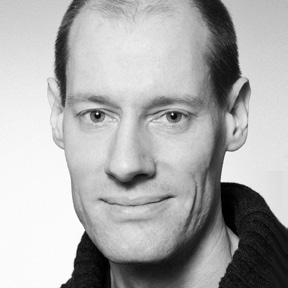
We can see from this diagram that decisions about the aesthetic look-and-feel of a production can be made at several different stages, decisions that can radically affect the image.
During production glass filtering can be used, sharpness and texture can be controlled in-camera. Manufacturers are now offering cinematographers the ability to bake-in a variety of textures, noise or grain in-camera, as they shoot.
However, many cinematographers and some studios/streaming platforms sometimes prefer to defer these decisions to post-production.
What are the advantages and disadvantages of these methods? What does this mean for the audience and the kinetic perception of drama? What semantic politics does this provoke? And, what power do cinematographers have in these decisions, recommendations or guidelines?
Here, eleven of the participants give their opinions on the subject. Part 2 of this roundtable will be held at Camerimage 2023, with the support of Euro Cine Expo and Cinematography World. Don’t miss it!
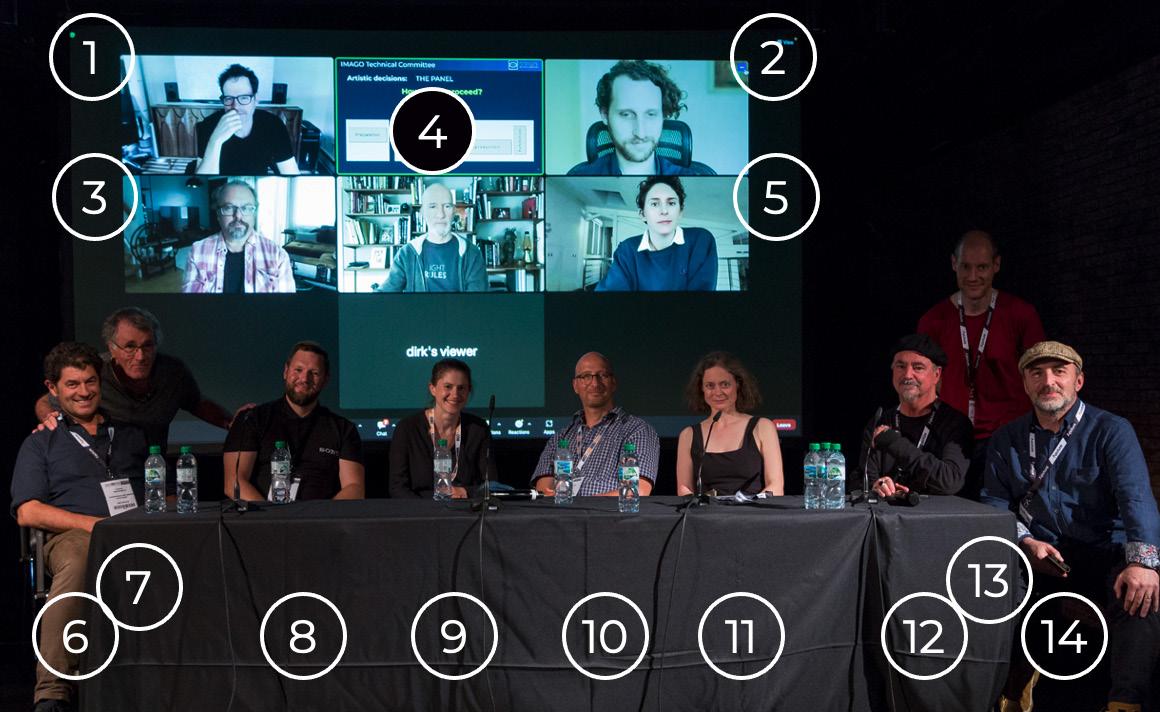
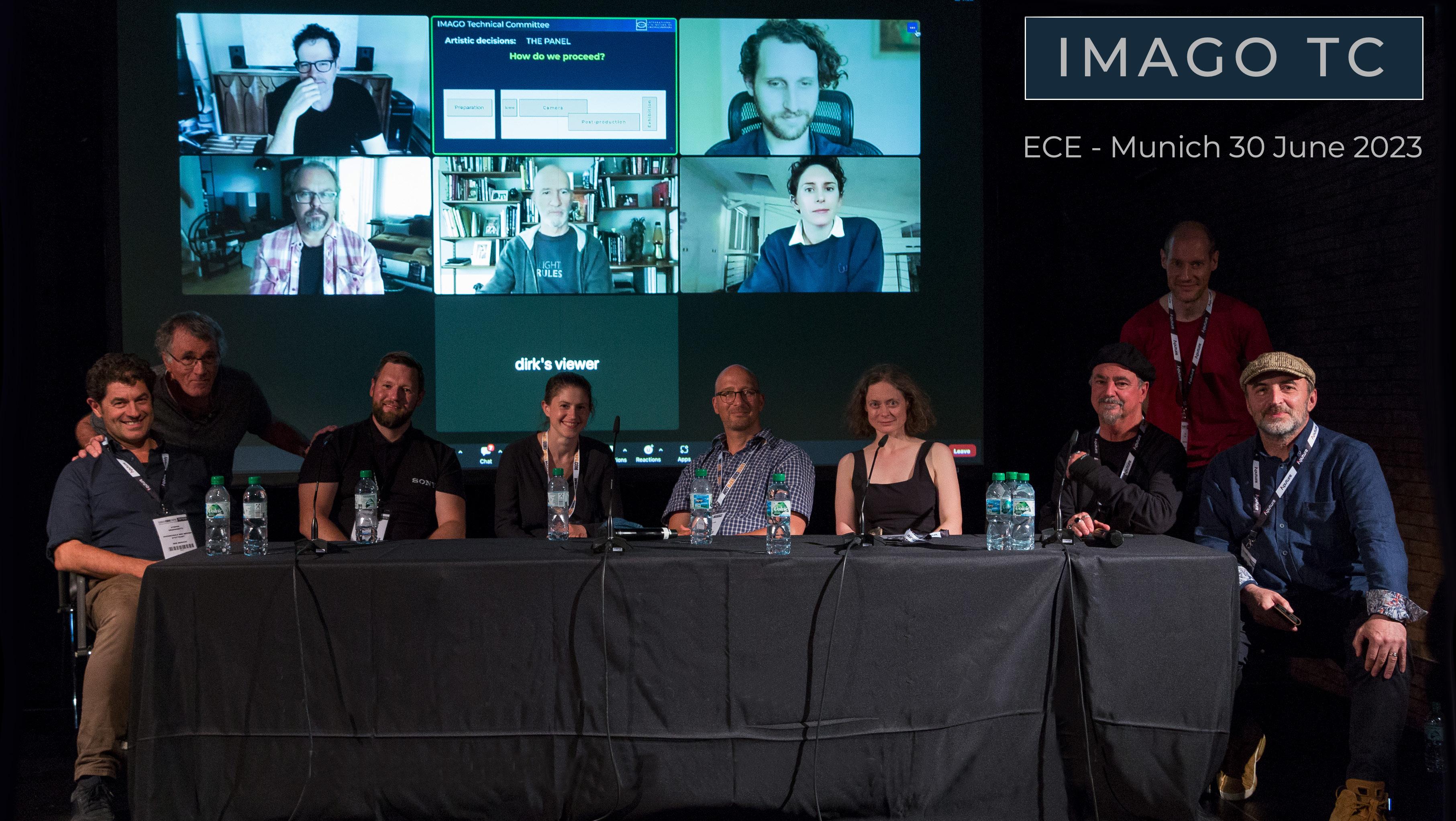
4. Roberto Schaefer AIC
5.
6.
7.
8.
9.
10.

11.
12.
In my field of projects, which encompasses low to normal-budget German and international feature films and documentaries, my observations somehow point in opposite directions.
On the one hand, there is a desire from producers and directors to push all kinds of creative decisions further down the pipeline; meaning to shoot more, to cover more angles, to shoot at higher resolution for re-framing in post, and to capture wider dynamic range to preserve all possibilities during grading.
On the other hand, I see a constant movement to start look development earlier in the production process, involving me as colourist in preproduction, conducting elaborate hair and makeup and lens look-tests, in order to come up with a meaningful show-LUT or look. This is something I very much welcome.
But, in my opinion, most cinematographers first need to improve their knowledge of what a look is
GREAT DEBATE•IMAGO TECHNICAL COMMITTEE PANEL DISCUSSION
ASC –cinematographer & ITC full member
Ari Wegner ACS ASC – cinematographer
Stefan Grandinetti BVK – cinematographer & Professor in cinematography
Philippe Ros AFC & ITC co-chair –cinematographer
Daniel Listh – Sony, content acquisition solutions specialist
Dr Tamara Seybold – ARRI, technical lead image science & ITC corporate member
Marc Shipman-Mueller – ARRI, senior product manager camera systems
Pascale Marin AFC – cinematographer
David Stump ASC MITC & ITC co-chair –cinematographer
13. Dirk Meier BVK CSI – senior colourist & ITC full member
14. Aleksej Berkovic RGC & ITC co-chair –cinematographer
Dirk Meier BVK CSI ITC full member Colourist, Germany
30 SEPTEMBER/OCTOBER 2023 CINEMATOGRAPHY WORLD Prep Exhibition Scene Lighting, Breakdown, Place of camera, Make-up, etc. Types of lenses / Glass Filtering Spherical / Anamorphic Aspect ratio Resolution Type of recording files: RAW / Codec Gamma curves
control
Control: De- and re-grain /-noise
process
control (RGB)
Tone or “Gamma curves” “Film” emulation
resizing Detail control (sharpness) Texture tools control De- and re-grain /-noise Distortion /Warping Stabilisation Lens Camera Post Production Artistic decisions on cinematography Where and how do we proceed?
Sharpness
Texture
Demosaicking
Sharpness
Grading
Re-lighting Reframing,
made of. DP Steve Yedlin ASC calls these ‘image attributes’. I have had only a very few first-time meetings with cinematographers where I felt I’ve been able to talk on eye-level regarding these image attributes and how to achieve a specific look for the film. Ultimately, to decide what to burn into your images and when, you should really know what makes-up that specific look you’re aiming for.
Roberto Schaefer – AIC ASC ITC full member Cinematographer, USA

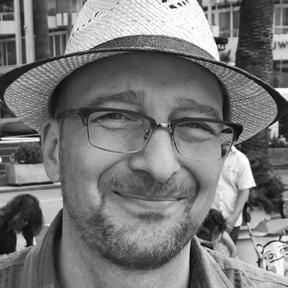
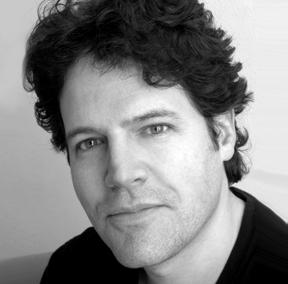
The idea of ‘baking-in’ looks that alter the RAW files is a contentious subject. Some post-production people complain that it’s destructive to the image file. That might be technically correct since it does alter the file structure.
But, as a cinematographer, I contend that it is actually constructive, as it helps to construct the image the way that we intend for the final look, even if it isn’t completely the image that we’ll finalise in a DI colour session, if we can attend. Many things can prevent the cinematographer from being at the DI – work, distance and no cooperation from the producers.
The ARRI 35 textures baked into the OCN files are good for us in order to have control over our final images. If the looks were purely in metadata, then there would be no guarantee they would be applied in post. It’s like using lens filtration. It is baked into the file and can only be removed or altered wilfully using advanced AI post tools.
The counter argument that I understand is when there are new output formats that need the material converted and our alterations might not work properly with the new conversions. In that case I would advocate twin files to be stored –one with the baked-in textures and other changes, another with only metadata for the adjustments. These could be saved for the eventual futureproofing of programmes when entirely new formats are developed.
Dr Tamara Seybold – ARRI
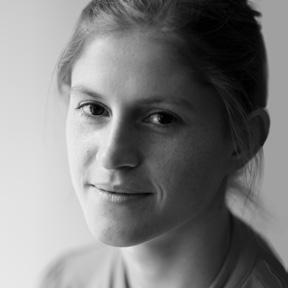 Technical lead image science, ITC corporate member
Marc Shipman-Mueller –ARRI
Senior product manager camera systems Germany
Technical lead image science, ITC corporate member
Marc Shipman-Mueller –ARRI
Senior product manager camera systems Germany
ARRI digital cameras have a set of values that determine the way the camera processes images at their very core. These values, comprising different and carefully-balanced parameters, shape the amount and the character of grain in the image and determine the amount of contrast at different levels of detail in the image, which defines the perceived sharpness.
In the ARRI Alexa 35 these settings are now accessible and tune the image to your needs. We call them ARRI Textures.
Up until now, ARRI cameras have been preprogrammed with a single, unchangeable texture setting that is optimised for the widest possible range of shooting scenarios. For the first time ever, the Alexa 35 gives cinematographers the option to go beyond the default texture setting and choose from an evolving menu of ARRI Textures, each designed for specific image attributes.
ARRI Textures are applied to the image before the EI sensitivity setting and before the ARRI Reveal colour science. Both determine the basic behaviour of grain and contrast in your image.
This unique feature allows cinematographers to fundamentally alter the way in which the camera records images. It is a major step forward in giving filmmakers creative control over the parameters of digital cinematography.
Rauno Ronkainen FSC Cinematographer & Professor in cinematography at Aalto University Department Of Film/ School Of Arts, Finland Photograph fot.fotografowie.com
SEEKING THE LOOK TO MEET THE CONTENT
The look is part of the visualisation of a story – an important part – and it can’t be isolated from the rest of the visual elements, since only together do they create a coherent way to expose the author’s personal approach to tell the story.
These elements – camera movements, angles, optical choices, subjective / objective camera, grading – create the final look and are connected to the bigger plan that is supposed to boost and create content with a distinct and personal style that aims to appear both fascinating and individual for the audience.
During the whole process, from preproduction to post, creative members need to lock significant numbers of decisions, not only to help to frame their work but also to inspire them.
The structure of the image – lens choices, lighting, filter choices, etc. – are of key importance to help find inspiration and a personal signature for the visual world of the film.
These decisions may appear as risky choices, but, in general, the nature of all creative work is based on balance between research, practical work and intuition – connections that can be considered as risky – or as a process to create a unique vision of an artist.
Personally, I must confess that I have a little bit of a hard time regarding the subject of burning-in the look, since I don’t use any LUTs and want to keep things open until the end, when I see the final edit and even during the colour-grading process. But, on the other hand I want to use filters and analogue technology to create less digital-looking images. My way of working can be whatever depending on the need of the film and content.
David Stump ASC MITC ITC co-chair Cinematographer, USA
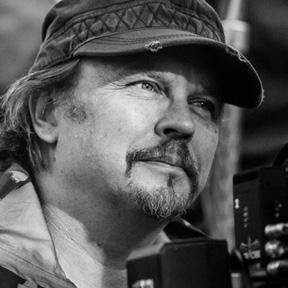
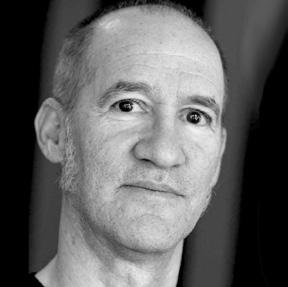
ELECTRONIC TEXTURE CONTROL
Texture control is not a new phenomenon in cinematography. Cinematographers have long exercised texture control over their images. We have used soft or hard light to emphasise the textures of sets, objects and actors. Make-up artists assist the cinematographer in manipulating the texture of actors faces. Camera filters (both in front of the lens and behind it) are routinely employed to change the contrast and texture of scenes. Film stocks, processing and post-production manipulations are also routinely used to change the texture of the finished image.
Electronic ‘in-camera’ texture control in digital imaging is a relatively new parameter for cinematographers. Until recently texture control as an electronic in-camera artistic manipulation was only available to cinematographers as a post-production option. Now, some camera manufacturers are giving cinematographers the possibility to control texture as an in-camera function.
The community of cinematographers are realising that this new capability has value when working in a scenario where budget concerns do not allow for manipulation in post-production, but at the same time these controls must be handled carefully and skilfully. Much like camera filters, electronic texture controls in the hands of uneducated or inexperienced users can be dangerous, these in-camera manipulations cannot be undone.
It is my opinion that cameras featuring these tools should probably use a menu structure that sequesters such potentially dangerous functions behind a ‘user-level’ gateway. Cinematographers should only be able access these functions after de facto agreeing that they possess the skill and training to use them by moving through this user level wall. In addition, I firmly believe that these functions should include a prominent ‘reset to default’ option that is always clearly available, adjacent to the texture control settings.
Suny Behar Cinematographer/Director (HBO Camera Assessments Series), USA
It would never come to mind to question whether we should allow painters to select the size and aspect ratio of their canvasses, or whether sculptors should have to surrender the remainder of the clay that went unused in the creation of a statue should the buyer not be happy with the finished product, and yet, these questions seem to plague cinematographers of all levels.
This topic is profound and complex. So how about a simple adage to get things going?
It is my belief that any artistic decision that is not hobbled by a visual constraint (that is either technical or monetary) at the time of conception, should be allowed to be narrowly defined into the creation of the art.
If you are shooting in B&W because colour film does not exist yet, is this choice really artistic? Or are you confined by a technical limitation? (It could be either in that case).
If you are shooting in B&W in 2023, you are choosing to exchange the entire world of wide colour gamuts for a dedicated focus on grey scale tonalities. ‘Preserving’ such images in colour isn’t about future-proofing’ but rather ‘taste-proofing’.
CINEMATOGRAPHY WORLD SEPTEMBER/OCTOBER 2023 31 IMAGO TECHNICAL COMMITTEE PANEL DISCUSSION•GREAT DEBATE
Cinematographic decisions are more political than they appear
Artistic and technical choices cannot be made on-set at the last minute
Ari Wegner ACS ASC Cinematographer, Australia
Personally, I’m excited by the recent developments from manufacturers who are moving beyond a one-size-fits-all default sensor to a sensor which allows us to customise performance based on the specific challenges each shot brings.
For example, when the challenge is capturing all the details of a wide landscape shot, having the sensor prioritise fine detail. When the challenge is low-light levels, having the sensor prioritise the cleanest shadows.
Yes, by altering how the sensor captures the image we are essentially ‘burning-in’ those choices, but I’m comfortable committing to choices, especially when it means gaining access to the full range of a sensor’s capabilities.
Pascale Marin AFC / Collectif Femmes à La Caméra (Women With A Movie Camera Collective)

Cinematographer, France
Cinematographic decisions are more political than they appear, and they depend heavily on the content of the project.
First of all, it’s important to establish who is the decision-maker at the end of the chain: is it the director, the producer or the broadcaster?

Secondly, the digital artistic decisions we’re talking about, which can be ‘burned-in’ or not, are only part of the decisions that make up an image. Choosing to put a diffusion filter in front of the lens, shooting in spherical or Anamorphic, choosing a camera position and movement are also cinematographic decisions, and they are ‘burned-in’.
It’s also crucial to be aware that certain artistic choices can also have both economic and technical repercussions on other aspects of production.

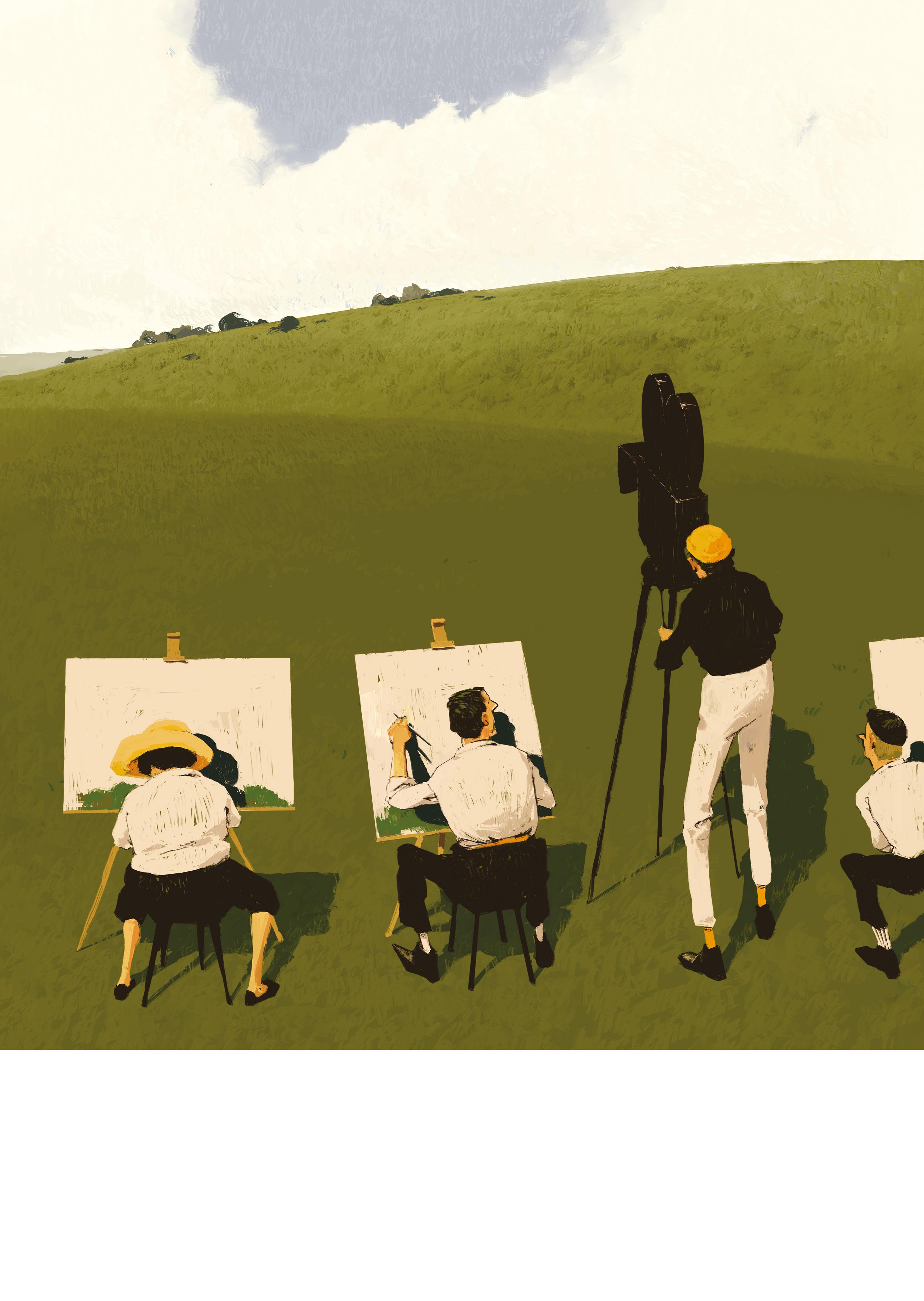

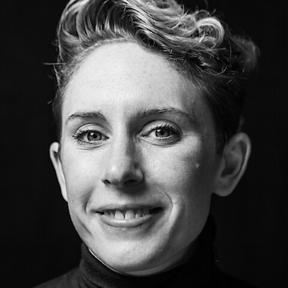
Personally, I work mainly on independent films with relatively tight budgets, so the director is usually the one who has the final say on artistic decisions. But how inflexible are they? How well do they measure the repercussions of their choices or changes of mind?
It’s up to me to find out. It’s up to me to help them see their ideas through to the end, or even further, but not to prevent them from going backwards if that’s part of their creative process. And all this within a given time and budget, and without jeopardising the work of other departments. So, above all, it’s a question of communication, sincere and enlightened.
Philippe Ros AFC, ITC Co-chair Cinematographer, France

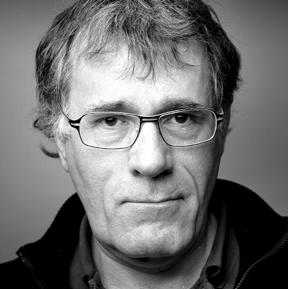
Having worked since the early days of digital on sharpening, colour matrix and the creation of contrast curves, I’ve always thought that baking-in information in-camera was a demanding but exciting process.
Demanding because it is essential to clarify these artistic/technical decisions with the production team and the director. Demanding because it requires preparation: these choices cannot be made on-set at the last minute.
Exciting because the cinematographer must train their eye and work out these subtleties in a colour-grading suite with the director, the colourist and the DIT.
We live in an age of more: more information, more data, more choices, and more decisions that can be delayed until postproduction. Unfortunately, the vast majority of productions have very little time for colourgrading and finishing and, for filmmakers and cinematographers, in-camera choices may be the only solution.
Digital cameras are becoming increasingly sophisticated and the challenge, I believe, is to open new creative doors not only in the workflow but also specifically in the camera. Personally, I see the latter as a sign of greater artistic maturity. It’s also the acceptance of limits in a more interesting creative process.
Aleksej Berkovic RGC ITC Co-chair Cinematographer, Germany
There are many examples in the world of cinematography when creative decisions regarding the style of the image were made contrary to the standards. Evidence can be found in the biographies of many great cinematographers.
The decision-making process on the set is part of the lifeblood of collective creativity. The precision and accuracy of pre-production on the set are met with unpredictable factors that require real-time adjustments. This living process generates the energy of participation, which shapes the final result.
The possibility for error in the visual narrative style formation cannot be excluded either theoretically or practically. However, limiting the possibility of free choice of a cinematographer does not create an increase in ‘insurance’ against mistakes, but only significantly reduces the level of creative accuracy and harmony of the result.
The birth of a significant and talented film is still a mystery. Technology offers more and more possibilities, which does not mean that cinematography is automatically becoming better and more talented.
The core remains in the creatively-inspired choice of the cinematographer, who is part of the creative team, shaping the final result. The development of LUT files, the possibility of their correction even on-set, provides an increase in the conscious involvement of all members of the team. Why then should we violate the logic of development and implement restrictions where those are clearly not needed?
The cinematographer must have the technical ability to style the look and, in many cases, must be sure that the chosen style will be the basis of the final visual presentation.
Special thanks from the ITC
We extend our wholehearted thanks to Ronnie Prince and Alan Lowne of Cinematography World who, in 2022, introduced the ITC to Claire and Rob Saunders, the directors of Euro Cine Expo, and kindly offered us a panel session at the inaugural event. In 2023, Claire and Rob offered the ITC six slots at the show. The ITC is truly grateful to these four people for supporting our committee.
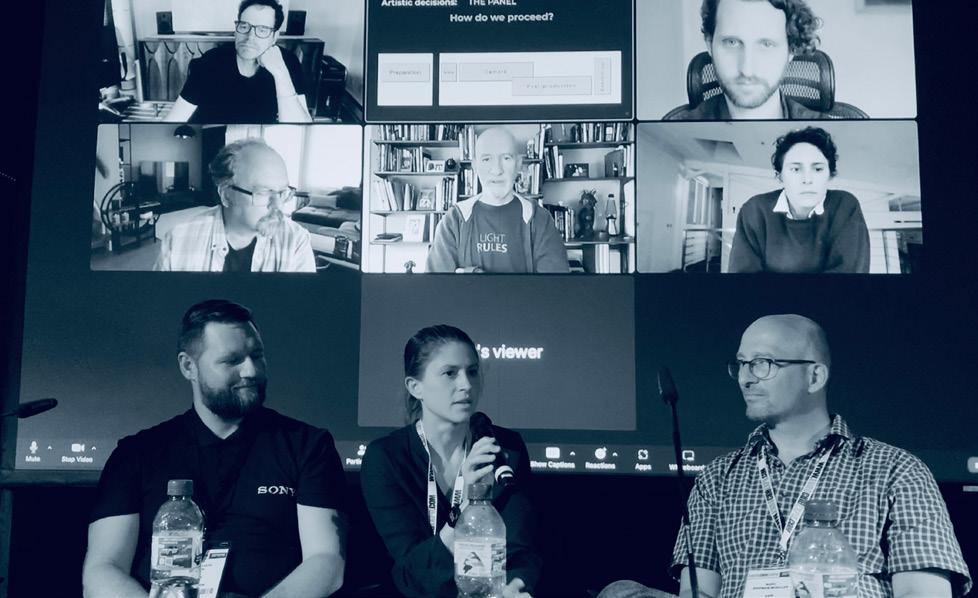
You should know the ‘image attributes’ that make-up the look you’re aiming for
All creative work is based on the balance between research, practical work and intuition
GREAT DEBATE•
32 SEPTEMBER/OCTOBER 2023 CINEMATOGRAPHY WORLD
Electronic ‘in-camera’ texture controls must be handled carefully and skilfully
IMAGO TECHNICAL COMMITTEE PANEL DISCUSSION




KID’S-EYE-VIEW
By Natasha Block Hicks
Scrapper (2023), the winner of a 2023 Sundance Grand Jury Prize in World Cinema – Dramatic, is the debut feature for both its Bafta-nominated writer/director Charlotte Regan, and two-time Camerimage Golden Frog-nominated cinematographer Molly Manning Walker.

It follows 12-year-old Georgie (newcomer Lola Campbell) as she navigates a solo existence on the Limes Farm Estate in Chigwell, Essex, following the death of her single-parent mum. Georgie, along with her best friend Ali (Alin Uzun) use their resourcefulness and charm to sidestep the attentions of authority figures, tout themselves as wheeler-dealers and find amusing ways to while away the hours. Their groove is rattled when Georgie’s absentee father Jason (Harris Dickinson, 2022 Bafta – EE Rising Star Award nominee) turns-up expecting to parent her.
“It’s a child’s perspective on grief, and an examination of the roles of family and community in raising kids,” observes Manning Walker, speaking to me on a brief pause in the worldwide tour of her own writer/director debut feature How To Have Sex (2023, DP Nicolas Canniccioni), which won the Un Certain Regard award at the 2023 Cannes Film Festival. She and Regan, who had previously crossed paths in music videos and commercials, passed a year of Sundays walking Regan’s dog around the park to get to know each other before Manning Walker interviewed officially for the role of cinematographer on Scrapper
Anyone anticipating the usual ‘estate grime’ filmic cocktail – desaturated palette, close-quarters handheld camera, with a hard knocks script – is going to be reminded that class-based grittiness in film is a formula we have become conditioned to expect. Scrapper, by contrast, is popping with bright colours, imbued with playfulness and humour, and is gentle enough in its dialogue and themes to be rated by the BBFC as suitable for an audience contemporary to the adolescents it depicts.
When building the mood and look of Scrapper, Regan and Manning Walker referenced films such as The Florida Project (2017, dir. Sean Baker, DP Alexis Zabe ASC AMC), a film that – despite a backdrop of deprivation – has childish wonder at its heart.
“We wanted to make Scrapper from a kid’s perspective,” relates Manning Walker, “to show how they view the world. So, we chopped adults’ heads off, had the camera at their eye level and let them dictate what they wanted us to see.”
Aside from a little Steadicam, the camera was largely locked-off, with the characters moving around – and sometimes in-and-out of – the frame. Manning Walker had to resist her filmmaker’s natural urge to adjust the camera.
“I’m usually drawn to an emotional handheld approach,” she reveals, “so it was a real rebellion against what I knew, which was fun to explore. Now, I’m really intrigued by static frames where people walk in and out of them. It’s not my instinct still, but I think there’ll definitely be a future point in my life where I’ll enjoy that kind of filmmaking.”
Aside from three studio days focussing on one of the fantasy sequences, the film was mainly shot on location at Limes Farm.
“It’s tricky shooting in really small spaces,” says Manning Walker of the ground floor flat chosen as Georgie’s home. “Our approach was to try and keep as much lighting outside of the flat as possible, because we wanted to give the kids free-rein to move around.”
Astera wireless LEDs were Manning Walker’s main choice for powered sources of illumination, but she also made regular use of Light Bridge Cine Reflectors, with large units positioned externally to bounce light into the rooms and smaller reflectors rigged inside to control it. The lighting kit was supplied by Pilot Lighting through gaffer Bill Rae Smith. The bright August sunshine tracing an arc over the flat’s garden added an extra challenge.
“I specifically requested not to have a south-facing garden, because the light changes all
SCRAPPER•MOLLY
MANNING WALKER
34 SEPTEMBER/OCTOBER 2023 CINEMATOGRAPHY WORLD
This was a pretty magical first project for me
All images courtesy of Picturehouse Entertainment.
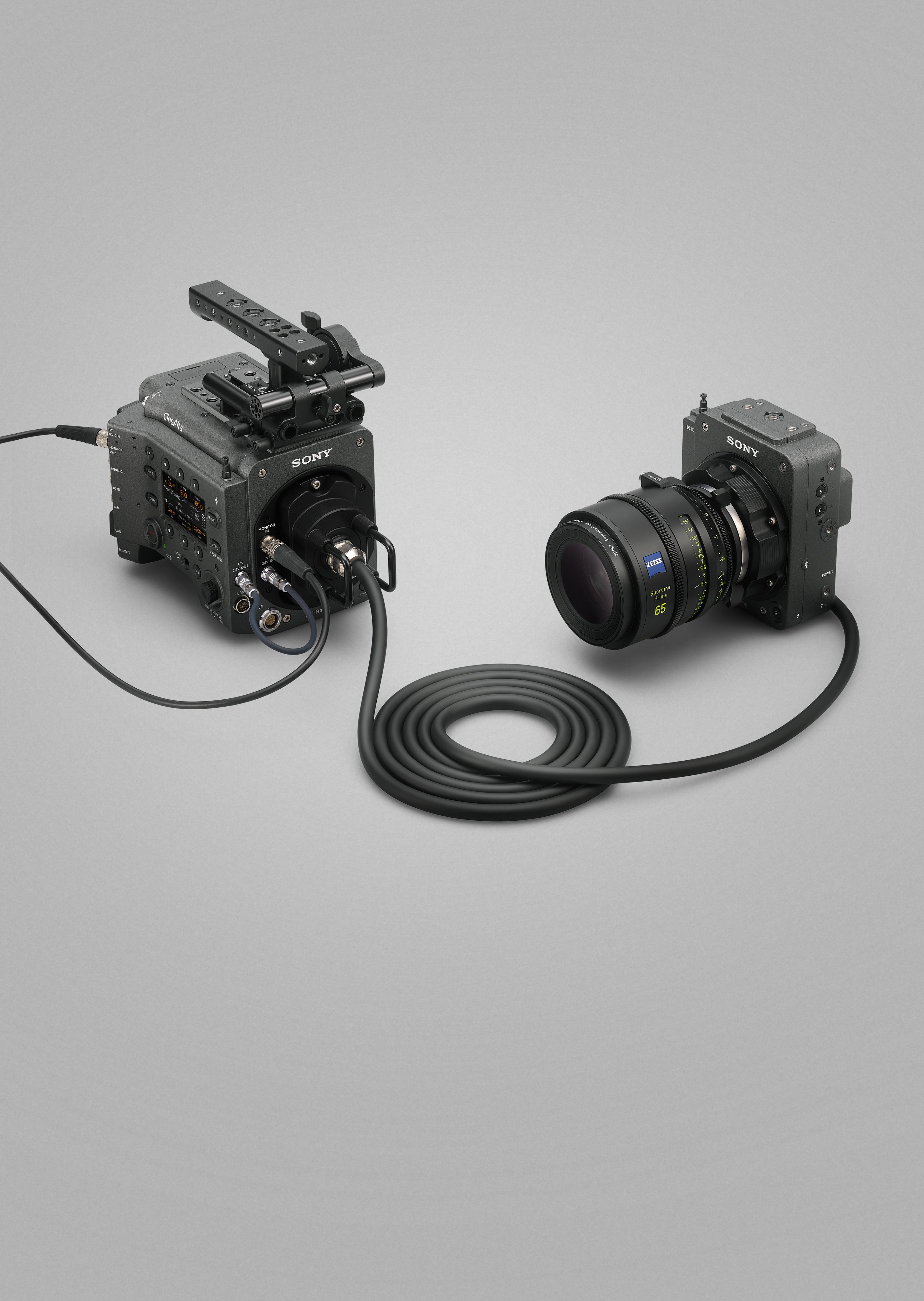

Sony VENICE 2 And Extension System 2 Available Now VENICE 2 offers a choice between 8K and 6K full-frame sensors, each offering exceptional picture quality with incredibly wide latitude and gamut. Thanks to new internal recording capabilities, users can capture even more colours and detail within the compact body they already know. Learn more cvp.com/sony Book a demo demo@cvp.com Get in touch +44 (0) 208 380 7400
day, but through circumstance that’s exactly what we ended-up with,” says Manning Walker with a laugh. “But, it was fine in the end, I just had to work harder to control the sunlight.”
Manning Walker turned to the ARRI Alexa Mini – supplied by One Stop Films – as a “reliable workhorse” camera that was also diminutive enough to squeeze into small corners.
“It’s got a good dynamic range and I always know what I’m doing with it,” she relays. By contrast the choice of lens was untrodden territory for the DP.
“We wanted to break away from the typical estate film by shooting in Anamorphic, to make it feel heightened,” she reveals “that was a new adventure for me.”
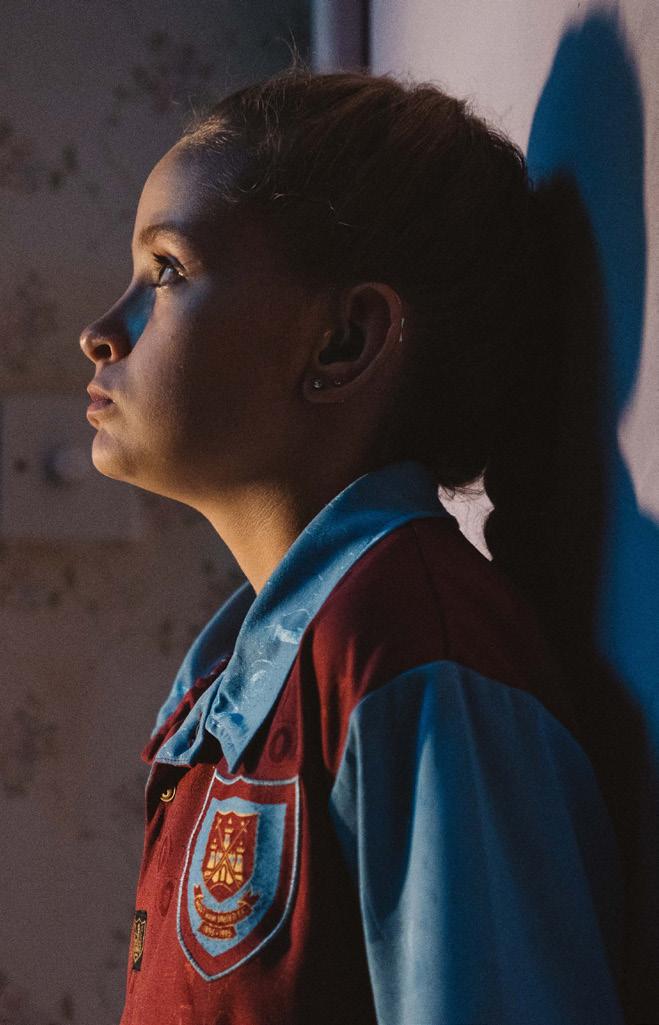
The after-effects of Covid on kit availability, combined with budgeting, lead Regan and Manning Walker to Meru Anamorphics – also supplied by One Stop Films – which proved to be a positive experience.

“It was going outside of what I knew, but they had this filmic softness to them that I really loved,” she illustrates.
Certain sequences in Scrapper mix-up the mood and pace set by the static frame/Anamorphic combination, such as snippets of documentary-style soundbites – shot in 4:3 format with spherical Ultra Prime lenses – and the film’s opening credits, which roll over a lively sequence of crash telephoto zooms picking out kids ranging all over the estate.
“The 4:3 was meant to feel like the ‘behindthe-scenes’ of the kids’ brains,” reveals Manning Walker, “and when we used zooms, it was to highlight them quickly scanning and trying to find the information in the situation.”
Of the title sequence Manning Walker comments, “We designed that technique during the testing process and I really love it now, it’s become
part of my library. I always imagined my first feature would be handheld, but hopefully my style will be forever changing for each project.”
According to the Limes Farm Community Group, the large estate is a “reliable and sociable community”, and a level of curiosity was sparked by the presence of the filmmakers who were there for five weeks. Regan even enlisted some of the locals to be extras in the film.

“They were really intrigued by what we were doing and excited that, rather than a bleak story, we were telling a sweet whole-community story,” she says, “which just shows how that angle has been neglected in the past.”
Working with adolescent lead actors meant that shooting time with Campbell and Azun was limited to six hours per day. The crew would spend the remainder of the time hunting-out cut-aways around the estate, and working with Dickinson.
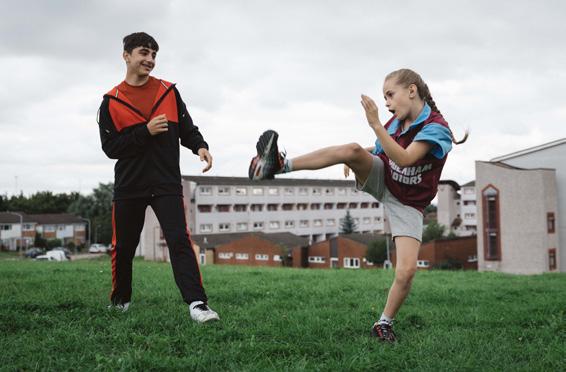
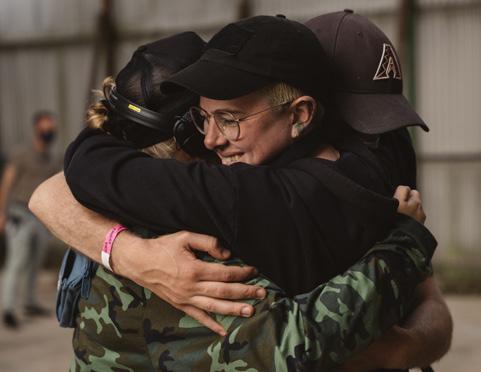

“It was pretty intense when we had the kids, but we tried hard not to pass any of that stress on to them,” says Manning Walker. “We wanted to create an atmosphere that was super-playful. Harris is a total gem of an actor and he made it so easy for us to work with Lola and Alin. Plus Charlotte and I always say we are big children ourselves, which helped.”
Getting to know Lola Campbell was a personal highlight for Manning Walker. “She’s a crazy kid, full of life and energy and was always coming out with these bonkers one-liners. Working with her was so special.”
For Manning Walker, the magic really happens when Campbell’s high energy drops away as she depicts Georgie’s private poignant moments remembering her mum, through a ritual of rearranging sofa cushions and alone with a mobile phone video in an alley.
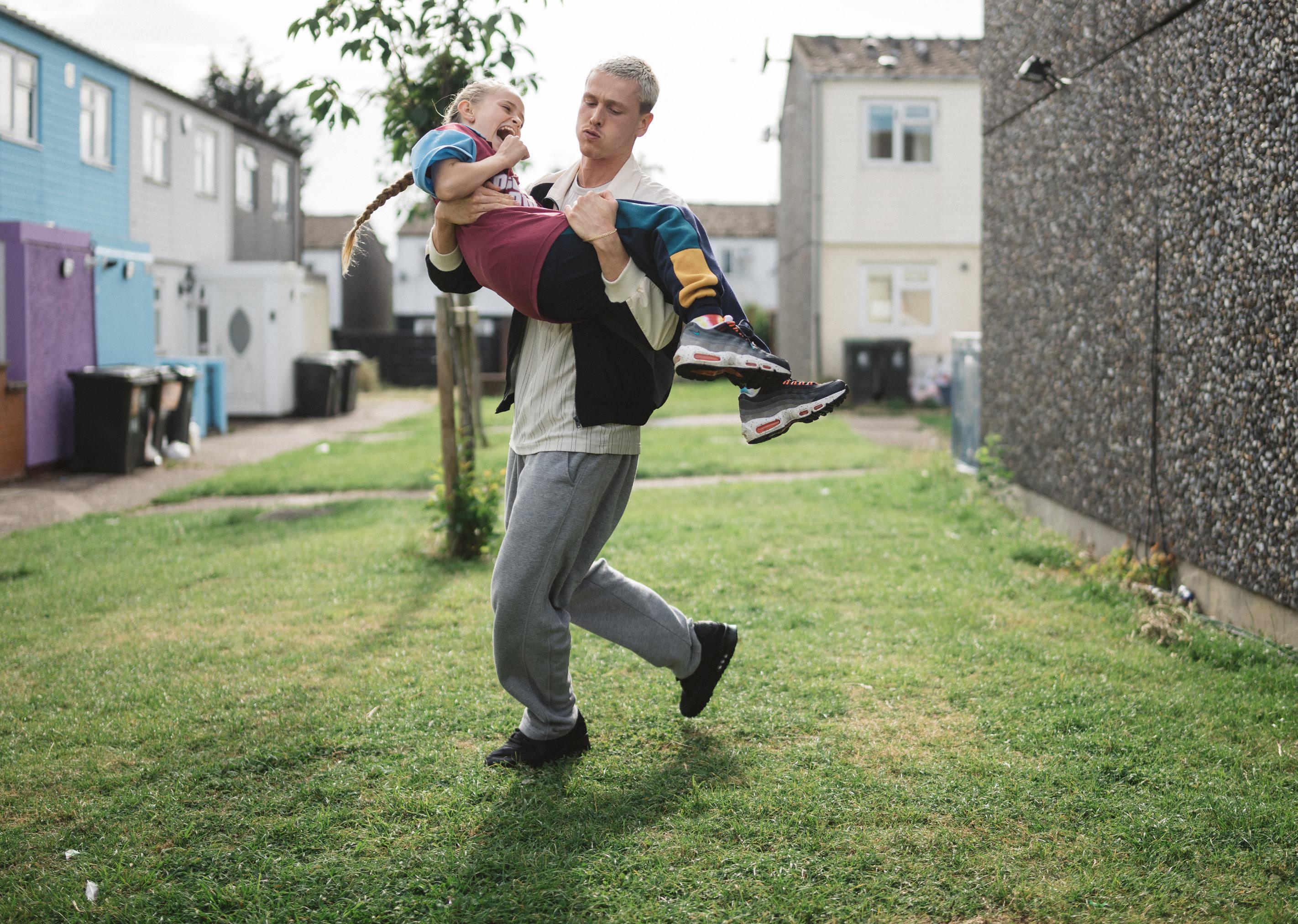
“I really love those scenes,” she says. “They are so simple, but they’re really effective.”
The colour grade was handled by Simone Grattarola at Time-Based Arts with both Manning Walker and Regan sitting-in for the duration.
“We’ve both done commercials with Simone before,” shares Manning Walker. “Simone is at the top of his game, and a lovely human being, which always makes a difference when you’re spending ten days with someone.”
Reflecting on her experience as a whole Manning Walker says, “This was a pretty magical first project for me. Charlotte’s a fearless leader who inspired us all to try and do our best work. She created this atmosphere where it was very open, where everyone was welcomed and felt part of the team, which made for a really collaborative environment. When the crew want to be there and are excited by the script, you can feel that passion and drive on-screen.”
There was much to be taken away for her own projects.
“I don’t think I could have made How To Have Sex without having shot Scrapper first,” Manning Walker considers. “The experience of tracking a story through a long shoot and the stamina involved with that; I learned so much from Charlotte in terms of her process and her energy.”
36 SEPTEMBER/OCTOBER 2023 CINEMATOGRAPHY WORLD
SCRAPPER•MOLLY MANNING WALKER
I’m really intrigued by static frames where people walk in and out of them
The most detailed lens coverage and camera comparison tool on the web.





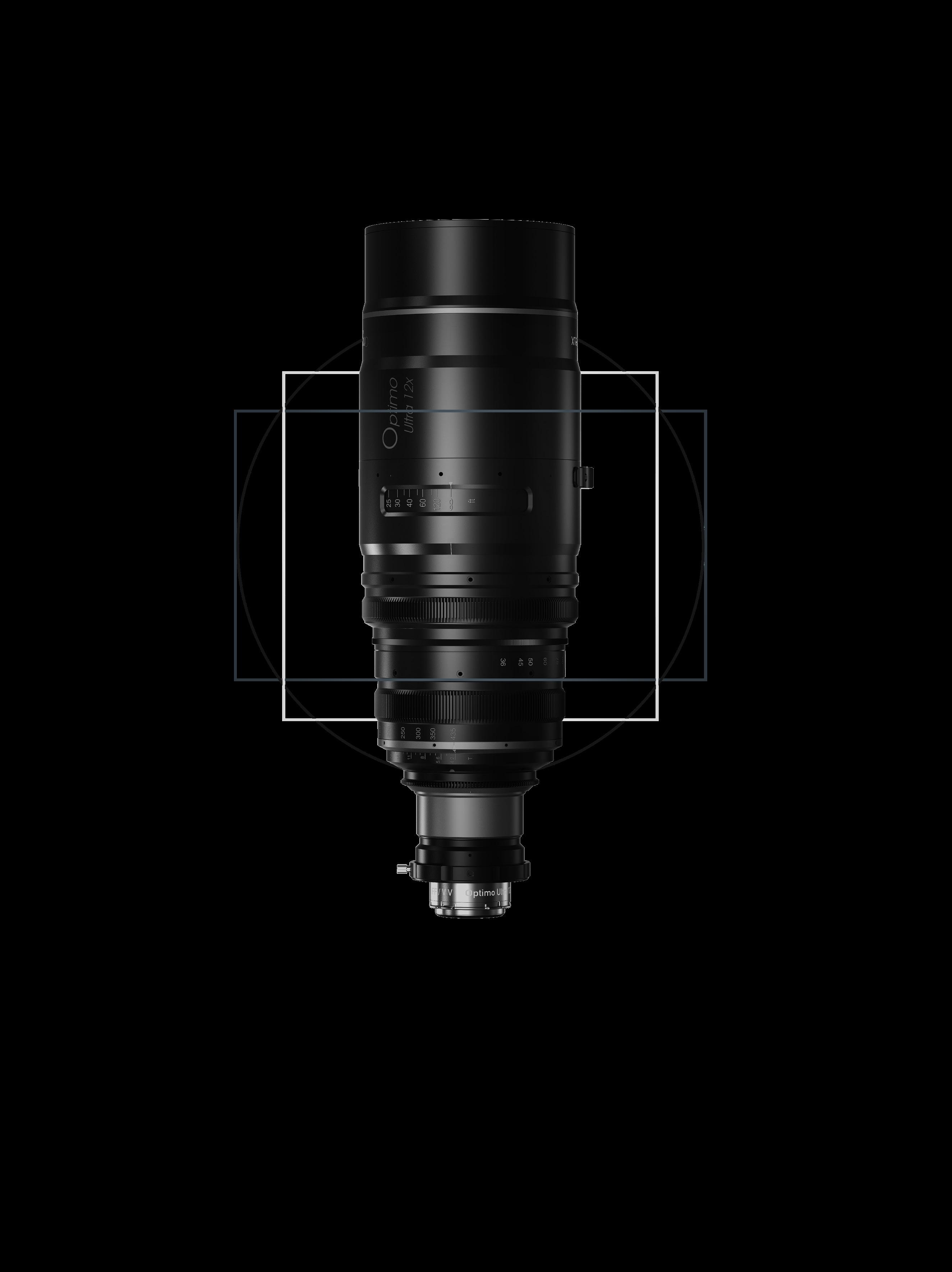
cvp.com/cameralens












AND MANY MORE
DATES WITH DESTINY
By Ron Prince
Shooting on Kodak 35mm film, Antiguan DP Shabier Kirchner created an air of radiant romance for Celine Song’s debut feature, Past Lives, a story about long-lost childhood sweethearts reconnecting as adults.
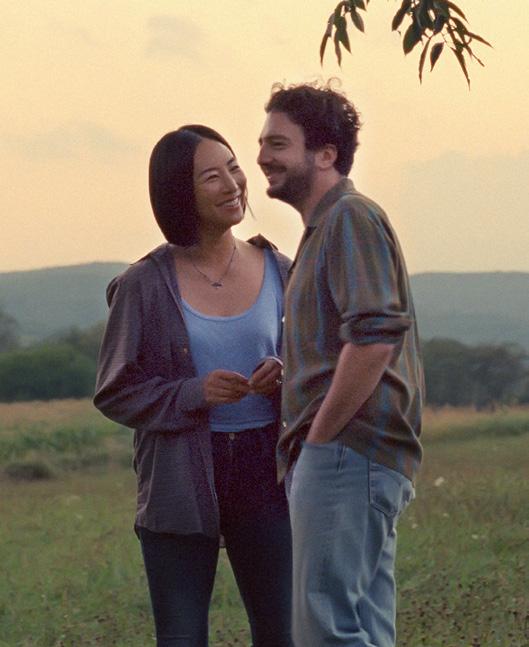

The film opens in a bar, where Hae Sung (Teo Yoo), Nora (Greta Lee) and Arthur (John Magaro) are observed by an unseen couple who try to guess the relationships between them. It then rewinds 24 years, to Seoul, South Korea, where Hae Sung, a gentle boy, and Na Young, an adventuresome girl, are 12-year-old classmates. They develop an attraction for one another, but Na Young’s family immigrate to Toronto, whereupon she changes her name to Nora, and the youngsters lose contact.


Twelve years later, Hae Sung has finished his national military service, whilst Nora has moved to New York. Thanks to Facebook and Skype, they manage to reconnect and hold lengthy, long-distance conversations that reveal deep-seated connections, but practical disconnections – Hae Sung is moving to China for a language exchange and Nora is about to attend a writer’s retreat. Nora tells Hae Sung she wants to focus on her writing and her life in New York, and their connection fizzles to an abrupt halt.
At the writer’s retreat, Nora meets Arthur, and tells him about the Korean concept of in-yuon – how two people are connected by a thread over the course of their lives, and that if you meet someone, however briefly, it means you met in a past life, and that lovers are people who have met many times over.
Twelve years later, Nora, now a playwright, Arthur an author, are married and living in New York. Hae Sung and Nora reconnect by social media and Zoom, and physically reunite when he decides to visit her. Will
they rekindle their young love, or is Nora simply a girl from his memory?
Past Lives was released at the 2023 Sundance Film Festival with critics praising Song’s sensitivelydrawn debut about love and observations on the human condition, along with Kirchner’s captivating cinematography. Kirchner, now a New York resident, won a BAFTA for director Steve McQueen’s five-part anthology series Small Axe (2020).
prep time with Celine where we really broke the story down, scene-by-scene, shot-by-shot, and time was also important for us to create our own short hand in communicating.
“The script was imbued with ideas that were effortless to connect with – the relentless nature of time, place, in-yuon, identity, love, loss and destiny. All things that presented an exciting challenge to bring to life visually.
“I’m a firm believer that sound and music can convey an emotion way quicker than a photograph. So, before we discussed visual references, we spoke about different scenes in terms of sounds and the emotions they evoke.
“Celine shared a playlist she had made which created a kind of sonic map – of classic Korean love songs, orchestral pieces, and melodic tunes – that helped give me a really clear emotional handle on the film, and how the audience was supposed to feel through the ebbs and flows in the story. When that was clear, we went through the script, with Grace Yun, the production designer, watched a host of different films and started talking about the visual language of the movie.”
“When I first read Celine’s story, I saw so many similarities in what was happening in my own life and felt the script was masterful at pulling on the echoes in people’s lives in general. It resonated with me in a profound way. I was in a shambles after reading it and knew immediately this was my next project.”
Song is a South Korean-Canadian theatre director and playwright, based in the US. Coming from this different artform, and this being her film debut, Kirchner says, “The visual language of a film is rarely obvious to me after the first read of a script and this was no different. But, I was fortunate enough to have a long-enough
Kirchner reveals that Like Father, Like Son (2013, dir. Hirokazu Koreeda, DP Mikiya Takimoto) proved an important and inspirational reference, as did Yi Yi (2000, dir. Edward Yang, DP Yang Wei-han), for their respective treatments of love and the economy of their cinematographic styles.
“Some of the ideas behind creating the visual vocabulary of Past Lives were grounded in expressing the characters internal life through their external surroundings, using the repetition of architecture, camera movement, composition and ever-changing light to give a sense of the inertia of time.”
Regarding the decision to shoot Past Lives on 35mm film, Kirchner says Song expressed her desire to make a
PAST LIVES•SHABIER KIRCHNER
38 SEPTEMBER/OCTOBER 2023 CINEMATOGRAPHY WORLD
Kodak 500T 5219 is probably my favourite filmstock – the results look so rich and beautiful
film about the passage of time that felt timeless in itself.
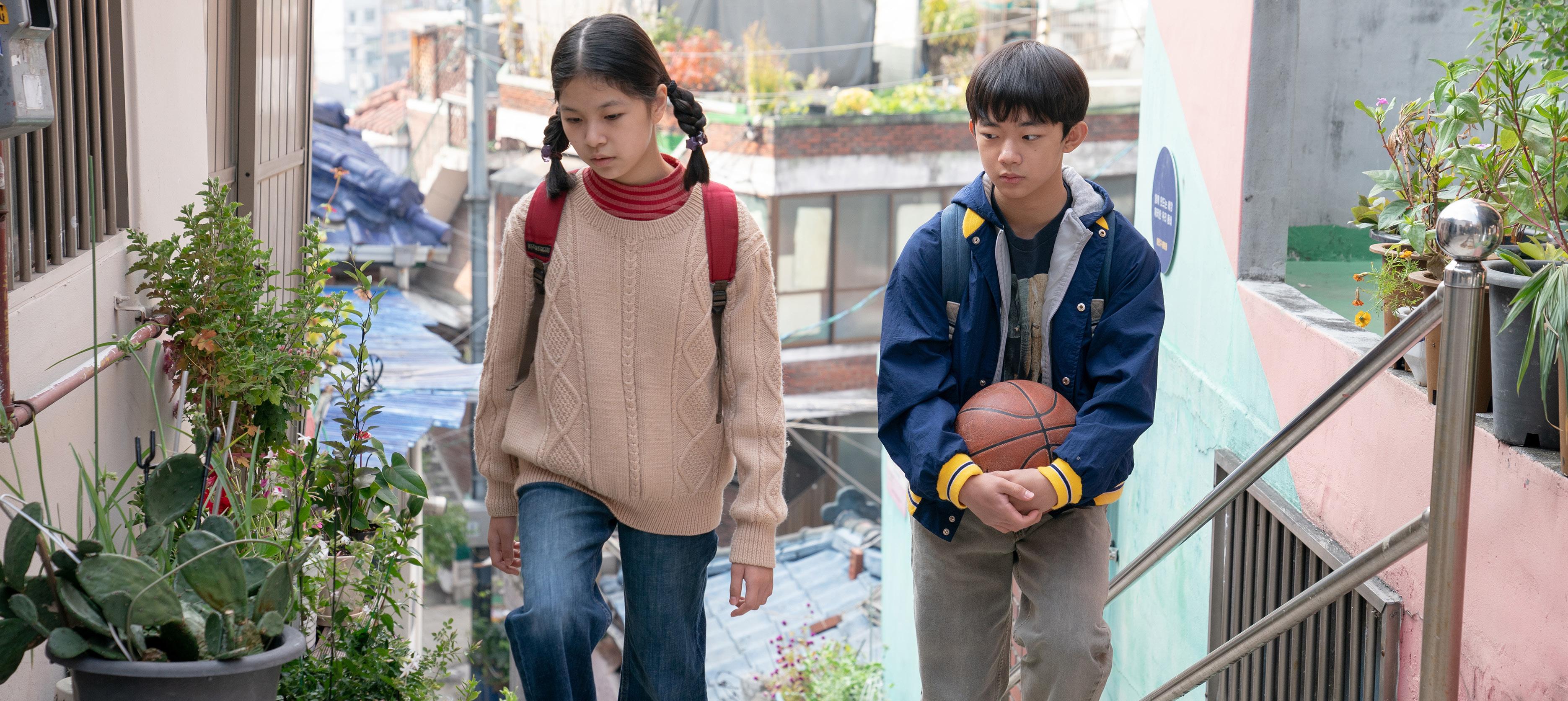
“There’s something infinite about film and the way you can use it to capture the passing of time,” Kirchner remarks. “I shot some tests, and Celine immediately fell in love with the look of film, to the extent that she went out to bat for it amongst the producers. She said she would approach the production using her considerable theatre experience – to rehearse, rehearse and rehearse with the actors, and to capture the action in as few takes as possible. It required a little leap faith from the producers to allow a first-time filmmaker to shoot on 35mm film, but she pulled it off.
“True to her word, Celine spent a lot of time with the actors making sure they understood what they needed to achieve. When we shot, she knew after the second or third take whether she had what she wanted, and we maintained a similarly low shooting ratio from start-to-end.”

Production on Past Lives took place during July and August 2021, at locations around New York, including the city’s ferries, and under and along the landmark Manhattan Bridge. The apartment sets for Hae Sung and Nora’s Skype/Zoom conversations were built adjacent to one another at Greenpoint Studios, Brooklyn, and filmed simultaneously. The production then moved to Seoul, South Korea, and filmed from late October to early November.
Kirchner went with a Panavision Millennium XL 35mm 3-perf camera, plus a variety of Panavision optics for the shoot – Ultra Speeds, that were introduced in the mid-70s, P-Vintage lenses that incorporate vintage glass from the Ultra Speeds, and Primos, which are designed to intercut seamlessly with a variety of other lenses. He also included de-tuned 11:1 and 24-70mm Primo Zooms into the mix. Panavision New York supplied shooting package.
“The Millennium XLs have plenty of cinema history, and I especially like them as you are able to top-load the mag when you are shooting in tight spaces and corners, as I knew we would be,” remarks Kirchner.
“My lens choices really came from conversations that Celine and I had about camera movement, or the considerable lack of movement, as many scenes play out
SHABIER KIRCHNER•PAST LIVES
with a static camera or imperceptible moves. She was incredibly discerning during these discussions as to how different focal lengths on close-ups, mid-shots and wides could accentuate a moment.
“With that in mind, the lenses that looked best doing those sort of soft manoeuvres were the 32mm, 40mm and 65mm lengths. Between the three types of lenses, some looked better on faces and close-ups, others were sharper for wides. We used the zooms for a few very slow move-ins, like the car work on Hae Sung as a child in Seoul and as an adult in New York.”
“I push-processed most scenes by one stop, to increase grain and contrast in the image, and deepen the sensation of the colour. However, I sometimes pullprocessed by two stops, such as the scene when Nora and Arthur are in bed discussing her relationship with Hae Sung. Essentially, I did a lot of different manipulations as knew I could trust the 500T to deliver different looks.”
Film processing was done at Kodak Film Lab New York, with dailies and 4K scans provided by Technicolor Postworks. The final grade was done by Tom Poole at Company3.
During production, Doug Durant was the camera operator, with 1st AC Kali Riley pulling focus, Chris Keenan working as key grip, and Andrew Hubbard as the gaffer.

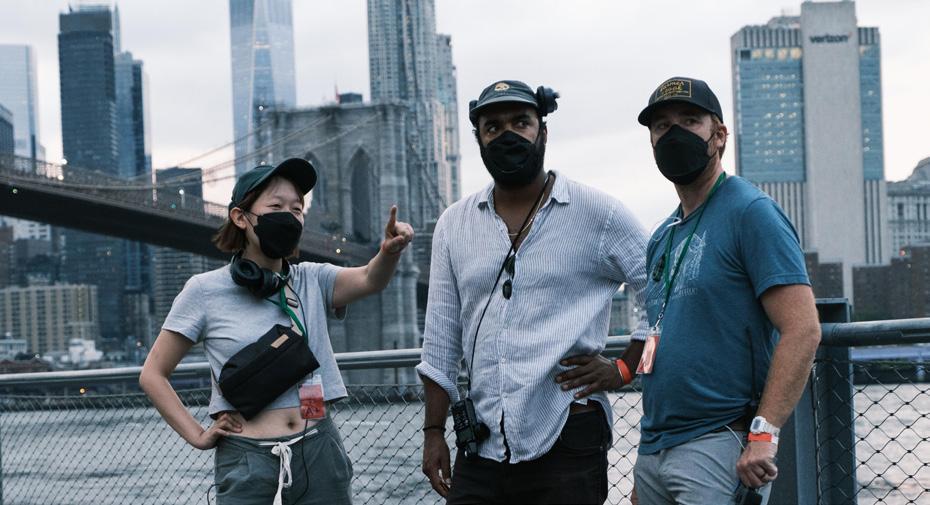
“Our lighting strategy was to keep things as natural as possible, which isn’t always the easiest because natural light changes all the time and we wanted to recreate that in controlled environments.” Kirchner says.
Kirchner went with Kodak Vision3 500T 5219 for the entire production. He had previously used 500T for three of the five films he shot for Steve McQueen’s Small Axe (2020) – Mangrove and Red White And Blue used 35mm 5219 – in order to keep a familiarity of texture and look throughout each. The same applied to Past Lives
“The 500T 5219 is probably my favourite filmstock,” he says. “It has the versatility to handle a wide variety of day/night, interior/exterior lighting conditions – from sunny or overcast exteriors, to brightly-lit or dark interiors with mixed colour temperatures – and the results look so rich and beautiful, which Celine loved. Also, Kodak emulsion has a broad range for capturing skin tones, with subtle hues.
“When possible, we lit rooms from the outside using a mix of old arc lights, HMIs and LEDs and used lots of Tungsten fixtures on the interiors – ARRI Fresnels and Mole-Richardson 650W Tweenies that we bounced into unbleached muslin and diffused. Tungsten delivers such a nice light on faces and skin, and adds depth.”
Reminiscing about the film, Kirchner remarks, “It was amazing, probably one of the best stories I’ve ever worked on, and that was reflected behind the camera. Every person, whether it be a department head or someone in catering, had read the script and found some kind of connection and commonality to it. Along with Celine and the actors, we were unified in bringing a great story to the screen. It was a really magical for us all to share that experience, and I think that shows in the end-result.”
CINEMATOGRAPHY WORLD SEPTEMBER/OCTOBER 2023 39
Celine created a sonic map which helped give me a really clear emotional handle on the film
Images: Past Lives, directed by Celine Song. Images from Jon Pack/Twenty Years Rights/ A24 Films. © Twenty Years Rights LLC.
SHIFTING SANDS
By Michael Burns
Director Joe Connor’s music promo for Ellie Goulding’s ‘Like A Saviour’ sets the singer in a dreamlike desert landscape of rolling sand dunes, and saw DP David Procter BSC take another step in pushing the boundaries of cinematic virtual production (VP) using an LED volume.
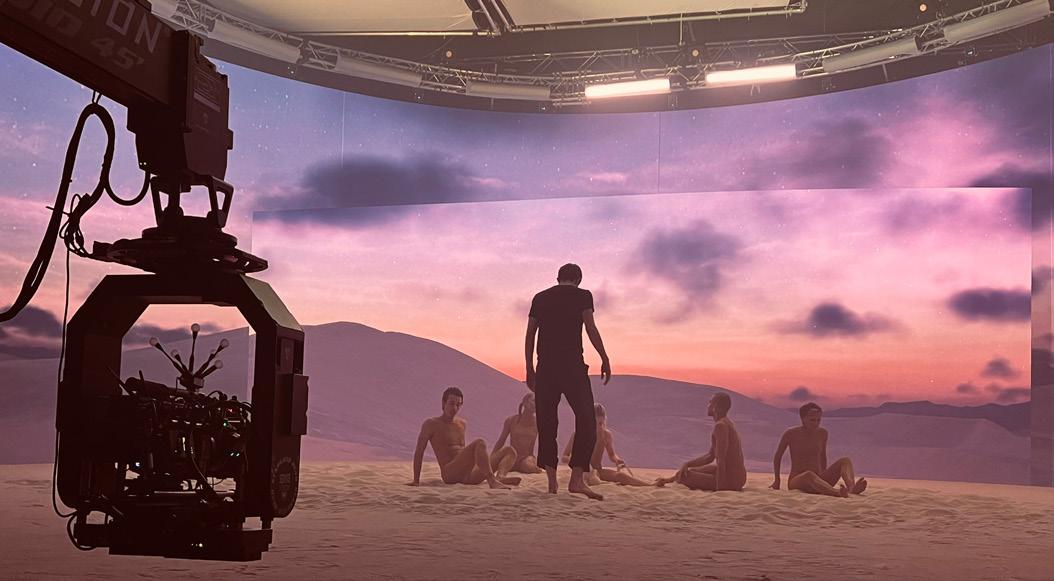

“We’ve seen virtual production used widely for logistical reasons: the expense of travel, sustainability, scheduling, and also for creative control in terms of fantasy landscapes and lighting continuity,” says Procter. “However, Joe’s visionary concept hinged on creating a landscape where the passage of time, light, weather, and the horizon, could and would all be manipulated.”
The cinematographer, an alumnus of the Berlinale Talent Campus, whose longform credits include Bypass (2014), the Netflix series The Innocents (2018) and Disney+’s Black Beauty (2020), has been shooting commercials with Connor for several years, and both “have aligned sensibilities, which always makes for rewarding collaborations,” according to Procter.
Producer Fred Bonham Carter, at production company Just Fred, pulled together what Procter describes as, “A passionate and dedicated team, all keen to prove what VP could achieve within the constraints of short form. The aim was to create a grounded aesthetic that felt tactile and organic, somewhat paradoxical to the surreal concept. The allure was a creative approach that not only played to the strengths of VP but explored novel innovation, made possible solely by the exploitation of new technology.
“Joe and I felt that much of what has been achieved with virtual production has a certain look to
it – high contrast, glossy and sometimes betrayed by an artificial cleanliness. We wanted to lean into heat, flare, under-exposure and halation, imperfections that one can subliminally overcorrect when shooting in a controlled environment.”
A further desire to avoid the polished tropes of pop promos led to a softer pastel aesthetic. Connor also wanted a naturalistic opening, drawing an audience into the ‘real’ location, before bending the rules of physics. The promo was shot at RD Studios in West London, with DNEG and Dimension Studio providing the LED volume and virtual production services.
“We wanted bold, graphic compositions, juxtaposed with looser handheld scenes to fluidly capture the dancers,” says Procter. “The DNEG and Dimension team created a 5km-square desert landscape in Unreal Engine, complete with a live AI weather system and cloud rendering. We designed a sun path that allowed us to ramp-up the passage of time with a 24-hour cycle lasting just two minutes. The goal was a hybrid timelapse of light movement, with clouds that moved naturally rather than with the usual frenetic motion. This was a fascinating concept in itself, a surreal twist on reality made possible only by VP technology.”
Having had previous VP experience, Procter admits he was apprehensive about the ambition of the piece, given the time constraints of a promo schedule.
“The size of our 3D landscape, plus the constant AI weather rendering, demanded unprecedented processing power which was undoubtedly our most
profound challenge,” he says. “Joe wanted to push the technology to its absolute limit, and we danced with the devil.”
Procter’s prep was done remotely while shooting on other projects in Geneva and Istanbul, looking at crude pre-visualised images and designing a lighting plan.
“The creative challenge was to light our set in a way that felt naturally motivated, yet to maintain the ability to shift our ambience and sun angle to match our timelapse aesthetic – from dawn to dusk and into
the night,” says Procter. “There is a misconception that the screens light the set for you in virtual production, but this is rarely the case. Aside from CRI issues of the panels themselves, authentic integration of foreground and environment is a delicate balancing act reliant on skilled collaboration.”
The virtual set was comprised from an array of ROE Visual BP2.8mm V2 LED Panels in a 48-foot diameter arc with a height of 20-feet, as well as two
ELLIE GOULDING’S ‘LIKE A SAVIOUR’•DAVID PROCTER BSC
40 SEPTEMBER/OCTOBER 2023 CINEMATOGRAPHY WORLD
The authentic integration of foreground and environment is a delicate balancing act that is reliant on skilled collaboration
13x16-foot wild walls.
“Sand is the nemesis of all things digital,” says Procter, “So production designer Oliver Hogan devised a circular deck safely that was set back from the screens and raised to avoid seeing the gap between real-world and 3D. Checking this in a 3D pre-vis was invaluable. The sand colour was carefully deliberated, and to help with integration we opted for some foreground contouring that could be easily added or removed.”
No ceiling panels were used; instead, the team opted to rig Ultra-Bounce fabric above the volume to act as a passive sky. “We supplemented this with Robe Forte and Clay Paky Unico moving heads bounced from the ground that could move and animate, enhancing the complexity of light, as if rendered by an organic sky,” says Procter.
The DP chose to shoot on Alexa Mini LF, with a set of Caldwell Chameleon SC Anamorphics. “These 1.8x Anamorphics marry the character of a vintage lens with the performance of modern glass,” he explains. “Although they are S35 lenses on paper, they do cover the LF sensor and lead to increased character around the edges of the frame.
“Large format Anamorphic is a great choice for virtual production work as it’s easier to achieve focal separation from subject to the volume itself, helping with integration, and avoiding problems with moiré,” he adds. “Our camera package was supplied by Panavision and the lighting was supplied by PixiPixel and Nanlux who generously supported the project.
“We chose Nanlux Evoke 1200B units as a backlight,” he adds. “We ran these without lenses as this gave the broadest spread of light across our set, with a 120° beam angle and dimming in 0.1% increments, and kelvin control from 2700k up to 6500k. When required, a Nanlux Dyno1200C rigged into an additional 20x12 Ultra-Bounce acted
as a frontal key. An additional Evoke 1200B was used with an Octodome where a more localised beauty-light was required or to act as a catchlight in wide shots.
“We lined the circumference of the volume with Chroma Q Colour Force LED batons which helped wrap around our directional light,” he continues.
“All lamps were controlled via DMX through a desk in the hands of our operator/programmer Frankie Shields. As Joe wanted flexibility in our environment, sun path, time-of-day and transition length, we didn’t pre-programme frame-accurate lighting sequences. Instead, we pre-programmed 12 lighting states and transitioned ‘live’ between them, including dimming, colour shift and light direction.”
According to Procter pre-lighting with a camera is essential for virtual production.
“I’m accustomed to pre-lighting with a light meter, but with VP, it’s fundamentally down to how the camera sees, which can differ from human perception,” he says. “As we were pushing the live Unreal Engine rendering to its limits, the use of light cards on the volume itself wasn’t viable. Together with
long-term collaborator, gaffer Sol Saihati, we devised a lighting plan that gave us the versatility we required.”
“We paired our desk operator Frankie with postvis supervisor Jesse Baber who was able to feed through cues, just seconds ahead of our shifts. While, with more time, the entire lighting design could have been pixel-mapped, this more organic approach allowed for human error and happy accidents, which is often when magic happens in filmmaking.”
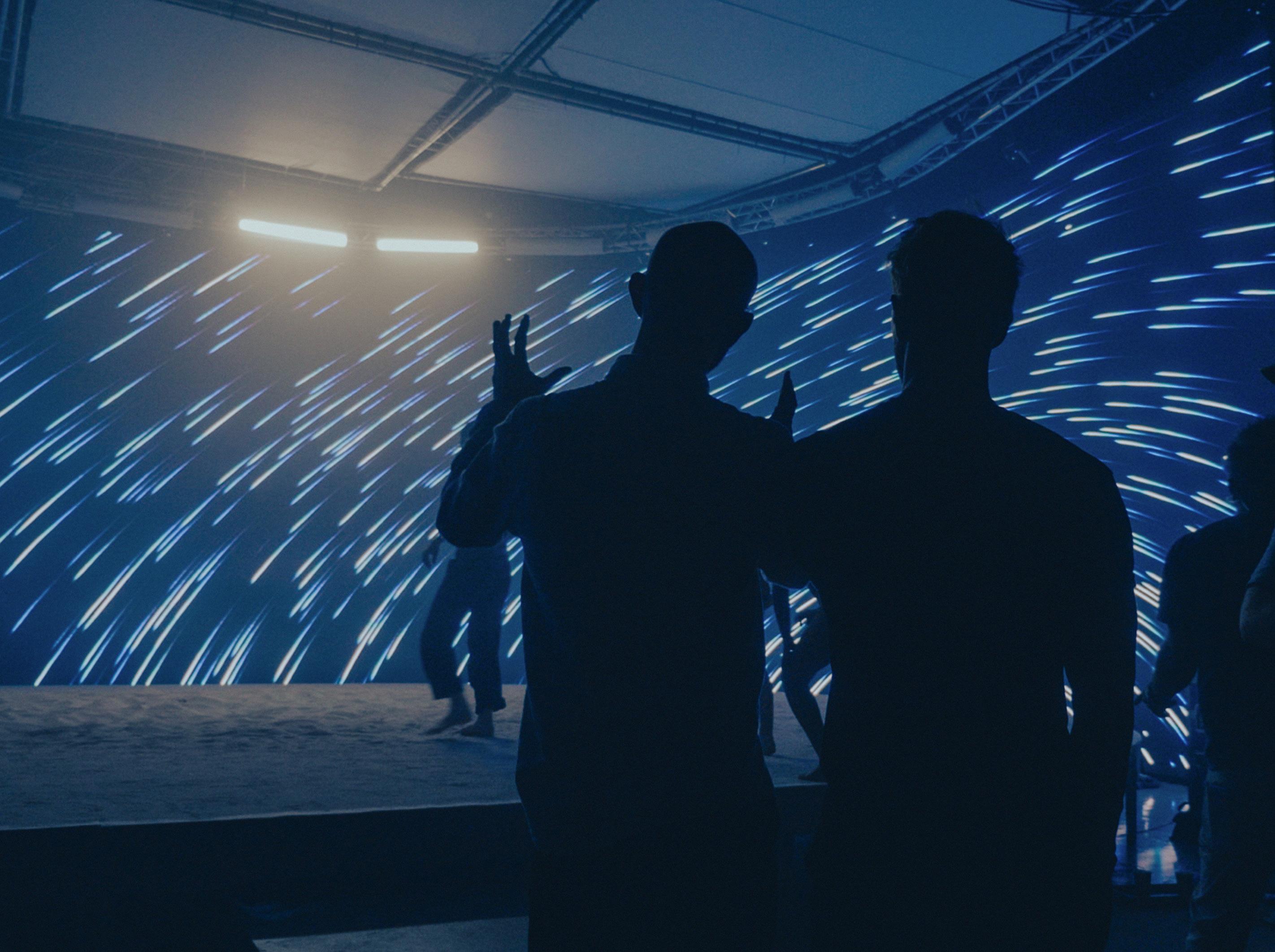
Procter says you have to work within virtual production’s limitations, referring to it as “a visual grammar of slow-moving shots.”
“We found that by increasing the frustum size (the area of the virtual world the camera can see) to be wider than our actual focal length we were able to get away with much faster camera moves,” he says. “We chose a Scorpio45 Technocrane to enable elegant sweeping moves, whilst also allowing programmed planes.”

This all paid off and the promo has been well received internationally. “One seasoned director asked which desert we shot in,” says Procter. “So, kudos to the team!”
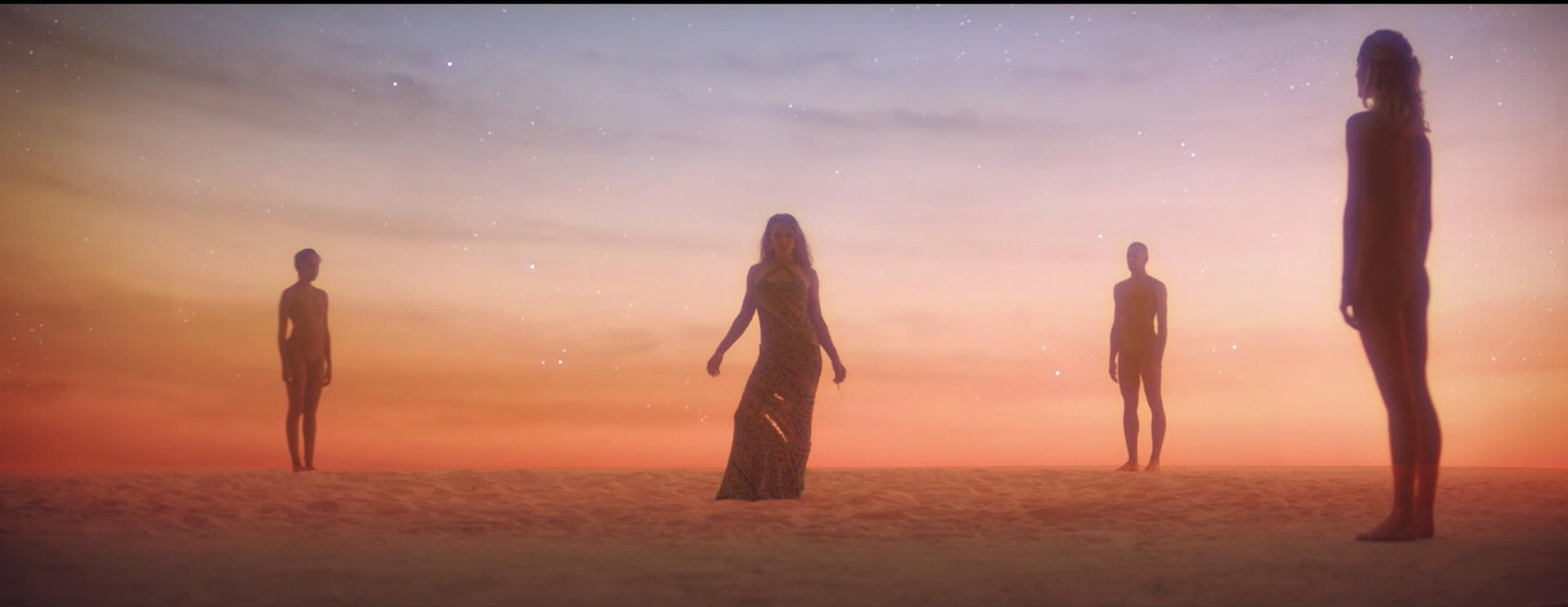

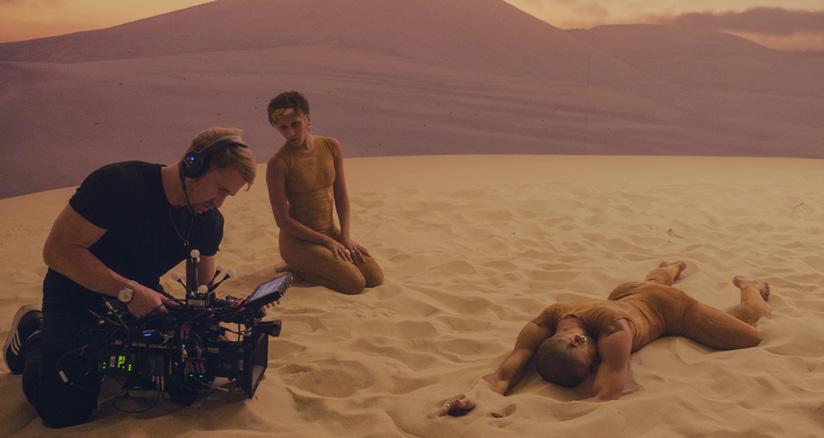
CINEMATOGRAPHY WORLD SEPTEMBER/OCTOBER 2023 41 DAVID PROCTER BSC•ELLIE GOULDING’S ‘LIKE A SAVIOUR’
Large format
Anamorphic is a great choice for virtual production
RESTLESS PARADISE
By Darek Kuźma
Polish cinematographer Monika
Lenczewska PSC returned to her indie film roots with director Sofia Exarchou’s exquisitely-crafted sophomore feature Animal.
Lenczewska’s style as a cinematographer has always been fairly difficult to pin down, stretched between celebrated indies – such as the Ethiopian legal drama Difret (2014) nominated for Best Cinematography at Sundance and EnergaCAMERIMAGE, the dark Icelandic comedy Under The Tree (2017), plus top-level films City Of Lies (2018) and the TV series Trust (2018).
After taking a break from feature filmmaking, during which she collaborated on commercials with directors such as Daniel Wolfe for brands including BMW and Nike, becoming the first female DP awarded with the coveted Gold Arrow, and Terrence Malick on Google’s Pixel 3, Lenczewska eagerly reunited with her friend Exarchou on Animal, an emotionally-complex tale of an international group of hotel performers who run entertainment for the guests of a lavish Greek holiday resort.
We follow the characters as they prepare a wide variety of enticing performances and intricatelychoreographed dance routines. We recognise their camaraderie and learn bits about their individual stories. We see how they work their daily grind in discos or karaoke bars, often hired by the owners to animate the crowds, and then go back home at dawn, dead tired yet energised enough to live through another stimulating and draining day.
Lenczewska shot Exarchou’s feature debut Park in 2016 and boarded Animal without a moment of hesitation.
“Sofia is the kind of director who lives and breathes whatever she is making. I like to help such filmmakers transform their ideas and passion into visual storytelling. I don’t recall if she’s ever asked me if I want to shoot the film, it was natural.
“She wanted me to be involved from early-on, and flooded me with scouting images, rehearsal videos and
photo references. Then, I flew to Greece two months before the shoot started. We broke down the script, and made a detailed shot list. Because of the time we spent on prep, and because we know each other so well, we didn’t talk a lot on set when it came to shoot,” Lenczewska affirms.
The entirety of Animal was shot on-location in Crete and Athens over 40 shooting days from September to November 2022.

“I always opt for shooting in real places,” Lenczewska recounts. “Working on a soundstage is fine, it gives you more control, but it robs you of natural light and the beautiful, inimitable ambience it creates. I’d rather take more time and adapt a real interior to whatever a project needs than use a sterile studio. Luckily, Sofia, and other directors I work with, share this sentiment.”
reactions, body language and gestures, little things that happen when you give the performers comfort and freedom to experiment with their characters,” Lenczewska offers. “I like the state of not-knowing, I prefer to just be there with my camera and respond. When you get into the actors’ rhythm, that’s when the magic happens.”
Animal’s particular visual language – lots of incamera movement, long handheld takes, making it look as natural as possible, shooting predominantly with one camera – meant that Lenczewska needed trusted equipment. As she has been a proud member of the ARRI family for years, she knew exactly which camera to shoot with.
“I’ve been loyal to ARRI Alexa Mini LF from the moment I shot my first film with it. It’s purely instinctual: it’s fast, has great optics, gives superb images, interacts beautifully with portraits and human skin. It’s good with night exteriors/interiors, and I can set it up by myself to whatever I need,” she declares. “We had a second Alexa Mini LF, operated on occasion by James Wall, but I shot most of the film on my own.”
She equipped the Alexa Mini LF cameras with Canon K-35 and FD lenses (20mm-135mm), supplied by Warsaw-based ATM System, with which she had already shot Exarchou’s Park
Authenticity – of emotions, locations, relationships, lighting, camera work – is an essential part of Animal’s cinematic identity. The film is designed in a way that it gradually reveals additional information about the characters and their worldviews, thus fundamentally changing our understanding of what makes them tick as human beings.

Hence, it was imperative to make the handheld camera responsive to the actors’ actions.
“Their movement was partly blocked, yet I wanted to be spontaneous, to get in the moment, capture
“I’m an intuitive DP and I love operating whenever I can, which is especially important on smaller films like Animal where the camera gets intimate with the characters. I like to have a small package, documentary-style, a few lenses and a camera, so that nothing slows me down. The Alexa Mini LF and Canon K-35s worked perfectly without changing the DNA of the story,” says Lenczewska.
Lenczewska extended her approach to the way she lit Animal and its restless characters, some of whom, as it is slowly revealed, treat the resort as a sort of asylum from the harsh reality that colours them as nothing special.
“I like to mix different light sources, LEDs with HMIs,
ANIMAL•MONIKA LENCZEWSKA PSC
42 SEPTEMBER/OCTOBER 2023 CINEMATOGRAPHY WORLD
I’d rather take more time and adapt a real interior to whatever a project needs than use a sterile studio
shape faces or silhouettes with Tungstens. Being flexible was a crucial part of this project as the script was so dense, emotionally-draining, and we were in a constant rush despite having 40 shooting days.”
Her most used light sources included ARRI SkyPanels (S60-C, S120-C, 360), Astera Helios/Titan Tubes, Chimeras (M w. 5K M40 ring, S w. 2K ring) and a solid Tungsten package – ARRI 10K, ARRI T5 5K, ARRI T2 2K, Parcan 64 1K, Source 4, Blonde 2K, Jem Ball 2K, and a Dedolight kit.
On the rare occasion of lighting day interiors, the kit included ARRIMAX 18K, ARRI M90, M40 and M18, but she didn’t light day exteriors at all.
“Admiring and understanding natural light is my calling,” Lenczewska remarks. “Wherever I am in the world, the sun surprises me, even if only by the way it hits a building and creates a special moment that quickly passes. There’s nothing that’s remotely as beautiful. I believe that if you commit yourself to observing and analysing it, you’ll become a better cinematographer.”
It was obviously different for the night scenes. “I was fortunate to have great collaborators in 1st AC Kostas Babis, DIT Ivailo Stefanov and gaffer Liviu Popa, with whom I have worked on commercials before. Liviu almost read my thoughts, which was important as in the pre-rigging disco and bar scenes we had to shape the flashy practical sources with our stuff in a way it looked natural and cinematic.
“Harris Savides ASC always claimed he preferred to light spaces, not people, and I do the same. It’s more lifelike. Sure, sometimes it’s hard and you feel that something’s missing. I was never afraid to reset a scene and shape it from scratch. It takes time, but if a director trusts you, you can do it. I encourage young DPs to not be afraid to start from scratch, as it gives you experience and
satisfaction, and works for the good of the film,” she adds.


“I wasn’t like that at the beginning of my career, but after a number of projects you just feel when you should work longer on a scene. Or the other way around, when you should be spontaneous. In Animal I often went with what I had without the perfect lighting, or asked my gaffer to attune on the fly. Many of these shots are in the film.”
As Lenczewska always puts a lot of effort into pre-grading with a DIT on the set, Animal’s 10-day DI work, completed with colourist Claudio Doaga in Romania, was about enhancing what she captured on camera and balancing out the footage shot over 40 days in wildly different conditions.

“We were able to achieve a satisfying look that met everything Sofia and I had set out to accomplish. I believe that if you put a lot of work into something, it’ll bounce back to you. In retrospect, this wasn’t an easy film but because the whole cast and crew gave their 100%, the result is there.”
Which can honestly serve as a perfect summary of what Animal is, a mesmerizing independent film about a group of flawed and fragile people trying their best to entertain other people, and be the most fun version of themselves before the outside reality comes knocking at their door.
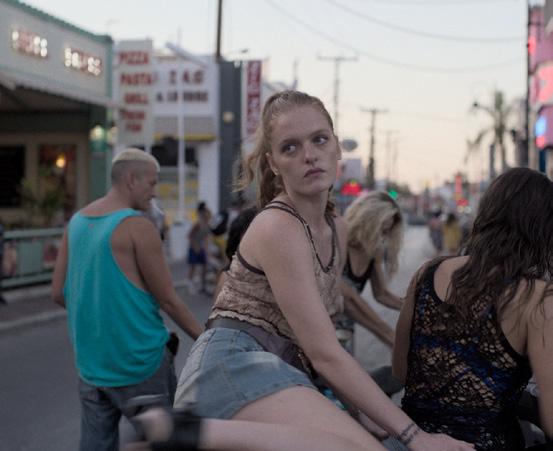

As for Monika
Lenczewska, she is currently working on Faithless, Tomas Alfredson’s (LET THE RIGHT ONE IN,
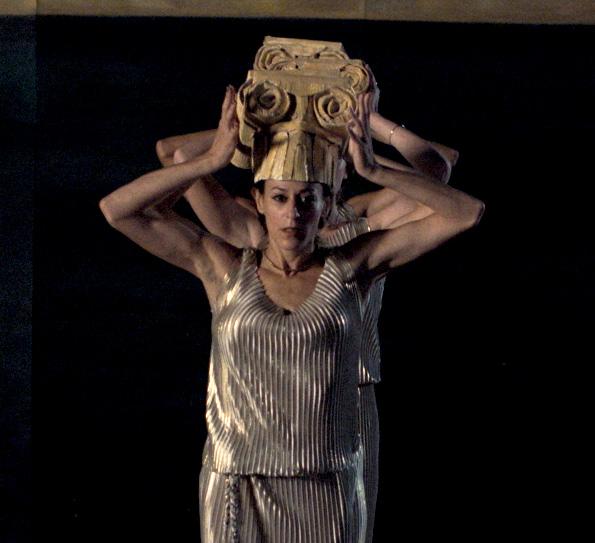
Tailor Soldier Spy) TV series based on Ingmar Bergman’s 2000 film of the same title, yet another thrillingly divergent project that should test what she stands for in terms of camera movement, approach to light and location shooting. Needless to say, the future looks ‘naturally’ bright for her.
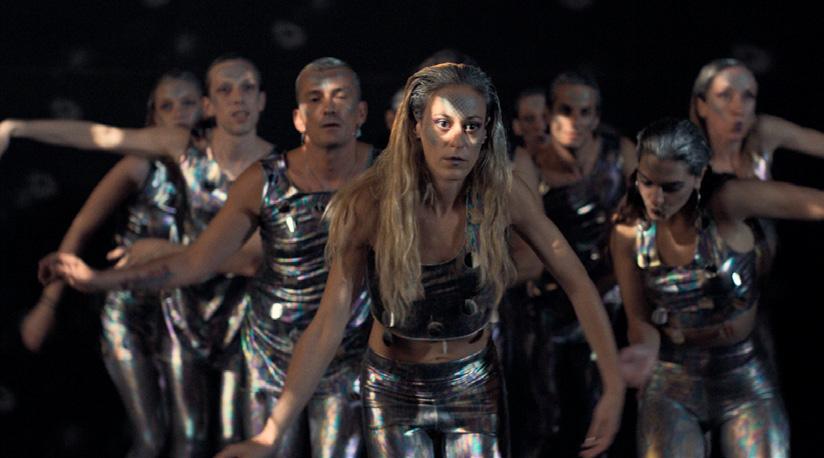 Images: BTS photos by Rafael Miralles.
Images: BTS photos by Rafael Miralles.
CINEMATOGRAPHY WORLD SEPTEMBER/OCTOBER 2023 43 MONIKA LENCZEWSKA PSC•ANIMAL
Tinker
Admiring and understanding natural light is my calling
ON THE SHOULDERS OF GIANTS
By Natasha Block Hicks
Sitting in a cosy café in his hometown of Ashburton, Devon, UK, wildlife documentary director and DP Toby Strong seems worlds away as he describes the profound effect that 25 years of working with wild elephants has had on his life.
“What I’ve learned about being a better human, I’ve learned from elephants,” he remarks with a deep respect. “Their kindness, gentleness and compassion are an example to us all.”
National Geographic’s Secrets Of The Elephants (2023), produced by “the incredible team” at Oxford Scientific Films, executive produced by James Cameron and narrated by Natalie Portman, is Strong’s
latest collaboration with the mighty creatures. The four-part series examines the language, emotional bonds, cultures and challenges of elephants living in four contrasting environments, separately titled as: Savannah, Desert, Rainforest and Asia. Strong acted as creative consultant for the series, as well as directing and co-shooting Desert, as one of three cinematographers who worked on the episode.
In his role as creative consultant, Strong found a process of pre-planning and storyboarding invaluable in articulating the vision of the series to everyone, from the producers to the cinematographers, and to the local fixers on the ground.
“Even though you’re going into situations where
the outcome is uncertain, by storyboarding, I can relay what my ideal vision would be,” Strong relates. “It’s enormously helpful and generates a toolkit for each episode.”
For instance, in the first installment, Savannah, directed by Nicola Tremain, the environment is where most laypeople might mentally place an elephant, and Strong envisioned it as “feeling like home”, filmically-speaking.
“Audiences are familiar with the image of elephants wandering across East Africa,” he explains, “so we stayed true to that impression with 18mm or 20mm wide lenses, large depths-of-field, rich colours and big skies.”

SECRETS OF THE ELEPHANTS•TOBY STRONG
44 SEPTEMBER/OCTOBER 2023 CINEMATOGRAPHY WORLD
Rainforests by contrast, directed by Fleur Bone, was a much more intimate affair. African forest elephants, with their small stature, rounded ears and startling amber eyes, are very rarely observed. “To even see one is a massive thing,” Strong points out.
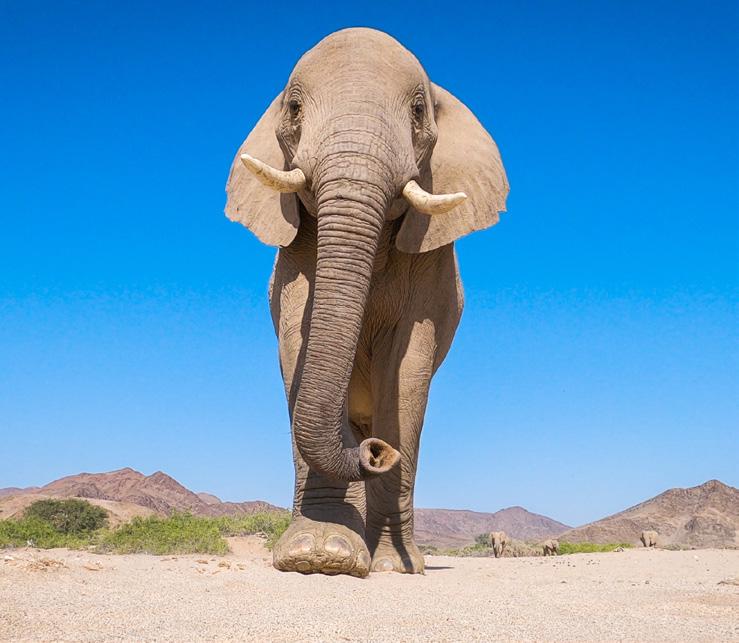
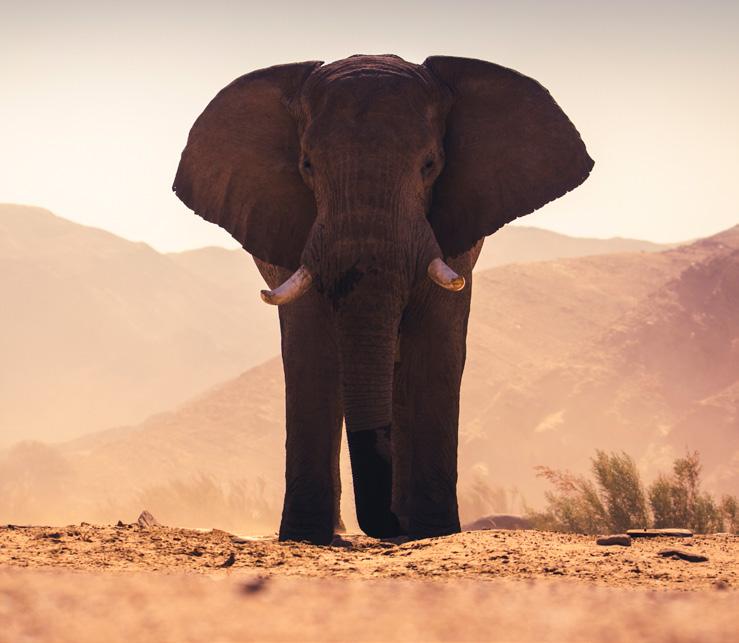
Consequently, longer 85mm lenses were used to “glimpse” a serene elephantine face framed by a tunnel of foliage or a delicate posterior disappearing into the dense undergrowth. Gimbals and sliders created sideways reveals in an emulation of the glide of the riverboat carrying the series presenter, Kenyan conservationist and elephant expert Dr. Paula Kahumbu.

“To emphasise that hidden, magical world of the
forest, we aimed for a slightly underexposed look, with dense shadows, very rich greens and layered insect sounds,” details Strong.
How elephants adapt to their proximity to human societies was the theme for Asia, directed by Josh Helliker, with 24mm lenses and faster cuts emulating a more human viewpoint and pace, as well as some sparing use of military thermal imaging to capture the nighttime raid of bull elephants strategising and conspiring together to plunder the produce of their human neighbours.
“There is an elephant which visits this town in Sri Lanka,” relates Strong of another scene, “so we decided to put up fairy lights and shoot through
 Images: courtesy of Toby Strong.
Images: courtesy of Toby Strong.
TOBY STRONG•SECRETS OF THE ELEPHANTS CINEMATOGRAPHY WORLD SEPTEMBER/OCTOBER 2023 45
I’ve learned from elephants – their kindness, gentleness and compassion are an example to us all
vehicles to make it a lovely urban story. The colours are brighter in this episode, with high contrast. There’s a lot more movement, and the sounds are rich and layered with loud music so that it really feels like Asia.”
The section of Deserts, directed and co-shot by Strong in-person, was all about extremes.
“I love deserts, they’re extraordinarily beautiful,” reveals Strong. “We shot either huge wides, like a 14mm, or went right in with a 1000mm on an elephant’s toenail. The sounds are silence, or sand grains falling, or insects scurrying.”
The daylight scenes were slightly burn-out to convey the crushing heat, which could exceed a staggering 50°C.
“The desert is really unforgiving,” Strong emphasizes, “at times you are struggling to survive yourself. We had sandstorms, and flash floods. Sometimes you’re shooting alone, so even after a 14-hour day, you must still download the footage and clean the kit, in a small tent with the sand blowing through.”
Strong used his own camera, the large-format 8K
Kinefinity Mavo Edge cine camera, supported by the Red DSMC2 Gemini, Sony FX3, Go-Pro and DJI’s Inspire 2 or Mavic 3 Pro Cine drones, to explore every dimension of the domain of the desert elephants.
“Kinefinity are not well known, but I adore how the Mavo Edge looks,” reports Strong. “It’s got a beautiful filmic feel to it. It’s full-frame yet compact, plus it’s got dual ISO, so it’s brilliant in low light.”
With elephants carrying-out much of their activities in the relative coolness of the night, recording after-dark was essential to give a complete picture of their lives.

“We could set the Sony FX3 to ISO 85000, which is just extraordinary,” reports Strong, “this meant we were able to shoot in moonlight for five days either side of a full moon.”
Strong’s staple lens was Canon’s Cine-Servo 501000mm zoom, set-up with the Red Gemini on the GSS Cineflex camera stabilisation system, mounted on an all-terrain vehicle, driven by field producer Paul Brehem.
“The 50-1000mm is an extraordinary lens, developed for wildlife photography,” reports Strong.
“I had to be a bit careful as the GSS system is very controlled, with a traditional cinematic feel, so I had to temper my love for shooting wide open at F1.2 with lots of flare and a tiny depth-of-field.”
The Mavo Edge’s ability to switch between PL and EF mount allowed Strong to mix in some Canon L-Series full-frame prime lenses. “I just love the look of the L-Series” Strong enthuses, “they’re really beautiful and organic.”
Hired-in kit was supplied by Films@59 in Bristol, UK, of whom Strong says enthusiastically, “I’ve got a lot of trust in them. If something goes wrong, it doesn’t matter if you’re in the jungle or huddled under a blanket in a snowstorm, you can call them up 24 hours a day and they’ll talk you through a fix.”
Co-shooting Desert with Strong were Kenyanborn veteran Robert ‘Bob’ Poole, who captured the rare birth of a desert elephant for the episode, and South African James Boon. Though the three cinematographers worked independently of each other, their collective effort has been recognised with a nomination for a Primetime Emmy Award: Outstanding Cinematography for a Nonfiction Programme.
“It’s wonderful to be recognised for cinematography, when they’re looking at the excellence of the image,” states Strong, “and we know there was probably just one person achieving that, whilst surviving at the same time.”
When not flying solo, Strong was assisted by Robbie Labanowski, who also struck off as an autonomous unit, using the Sony FX3 with a Laowa Probe Lens to capture the antics of a Namib desert beetle, and putting the Go-Pro in the elephants’ pathway for some startling low-angle shots of the pachyderms passing overhead.
All the filmmakers acknowledge a debt of gratitude to Namibia-resident field producer Brehem, his team and the local rangers.
“Paul’s knowledge of those elephants and ability to get us into the right place was invaluable,” acknowledges Strong. “He knew exactly how close he could get without influencing their behaviour. It was amazing.”
In the midst of filming, a rumour reached Strong and Brehem of a lone bull elephant in the far north of Namibia, where no elephant had been seen in years. “It was too extraordinary a story to risk missing,” relates Strong.
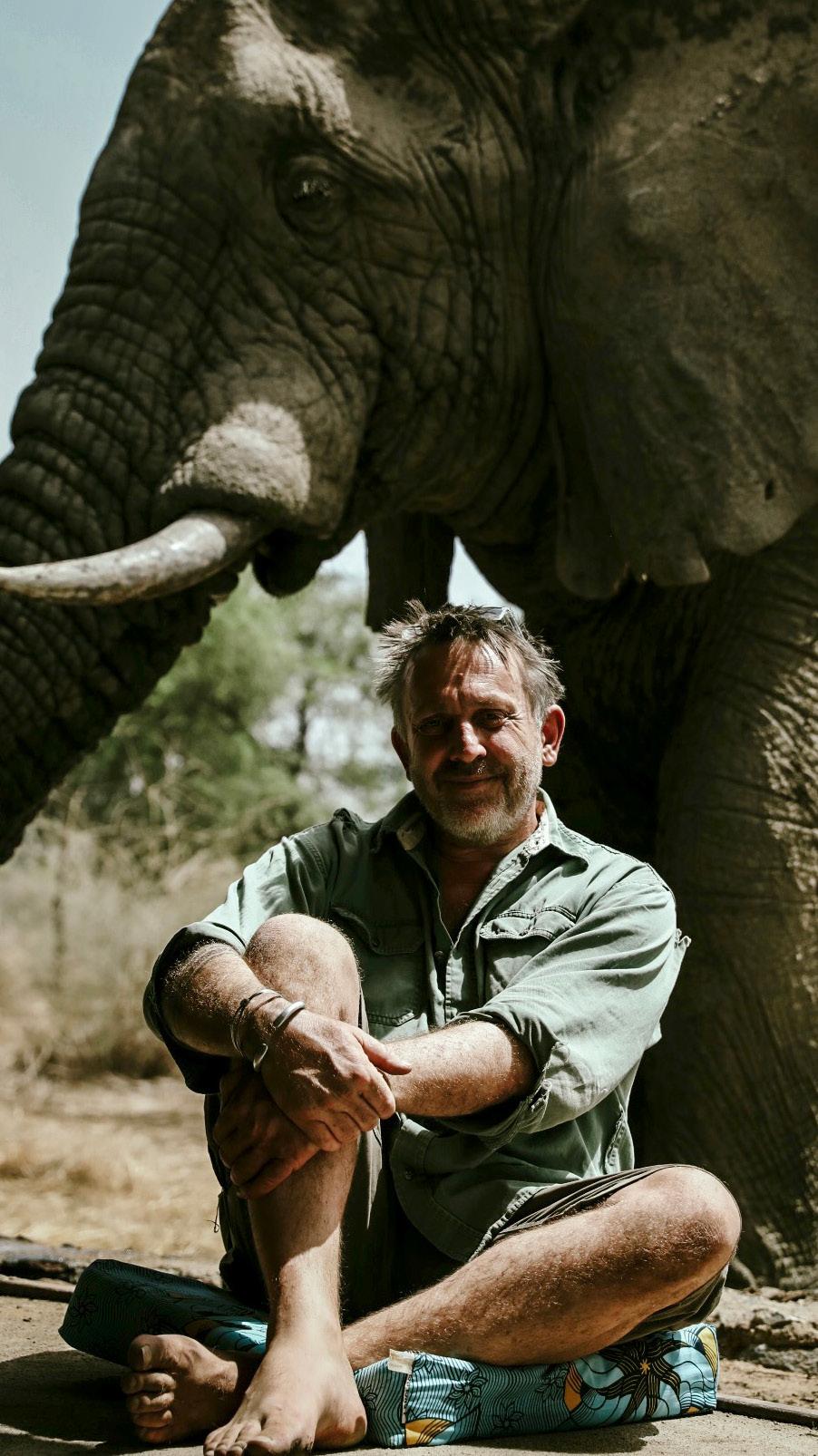

After a three-day drive, they located the bull, slowly journeying out of the middle of the desert through vast sand canyons.
“He was on his own, but he seemed to welcome
SECRETS OF THE ELEPHANTS•TOBY STRONG 46 SEPTEMBER/OCTOBER 2023 CINEMATOGRAPHY WORLD
the company,” Strong recalls. “We ended-up following him all the way to the sea. To spend time with one elephant, to see his struggles and stoicism, you develop a kind of bond. Those few days were very special.” Though he brushes shoulders with human stars (he is currently working on a project in Sicily with Martin Scorsese) and some legendary names pepper his CV (think Sir David Attenborough, who Strong describes as “electrifying and the most extraordinary person I’ve ever met”), his personal heroes are the individuals at the frontline of conservation.
“We really need to honour those people who risk their lives every single day to preserve our wildlife heritage,” Strong stresses. ‘They’re the ones who inspire me. When I travel the world and see what is happening to it, I find it so hard to have any faith. Yet I’ll meet these rangers and they’re filled with such positivity and lightness that I’m recharged again.”
Hope for the diminishing community of desert elephants is not yet beyond reach. By creating wildlife corridors, the isolated subpopulations in the Namib Desert could be connected to the larger herds in

the Etosha National Park, essential for their genetic diversity and survival.
“If we can establish that corridor and introduce education programmes so that people can live in harmony with elephants, then we can save the desert elephant,” explains Strong. “It’s that simple and it’s really achievable. That’s why we make these films –to engender a passion for the natural world, and to highlight issues that need help.”
Secrets Of the Elephants is available to stream now on Disney+

TOBY STRONG•SECRETS OF THE ELEPHANTS CINEMATOGRAPHY WORLD SEPTEMBER/OCTOBER 2023 47
The Kinefinity Mavo Edge cine camera has a beautiful filmic feel, plus it’s brilliant in low light
GETTING A GOOD REP
By Seth Emmons
Getting representation is a milestone achievement for any up-andcoming cinematographer, as well as directors, operators, production designers and other professionals in the film and television industry.

In a perfect world, a DP shoots a film that becomes a festival darling and the agents beat a path to their door. Top-tier work, success and accolades follow quickly. But, that’s rarely how it goes.
In reality, the path to representation includes not just shooting quality work, but also clever presentation, good timing and
CINEMATOGRAPHERS
NATASHA
www.natashabraier.com
Credits: The Rover (2014), The Neon Demon (2016), Honey Boy (2019), She Said (2022)
US Agent: CAA/Creative Artists Agency (www.caa.com)
UK & Europe Agent: Lux Artists (www.luxartists.net)
When you cut your reel to show agents, it’s important to choose the pieces that you feel most proud of and those that represent you the most. I don’t think it is that important to make sure you tick all the boxes to show you’ve dealt with a wide range of productions, budgets or lighting situations. When you try to do that, you can endup with a reel that shows more experience but feels generic.
I think you want to stand out, you want to show your voice as an artist, and you want people to see the potential in you. Most agents are very smart and sensitive enough to see the seed of who you will become as you gain more experience.
You want an agent to have a similar taste in
strong interpersonal skills. Furthermore, many cinematographers seeking an agent may not understand exactly what role this person, and their agency, will play in their career.
We spoke with a handful of cinematographers and agents to shed light on some of the main questions surrounding representation. What should you expect from your agent? How do you even get an agent in the first place? Does getting an agent automatically mean a steady stream of work? What do they do and what do you do in this relationship? How important is social media before getting representation and afterward?
cinema, or at least fully-understand your taste and what you are looking for, and support it. The most important thing you will get from an agent
is advice on how to steer your career through your choices, what project to take and what not to take.
SPECIAL REPORT•AGENTS
48 SEPTEMBER/OCTOBER 2023 CINEMATOGRAPHY WORLD
BRAIER ADF ASC
An agent can open doors, but the DP has to maintain the relationships
CHECCO VARESE ASC
www.checcovarese.com
Credits: Pacific Rim (2013), It: Chapter Two (2019), Dopesick (2021), Daisy Jones & The Six (2023)
Agent: UTA/United Talent Agency (www.unitedtalent.com)
In the business we’re in, you need someone to filter the uncomfortable conversations about salary, travelling, lodging, per diem, etc. Those are the conversations that agents are brilliant at. Sometimes it’s finding that companion ticket or a 10% raise.
Once you understand that the best thing an agent can do for you is find you the right contract with the right conditions and fight for those conditions, then you see their value and they become a partner who makes your work life better for you.
The work they do allows you to preserve your creative relationships. As a cinematographer my relationship with the producer should be creative and based on my merit, as a leader of the troops and a creative person who can resolve things in a limited amount of time. I don’t want to stain those relationships with how much am I going to make or what room I’m staying in.
You also hope that your agent will find you the perfect movie or series or commercial, and they can be incredibly creative during this process, but
KIA FERN LITTLE
www.kiafernlittle.com
Credits: Hope Tala “Cherries ft. Aminé”, Jake Milliner “Jack Jones ft. Bubblerap”, Run It Off (2017) BB3 Such Brave Girls (2023)
Agent: Vision Artists (www.visionartists.co.uk)
When I first got signed I was so grateful for being represented that I mostly said ‘yes’ to every job that came in. I thought my agents would be annoyed if I turned work down as it meant we’d both lose-out on income.
However, my agency were really supportive and encouraged me to focus my energy on projects that were creatively stimulating, rather than burning myself out on jobs that didn’t align with my interests.
It can be hard to decipher which projects will be the ones worth taking, whether you’ll form new working relationship or if it will be work you’re really proud of. I was surprised by how much I could defer to my agents and ask for their advice, which I have found to be super-valuable.
I have met wonderful collaborators that I really value from being put forward for jobs. The great benefit of being represented is getting put into rooms you wouldn’t have access to otherwise, but
You want people to see the potential in you
my experience is that in the beginning you shouldn’t choose an agent because you think they’ll find you a job.
You should sign with an agent because you have a personal relationship based on the same taste in films and a shared idea of how to grow
your career. The initial conversation with the agent should be: Who do I want to be? And, how do I want to be perceived as a cinematographer?


the onus of getting work isn’t just on your agent. I view our relationship as a team effort, in the same way you would expect on any production.
It’s important to put time into building and maintaining working relationships, reaching-out to
people you love the work of, being someone that’s pleasant to work with, and creating work that you’re proud of, so your agent has something to work with.
Building followers within the industry will help you book your next job
AGENTS•SPECIAL REPORT CINEMATOGRAPHY WORLD SEPTEMBER/OCTOBER 2023 49
AGENTS
SILVIA LLAGUNO – UNITED AGENTS London, UK www.unitedagents.co.uk
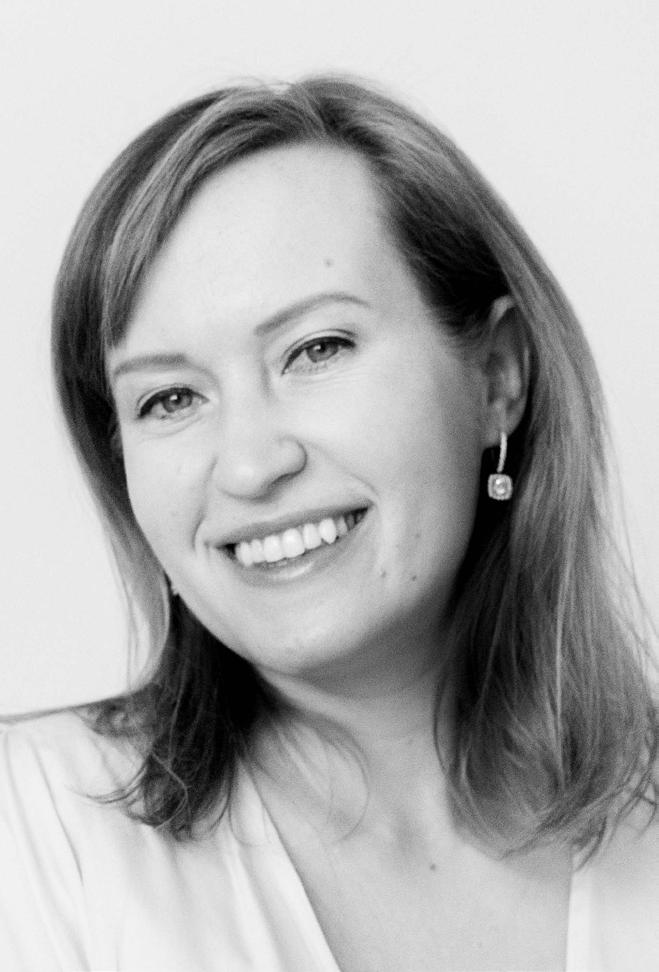
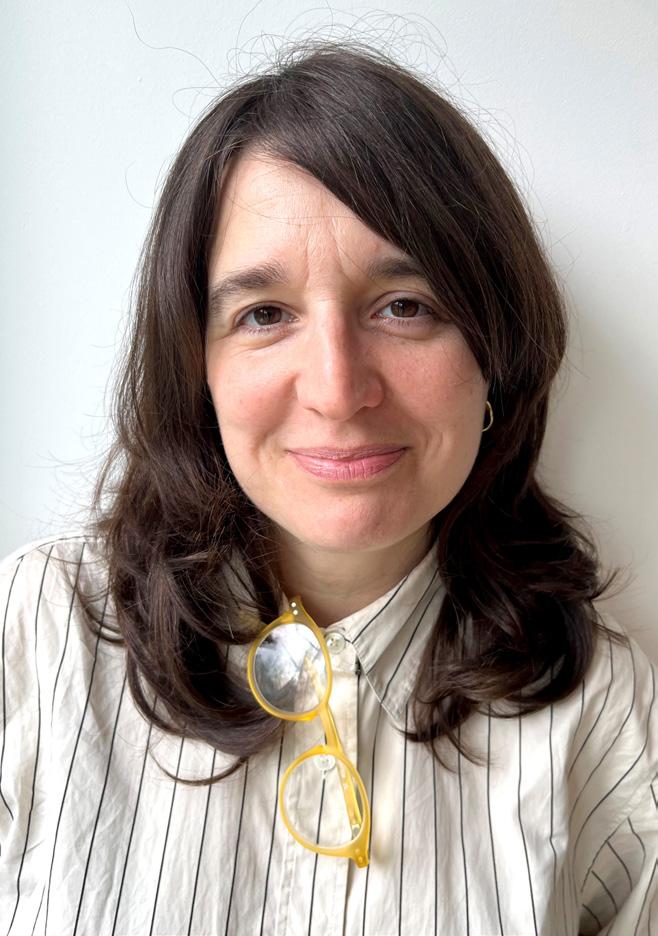
When choosing DPs to meet with, my focus is on their reel. I’m looking for intelligent, uncompromising work as well as content choices. During our meeting I’m looking for a collaborative, likeable personality and shared taste and humour. A good personality, professional attitude, and good communication/managerial skills are as important as creativity and talent to ensuring a successful career. If producers, crew and directors are not saying the right things about you even the best agent can’t help you.
Most DPs expect their first agent to just find them work. While important, that’s not the main thing we do. We create opportunities by brokering introductions, engaging new productions that are crewing-up, and selling a client to a producer in a targeted way. However, it is the DPs
themselves who secure the job at the meeting stage with directors and producers.
My primary value is helping clients select projects based on their needs. My personal mantra is to choose projects based on script and director, and work on passion projects early in their career when living costs are low.
But everyone has different circumstances. A DP getting their first mini-studio film or HETV drama series might compromise on the deal in exchange for a potentially career-changing opportunity, while a DP with dependents or financial stresses might broaden their range of projects.
A good agent creates a buffer and safe space for both the DP and production to vent feelings and speak freely, so that we can be tough negotiators and push for the best deal without damaging the DP/production relationship. We navigate these difficult situations with producers using diplomacy, good judgement, and persuasion skills.
LOUIZA VICK – WPA
Los
Angeles, USA
www.wp-a.com
I believe the most important aspects of being an agent are being a good listener to truly understand the taste and goals of the artist and being proactive to make things happen for that artist and set them up for success. That may mean asking for camera department budgets and crew rates before agreeing to a deal, pushing to make sure the DP has the colourist of their choice, or calling a producer to address an issue.
Another aspect that people may not think about is connecting the dots between a client and a producer or director, constantly thinking about what tangible connections may exist between them, and making sure those connections are known.
It is important for DPs to maintain their existing relationships and find ways to network and expand those
JERRY DEENEY – LUX ARTISTS
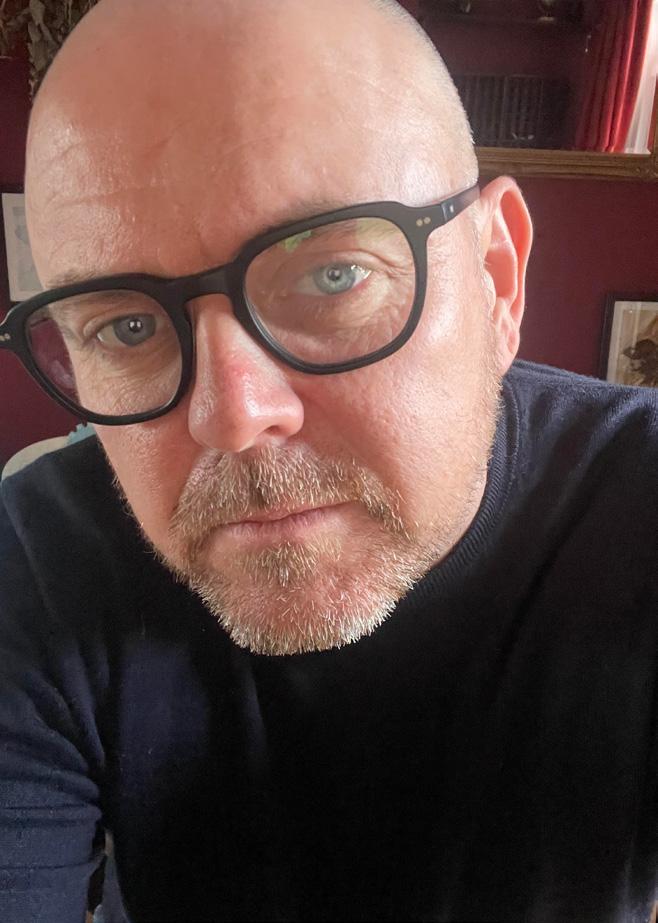
London, UK
www.luxartists.net
Curating a DP’s website and reel is a big, unsung part of our job. We spend a lot of time choosing the right spots for the reel, picking thumbnails that make you want to click on them, and figuring-out the best running order.
Sometimes the DP is too close to their work to make informed decisions on what is good or not. It is vitally important to have a fresh pair of eyes look at the cinematographer’s work as the agent will also know what the director and producer are looking for. The most recent project is not always the best and sometimes DPs dismiss a really great project because they didn’t enjoy the experience on-set. Imagine you are the producer or the director and every agency in town has sent you half a dozen reels to look at. How do you create their intrigue
contacts, especially identifying directors with whom they share creative sensibilities. An agent can open new doors, but the DP has to maintain the relationships and do their part to expand their network.
I advise DPs to do their research when looking for an agent. Having someone reach out to the agent on their behalf makes a stronger impact. If you reach out blindly via email, keep the email short and to the point, emphasise why you’re choosing that agency, and share the most notable highlights of your work.
To me, the most important things when considering a client are a unique perspective as an artist, good references and repeat business from filmmakers, and a winning personality. Having a clean, easy-to-navigate website and some social media presence that represents your personality are important, but most important is that the work needs to be strong, to showcase a consistent POV as a cinematographer, and represent the type of stories you want to tell.
and how do you keep their attention? Less is more and you need to make every click count.
The second place an agent looks after your reel is your Instagram account. Choose your images well and make posts of your best work. Building your followers within the industry will help you book your next job. We often get multiple requests for our DPs the morning after a successful Instagram post, either on the Lux account or if the client has posted it directly.
Cinematographers looking for an agent can reach out to an agency directly, but choose your right moment carefully. Wait until you have some great credits and a solid reel to show. Use the momentum of a well-received project: a killer music video everyone is talking about, a recent award, or a film that has been well-received at a film festival. Agents will be looking for an upward trajectory. Is this DP on the way up and about to break through to the next level?
SPECIAL REPORT•AGENTS 50 SEPTEMBER/OCTOBER 2023 CINEMATOGRAPHY WORLD
You need someone to filter uncomfortable conversations about salary, travelling, lodging, per diem, etc..
Choose projects based on script and director, and work on passion projects early-on
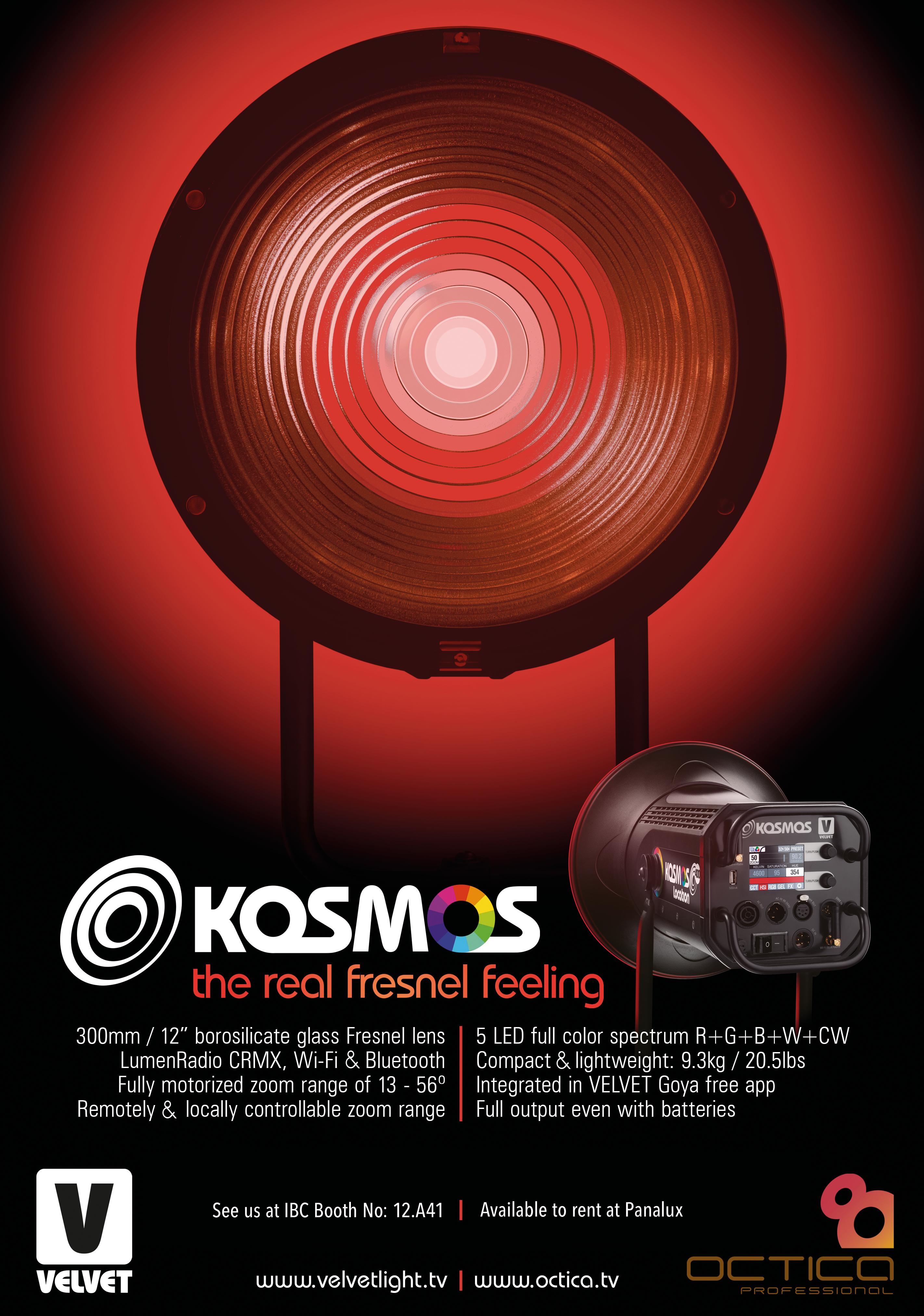
TOTALLY FOCUSSED
Filmography (so far)
Narratives: Gorka (2023, dir. Joe Weiland), selected for BFI London Film Festival 2023, Aesthetica Short Film Festival 2023 and silver winner of Young Directors Award 2023; Caterpillar (2024, dir. Dorny Sunday, produced by BFI); and Moon Under The Water (2024, dir. Grandmas, produced by BBC & BFI).
Commercials: Adidas (2023, dir. Daniel Wofe, Will Dohrn & Justyna Obasi); Vans (2023, dir. Will Dohrn); Burberry (2023, dir. Tyron Lebon); Woman’s Aid (2022, dir. by Sara Dunlop) multiple award- winner at Cannes Lions, British Arrows, D&AD and Creative Circle Awards; and Gucci x The North Face (2022, dir. Tom Dream) multiple award- winner at Webby, D&AD Awards Kinsale Sharks Festival and Berlin Fashion Film Awards.
Music Videos: Idles “War” (2021, dir. Will Dohrn) winner at UK Music Video, Brilliant Filmmaking and 1.4 Awards; and Jeshi “3210” (2021, dir. Will Dohrn) best Hip Hop Video nominee, UK Music Video Awards.
When did you discover you wanted to be a cinematographer?
I was 22 or 23 when I knew I wanted to be a cinematographer, but it’s been quite a long road. When I was 15 I used to film and edit a bit of skateboarding footage. As I got older, I got into shooting skateboard stills photographs and it wasn’t until the Canon 5D MK II came out that my interest for video came back.
My friend owned a UK hip hop label called High Focus records, where I started to make all their videos. I had no idea what I was doing to be honest, and didn’t even really know what a DP job
was. We were just going out and making it up on the spot, having fun and sometimes I was editing them by the next morning.
Then a friend of mine got me on loads of camera operating jobs, multi-cam music and fashion events, where I started to learn what a DP actually was. I quickly realised I had no interest in directing or editing, but wanted to become involved with the camera and lighting side.
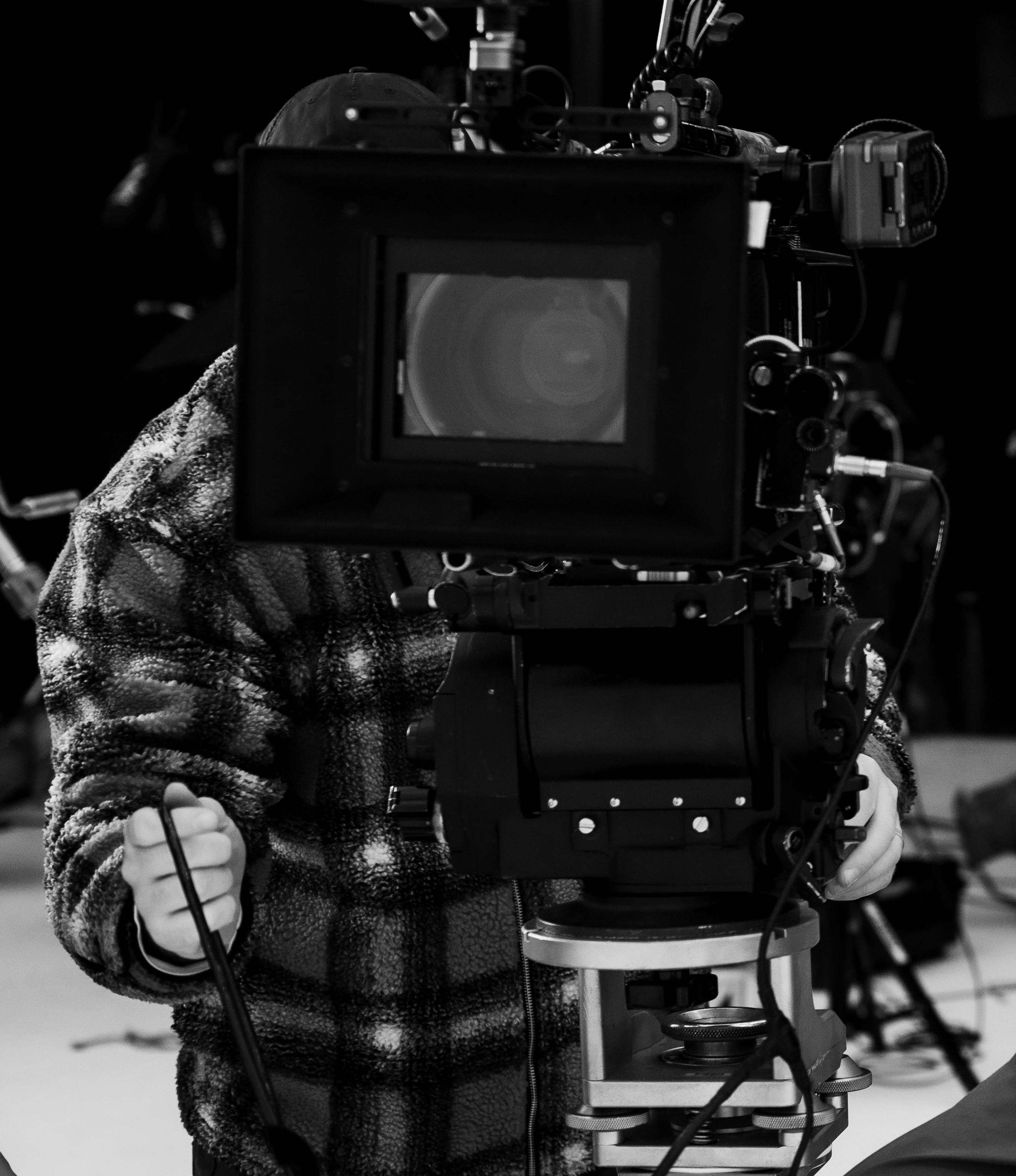
So I really started to push to get on big sets, to be
Be kind and treat everyone with equal respect
able to watch how DPs work. I emailed every 1st and 2nd AC on UK diary services and managed to get some work on commercials and music videos as a trainee. Then I managed to get a place on the Skillset Camera Trainee scheme which got my foot in the door with features and TV shows, and where I learnt so much off of amazing DPs.
What is one thing you wish you knew when you were starting out?
That even though you have to make sacrifices to make it as a cinematographer, some things are more important. I’ve missed some important family and social events over the years that I really wish I hadn’t. It takes a lot to learn which jobs are worth the sacrifice.
Where do you get your visual inspirations?
Movies and photography books mostly – I’ve been building a pretty good photobook collection over the years.
What was the worst knock-back/ rejection you ever had?
I got denied from the NFTS… twice!
I worked as a camera trainee, 2nd AC and did a little focus-pulling for around six years. I shot anything and everything that I could on the side, and somehow managed to get busy enough as a cinematographer that I naturally stopped camera assisting. I got signed a couple of years later by Lux Artists and have been very lucky to have quick rise in commercials.
Where did you train?
I studied graphic design at Brighton University, but knew about a year in that I was more interested in film and photography.
How did you get your first break?
From a focus puller called David Agha Rafei who got me on a Noah And The Whale music video/ short film as a camera trainee. David trained me up and I later became his clapper-loader.
Who are your DP/industry role models?
Harris Savides ASC, Gordon Willis ASC and Conrad Hall ASC. They were so ahead of their time.
What’s the best advice you were ever given, and from whom?
“Don’t follow the money or you will end up in the wrong place, always take the more creative job”. A DP I used to assist for, called Ben Todd, said this to me, he was very supportive when I started shooting.
What have been your best/worst moments on-set?
Best: shooting sunset on a beach in Barbados with a bunch of very good mates
Worst: shooting on an English winter’s night under rain effects and forgetting my waterproof boots.
What’s the strangest place you’ve ever shot in?
It was early-on in my career, shooting in what we come to learn was a swingers club with a pool. We were doing underwater shots which I was operating. I don’t think I would agree to that now.
What’s the hardest shot/thing you’ve had to light/frame?
I can’t think of a specific scene, but I just shot an amazing Adidas campaign, directed by Daniel Wolfe, Justyna Obasi and Will Dohrn in South Africa. It was three different scripts with three
different directors, which all happened in just under three weeks, and was a real mix of technical and fast-paced shooting. I was absolutely wrecked after it, but it was one of the most rewarding and enjoyable shoots I’ve ever done, despite it being a real endurance test.
Away from work, what are your greatest passions?
It used to be skateboarding and photography and somehow it has ended-up being golf. I have no idea how that has happened.
52 SEPTEMBER/OCTOBER 2023 CINEMATOGRAPHY WORLD ONE TO WATCH•HARRY WHEELER
It takes a lot to learn which jobs are worth the sacrifice
In the entire history of filmmaking, which film would you love to have shot?
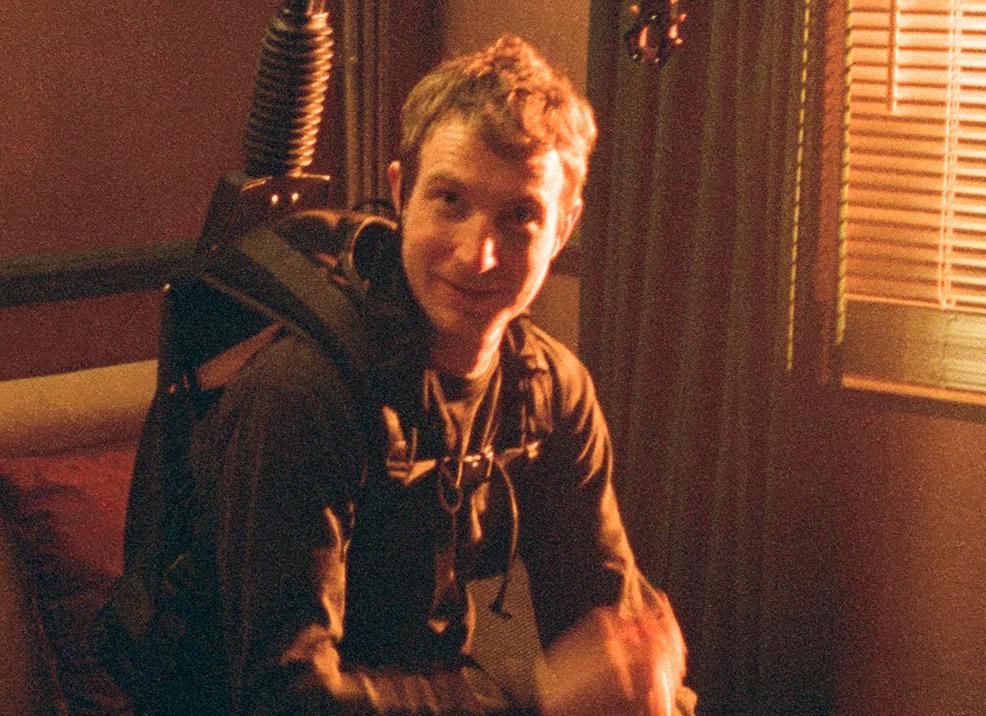
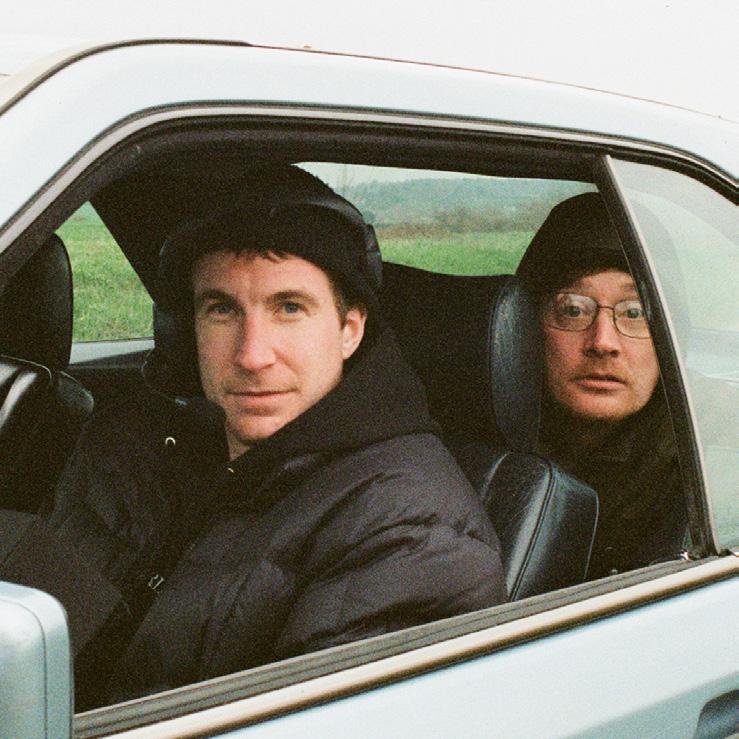
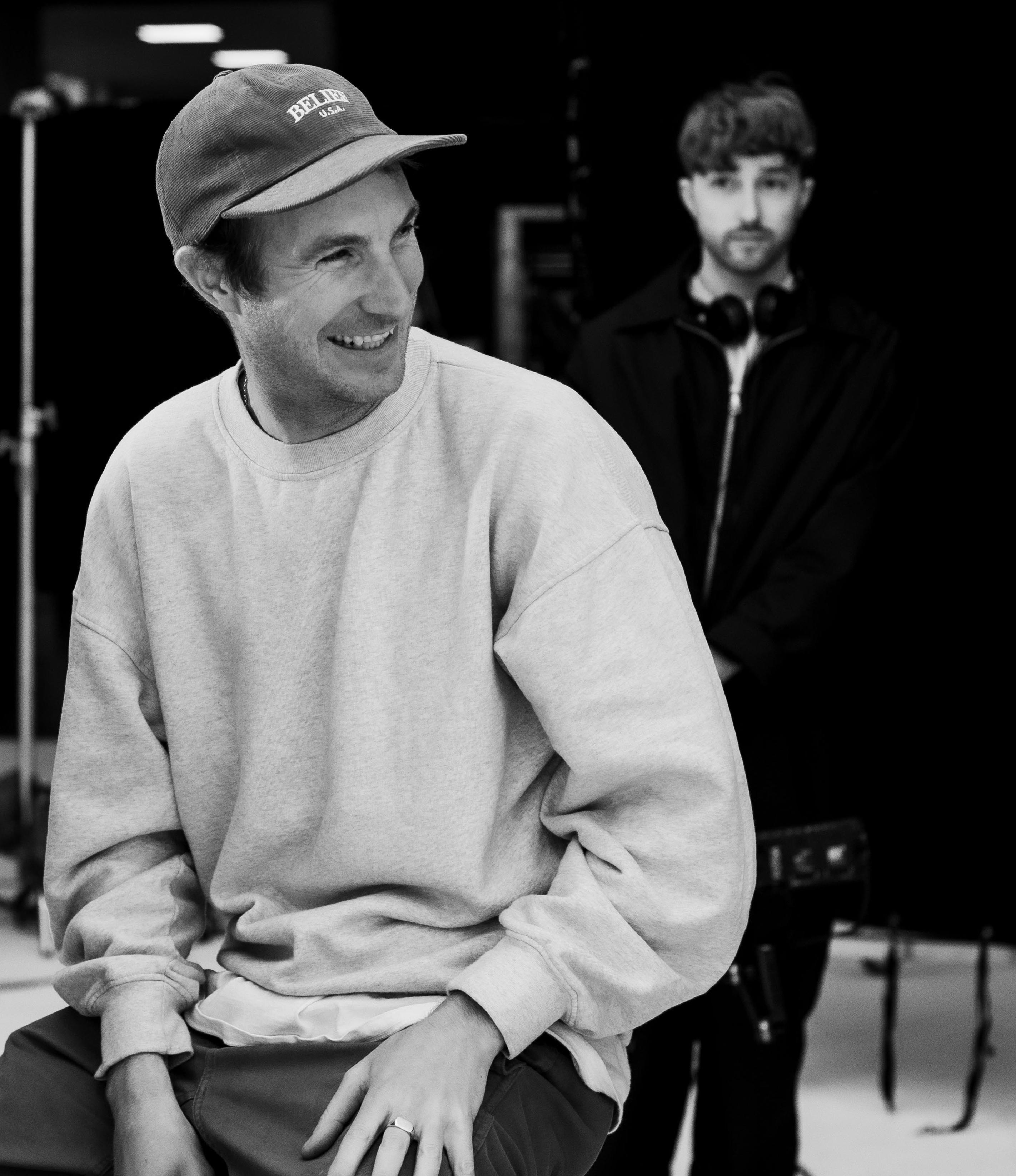
It’s a toss-up… either The Master (2012, dir. Paul Thomas Anderson, DP Mihai Mălaimare Jr. ASC) or Terminator 2: Judgement Day (1991, dir. James Cameron. DP Adam Greenberg ASC).
What’s the best/worst thing about being a DP?
Best: Being able to make a career out of something that you generally love, to travel the world and meet amazing people.
Worst: Finding it hard to like my own work and always feeling like I need to get to the next level in my career, instead of enjoying the journey.
I got denied from the NFTS… twice!
Give us three adjectives that best describe you and your approach to cinematography?
Intuitive. Simple. Responsive.
If you weren’t a DP, what job would you be doing now?
Probably a plumber. I used to work as my dad’s apprentice and he convinced me to go and try something else when all my friends were getting into university.
What do you consider your greatest achievement, so far?
To be honest I’m just happy to now be in position that I can pick-andchoose the projects I get to work on. I’m lucky enough to be busy and working with very talented directors. And the best lesson I have learnt from coming-up as a crew member is to just be kind and treat everyone with equal respect no matter what their job role is.
What advice do you have for other people who want to become cinematographers?


Get on-set and learn how sets are run, or how others work. Or, just buy a DSLR and shoot anything and everything you can. You will learn so much either way.
What’s up next for you?
I’m making a big push to get into narrative and potentially have a TV pilot coming up. I’m about to start applying for my American visa so hopefully that will open-up some good opportunities.
Who is your agent?
Lux Artists in Europe and WME in the United States
What is your URL/website address? https://www.harrywheelerdop.com
@harry__Wheeler
HARRY WHEELER•ONE TO WATCH CINEMATOGRAPHY WORLD SEPTEMBER/OCTOBER 2023 53
HEART OF DARKNESS
By Ron Prince
Power corrupts.
Absolute power corrupts absolutely.
El Conde, the latest film from renowned Chilean filmmaker, Pablo Larraín, sees the country’s brutal fascist dictator, General Augusto Pinochet (1915-2006), reimagined as an old, ailing and disenchanted vampire, brought to the screen in a bloody, satirical comedy-horror genre, that is couched in suitably-brooding B&W cinematography by the widely-admired American cinematographer Ed Lachman ASC.
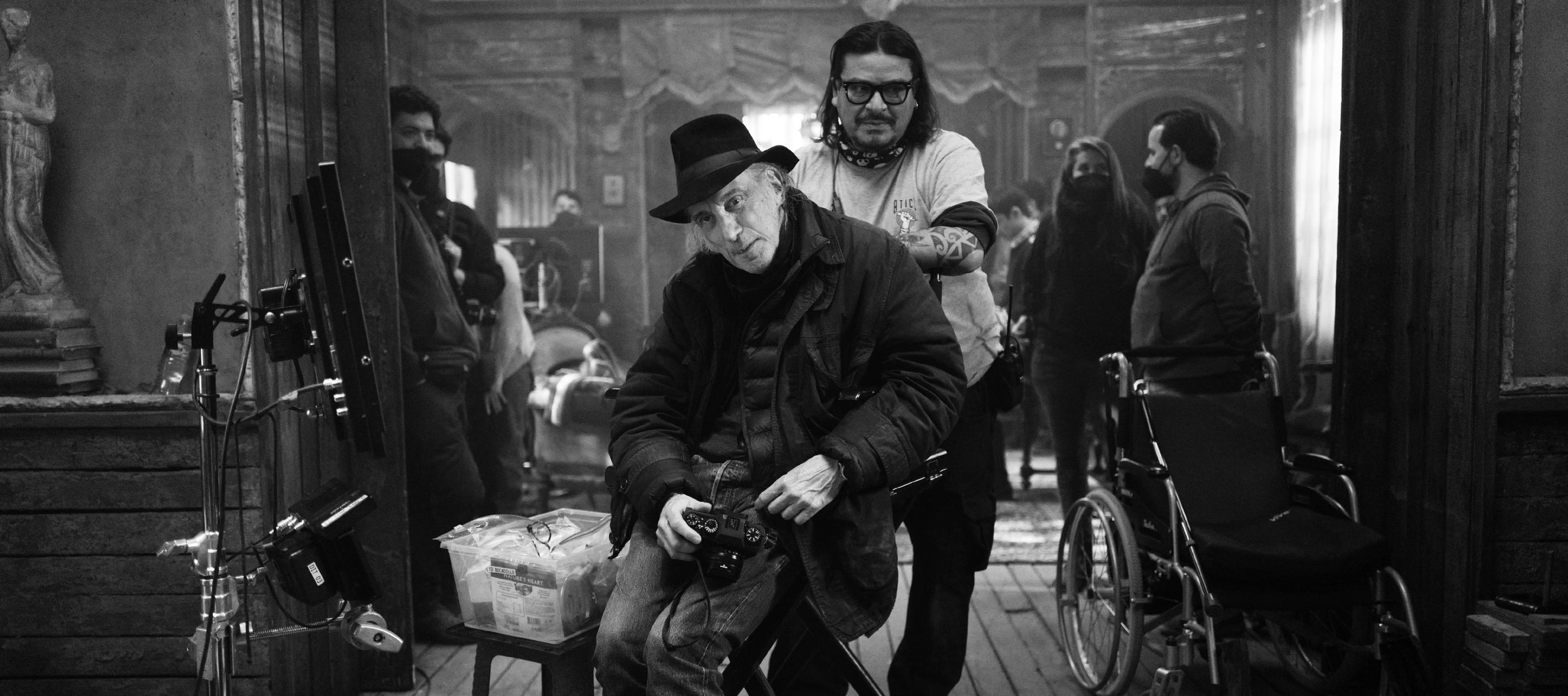

As a British narrator explains the backstory at the opening of the film, Pinochet, now 250 years old, was once an orphan, abandoned on the stairs of a nunnery by an unwed peasant girl in 18th century France. Later, as a young Royalist with an insatiable lust for blood, Pinochet licks the blade of the guillotine that severs the head of Marie
Antoinette, as he is revealed as a vampire. Absconding to distant lands, Pinochet emerges as the rising star of Chile’s military takeover, but has since become world-weary and now wants to die as a vegetarian due to the lack of honour and respect for his efforts to create his country’s prosperity and for himself. This, however, does not deter him from flying around Santiago to sink his fangs into fresh young blood, gulping down smoothies made from human hearts with a splash of tequila in the underground lair at his remote ramshackled ranch.
To make things worse for the poor old devil, his grown-up children congregate to discover the extent of their inheritances, his wife Lucía longs to become a vampire, and a beautiful young nun has been sent to investigate his ill-gotten finances and exorcise the spirit of the devil.
The Netflix film made its world premiere at the 2023 Venice Film Festival to acclaimed reviews, which, along with Larrain’s direction and central performances, included the highest-praise for Lachman’s atmospheric, immersive and funereal B&W expressionism. The film stars Jaime Vadell as Pinochet, with Gloria Münchmeyer as Lucía, Alfredo Castro the veteran White Russian butler, Fyodor, and Paula Luchsinger as Sister Carmen.
Principle photography on El Conde took place over 40 shooting days, commencing on June 24, 2022, before wrapping at the end of August, at locations around Santiago, Chile, including exteriors that doubled for Paris during the French Revolution. Two stages at a local TV studio housed sets for the bedroom, living room and subterranean den at Pinochet’s ranch. Production also took place at remote location in Patagonia, where the
EL CONDE•ED LACHMAN ASC
54 SEPTEMBER/OCTOBER 2023 CINEMATOGRAPHY WORLD
exteriors of the ranch were constructed, including a graveyard with tombstones and guillotine.
Lachman, who lives in New York, has typically worked in independent film, serving as the DP for prominent directors including Werner Herzog, Jean-Luc Godard, Ulrich Seidl, Wim Wenders, Steven Soderbergh, Paul Schrader and, most notably, perhaps, Todd Haynes, with whom he has made six features to date. Lachman is a double Oscar-nominee for Haynes’ Far From Heaven (2003) and Carol (2016), earned the ASC Lifetime Award in 2017, amongst many other accolades.
Offering some insight into his background with Larraín, Lachman says, “Pablo is one of the most original and brilliant voices in Latin-American filmmaking. I have followed his career from Tony Manero (2008, DP Sergio Armstrong), and more recently Jackie (2016, DP Stéphane Fontaine AFC) and Spencer (2021, DP Claire Mathon AFC).
“He’s been supported by Telluride Film Festival and the New York Film Festival in the US, and whenever he’s been around we’ve managed to see each other. He knew my work and always said one day that he’d bring me to Chile to work on a project together. I never knew if that was ever going to really happen or not, but we endedup shooting a commercial together in LA, and afterwards he invited me to film El Conde in Chile.
“Of course, I am always up for an adventure, and I accepted Pablo’s invitation without hesitation. For me, filmmaking is about taking different journeys, and this was really out of my comfort zone. I’ve worked in melodrama with Todd Haynes, but I’d never shot in the genre of horror and never a vampire movie. So I was really intrigued.”
Speaking about his initial reaction to Larraín’s script and treatment for El Conde, Lachman remarks, “The best directors I’ve worked with are ones who are always exploring how you tell stories uniquely visually, who think about how the content shapes the form.
“El Conde was not the traditional, romantic perception of a vampire movie, but one that looks
at how politically, culturally and socially our blood is taken, literally and figuratively by complying, yielding and being seduced by fascism, but in a dark, satirical comedy form.
“What is so interesting to me about Pablo’s films is that he approaches his subjects and stories as allegories inside a social and political context. Many of his films in Chile are about the impunity or exemption from punishment, such as Tony Manero, The Club (2015, DP Sergio Armstrong), Neruda (2016, DP Sergio Armstrong) and now EL Conde Chilean families and individuals were physically hurt or murdered under the Pinochet regime, but never found justice or relief, yet Pinochet died a millionaire, free of his crimes.
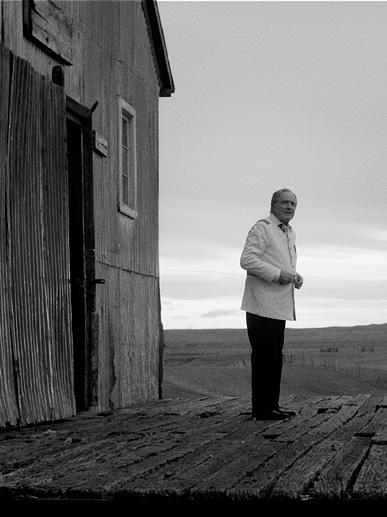
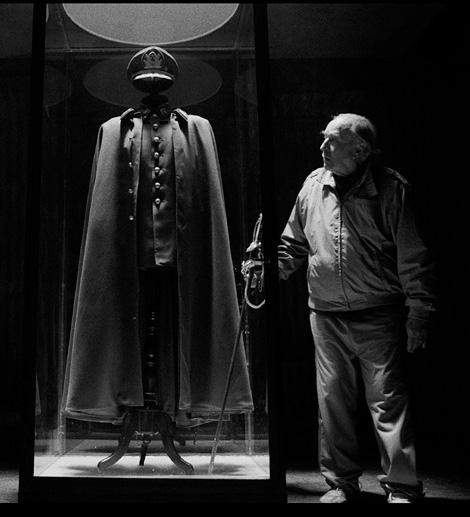

approval from Netflix to shoot in actual B&W, not in colour followed by desaturation in post, but to originate in real B&W. The abstraction and distant nature of B&S gives us a way of seeing the world differently than the way we do with our own eyes.
“That was a great place to start. I had experience shooting in Black and White with Todd Haynes on I’m Not There (2007) and Wonderstruck (2017), shooting on Kodak Double-X 5222 film negative.”
Lachman says B&W visual references for the film, although old in cinema terms, were fundamentally important for the production. These included the silent productions of Nosferatu (1922, dir. FW Murnau, DPs Fritz Arno Wagner & Günther Krampf), Vampyr (1932, dir. Carl Theodor Dreyer, DPs Rudolph Maté & Luis Née) and Shanghai Express (1932, dir. Joseph Von Sternberg, DPs Lee Garmes & James Wong Howe).

“Along with the different physicalities of expressionistic and atmospheric styles lighting, and the use of textures in the sets, what I also loved about those films was how much they incorporated in-camera effects – ingenious ways of creating imagery, such as flying effects, creating silhouetted characters through the use of shadows on muslin walls lit from the reverse side – as well as optical effects using mattes to remove shadows from the vampiric characters.”
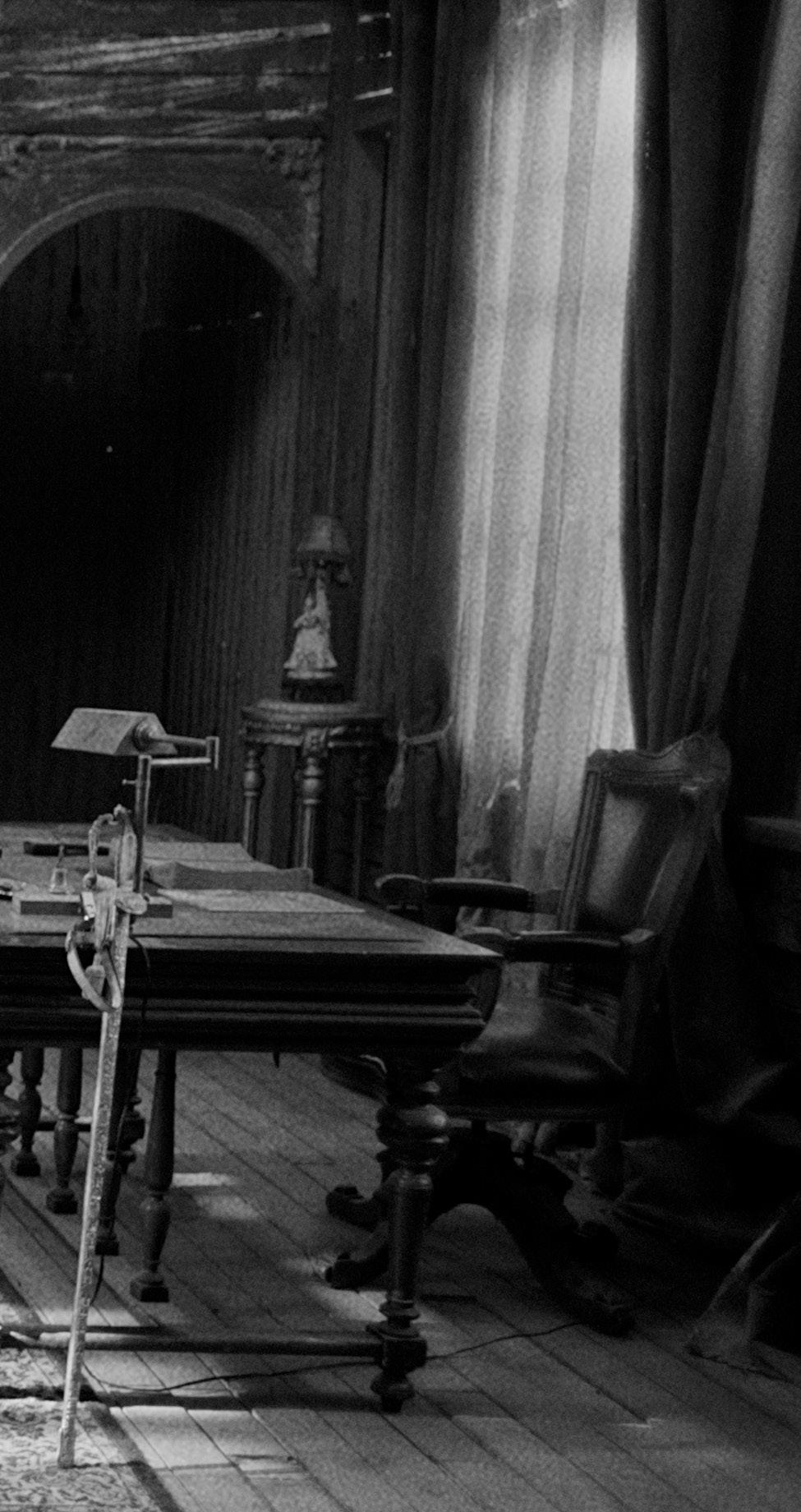
“I liked Pablo’s simple metaphor for this film, casting Pinochet as a vampire, an eternally dark and depraved figure, and the idea that evil feeds on itself like a vampire in order to exist.
“It presented a paradoxical opportunity for beauty in the image, without condoning or redeeming his murderous actions. I believe the film can expose his malevolence for us to exorcise, knowing we could have the same capabilities of being immoral, corrupt, and diabolical anywhere in the world.”
“From the inception of the film, Pablo had
“The flying scenes with the nun on El Conde were all shot in-camera off a 160-ft crane with the actress and an acrobatic stunt double. They were suspended in the air on wires on the crane with the camera operator following the action over the ranch on a suspended seat on the same crane.”

When it came to selecting the camera and lenses for the shoot, Lachman reveals he initially explored the possibility of shooting on B&W 35mm film, “but unfortunately, Kodak currently only makes Double-X which is rated at 250ASA for daylight and would have been too slow. Also, there were no operating film labs in Chile, so I started investigating digital options.
“I reached-out to my friend Marko Massinger,
Images: BTS photos by Diego Araya Corvalán. Images courtesy of Netflix.
CINEMATOGRAPHY WORLD SEPTEMBER/OCTOBER 2023 55 ED LACHMAN ASC•EL CONDE
I felt like Ansel Adams, placing my exposure to set the range of detail in the highlights and shadow areas
a German DP and image-scientist, who introduced me to ARRI’s head of camera rental, Manfred Jahr, and contacted Stefan Schenk, ARRI’s general manager, so see if they could develop an ARRI Mini LF with a B&W sensor. ARRI was releasing the new Alexa 35 camera, so I had my doubts if it could be done. But, to more than my surprise, ARRI got in touch with me ten days before principle photography and said they had a prototype, although I would have to evaluate the sensitivity of the camera myself.”
“In my tests, I discovered the Alexa Mini LF delivered lovely crisp blacks, and that all the pixels that go would normally go towards creating the colour were going into increased sensitivity. The camera was at least 3/4 of a stop faster that the regular colour Alexa Mini LF – 800ASA was really 1280 and 1280 was around 2000.

“This was a blessing as that extra speed gave me the ability to express the naturalism of the light sources, such as in our French Revolution scenes, and other low-light scenarios where I lit with candles and fire. We retained a colour Alexa Mini LF camera to film the greenscreen night scenes of Pinochet flying around the city.
“Pablo wanted to shoot pretty-much everything using a 15ft Technocrane, as that would help us find frames with great fluidity and help us move between different takes and set-
ups more efficiently. So these were other reason to shoot with the Monochromatic Alexa Mini LF because of the size and weight of the camera,” Lachman explains.
DPs love lenses, and Lachman is no exception. El Conde presented him with the opportunity to marry the Alexa Mini LF Monochrome camera with a set of vintage optics, the original Bausch & Lomb Baltar lenses which had been used in the 1940s on several Hollywood classics.
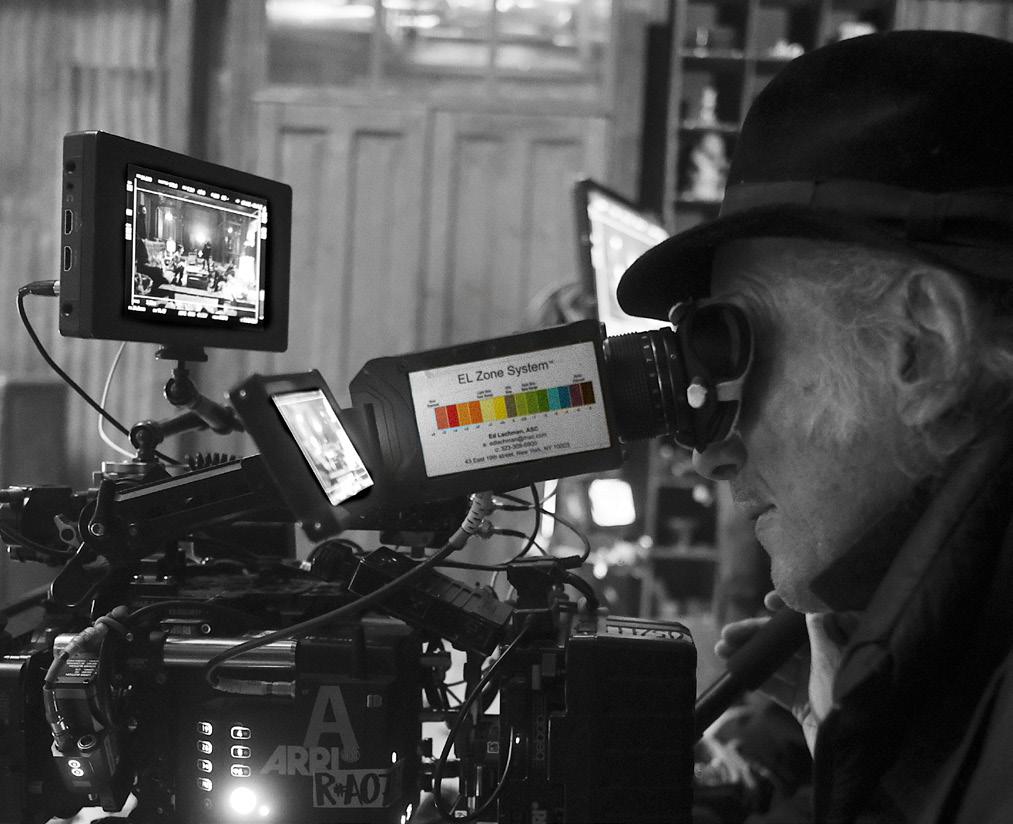
“I’m not talking about Super Baltars, which were created in the 1960s for reflex cameras and were totally different in design and coatings,” he enthuses, “but the original Baltars, developed in 1938 and used in primarily the 1940s and early 1950s, for rack-over (non-reflex) cameras, on B&W films.”
This vintage glass was legendarily used on The Magnificent Ambersons (1942, dirs. Orson Welles, Fred Fleck, Robert Wise, DP Stanley Cortez), parts of Citizen Kane (1941, dir. Orson Welles, DP Gregg Toland ASC), Touch Of Evil (1958, dir. Orson Welles, DP Russell Metty) and The Godfather (1972, dir. Francos Ford Coppola, DP Gordon Willis ASC).

“I became interested in the original Baltars several years before shooting El Conde, after Alex Nelson from Zerø Optik, a lens housing specialist in LA, first turned me on to them. So, I
had bought sets from vendors in the Far East and New York, and had Alex rehouse and reconfigure them to cover the sensor area on large format/ full frame digital camera sensors, which I call the ‘Ultra Baltars’.
“These Ultra Baltars really complimented the monochromatic Alexa Mini LF Monochrome that ARRI in Germany had supplied specially for us. They have a similar look to Cooke Speed Panchros in the sense that they have sharpness in the centre and beautiful fall-off on the edges, but the field curvature, single-layer coatings and handpolishing techniques deliver a different look.”
El Conde was framed in the 2:1 Univisium aspect ratio, pioneered and championed by Vittorio Storaro AIC ASC, principally for its rendering of faces/mid-shots with appropriate depth in the image.
Another element Lachman used was the EL Zone System (www.elzonesystem.com), which he developed and patented himself in 2021, to assist in the purpose of determining optimal zones of exposure from the camera’s sensor. The EL Zone System allowed Lachman to place his exposure values based on 18% grey with F-stops translated through the camera sensor, rather than IRE values which are incorrect linear units of measurement, and unlike logarithmic values that light meters and lenses are calibrated to. Hence, Lachman could
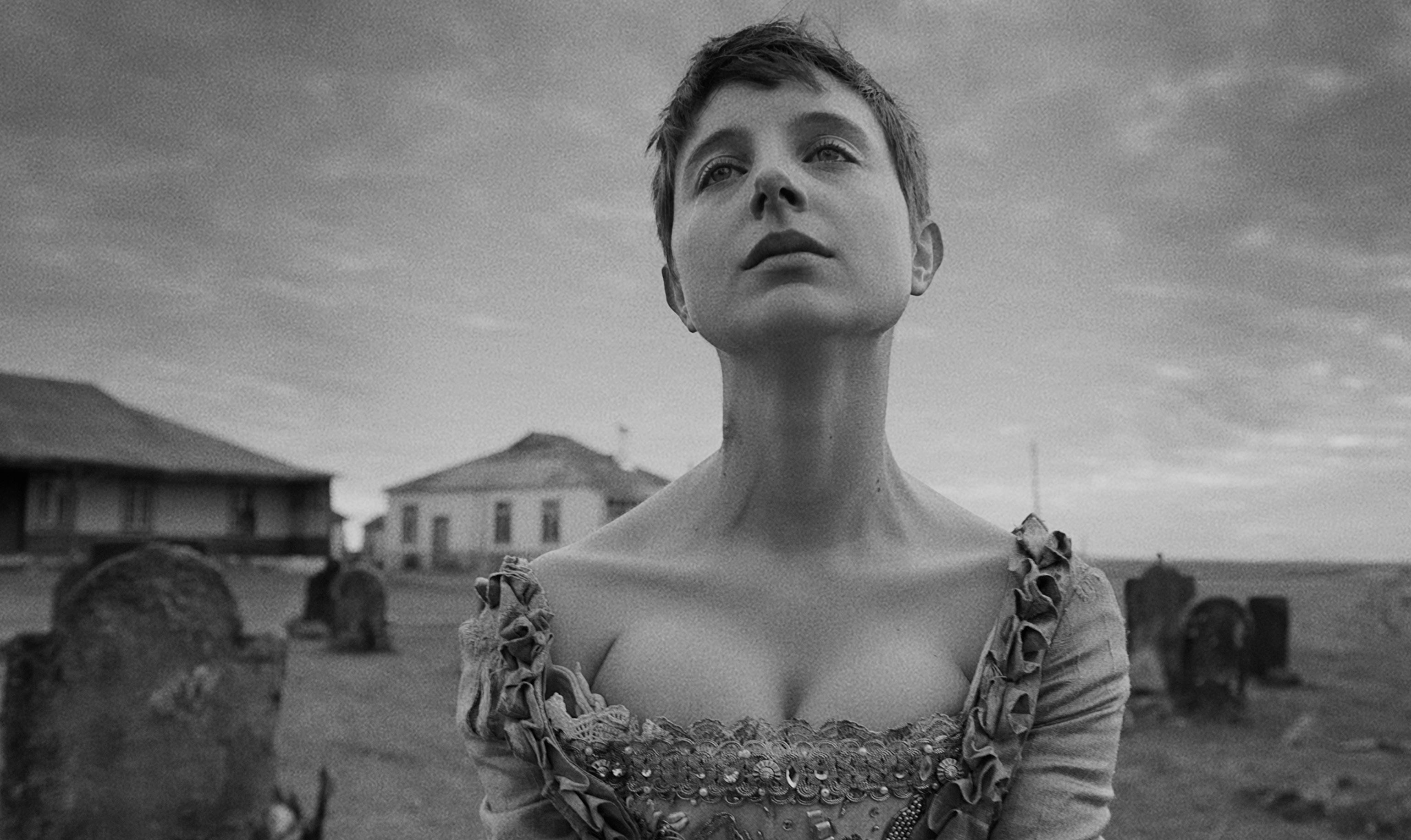
EL CONDE•ED LACHMAN ASC
56 SEPTEMBER/OCTOBER 2023 CINEMATOGRAPHY WORLD
Pablo is one of the most original and brilliant voices in Latin-American filmmaking
JOE
“I’m very fortunate to be a frequent collaborator with Ed Lachman. With each project, he aims to try something unique and push his images to new heights. It’s exciting to know that so many DPs from around the world will check out this film to see what Ed, one of the masters of cinematography, has done this time.
Ed always shoots a well-exposed image. But El Conde had the tightest continuity I have ever seen pre-grade. Using his EL Zone system allowed Ed to know where his exposure and contrast sat on every shot throughout the whole production. This paid out dividends during the colour finishing as little prebalancing was required before we addressed the more detailed nuances of the grade.
The well-balanced reels provided Ed, Pablo, and me with extra time to intricately refine every shot. We could craft custom vignettes to subtly darken the frame edges, track faces and eyeballs meticulously to enhance sharpness and exposure, and thereby establish a deeper connection with the actors.
Ed shot some breathtaking exteriors in the Patagonia region and was keen to push the contrast as much as possible in the skies. So, we spent a good amount of time creating a top-grad in Baselight to make the skies as graphic as possible, whilst holdingout actors faces and buildings that crossed into the sky correction.
Grading in Baselight, we employed the texture tools to soften the sharper frequencies present in the digital image, aiding in authentically capturing B&W period we aimed to emulate. The texture highlight tool in Baselight played a pivotal role as well by introducing a delicate glow around light sources and by mitigating any elements that felt too digital. Additionally, we integrated two custom Livegrain film grains into the visuals, invoking a more pronounced setting during the flashback sequences.”
use the camera monitor as a light meter or even his own meter on-set as if he were exposing on film.
“This was an important factor in controlling the imagery for the film, and we were the first theatrical feature to use it,” he says. “As a cinematographer, I felt like Ansel Adams, placing my exposure to set the range of detail in the highlights and shadow areas and define the latitude of the images. It also helped considerably when I came to do the final DI grade with my esteemed colourist, Joe Gawler, at Harbor Picture Company.” (See boxout)

effect the exposure in the room without having to use extensive windows and keys.”
During production, Lachman worked with a local crew in Chile that Larraín knew and trusted, who he says proved to be “reliable and supportive.” These included Daniel Miranda Bianchini on Steadicam, Jonathan Maldonado as focus puller, key grip Manfred Menzel, and Rodrigo Ramirez as gaffer.
“I went with Tungsten lighting, such as Molebeams, Fresnels and Parcans, because of the quality of the light and it was more cost-effective to deploy across several sets.
“In the interiors, the lighting was mostly motivated from the windows and practicals on-set, foregoing the more expressionistic lighting of the horror genre, which I think helped give a credibility to the world we created. The difficulty in shooting on the stage before shooting on the actual location is matching the consistency of the light.
Filming El Conde also allowed Lachman the opportunity to use his own set of vintage Harrison and Harrison black and white filters.
“I was able to variously work with yellow, orange and red filters to marry foreground flesh tones with backgrounds, or to enhance the contrast in the clouds and sky. When I was losing light at the end of the day, I had to forego using the filters because of the loss of stop with the filters,” he remarks.
“Of course, you can attempt to push the grade in post to extremes to get contrast in the skies to match, but I discovered that it presented a negative impact on the actors’ faces and bodies against the sky, producing an undesirable edge-glow. In this instance, I realised filming in B&W with filters can be a preferred method than trying to do everything in post-production for the desired effect.
“When it came to the final grade, Joe utilised his Baselight system on the Patagonian farmhouse location interiors to effectively pull-down extra brightness in the windows and not to adversely
“We had to shoot the interiors in Santiago months before the exteriors in Patagonia, which I knew would be during the winter and how radically the light could change throughout the day. Although I had this concern, I was always checking the weather in Patagonia and asking Pablo what time of the day the scene could be taking place. I think I ended up with the right decisions, but you can never totally be sure.”
“They say the eyes are the windows to the soul, and generally on most films I would try to help out the eyes of the characters with light. With this film, I purposefully allowed darkness around the eyes, as I thought this would reinforce the idea that these characters were hiding something from each other and from themselves.”
Lachman concludes, “Healing comes with justice, but Chileans were never able to take Pinochet to trial. Possibly we can’t change evil, corruption, or the misuse of power, but perhaps we can be helped to understand it.”
ED LACHMAN ASC•EL CONDE CINEMATOGRAPHY WORLD SEPTEMBER/OCTOBER 2023 57
I’d never shot a vampire movie, so I was really intrigued
GAWLER, SENIOR COLOURIST, HARBOR, NYC
SHADOWS AND SECRETS
By Darek Kuźma
The third instalment in Kenneth Branagh’s series of cinematic reinterpretations of Agatha Christie’s Hercule Poirot detective stories sees DP Haris Zambarloukos BSC GSC shifting gears.
While 2017’s Murder On The Orient Express and 2022’s Death On The Nile grew incrementally bigger in scope and style, were both captured on 65mm film to recreate the cinematic grandeur of the 1930s, and emphasised how the brilliant sleuth was in solving high-profile murder cases, this film is by far a much smaller and more intimate endeavour.

A Haunting In Venice is a digitally-shot, visually-rich character study rather than largeformat spectacle. The story, a variation on a lesserknown Christie novel, entitled ‘Hallowe’en Party’, sees Poirot, now retired in post-World War II Venice, reluctantly agreeing to help a friend to debunk a psychic who claims she can communicate with the dead. Everything indicates during a séance that the woman may not be a fraud… and then someone dies. Or, to be more precise, is murdered. But by whom?

The attraction to working on the film was a no-brainer for Zambarloukos who has been Branagh’s go-to collaborator since 2007s Sleuth, and whose many other films with the director include the BAFTA-winning, coming-of-age drama Belfast (2021). In 2017 they received Camerimage Cinematographer – Director Duo Award, and both saw the challenges of A Haunting In Venice as enticing.
“Genre-wise, it’s a supernatural mystery film, a rather big departure from our other films, but at the same time it’s a much simpler story touching on parenthood and the fragility of life,” says Zambarloukos. “It was certainly influenced by the experience we had on Belfast, which was more rewarding than anything else I’ve done with Ken. Much of the prep on this film was about combining the best elements of our epic adventure films with more personal projects. We both felt this sort of ‘in-between’ mode would serve A Haunting In Venice perfectly.”
As the majority of the film takes place in an old Venetian palazzo (created at Pinewood Studios, supplemented with some exteriors shot on location in Venice), which Poirot seals from the inside to find out what is going on, they agreed to remodel their approach.
“Kan and I contemplated shooting on 65mm film but I had many visual and technical concerns,” Zambarloukos recalls. “For one, I wanted it to be lit by candlelight as much as possible, as it was a prevalent lighting source in Venice at that time. To make that work on celluloid I would have had to resign from staying at the T4 range, which I like for portraiture reasons and to have both eyes in focus. And other things like that. So, I asked Ken to reconsider. Sony Venice 2 had just come out and it was exactly what I was looking for, both in aesthetic and technical terms.”
a light meter. A minor setback was that at T4 and ISO3200 the camera sees more than the human eye and we had to put safety lights on the set for cast and crew. But it worked. We also used smaller cameras like the compact, full-frame Sigma FP L for the more tricky shots.”
As they were working with a big ensemble cast, specific rules for camera movement were required to cover the actors playing-off one another, using their body language to reveal their characters’ true selves.
The choice of camera emboldened the director and DP to create a literally dark set to support the film’s morbid aura, which infuses the characters’ imagination to the point where they are not sure what they think they see is real or not.
“We were not afraid of going too dark to set the mood,” Zambarloukos explains. “I wanted details in the shadow, as it’s far scarier when you see shades of grey and brown, amber and terracotta, in the darkness.
“Sony Venice 2 is extremely accurate. It gave me exactly what I’d get if I walked around with
“We decided we would not move a camera unless it was attached to an actor, or was a handheld POV shot,” recalls Zambarloukos. “My key grip, Malcolm Huse, put together a clever system of GFM GF-Sliders, so that if an actor sat and rotated, the camera would rotate with them. Working with camera operator Luke Redgrave, we rigged sliders, body cams and dollies, we put a Sigma on a Ronin head, and we did high-angled shots on an Avenger Long John Silver light stand so as not to involve cranes and extra personnel. It was a very creative set, and everything was meticulously tested and supervised by my 1st AC and long-time collaborator Dean Thomson.”
A HAUNTING IN VENICE•HARIS ZAMBARLOUKOS BSC GSC
58 SEPTEMBER/OCTOBER 2023 CINEMATOGRAPHY WORLD
Know thyself, act in moderation, and the rest will come to you in one way or another
Zambarloukos adds, “SFX supervisor Dave Watkins and SFX technician Kevin Skehan provided flame bars, witches fingers, gas lights, rain/wind effects that added another dimension to the feel and reality of the film. Again, we looked back at Belfast, to the moment of the explosion that triggers off the story and makes the audience feel that they’re there.
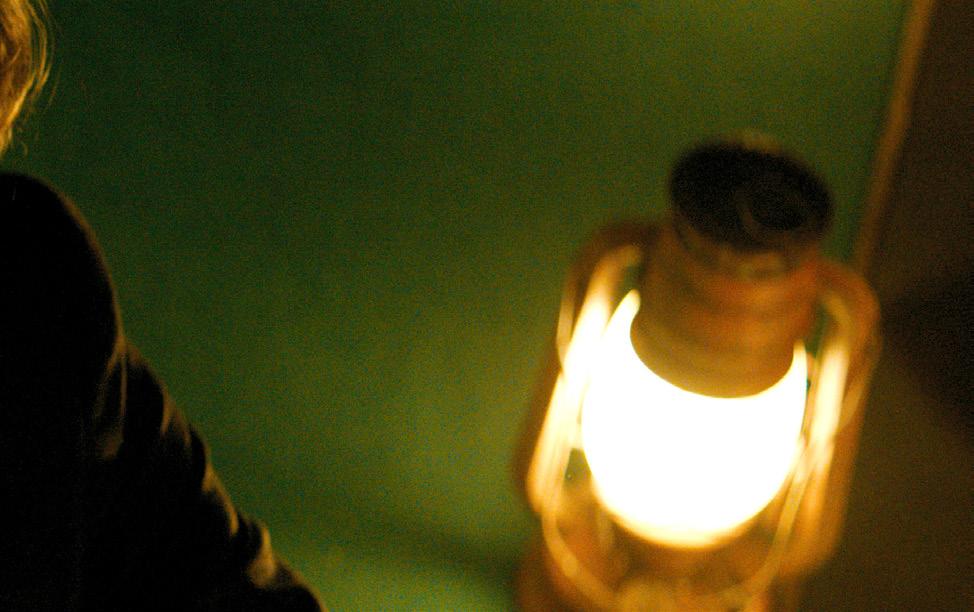
“Here we wanted the viewers feel threatened, scared or aware of acts of illusions by some of our characters. Everything to support the story. In my career, I always try to go by two things written above the entrance to the Sanctuary of Apollo at Delphi: ‘Know thyself’ and ‘All moderation is excellence’. This is exactly what you need on a film set: know the story, know yourself, and act in moderation. Then you see clearly what you want to achieve and how to achieve it.”
The principal photography on the film began at Pinewood on October 31st, 2022, before production wrapped in mid-January 2023,

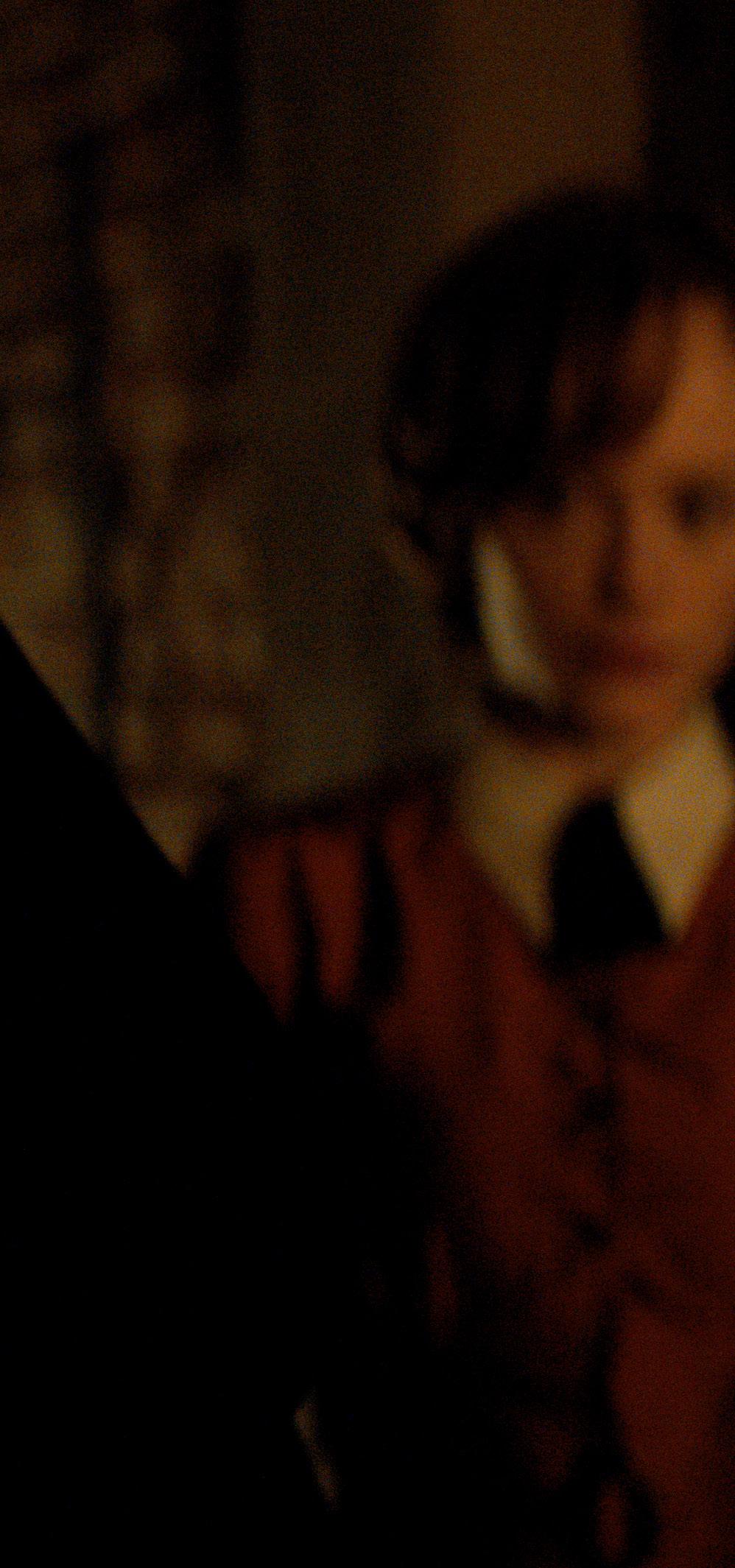
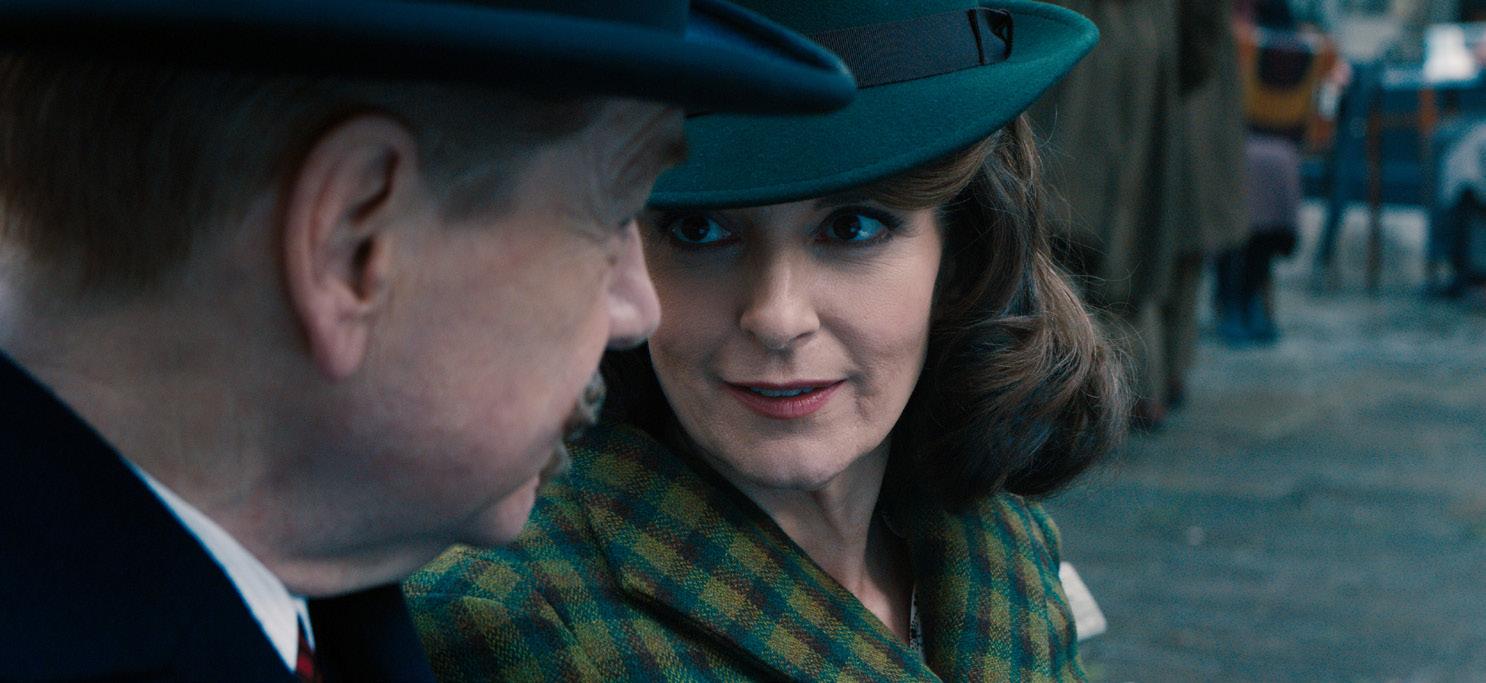

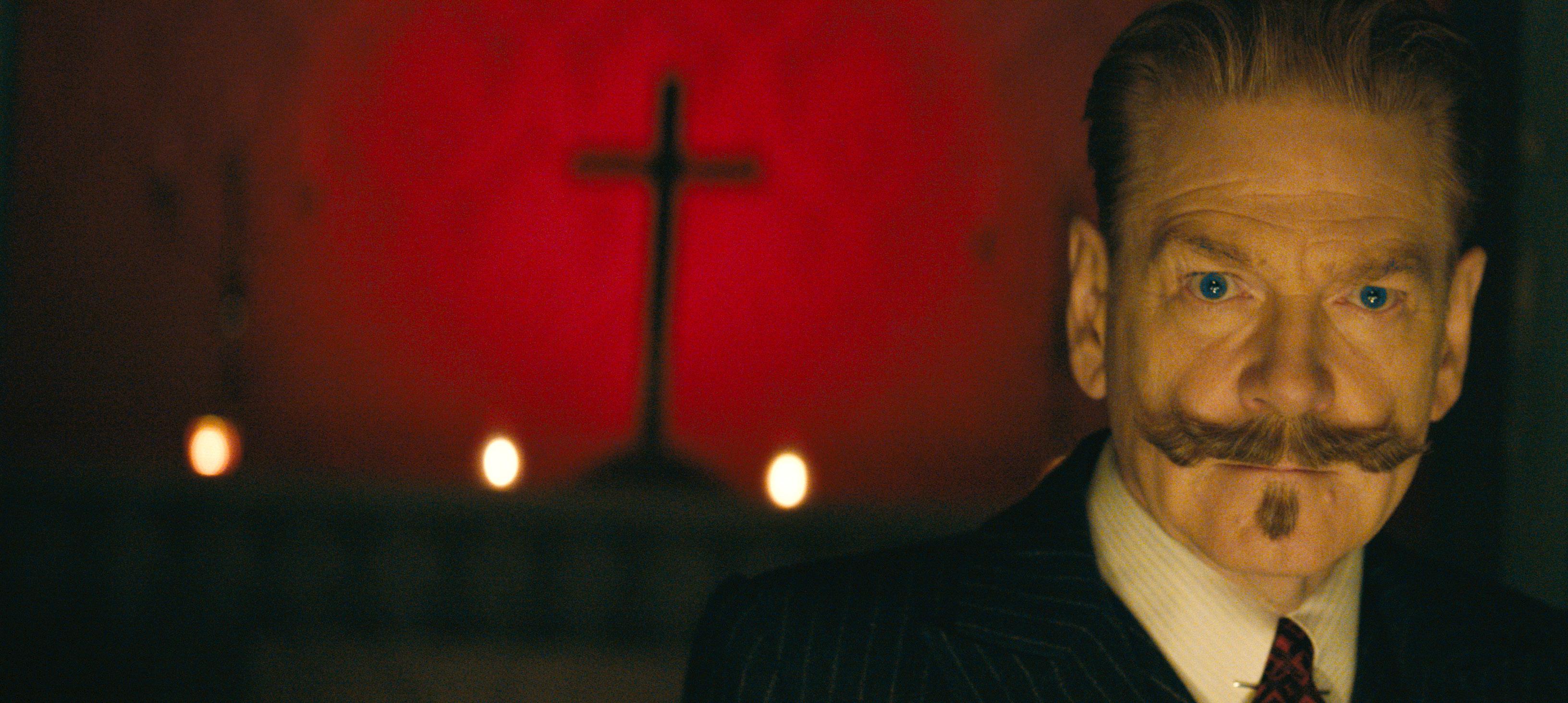
following an eight-day location shoot in Venice, including the Palladian Basilica, Palazzo Malipiero and the famous Piazza San Marco. One of the ways to blend the footage shot on location with that on the soundstage was the use of miniatures.
“We’ve found a perfect palazzo in Venice but its interior was too modern to turn it into a 1947 building, while certain exterior angles we needed were impossible to shoot on location,” reveals the DP. “To make our palazzo an additional character, we had José Granell from the Magic Camera Company painstakingly recreate parts of Venice – the boathouse, the canals, the gondolas – as a
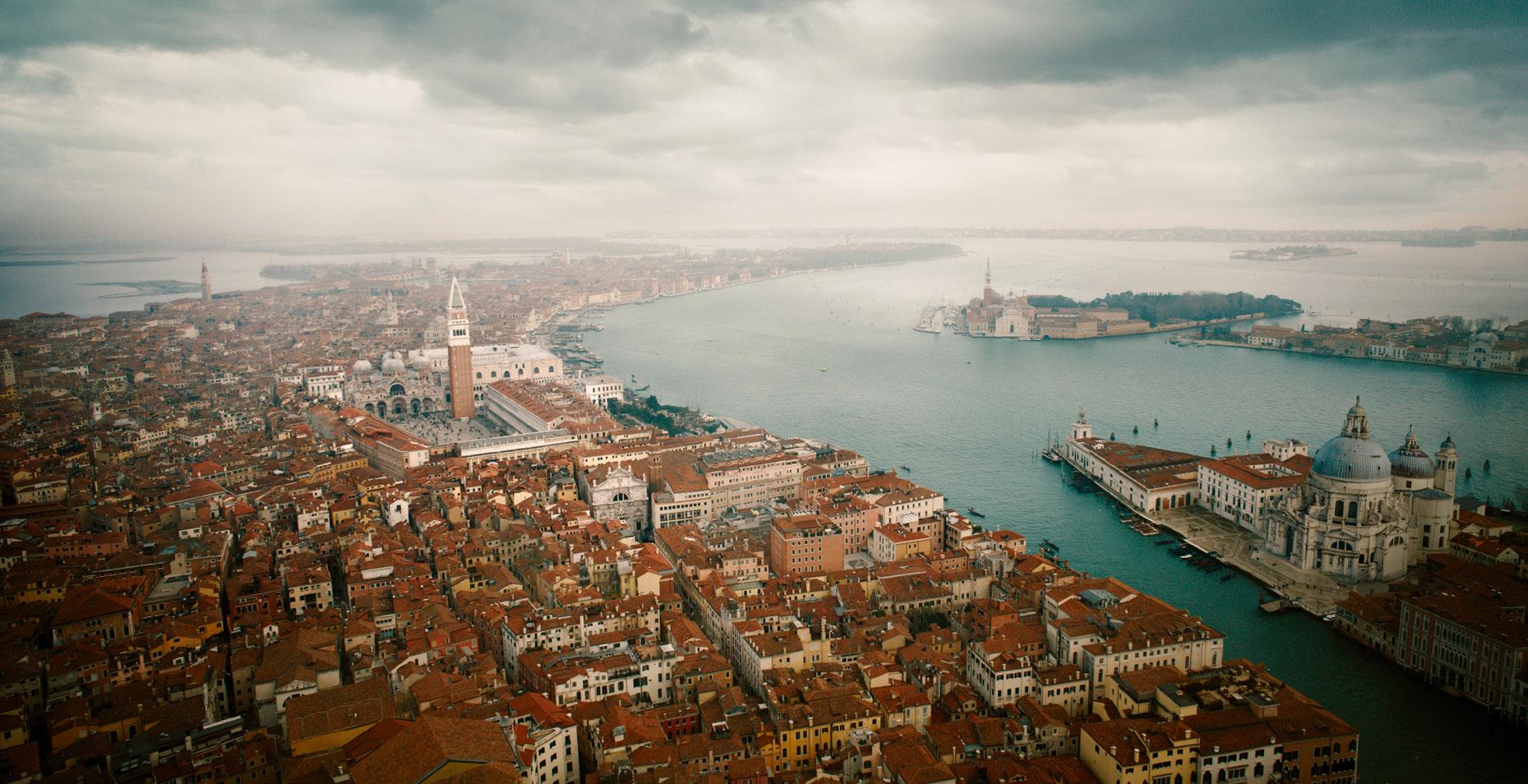
HAR IS ZAMBARLOUKOS BSC GSC•A HAUNTING IN VENICE
Images: Photos courtesy of 20th Century Studios. © 2023 20th Century Studios. All Rights Reserved.
CINEMATOGRAPHY WORLD SEPTEMBER/OCTOBER 2023 59
We were not afraid of going too dark to set the mood
1/3 miniature. That was a challenge because even the rain had to be a third smaller than normal, but it was worth the effort.”
Still, A Haunting In Venice is a detective story set in a bygone era, thus to preserve a classic feel of their other Agatha Christie films, Zambarloukos chose an impressive set of 65mm lenses.
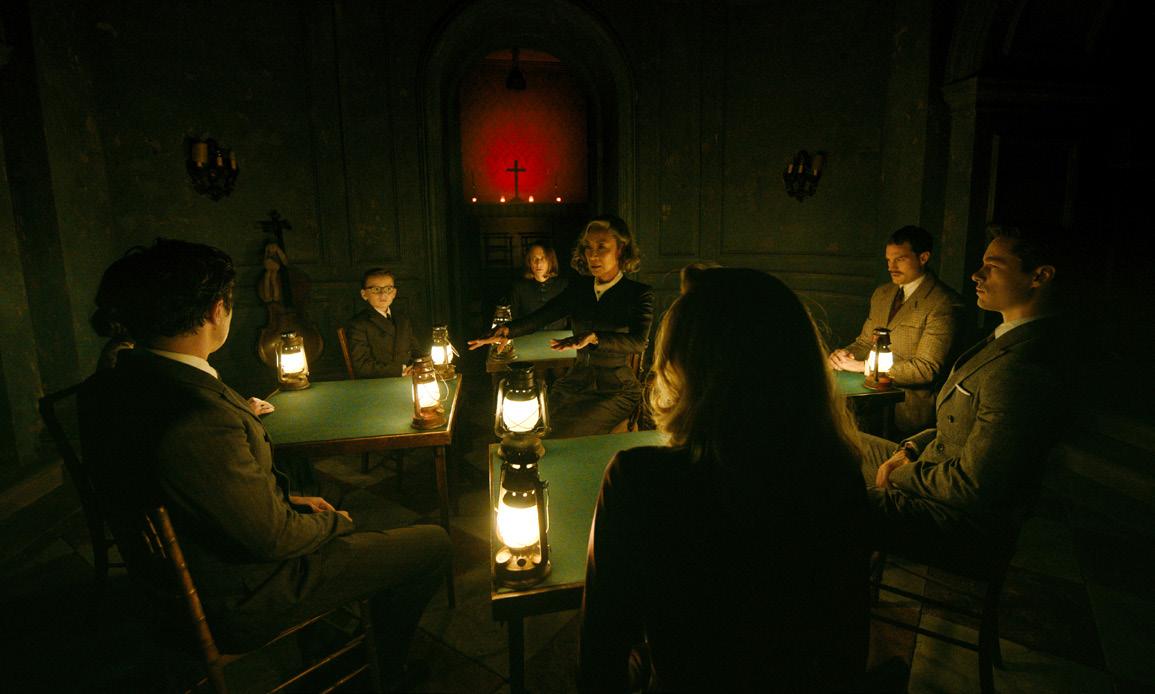

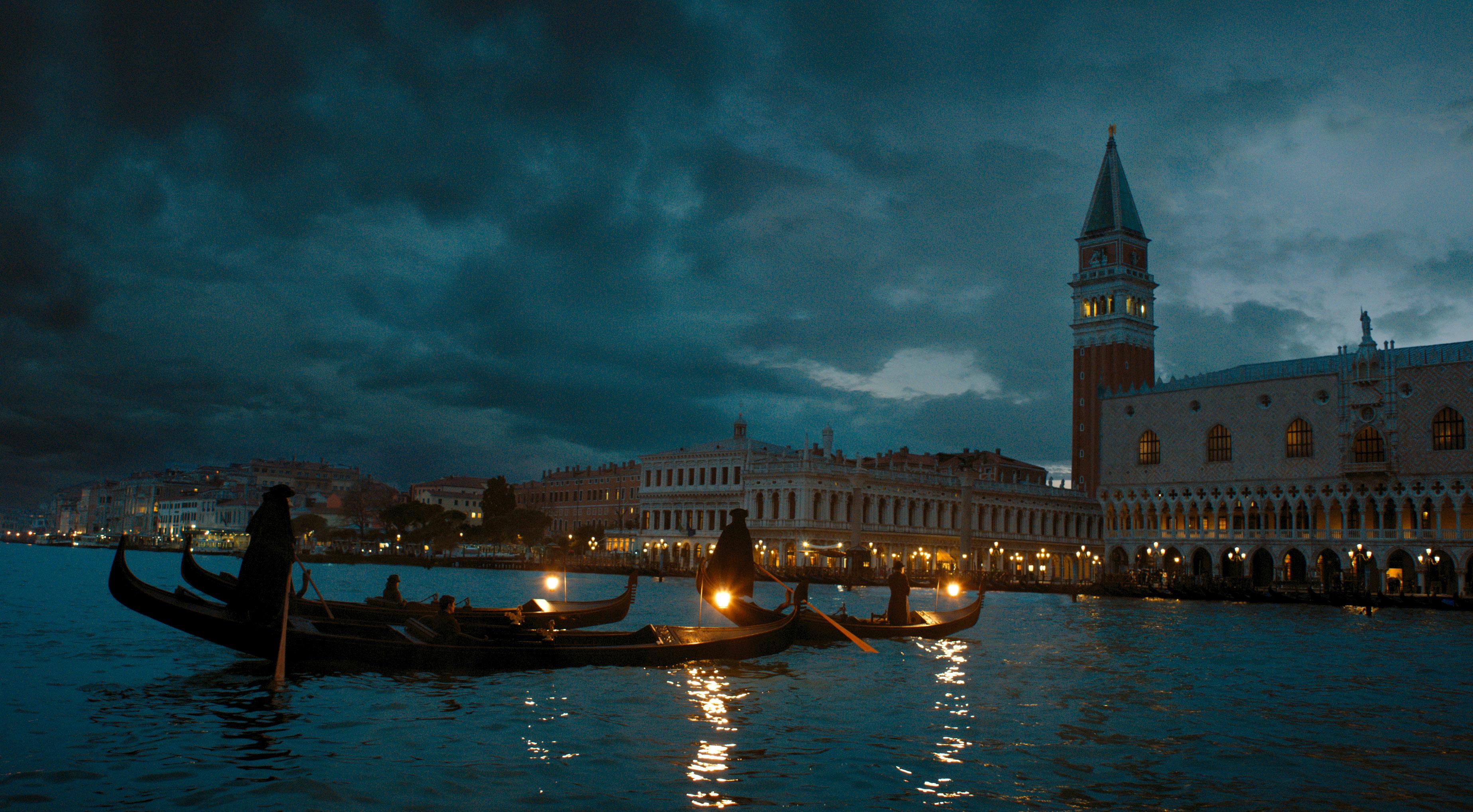
“I craved the Sony Venice 2 not only for its ISO3200 low-light solutions and other features, but also for the size of its sensor in relation to the Panavision Auto and Ultra Panatar optics, the ‘jewelin-the-crown’ lenses that have a 1.3x Anamorphic squeeze and were created for Ben-Hur (1959, dir. William Wyler, DP Rober L Sirtess ASC). They fit the Venice 2 like a glove and made our images heightened in this spectacularly filmic way.”
Zambarloukos supplemented Auto Panatars (35mm-400mm) and Ultra Panatars (35mm180mm) with spherical 14mm P70 and 24mm Sphero lenses, plus Sigma Contemporaries for the Sigma FP L shots. The package was provided by Panavision London.
The lenses influenced the way Zambarloukos framed and lit the film.

“I didn’t want to shoot in 2.40:1. We shot Belfast
in 1.85:1 and found the use of negative space really interesting. So, I thought it would be a neat idea to shoot the palazzo in 1.9:1 at 8K, with portraiture that was both spectacular and intimate on both the characters and the surroundings,” he recalls.
“Although we used candlelight extensively, we had a number of lamps, each on separate channels on a dimmer board. Practical electricians Joe McKee and Colin Field made an intricate practical set-up on-set, including a series of batteryoperated LED hurricane lamps that we could mixand-match with real candlelight and hide in corners to get the consistent light without the excessive flickering that was sometimes visible through the Venice 2 sensor.”
Zambarloukos and his long-time gaffer, Dan Lowe, accomplished the palazzo’s scary, suggestive ambience with the use of Light Synthesis Luxor light pods, Ayrton Domino moving lights, Pro Lights Sunblasts 3500 and Creamsource Vortex 8s, all picked for the quality of their light and because they are IP-rated as waterproof due to the water effects on-set. Around the camera they had Aladdins, Quasar Science tubes, Astera Titan tubes, Dedo 150Ws and Chinese lanterns.
“We also had a number of practical period lights to support the in-camera look, including theatrical lights and lamp fittings that went into a wall and went back to the DMX feed,” says Zambarloukos. The main lighting supplier was MBS Lighting at Pinewood, the Luxors were sub-hired in from Light Synthesis.
It should be obvious by now that Zambarloukos is proud with how A Haunting In Venice turned-out. The only thing missing from the experience was his relative absence from the DI, done by senior colourist Rob Pizzey at Goldcrest in London.

“I could only get there for few days because of my shooting schedule on Tim Burton’s Beetlejuice 2. Ken and I go way back with Rob, and we did a LUT with him for this film in prep. Rob knows my quirks, he understands Ken’s methods, and did a brilliant job with finessing the look we achieved in-camera, but not over-finessing it.
“I wish I had been available for the final DI, but this is precisely why I surround myself with a team of trusted collaborators who know what I’m aiming for. It’s really simple: know thyself, act in moderation, and the rest will come to you in one way or another.”
A HAUNTING IN VENICE•HARIS ZAMBARLOUKOS BSC GSC 60 SEPTEMBER/OCTOBER 2023 CINEMATOGRAPHY WORLD
TRANSFORMING MEDIA.CHANGING PERCEPTIONS.
REGISTER NOW AT SHOW.IBC.ORG #IBC2023

15-18 SEPTEMBER 2023
RAI AMSTERDAM
EMPOWERING CONTENT EVERYWHERE
HOPE SPRINGS
By Ron Prince
Shooting on Kodak 35mm film, DP Robbie Ryan ISC BSC helped to paint a picture of compassion for Ken Loach’s The Old Oak.


The acclaimed film, a co-production between the UK, France and Belgium, had its world premiere at the 2023 Cannes Film festival, in-competition for the Palme d’Or, and is thought to be the veteran director’s final feature production.

The narrative follows TJ Bannatyne, landlord of The Old Oak pub, in a once thriving mining community in County Durham, in the Northeast of England. Pit closures have made things a struggle for the local community, and property values in the neighbourhood have plummeted. TJ barely scrapes a living, serving pints of ale, and trying to keep the dilapidated establishment open as the one remaining public space where people can meet.
Tensions rise when Syrian refugees are placed in the town by the local authority, and heighten even further after TJ strikes-up a friendship with Yara, one of the refugees who documents their arrival using a camera. Things become especially fraught when TJ and Yara encourage the immigrants to share community dinners together in a backroom of the pub that was once used for wedding receptions, but which has been shut-up for many years. Inside that room the walls are bedecked
with B&W photos of the local community, especially atmospheric shots during the 1984-85 miners’ strikes.
The film stars Dave Turner as TJ Ballantyne, and Ebla Mari as Yara, along with many first-time performers and non-professional actors in front of the camera, including refugees. The script was written by Paul Laverty, and the movie was produced Rebecca O’Brien, both longtime collaborators of Loach.
“I have to say that Ken and his writer, Paul are razor-sharp when it comes to examining socialpolitical themes of the day,” says Ryan, for whom the film represents his fifth feature collaboration with Loach, following the 35mm-originated productions of The Angel’s Share (2012), Jimmy’s Hall (2014) and I, Daniel Blake (2016), plus Sorry We Missed You (2019), which was captured on 16mm film. Ryan is also a frequent collaborator on director Andrea Arnold’s films, such as Fish Tank (2009) and Red Road (2006), was Oscar and BAFTA-nominated for Yorgos Lamthimos’ The Favourite (2018), and was the DP on the Greek filmmaker’s Poor Things (2023). All of these films were also shot on analogue film.

“We know that there are many issues in the world, but it’s always an education to work on Ken and Paul’s films and really focus yourself more sharply on those situations. With I, Daniel Blake it was austerity and the crumbling British welfare system. Sorry We Missed You looked at enslavement in the gig economy. Now, in The Old Oak, it’s the issue of immigration.
“What I loved about the script, is how the white
working class and the refugees are treated sympathetically, how they are essentially both the wretched casualties of economic forces and geopolitical troubles, bundled together in the same place, yet with TJ and Yara as the leaders for empathy, compassion, and quite possibly, hope.”
And with that in mind, Ryan adopted an observational approach to the camerawork, that
typifies most of the films he has collaborated on with Loach.
“Ken likes the camera and the crew to be low-key so that the actors, and non-actors, all feel comfortable to give their best, which they very much did,” Ryan remarks. “Also, he is very good about the placement of the camera, and the framing, as he always has his mind on how shots will cut together later.
“There were no handheld/Steadicam shots, the camera was on sticks with pans used to give a sense of movement, especially in lengthy scenes with multiple characters, when we also had a B-camera in operation.”
Production on The Old Oak took place over six weeks during June and July 2002, at locations in County Durham, including the former mining towns of Murton, Horden and Easington, and at Durham Cathedral. The pub in Murton that features in the film was a disused pub previously known as The Victoria. Of note, both Loach, now 87, and Ryan had their birthdays during the shoot.
Ryan says he didn’t reference other feature films for the production, but did immerse himself the “wonderously-observational” stills work of photographer Chris Killip, and his landmark books ‘In Flagrante’, ‘Seacoal’ and ‘Skinningrove’, collections of documentary photographs made in the North East of England during the 1970s and early 1980s, which feature the miners strikes in the 1984-1985.
Ryan framed in 1.85:1 aspect ratio and selected
THE OLD OAK•ROBBIE RYAN ISC BSC
62 SEPTEMBER/OCTOBER 2023 CINEMATOGRAPHY WORLD
If you want a filmic result, it’s much easier to start with film
“The ARRI cameras and lenses make for a lovely and very honest combination when shooting on film,” he says. “For this production, we shot on the longer end of the focal ranges, from 50mm up to 135mm.” The camera package was supplied by TSF Film in Belgium.


Being highly-aware of Loach’s preference for shooting in available light, and a naturalistic-looking result, Ryan selected Kodak Vision 3 500T (5219) for the production’s night-time exterior/low-light interior sequences, Kodak Vision 3 250D (5207) for brighter day interiors, and Kodak Vision 3 50D (5203) for the day exteriors. Film processing was done by Kodak Film Lab at Pinewood Studios.
“I have had the good fortune to have shot a lot of films on film over the last 20 years, and I still love shooting on 35mm,” Ryan remarks. “I’ve said it before, and I’ll say it again, if you want a filmic result it’s much easier to start with film, and it is always the first and only choice for Ken.
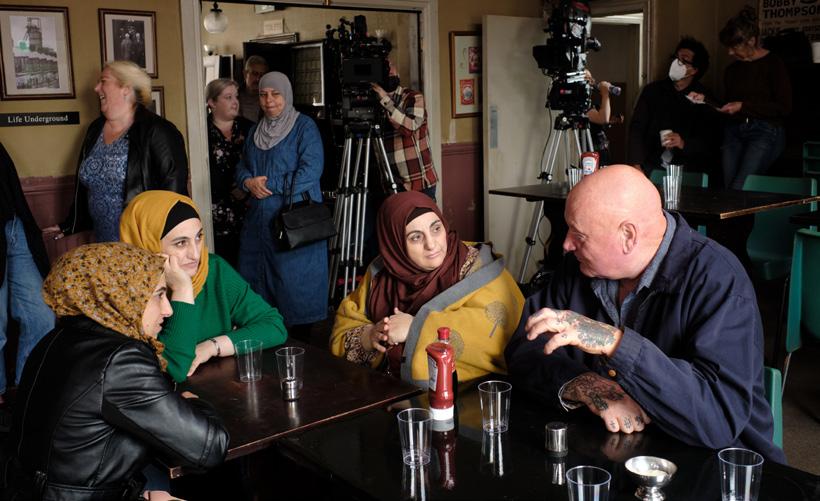
“With digital you to have to try to create the ‘filmic look’, through things like exposure, LUTs, and lighting, but the default setting of film is a ‘filmic look’. It always looks great, straight out of the lab. The way it handles skin tones, details in the highlights, and balances colour and contrast, is beautiful and honest, and you can certainly feel that in the The Old Oak.”
Ryan operated the camera during the shoot,
assisted by 1st AC Olga Abramson, with Tom Gineyts working as the 2nd AC, Alexandre Cabanne as the clapper/loader, and Florence Gilbertson as camera trainee. Matt Fisher operated B-camera, and Laurent Van Eijs was the gaffer.
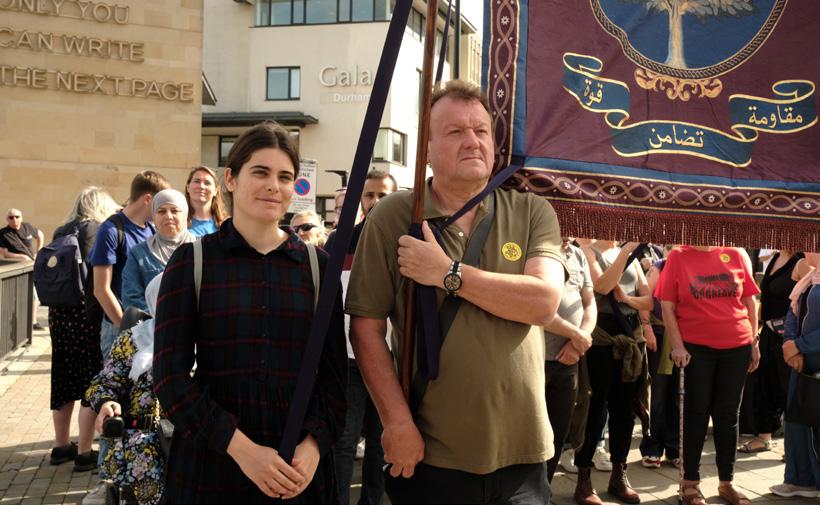
“Ken is always well-prepared. He knows what he wants to do, and how to achieve it,” Ryan notes. “And that’s especially true when it comes to the locations
and where he wants the camera in relation to the sun, because he hates front light and loves natural light, especially backlight. He gets the fear if he sees a lighting stand on the set, that’s game over for him.
“Thankfully, he has absolutely no problem with lights that are off the floor and out of shot, in the ceiling. So when we shot the interiors at the pub, I was able to secrete a bank of DMG SL1s above the actors, and push light through the widows using HMIs from outside. The S1s have a slim-profile, and are less bulky and obvious that fixtures like ARRI Sky Panels, and the full-spectrum of colour rendering looks fantastic on skin tones.

“When we did the recce of Durham Cathedral, of course we had glorious sunlight coming through the stained-glass windows, but, of course, the day we shot the sky was really overcast and the place was almost pitch black. Thankfully, Ken was very gracious and he let me have a few lighting stands that day.”
Looking back on his experience of shooting The Old Oak, possibly Loach’s last feature, Ryan says, “I felt honoured to get the shout once again from Ken and to work with the same, great supportive production team, around the same great part of the North East. He’s a true gentleman, he always engenders a lot of levity on-set, so it’s fun to be there. But crucially, he has been portraying important stories on film for over 50 years, and if he does decide to make another film, I would be there like a shot.”

CINEMATOGRAPHY WORLD SEPTEMBER/OCTOBER 2023 63 ROBBIE RYAN ISC BSC•THE OLD OAK
Ken likes the camera and the crew to be low-key
Images: BTS photos by Joss Barratt. Courtesy of Sixteen Films.
an ARRI 35mm ST as the main camera, with an ARRI 35mm LT as a back-up/B-camera, both fitted with ARRI Master Prime lenses, the same combination he used on I, Daniel Blake
PASSAGES•JOSÉE DESHAIES
LOVE TRIANGLE
By Ron Prince
Set in Paris, director Ira Sach’s latest feature, Passages, considers the torment people can exact on others, whilst they’re far more focussed on fulfilling their own needs and desires.
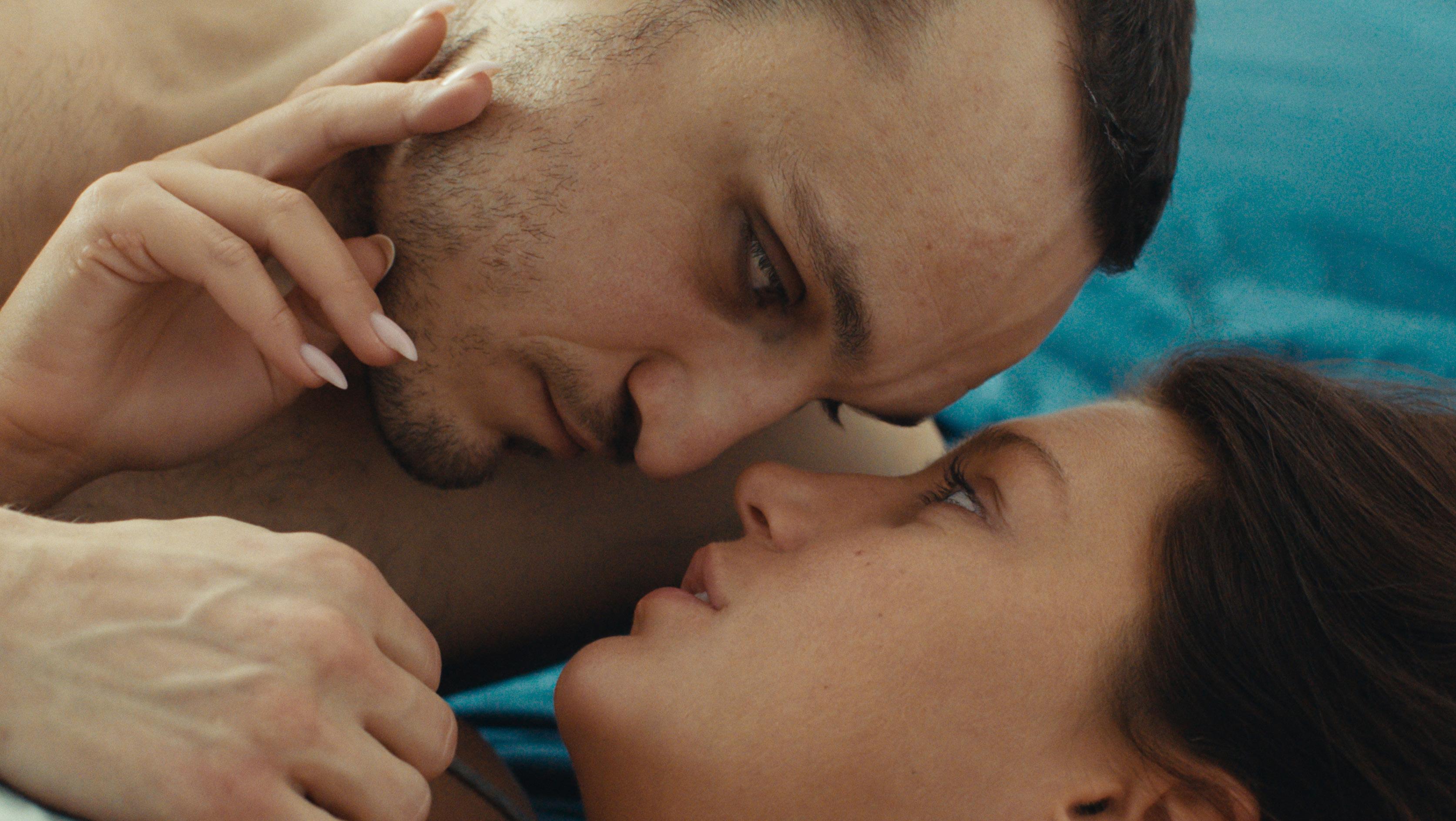
Tomas (Franz Rogowsji) is a mercurial and techy auteur director, married to reticent artist Martin (Ben Wishaw). During the wrap party for his latest film, entitled ‘Passages’, Tomas meets Agathe (Adèle Exarchopoulos), a young and attractive teacher, and later they have sex at her apartment. Martin falls into despair when Tomas tells him about this encounter, and despite a reconciliation that sees uncompromisingly explicit sex, we are left questioning whether Tomas still loves Martin? Or does he see a future with Agathe? Or, is Tomas just a manipulative narcissist, who thinks he can navigate the love triangle to his own benefit?
The film received glowing reviews after its world premiere at the 2023 Sundance Film Festival, including acclaim for the deft cinematography of French-Canadian DP Josée Deshaies. Principle photography on Passages took place at multiple neighbourhoods around Paris, over the course of 23 days, during October and November 2021.
Deshaies is known for her frequent collaborations with filmmaker Betrand Bonello, and has been nominated twice for the prestigious César Award for Best Cinematography on the director’s House Of Tolerance (2011) and Saint Laurent (2014). She also shot Bonnello’s La B ête, which premiered to positive reviews at the 2023 Venice Film Festival.
“I had never worked with Ira before, but was aware of his films, such as Frankie (2019, DP Rui Poças),” says Deshaies who lives and works between Montreal and Paris. “But to my complete surprise, he had a much better idea of the films that I had shot, such as Avant Que J’Oublie (Before I
Forget ) (2007, dir. Jacques Nolot), which he told me he liked for its ‘fake’ simplicity – it looks very simple to do, but it’s actually very articulated.

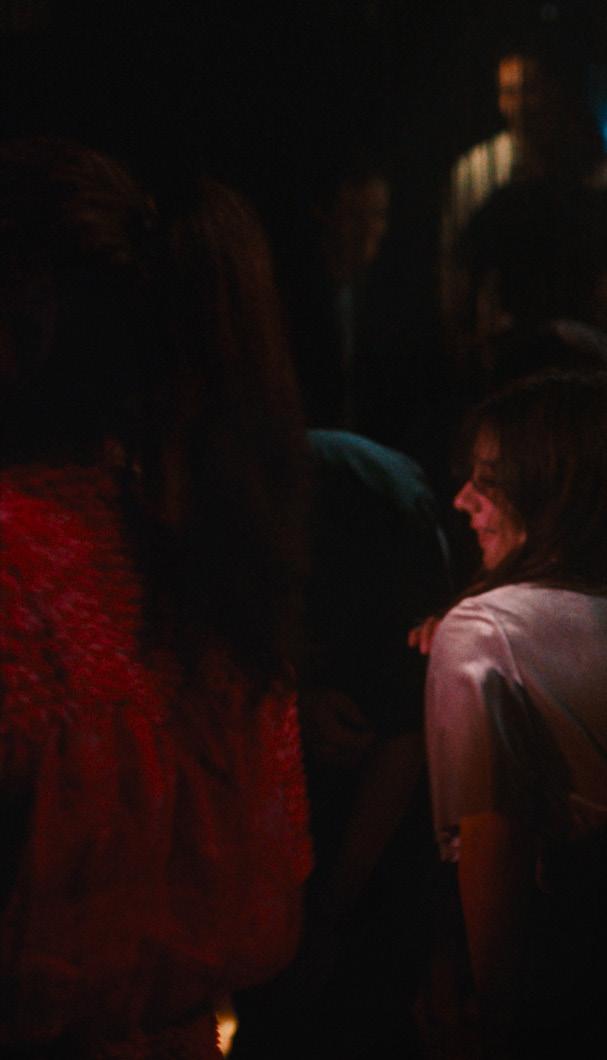
“When we met on Zoom for the first time, I was even more surprised when Ira showed me a file of curated screenshots he had assembled from many of my other films. He had really done his homework about me before calling. We didn’t talk about lighting at that point, we really talked about framing. I think he liked my framing.
Ira’s script had many subtle layers
“For my part, I thought Ira’s script had many subtle layers – about day-to-day life, about desire, about the choice of whether to say ‘yes’ or ‘no’, and the emotional consequences of making those decisions – all of which we can all easily relate to.”
Recalling her conversations with Sachs about the look-and-feel of the film, Deshaies says, “There were two main things we considered, which are both connected. The first was about depicting ‘reality’ versus what you would call ‘naturalism’. French cinema is a lot about naturalism, which for me is not realism. Realism is not so pretty or rounded, it’s more harsh and truthful.
“The second thing is that we were foreigners coming to shoot in Paris. It’s a wonderful city, but we didn’t want to make it into a picture postcard. Our story was set in ‘alt-Paris’, not pretty, but not banal either, just everyday Paris.”
For several weeks before production commenced, Deshaies says she and Sachs began a long process of creating a storyboard for the entire film, with illustrator Gabriel Germain, the brother of production manager Marianne Germain, who helped to translate their conversations into pictorial images.
“The three of us took turns to draw and re-draw scenes from the script, after closely studying a number of films that Ira thought were important to our visual strategy,” she remarks.
“These references included Maurice Pialat’s Graduate First and The Mouth Agape, Jean Eustache’s The Mother And The Whore, Jean Luc Godard’s Passion, Frank Riploh’s Taxi Zum Klo, Pasolini’s Teorema, and, to my further surprise, Jacques Nolot’s Avant Que J’Oublie (Before I Forget ), which I had shot!
“I had not really been involved in a process like that before, but it was creative and enjoyable. I translated those storyboarded images into camera placements, and from my diagrams Ira then created a shot list. Working in this way we moved from the abstract to the real, in a nicely-relaxed way, that also included some very good food.
Dehaise adds, “To me cinematography is all about the physics and the quality of the light, the optics you choose and where you put the camera. It’s not intellectual, but based on concrete. As Ira does
64 SEPTEMBER/OCTOBER 2023 CINEMATOGRAPHY WORLD
not rehearse with the actors in advance of the shoot, this process gave me solid ground to feel confident.
“I also learned early-on that Ira does not like to move the camera unless it absolutely needs to, so many scenes would be captured in a single shot, with the camera barely moving. Whilst that might sound simple, it forces you to make strong and decisive choices, which was quite a challenge.”
Deshaies said she would, if she could, have loved to have captured the story, on film but the budget of under $2million would not stretch to that.
“When I am unable to shoot on film, I always shoot on the ARRI Alexa,” she says. “I went with the ARRI Alexa Mini on this production as I needed a camera package that, when you don’t overaccessorise it, is small enough to work with in tight spaces, and I knew we would often be in corners or tight-up against solid walls.

“I know the Alexa Mini very well, it’s my favourite digital camera, mainly because of the lovely images it produces. We shot at 2.8K ARRIRAW, rated at 800ASA, but I had no problem going to 1280 or 1600ASA and the results looked perfectly fine.
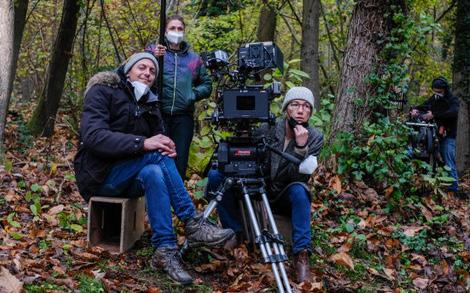
“I selected Leitz Summilux-C lenses, as they are fast and compact in size. In terms of the look, they’re not overly precise, like Master Primes can be when paired with a digital sensor, and they’re not warm either, perhaps like Cooke lenses can be.
“The Summilux-Cs are just straight and real, especially the mid-range 40mm and 50mm lengths that Ira and I both liked, because the images are like what you see with your own eyes. Colours and skin tones retain their natural look-and-feel – they are
human but without looking too sharp or too flat.”
Deshaies adds Sachs did not want a widescreen experience, nor a boxed-in 4:3 frame, and preferred the more rectangular 1.66:1 format that became dominant in European cinema during the 1970s and ‘80s, and has been used on countless indie features and documentaries ever since.

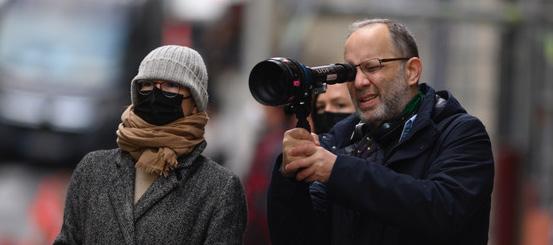

explicit lovemaking scenes. Deshaies says she was not aware of an intimacy co-ordinator being employed on the shoot, but was conscious that the relationship Sachs had with the actors was based on trust and that the performances came with boundaries everyone felt comfortable with. Deahaies operated the camera, and particularly enjoyed her collaboration with her longtime gaffer, Marianne Lamour, in keeping the lighting real and truthful, rather than naturalistic.
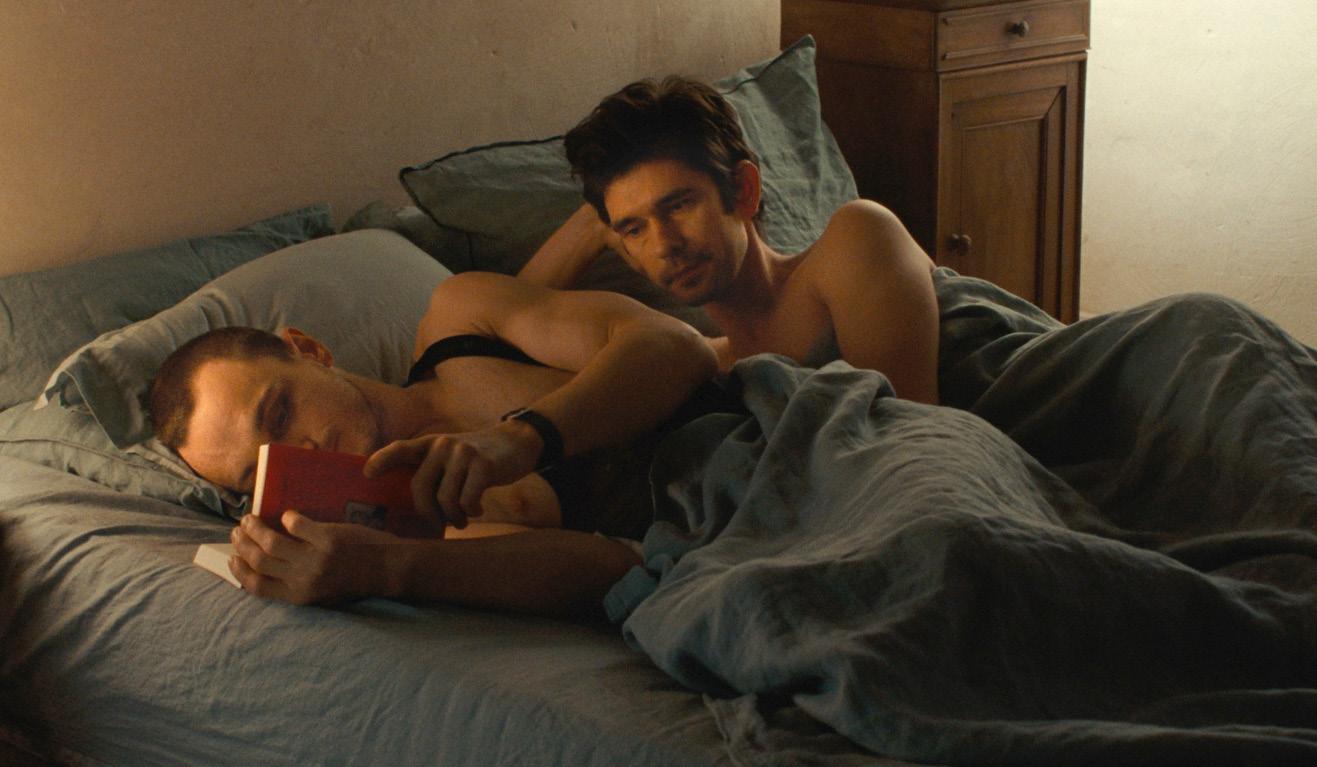
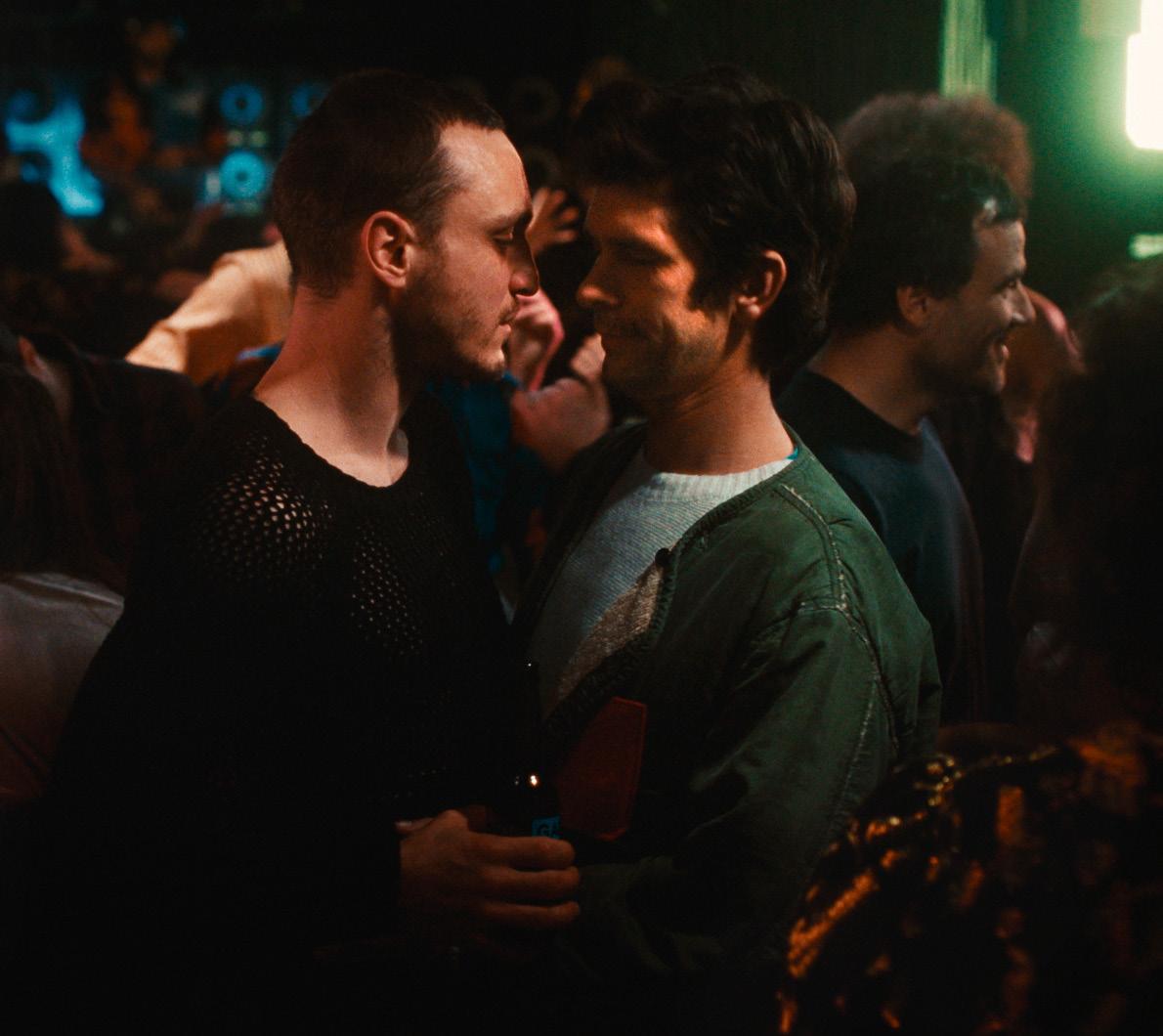
“I have a background in art history, and find naturalism in paintings really quite boring. I much prefer the boldness of expressionism or realism when it comes to lighting” says Deshaies. “LEDs are getting better, but I don’t believe they yet give an adequate quality of light, especially on skin tones. LEDs are expensive too, and I had to bear the budget in-mind.
“1.66:1 is a golden ratio that has a kind of intangible magic for framing two characters really well. It is also very beautiful for mid-shots and allows all sorts of lovely compositions which really suited this production,” she says.


During prep, Deshaies made a small selection of show-LUTs with colourist Yov Moor, who had previously graded Sach’s movie Frankie. She stresses that whilst these LUTs were finessed to optimise the colour of the costumes, set decorations and skin tones, they there were by no means the definitive look of the final movie, rather more a signal of intent.
Of course, the film contains extended and
“So with Marianne’s help I went old-school, and lit Passages with Tungsten fixtures, such as blondes and Fresnels, as well as HMIs, and worked with a lot of bounced light. These traditional lights are big, bulky and not easy to manoeuvre around a location, but I still prefer the results they give.”
Recollecting her experience of shooting Passages, Deshaies remarks, “I loved working with Ira. He created a family atmosphere amongst crew and the cast that focussed our energies together, and you can really see and feel that on the screen.”

CINEMATOGRAPHY WORLD SEPTEMBER/OCTOBER 2023 65 JOSÉE DESHAIES•PASSAGES
Images: Courtesy of SBS Productions.
1.66:1 is a golden ratio that has a kind of intangible magic
© Guy Ferrandis © Lola Pion
© Lola Pion © Lola Pion
PSYCHO DRAMA
By Oliver Webb
Justine Triet’s Palme d’Or winning film, Anatomy Of A Fall, explores the dynamic between Sandra (Sandra Hüller), a German writer and her blind, 11-year-old, son Daniel (Milo Machado Graner), when she is accused of murdering her French husband who is found dead in the snow below their chalet in a remote town in the French Alps. The haunting and critically-acclaimed production marks Triet’s third collaboration with DP Simon Beaufils AFC, the duo having previously collaborated on In Bed With Victoria (2016) and Sibyl (2019).
After graduating from La Fémis filmschool in Paris, Beaufils worked on numerous short films and features before being introduced to Triet in Paris shortly after she had completed her first film. Triet is a graduate from the Paris National School Of Fine Arts.
“Justine called me for a meeting and I wasn’t sure why, because her film was very different from what I’d done previously – there was lots of shaky, handheld camerawork,” recalls Beaufils. “We talked for a while and she told me that she wanted to do everything differently from her first movie. She said that she was not able to watch it anymore and wanted to change and to find a new way to work.
“With each film we have made together it was the same kind of idea,” he continues. “Justine doesn’t want to do the same style of film again – she likes to change and try new things. She wants to go where it is not so natural to go for her, and likes to go where she is frightened to go.
“For example, for her previous movie, Sibyl she was really frightened to shoot outside. The film takes place on the Italian island of Stromboli, so we were outside for a large part of the shoot, and that was a hard change.
“But she wants to grow, to become fierce. So, for each movie, we begin from zero and construct everything from scratch, which is a really nice way to work. Justine is very vocal and most of the time she knows precisely
what she doesn’t want. So we have to find what she wants at the beginning of the discussion. This means we work and talk together a lot during pre-production.”
The prep for Anatomy Of A Fall lasted for around six weeks before technical prep commenced, with discussions revolving around how they planned to shoot the film, especially the dialogue scenes and the cinematic portrayal of each actor in the film.
“On Justine’s previous movie she wanted more classical cinematography and mise-en-scène,” observes Beaufils. “But on this production, she wanted to be freer on-set and to put real life into the imagery. She wanted to allow for freedom of movement, and to shoot long sequences without cutting, but for the audience to be really close to the actors.
“So we spoke about moving the camera around without any cutting – and without lighting or sound in the frame too. We did some tests with a little crane and the camera handheld, and moved around the house and the courtyard, staying close to the actors. With this method, we could move quickly, shoot from all angles, break the rules and capture accidents, and Justine found this worked well for her. We wanted things to be a little messy and inventive so as to give the actors liberty, to let them go where they wanted to go and with the camera following them. We also needed the continuity in the mess. It was a mixture of many things,” Beaufils details.
In terms of visual references, Triet and Beaufils aimed to emulate the colours of American films from the 1970s, and looked at the works of John Cassavetes, Robert Altman, Sidney Lumet amongst others.
“Lumet was an important reference, especially The Offence (1973, DP Gerry Fisher BSC), for its harshness of tone, mise-en-scène, cinematography and the way Lumet influenced the ambience.” notes Beaufils. “Cassavetes’ A Woman Under The Influence (1974, DPs Mitch Breit/ Al Ruban) was also really important for the liberty of filmmaking – a mix between very precise, staged shots and others that seem to be improvised. We saw many
films together and Justine sent me frames of films and series that she has seen, which even included Colombo with Peter Falk.”
Beaufils opted to shoot the film with an ARRI Alexa Mini LF, using a combination of Hawk V-Lite series Anamorphic lenses and an Angénieux Optimo 24290mm zoom, provided by TSF. Agathe Dercourt was 1st AC on the film, with Rémi Quilichini working as Steadicam operator.
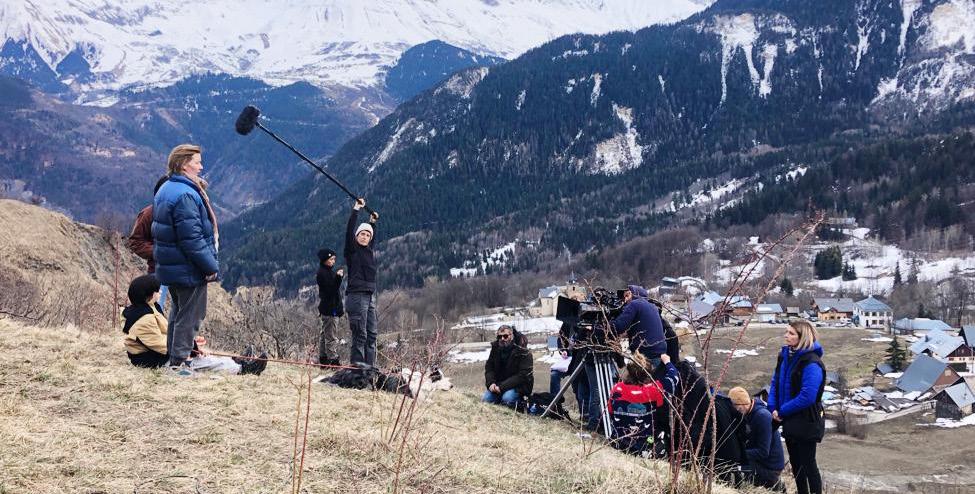

“Initially, we thought it would be good to shoot Anatomy Of A Fall on celluloid film,” says Beaufils. “Our first tests were with 35mm in 2-perf and that worked for the production: the colours were perfect, the grainy image of the 2-perf suited our needs. On 35mm faces seem real and alive in front of the viewer. But there was a long discussion with production, which lasted weeks, before they decided it would be impossible to shoot on 35mm. So, we had to do a second set of tests and find a way to approach the look of 35mm film with digital cameras.”
“We found the combination of the Alexa Mini LF and Hawk V-Lite Anamorphic lenses to be the closest to 35mm film,” Beaufils observes. “We wanted to shoot in 1.85:1 aspect ratio, but I felt that Anamorphic lenses were best at helping to break-up the definition of the digital sensor, as if they were making a mess of the square pixels. As the V-Lites are not made for large format cameras, I decided to crop in a lot on the Alexa LF sensor, in order to create the grainy feeling of 35mm 2-perf.”
ANATOMY OF A FALL•SIMON BEAUFILS AFC
66 SEPTEMBER/OCTOBER 2023 CINEMATOGRAPHY WORLD
We wanted things to be a little messy and inventive so as to give the actors liberty
The colour grade was done at M141, with colourist Magali Léonard at the helm, where Beaufils explains that, “As we had done tests on 35mm we had a good reference as to how far we needed to go in adjusting contrast, grain and saturation, trying further to approach the look of film with the digital camera.”
Principal photography began at the end of February 2022 and wrapped 44 shooting days later in mid-May. Shooting took place mostly in the mountainous regions of Auvergne-Rhône-Alpes and Isère, as well as in CharenteMaritime and in Paris.

With regard to lighting the production, Beaufils says, “We decided to light interior scenes from the outside in order to give the actors as much freedom as possible. We didn’t want spotlights on the set. But as soon as we started scouting, we realised that the cottages had large picture windows, and we obviously wanted to see the landscape. The sun on the snow outside was really hard, and with no spotlights inside, we needed big sources to balance the light.”
Beaufils, along with his gaffer Sophie Lelou, selected Arrimax 18KW HMIs, plus ARRI M90, M40, M18s mixed together from outside with ARRI Ruby 7 Tungsten, from a lighting package provided by TSF Grip Et Lumière.
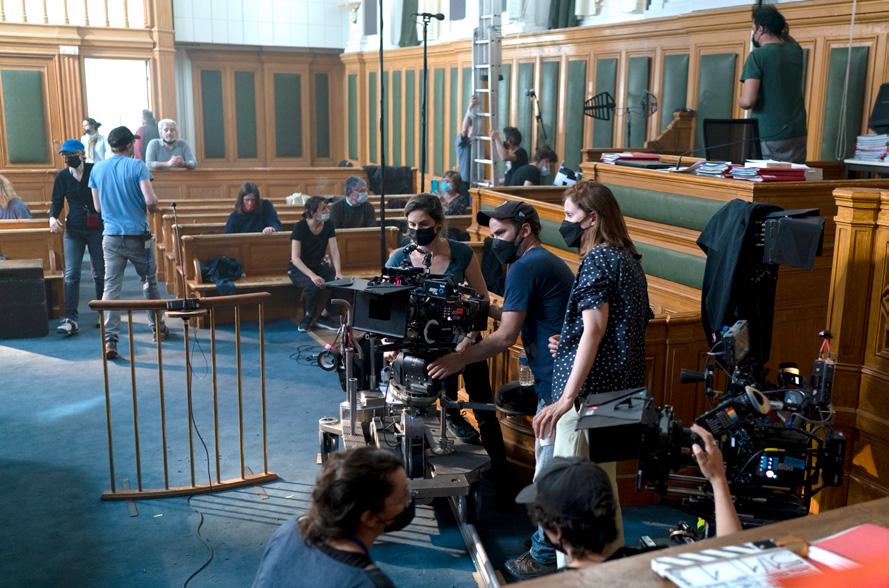
“We were shooting at 2,000m altitude and that makes everything complicated logistically,” Beaufils remarks. “But the production, control and decoration teams did a great job of helping us out. We had a big crane outside with 18K lights to balance with the huge
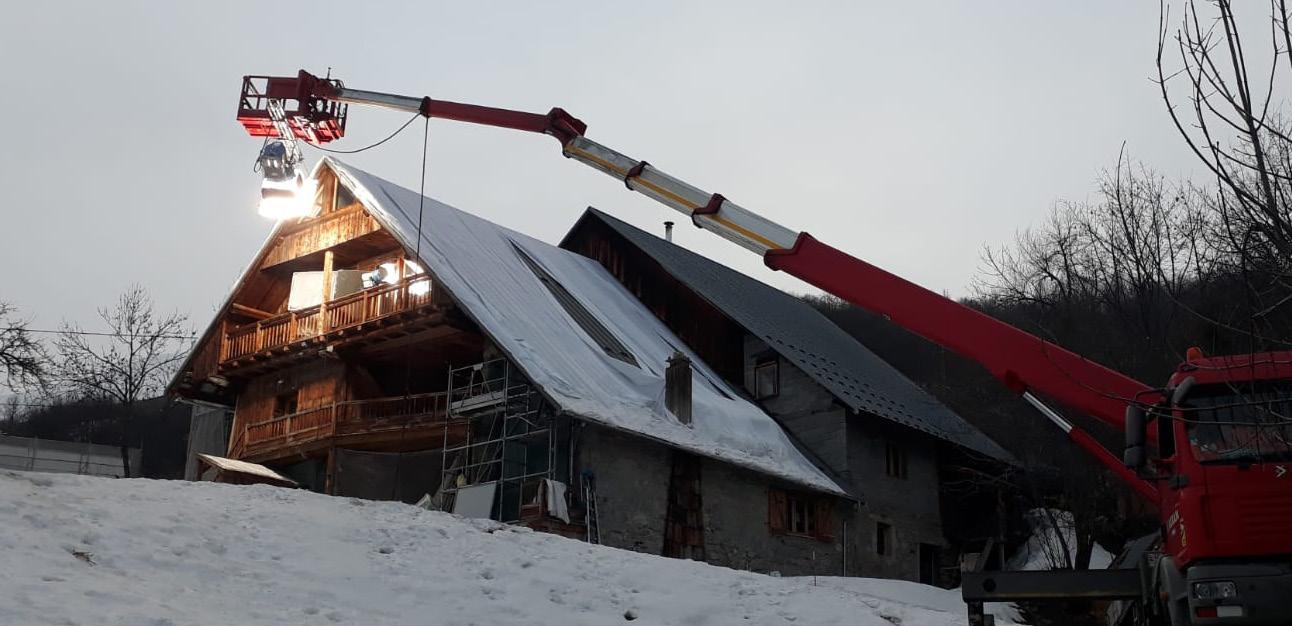
snow reflections. And, with the Tungsten lights, the direct sun and the reflection of blue sky, we had mixed colour temperatures. The trick was then to maintain continuity, especially the direction of the sun, which changed throughout the day,” he says.
When it came to accumulating the TV, news and journalist footage depicted throughout the film, Beaufils and his team decided not to fake these using post production techniques, and tested different cameras to shoot the footage.

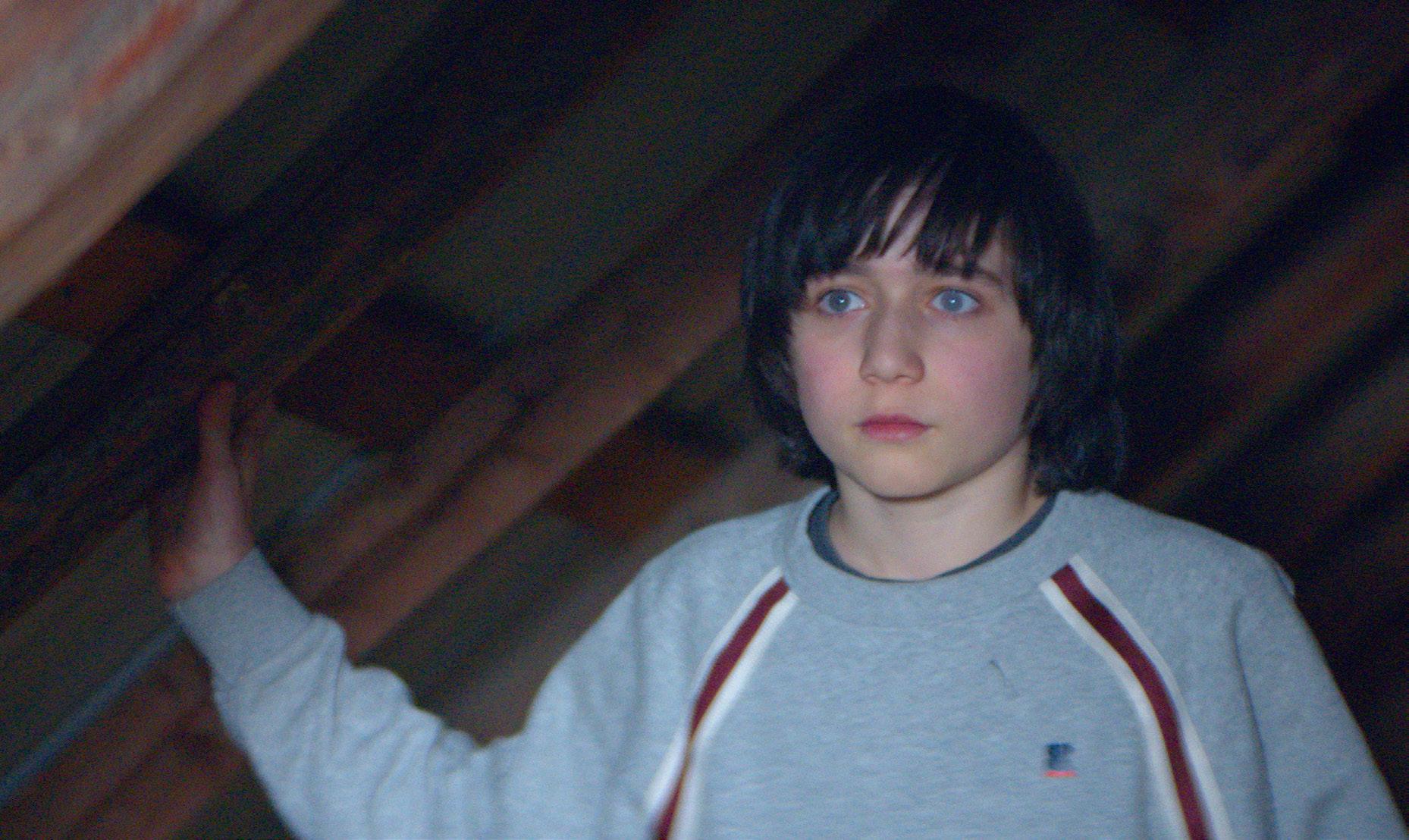
leads to a different way of shooting with a very light, handheld camera and you can experiment with different movements. I’ve shot with many old and non-professional video cameras before. Even VHS cameras. When you shoot with them now, it looks like a 20-year-old movie, and it’s nice to work this way.”
Discussing his approach to the centrepiece flashback sequence involving a secret recording that reveals an important character trait in Sandra, Beaufils explains that it was a scene that was spoken about at great length during prep.
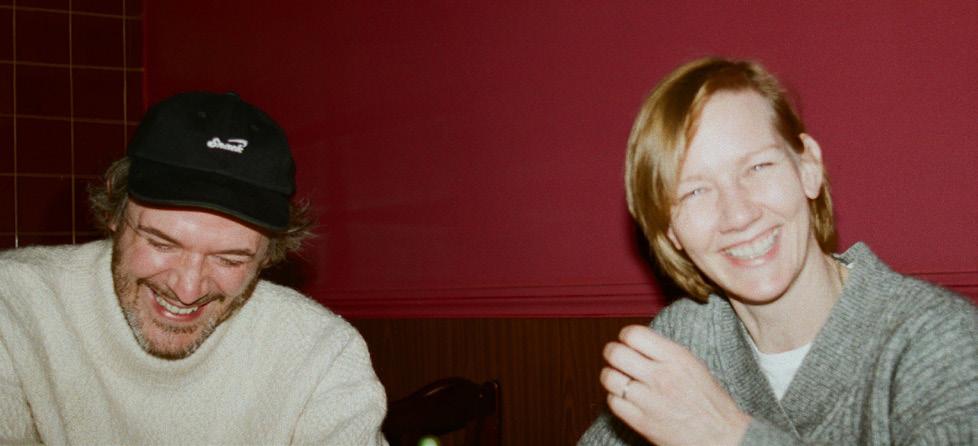

“Justine wanted to shoot this scene in two days and to have it shot in real time,” he says. “We decided to film it with two cameras and so we could be free to move during the shoot. One camera was on a dolly and the other camera was on a tripod but mobile too. We had a zoom for one and the other one was a Hawk V-Lite Anamorphic
“Justine didn’t want to do any rehearsals, and wanted to give the actors the same freedom of movement as they had in the rest of the film. Which meant we had to react and follow them. There were many takes and each take was different to the previous one, but always moving, building towards something else. For this scene we spoke at-length with the actors to get a really good feel about what they wanted to do and where they wanted to go, which really helped is figure-out where we needed to move the camera.”
Beaufils concludes, “Shooting this film was a real pleasure. Everyday we needed to invent, to create new solutions and find good ways to tell the story. There was nothing routine at all. We were always searching for the right place, the right timing, the right lens or the right light to capture the emotion that our incredible actors gave.
“We did lots of tests with different cameras and even bought some on Ebay,” he notes. “We also went to non-professional video rental companies. We chose six or seven types of cameras/camcorders, which was difficult because you have to treat all sorts of different video formats, that were not so common for the digital lab, plus the sound is difficult and not good quality either.
“But, I think it was a good way to create these sequences because, although you can create the effect afterwards in post, it’s nice to do it yourself and you end-up with happy accidents. Also, it
“Behind the camera, you’re the first viewer of the film, and the emotions were strong. When Sandra Hüller unleashes her fury, I took it all in: it was upsetting, hard, moving and beautiful, all at once. To be overwhelmed by what you’re filming, to feel all these contradictory feelings and succeed in capturing them, was truly a unique feeling.”
Images – Pictures courtesy of Les Filmes De Pierre.
SIMON BEAUFILS AFC•ANATOMY OF A FALL
CINEMATOGRAPHY WORLD SEPTEMBER/OCTOBER 2023 67
There was nothing routine – we were always searching for the right place, timing, lens or light to capture the emotion our incredible actors gave
YOUR MAJESTY
By Ron Prince
When it came to shooting her sixth feature, Jeanne du Barry, in which she also stars, director Maïwenn turned to the talents of veteran French cinematographer Laurent Dailland AFC and his expertise in shooting on 35mm film, albeit after a ten-year absence of capturing in analogue format.
The historical drama, also starring Johnny Depp, follows Jeanne Vaubernier, a commoner of lowly-birth, who uses her wit and charismatic charms to climb the social ladder and become chief royal mistress to King Louis XV. Against all propriety and regal etiquette, Madame du Barry moves to Versailles, where her relationship with the king scandalises the court.

The movie had its world premiere as the opening film of the 2023 Cannes Film Festival, where it was acclaimed for its central performances, and where Dailland’s sumptuous cinematography was declared “a feast for the eyes”.
Principal photography on Jeanne Du Barry started on 26 July 2022, before wrapping some 50 shooting days later in mid-October. Production took place at mythical locations around Paris, such as Le Château de Versailles, Le Château de Vaux le Vicomte and Le Château de Champs sur Marne. The royal bedroom, plus the king’s and Madame du Barry’s private apartments were filmed on sets constructed at Transpaset Studio in Saint-Ouen, Paris.

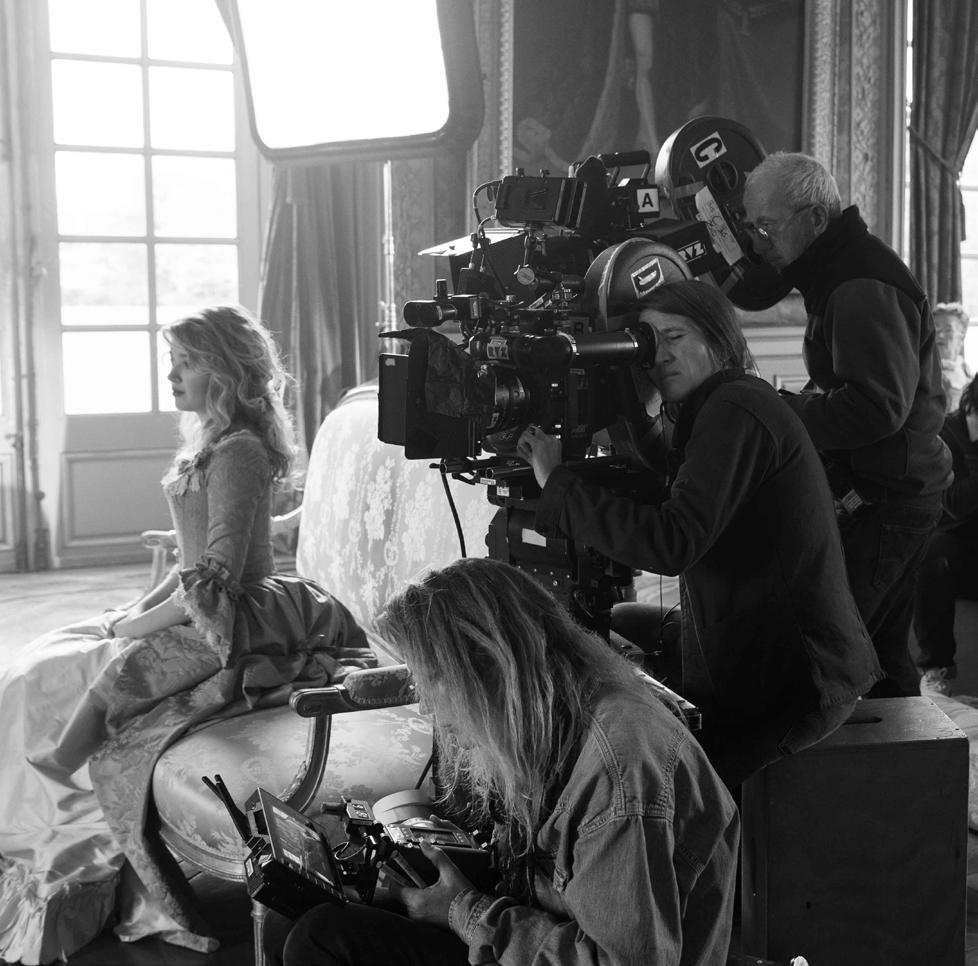

Speaking about his initial conversations with Maïwenn about the look of the film, Dailland recalls, “Jeanne Du Barry was radically different in style
compared to her previous films – she wanted a calm and relatively aesthetic visual universe. Also, although her other films were shot digitally, Maïwenn always imagined this film on 35mm.
“When she suggested I work with her, I think it was a way to reassure herself about this change in style. She must also have seen me as having a certain academic stature, and as someone who had the right experience with film and film cameras. However, as I was to learn during production, she pushed me out of my comfort zone and into different visuals and lighting set-ups.”
these gave us all inspiration and ideas for the atmosphere and the colour tones of the different scenes and shots.”
Dailland’s celluloid credits are extensive and include Place Vendôme (1999, dir. Nicole Garcia), plus Welcome (2010, dir. Philippe Lioret), both of which earned him prestigious César Award nominations for best cinematography. He also shot Est/Ouest (1999, dir. Régis Wargnier), Le Goût Des Autres (2002, dir. Agnès Jaouï) and Le Concert (2009, dir. Radu Mihaileanu) on film, which all earned international recognition and multiple awards.

Before working on Jeanne Du Barry, the last movie Dailland shot on film was Jamais Le Premier Soir (2012, dir. Melissa Drigeard), filmed on 35mm in 2-perf using an Aaton camera.
Dailland adds, “Preparations for the film essentially took place in an open-plan space where we had one panel for each sequence, on which Maïwenn placed photos of the sets, the actors and objects. She also hung-up pieces of costume and fabrics. She has very good taste, and this mosaic of objects proved very efficient in creating connections between the heads of department – the costume and set designers, make-up and hair, and, of course, the cinematographer – and
On returning to shooting on 35mm film once again, Dialland remarks, “During my career I have shot 65 features – 16 of those were with digital cameras starting in 2012, all of the rest were on film. Having shot so many fiction narratives on celluloid, I know the limits of film, and also the limits of digital. Film is both humble, in the way it respects everyone’s work, and also generous in how it improves and transcends this work. This ounce of mystery belongs only to film and it will always seduce me.
“I had absolutely no need to do comparative film vs digital tests for Jeanne Du Barry – I knew I would get a better result by shooting on Kodak. I knew the colours of the decorations and the fabrics would be there to my
JEANNE DU BARRY•LAURENT DAILLAND AFC
68 SEPTEMBER/OCTOBER 2023 CINEMATOGRAPHY WORLD
I thought filming on film wouldn’t happen to me anymore
and Maïwenn’s satisfaction, and that the images would retain details in the shadows as well as in the highlights.”
In terms of creative visual references, Dailland remarks, “We looked at a lot of paintings from that period by artists such as Fragonard, and his assistant Marguerite Gérard, Gainsborough, Boucher, Vernet, Reynolds and Élisabeth Vigée Lebrun, who became Marie-Antoinette’s official painter.
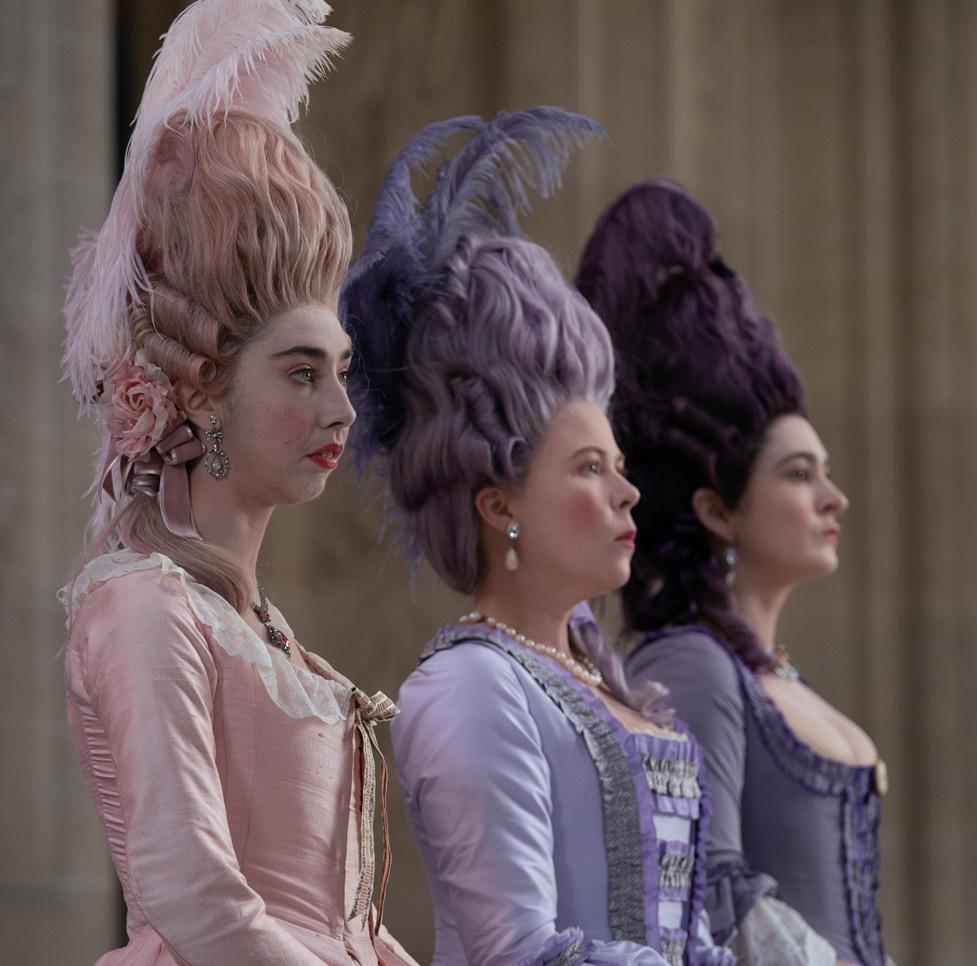
“Our main film reference was Stanley Kubrick’s Barry Lyndon (1975), photographed by John Alcott BSC, especially for its legendary use of candlelight, a technique that Maïwenn and I both wanted to harness for several big sequences in our film.
“Alain Corneau’s Tous Les Matins Du Monde (1991), shot by cinematographer Yves Angelo, was also an inspiration, although that film is more related to the 17th century. Maïwenn liked the slow pace and the wide shots in which you see the action unfold. However, these were only references, sources of inspiration for us to go towards, or perhaps to turn away from, and certainly never not to copy.”
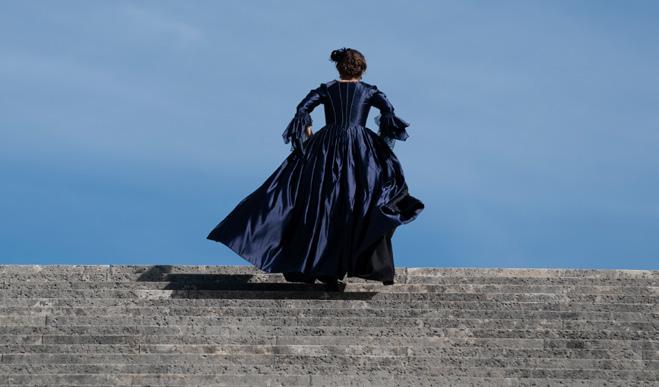
When it came to selecting cameras and lenses for the production, Dailland explains that Maïwenn was fully-supported in her decision to shoot on 35mm by producer, Pascal Caucheteux. This entailed Dailland finding a rental company he trusted, one with good experience in 35mm, and one that the production team would be satisfied with.
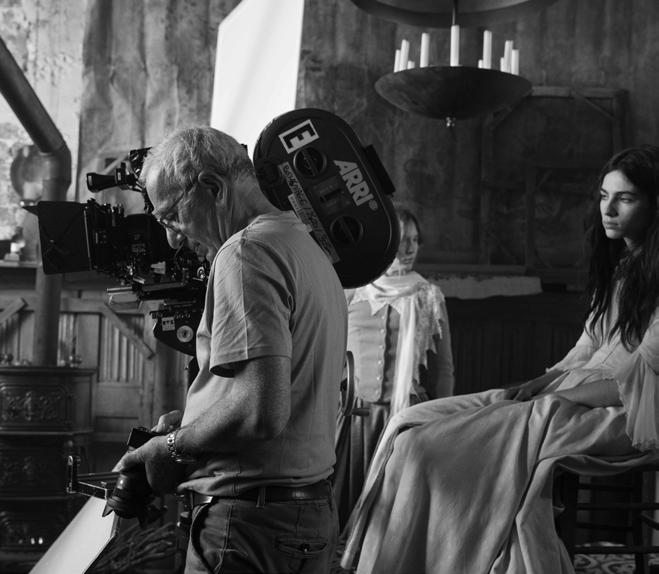
“I researched films that had recently shot on 35mm in France, and was very happy to get the two ARRICAM LT cameras used by Robert Yeoman ASC on
“I tested a lot of lenses, including Cooke Panchros – the same as used on Barry Lyndon – and a lot of modern lenses that are not made for 35mm. The results from the Zeiss Supreme and Supreme Radiance were amazing, but they created colour imbalances and brought a precision that did not fit the film’s aesthetic.
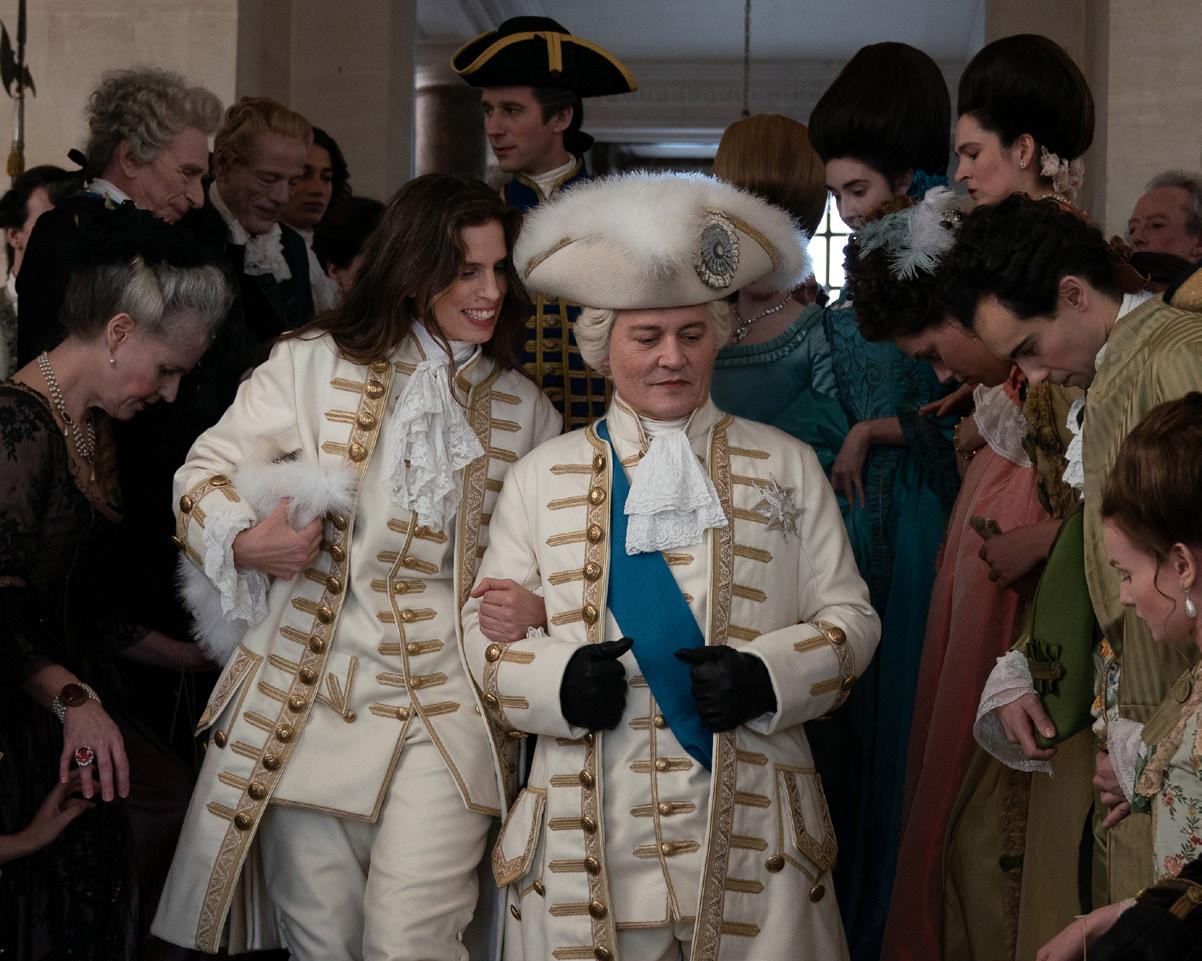

“More traditional lenses that I really liked were the Cooke S4s (my favourites, ever), but they were limiting, as their maximum aperture is T2.2. I needed to open to T1.3 for our candlelight sequences and I did not have not budget for two sets. So, in the end I chose the Zeiss Master Primes, and was careful not to go beyond T4, sometimes T5.6, when we shot, even on the exterior day scenes.”
“The filmstock came from London via a Belgian co-production partner, but due to various problems linked to Brexit, we had some cold sweats on deliveries at first,” he recalls. “Fortunately, one Friday evening we were saved by my colleague Josée Deshaies who was shooting Bertrand Bonello’s film, La Bête (2024), in Paris on 35mm.
“One issue, which I shared with Maïwenn, was how to shoot the candlelit scenes using just candlelight. At 500ASA on the 5219 I found myself a bit narrow in terms of aperture, especially for the wide shots. So I conducted different waves of push-processing/ over-development tests using the 500T 5219 filmstock, followed by 4K ARRISCANs, with our excellent French laboratory Hiventy.
“I also worked with my colourist, the famous Isabelle Julien, to develop a protocol we would adopt later in the final grade that would remove excess grain from that push-process, with different settings on wide shots and close-ups – the reason being that I did not want to shock viewers, who only see smooth digital images, by having too much texture in the image.
“I have to say, the colour contrast from a wellexposed negative on 500T 5219 rated at 1000ASA, which was then push-processed at the lab and slightly de-grained during the colour grade, looked absolutely
Images: Jeanne Du Barry, directed by and starring Maïwenn. © Stéphanie Branchu, courtesy of Why Not Productions.
Wes Anderson’s The French Dispatch (2021) from the RVZ team in Paris,” he says.
Dailland shot Jeanne Du Barry using three film emulsions: Kodak Vision3 500T 5219, Kodak Vision3 250D 5207 and Kodak Vision3 50D 5203. Film processing and 4K scanning was conducted at Hiventy in Paris.
LAURENT DAILLAND
DU BARRY
AFC•JEANNE
CINEMATOGRAPHY WORLD SEPTEMBER/OCTOBER 2023 69
Maïwenn encouraged me to go towards what I thought was risky lighting, but it turned out to be some of the best in the film
majestic. These tests convinced me what a great choice it was to shoot those scenes in candlelight on 35mm.”
Dailland enthuses this was especially true when he came to shoot those scenes for real and then corrected the reference dailies at home in the evening after the day’s shoot.

“We shot several sequences with candles, most with classic warm candlelight, but one of them in near-total darkness, barely golden. Maïwenn was wearing a big white dress, and Johnny Depp was in a blue suit. You can guess their presence in the image more than you can actually see them. Mai wenn encouraged me to go towards what I thought was somewhat risky lighting, and I intentionally left parts of their faces in the dark.
“When I corrected those dailies after the day’s shoot, I had, in a corner of my computer, two photos from Barry Lyndon that I had found on Shotdeck. In all modesty, the shadow, or rather the light, of John Alcott’s work was imbued in our scenes. It was some of the best lighting in the film, and that reassured me a lot.
“Also, the quality of the filmed and calibrated dailies earned me the support of all the most important people in the team, which is always appreciated when you’re making a difficult film.”
Dailland says that shooting in the Hall Of Mirrors at the Château de Versailles, proved quite a technical and bothersome challenge, as there were many constraints around shooting at this historic location, particularly after the 2019 fire which severely damaged Notre-Dame cathedral in Paris.
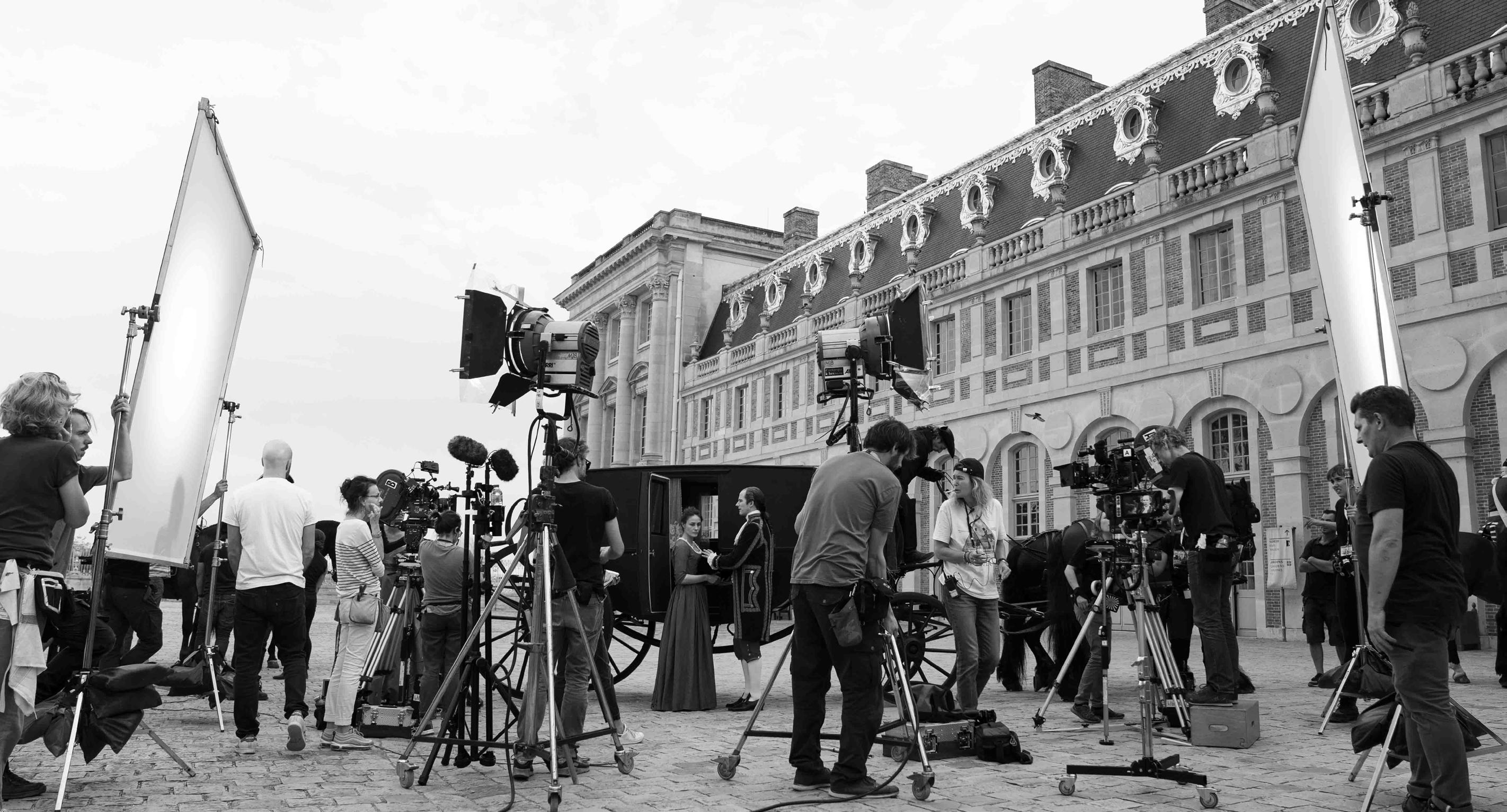
“We were on the 10th day of the shoot. There was no way we were allowed to have real candles or even smoke for a key scene in which Jeanne is presented to

the king and the court. Faced with these constraints and budget, I decided with my gaffer, Michaël Wallet, to shoot in natural light using the 250D 5207.
“We had 150 extras made-up and dressed-up, as well as our main actors, but only one day to film 30 shots. I knew the different filming axes in relation to the inclination of the sun and its effects on the decor. Although the natural light was sublime, there were many decisions to be made, and there was an air of anxiety about not finishing on the most expensive day of the production.
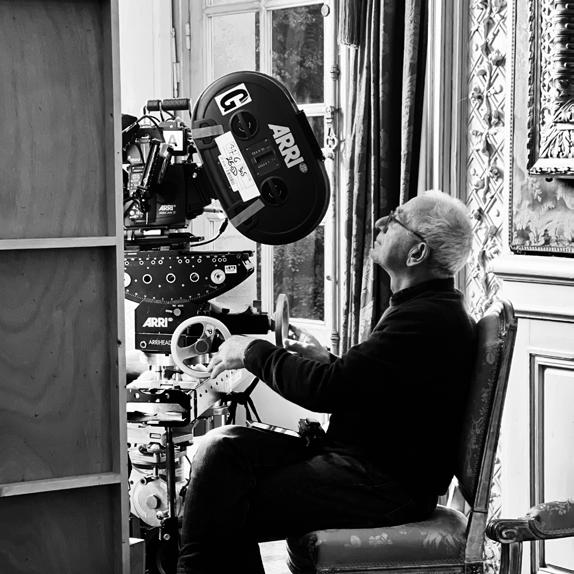

“I started the next day with butterflies in my stomach, until he called to say everything was fine. Not only could he line-up the first and last shots very easily, it looked beautiful too. It was August 11, 2022, my 66th birthday, and analogue film gave me the best birthday present ever.”
The DP adds, “In digital, this situation would have been unmanageable and catastrophic.
I would have needed to grade this sequence in monochrome to save it. But there, with the Kodak 250 daylight stock, all the colours were recorded, from blue to red, at 5600K as well as at 2000K. I didn’t get replaced, and Maïwenn actually asked for a special edit of this sequence to show the team, the financiers and friends what the final film was going to look like.”
Dailland concludes, “I loved shooting on 35mm again, even though it put a lot of pressure on me at first, because I hadn’t shot on film in over ten years, and, frankly, because I thought that wouldn’t happen to me anymore.
“Luckily, we managed to do everything, except for a few close-ups that I lit with LED spotlights on a column in the background. However, I noticed that my colour temperature had gone from 5600K at around 3pm to less than 2000K around 8.30pm. I was devastated, and worried I was going be replaced. When I got home, I sent an alarming and dramatic email to my dailies colourist, Thomas Ditech, explaining the situation and asked him to call me back as soon as he had seen the scans.
“Often in digital we search for a look that will compensate for the lack of respect the sensors have in delivering the colours we want, and this all-too-often leads to the same image from the beginning to the end of a film. It can be very restrictive. On Jeanne du Barry I felt free to have the image I wanted for each sequence. A rainbow of colours, in fact. The result: happiness.”
JEANNE DU BARRY•LAURENT DAILLAND AFC 70 SEPTEMBER/OCTOBER 2023 CINEMATOGRAPHY WORLD
Film is generous in how it improves and transcends everybody’s work

LAURENT DAILLAND AFC•JEANNE DU BARRY CINEMATOGRAPHY WORLD SEPTEMBER/OCTOBER 2023 71
PUMP UP THE VOLUME
By Larissa Mori
With campuses in both Atlanta and Savannah, Georgia, the Savannah College Of Art & Design (SCAD) has found itself perfectly situated for young creatives looking to learn and develop in the heart of the state’s multi-billion dollar film industry. Upon its founding in 1978, the university offered a range of arts degrees otherwise unavailable in the region: interior design, printmaking and ceramics all featured. But in the years since, it is perhaps the university’s film school that has developed to become the biggest draw for applicants.
One of the most appealing attractions for prospective students has been the recent addition of two virtual production studios. These specialised spaces give students the opportunity to work and learn around an LED volume for virtual production. SCAD owns and operates two of these volumes, one as part of its landmark 10.9-acre expansion project of SCAD’s Savannah Film Studios and the other as part of their Digital Media Center at its Atlanta location.
“SCAD is the only university that has two of these volumes, at this size and scale, that are available exclusively for our students to use. Our ethos here is that our students should have access to the very
latest in cutting-edge technology,” says Jud Estes, the university’s associate dean for the schools of film and acting, animation and motion, and creative technology. “Going forward, we hope to be filling LED volumes in the US and globally with SCAD students, who are some of the first in the world to graduate fully-understanding how to use this new technology.”
Each volume features a sprawling curved LED screen display, as well as an LED ceiling, replicating the type of immersive set-up used by leading Hollywood studios. The idea is to ensure that students at SCAD are ready to hit the ground running the moment they enter the industry, armed with up-todate knowledge of the cutting-edge technologies that will define the future of filmmaking.
Each of SCAD’s LED volumes has been created in conjunction with immersive entertainment company Meptik. It’s a collaboration that feels like something of a homecoming for the business that is heavily composed of SCAD alumni, including co-founder Sarah Linebaugh.
“Being a SCAD-founded, SCAD-driven company, it’s been exciting to invest the skills we’ve learned in extended reality (xR) to ignite generations of students to come,” says co-founder Nicholas Rivero.
The Meptik team built the first of the two LED volumes at SCAD’s Savannah Film Studios in 2021. From the outset the plan was to create the same quality of set that students would find themselves working-on after graduating. There was no value in scaling back here. The finished volume features a 60-foot wide, 16-foot tall curved display which, teamed with a 38 x 20-foot LED ceiling, enables students to immerse their actors in any setting they can imagine.
Meptik was keen to ensure that students were working with the best tools possible in every aspect of their productions, bringing in Red Komodo 6K cameras equipped with Zeiss lenses and Stype
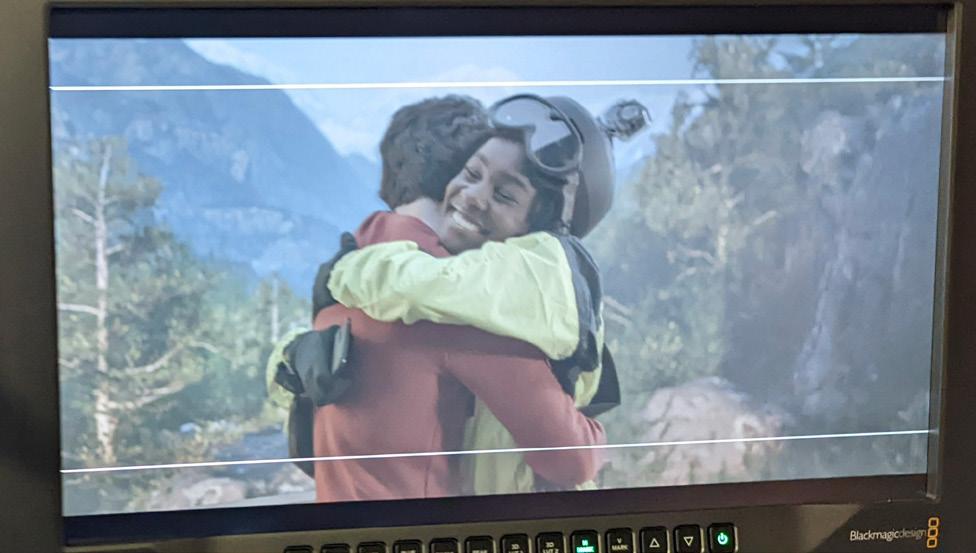
RedSpy tracking, and a range of Disguise VX 4 and RX II servers, all connected through the Disguise Fabric pre-configured network switch.
For SCAD, this technology has been the making of the studio. The past five years have seen an explosion in use of virtual production around the globe, and Disguise technology sits at the heart of many studios’ set-ups.

“As well as being an industry-standard in many areas, Disguise’s workflows enable students to work with programmes like Unreal Engine as they create their productions. It’s an invaluable asset for students at the college to finish their degree with hands-on

72 SEPTEMBER/OCTOBER 2023 CINEMATOGRAPHY WORLD
STUDENT UNION•SCAD – SAVANNAH COLLEGE OF ART & DESIGN
The LED volume provided the ability to forge a new career trajectory for myself
Our ethos is that students should have access to the very latest in cutting-edge technology
experience operating the same hardware used on high-end television sci-fi shows like The Mandalorian on Disney+ and superhero blockbusters including 2022’s The Batman,” says Estes.
The recent prevalence of virtual production techniques might have been boosted by the limitations put in place by the Covid-19 pandemic, but it’s the practicality and adaptability of the format that means it will become an increasingly large part of film productions in the future.
Virtual production allows for total control while keeping cost and logistics in check. Because the
the incredible true story of Bill Lester, the first black driver to win a race in NASCAR’s Grand-Am series. These techniques, with Disguise technology, have also been used for interior car scenes in the recent BBC thriller Better
This flexibility lends itself to a range of courses at SCAD, with students from a number of different degrees having the opportunity to learn within the LED volumes. An immersive production class, entitled ‘Collaborative Experiences In Film & Acting’, gives prospective digital artists and cinematographers the chance to work closely with students in the production office and art department to create projects shot on the LED Volumes. Those training in cinematography will emerge into an industry that is increasingly reliant on virtual production as it replaces older techniques like
advantage of the opportunities on their doorstep.
“I initially chose to attend SCAD because I knew that, even if the future was uncertain, this university would give me the skills I need to join the workforce of my choosing,” says Maura Hayes, an LED volume technician and recent graduate from SCAD’s immersive reality BFA programme. “The opening of the LED volume provided something even better: the ability to forge a new career trajectory for myself. I’ve been in the workforce for a year now, but I am so grateful to be one of the initial few to have trained on this technology in a university setting.”
Hayes is just an early example of the sort of talent SCAD hopes to be injecting into the film industry in the coming years.
“Everything we do here mirrors exactly how the industry works,” says Estes. “This way our students’ transition from classroom to studio set is as seamless as possible. Their advanced knowledge sets them up to progress from junior artist, to artist, senior artist and lead, more quickly than students from most traditional schools.”
greenscreen and traditional car processes. It’s an early opportunity to get their heads around the challenges and opportunities they’ll face on-set in the future, as they learn how media workflows in an LED volume give them power to implement the perfect lighting and craft the exact visual aesthetic they aspire to.
“As a student working on a volume, it’s a dream come true to be working on technology of this calibre at such an early phase of my career,” says Sean Hussey (BFA Film & Television). “It felt like I was working within a small production company and having the ability to collaborate in that way is simply unmatched at the collegiate level.”
For students at SCAD, access to these LED volumes also empower them to experiment with more ambitious ideas than undergraduates at other facilities. The tools now at their fingertips aren’t just enabling them to better prepare for life in the industry; they are inspired to develop their own talents and visions, delivering innovative and exciting projects that can be featured at SCAD’s annual film festival.
With both LED volumes in place, SCAD is continuing to look forward, extending its campus into a full backlot that will make the university’s Savannah Film Studios the largest, most comprehensive university film studio complex in the country. As they build out a curriculum that will allow them to offer students a minor in virtual production, it seems entirely possible that Estes’ vision for an industry awash with SCAD alumni will come to fruition sooner rather than later.
virtual environments are created in pre-production, scenes, camera angles and lighting can be dialledin during pre-visualisation, effectively minimising the time spent on set.





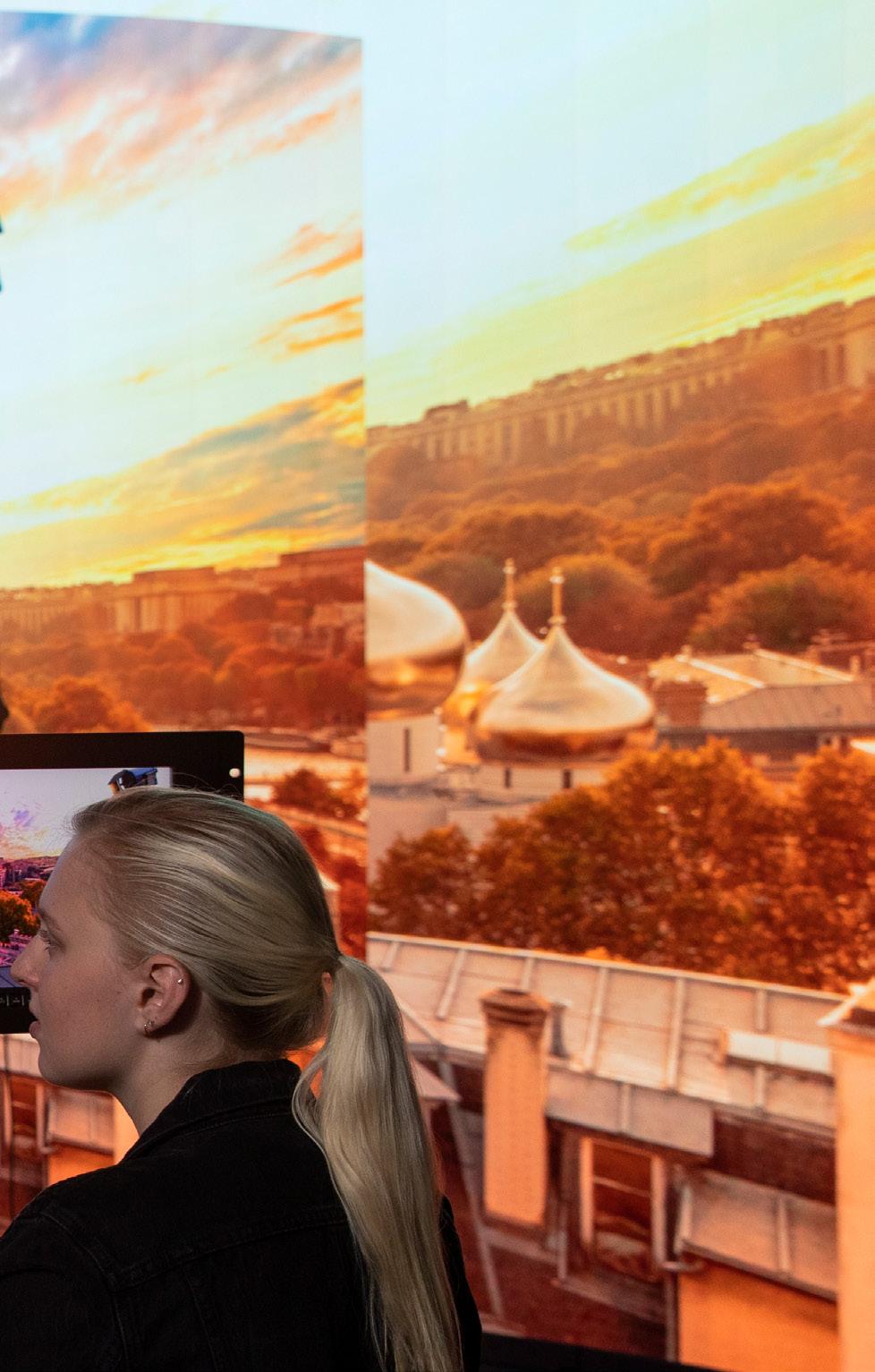
Crew travel to different locations is no longer necessary, as virtual environments can seamlessly be swapped-out and adjusted in real-time. A golden hour can last for days, and objects within the environment can be moved to the director’s specifications, making sure the perfect shot is always possible. Locations can range from existing, photorealistic backdrops like New York City to productions on otherwise impossible sets, such as the surface of Mars. Meptik has used virtual production sets on short film Defy The Odds, which is based on
The SCAD Savannah Film Festival, the world’s largest university-run event of its kind, provides students with the opportunity to showcase their work alongside that of established industry talent. In 2022, the festival celebrated its 25th anniversary. Alongside awards events for producer/director/actor Ron Howard, and actors Jonathan Majors, Henry Selick and Kerry Condon, audiences were able to see the first student films to have taken advantage of the university’s new LED volumes.
In the last year alone, more than 400 productions have been shot in the state and as of 2022, four Georgia-lensed films have claimed the top six spots for highest domestic-grossing movies: Avengers: Endgame, Spider-Man: No Way Home, Black Panther and Avengers: Infinity War. So it is fitting that SCAD students have access to technology that ensures they are able to leave their degree and take
CINEMATOGRAPHY WORLD SEPTEMBER/OCTOBER 2023 73 SCAD – SAVANNAH COLLEGE OF ART & DESIGN•STUDENT UNION
It’s invaluable for students to finish their degree with hands-on experience, operating the same hardware used on shows like The Mandalorian and The Batman
NORTHERN POWERHOUSE
By Ron Prince
Today, we’re visiting Sunbelt Rentals ‘upNorth’, in Manchester, some 200 miles from London ‘down-South’.
I have to admit, I’m quite emotional about this one as, once upon a time, I was born just a couple of miles from here, spent my formative years in its Lancastrian bosom, and I’m returning to my spiritual home.
I’m welcomed by Jenny Clark, marketing manager for film and TV, and made to feel perfectly at home by her cheerful greeting and an excellent cup of tea.
There’s a lot to be cheerful about. In recent times, the last year in fact, Sunbelt Rentals has, through acquisitions, become a new and significant player as a supplier of lighting, camera, grip, powered-access, power and temporary infrastructure to the UK film and TV industry, and its northern depot, here in the Manchester suburb of Irlam, is an impressive expression of its commitment and intent.
Located in what appears to be a light-industrial district, where large individual plots have ample breathing space, and delivery trucks gain easy access to the motorway network along leafy boulevards, the place occupies 60,000sq/ft of warehouse and office floor space. It’s the site of what was PKE Lighting, following the purchase of the firm by Sunbelt Rentals in July 2022.
Along with hordes of state-of-the-art lighting equipment, the place is also being steadily populated with kit and kaboodle from other businesses that Sunbelt Rentals has brought into its now burgeoning portfolio of complementary companies in the last short while – such as cameras and lenses from Movietech, grip gear from Alphagrip, and scissor, boom and telescopic lifts from Media Access Solutions (MAS) –all with the aim of making it a veritable one-stop-shop for TV and filmmaking clients.
And then some. Because, if you regard TV production and filmmaking as an industrial activity – also requiring things like portacabins, portaloos, heating, cooling, fencing, trackway and mechanical
plant to manoeuvre cumbersome stuff around a location, even LiDAR scanners – then the wider Sunbelt Rentals empire is here to help. Being a business of Ashtead Group Plc, which has extensive business interests in construction and utilities, it can help with all of these too. In theory, it’s a producer’s dream, supermarket-sweep scenario.
But the vision for the business doesn’t stop there. Plans for another depot, of much larger size and scale ‘down-South’ are at an advanced stage, a move that’s in tune with the exponential growth of the UK’s screen industries over the last decade, which looks set to continue once the Hollywood strikes have been settled, of course. We’ll be sure to report on this in the not toodistant future.
Now, all of this means a lot of change and learning for Sunbelt Rentals, the personnel of its newlyabsorbed companies, as well as current and future clients. And Jenny eagerly explains all about various initiatives in place. These include a host of corporate environmental, social and governance (ESG) safeguards, local community and educational, skills outreach programmes, and sustainability activities.
For an example of the latter, the company is already an active sponsor of the BSC’s new Sustainability Committee, and overall Sunbelt Rentals has invested over a whopping £135m in green solutions and innovative technologies – hybrid power, grip and plant – across its various film and TV businesses.

“Values are important to us – principles of teamwork and respect for our teams, clients, community and the planet – not only as they set us apart, but also because they bring us together,” she says.
We’re joined by Mike Pollard, former MD of PKE, now Sunbelt Rentals’ managing director of film and TV, and sales director Matt Evans, also from PKE heritage. Recent productions serviced by the company include Barbie (DP Rodrigo Prieto AMC ASC), Netflix series The Diplomat (DP Julian Court) and Sexy Beast (DPs

“For us, it’s all about relationships, and always will be,” says Mike. “Our team, their expertise and personal service to clients, matter a great deal. PKE was founded in 1991 and grew at time when film and TV production was essentially a cottage industry. We traded on having solid service and close working relationships with clients in the region and across the UK. Although the industry and our business have grown to mammoth proportions, we will still approach things in the same way we always did, on a personal level.”
As regards to PKE’s acquisition and assimilation into the Sunbelt Rentals’ empire, he adds, “PKE was bigger and more successful than most people ever realised. We had several approaches to sell the company over the years, but none of them ever felt like the right fit, or we thought we might have been cut-up into chunks and disappeared completely.
“But Sunbelt Rentals were very open and honest about their vision and their ethics, which we liked, and they were willing to support our desire to expand in the south. The industry was and is changing fast, and it felt much better to remain intact within a bigger company that would support our plans.”
Matt continues, “Sunbelt Rentals may be a
ON TOUR •SUNBELT RENTALS MANCHESTER
Birgit Dierken, Ralph Kaechele & Mattias Nyberg).
74 SEPTEMBER/OCTOBER 2023 CINEMATOGRAPHY WORLD
powerhouse of a company, but they are learning about our ways and are very supportive and sensitive as to how we operate with clients. We’ve retained the vast majority of our original 30-strong staff, and they are happy to be part of things moving forwards in the great scheme of things.”

The warehouse is an impressively cavernous space, with parallel aisles of heavy-duty decking sixtiers high, stacked with all manner of the very latest LEDs from manufacturers such as Creamsource, ARRI, Kinoflo and Astera, along with more traditional HMIs, Tungsten and fluorescents, Powergem ballasts, plus lots of cables and stands.
The financial investment made by Sunbelt Rentals in the UK over the last 12 months has been significant, with over £4 million invested in state-of-the-art lighting equipment in the last year alone. The best part of £1m has also been spent on the loading bay/brake test area for a fleet of 90 vehicles, a good many of which are powered by HVO, the fossil-free fuel that is used as

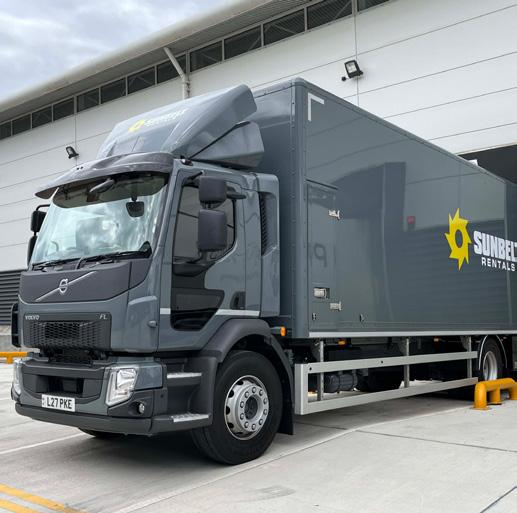
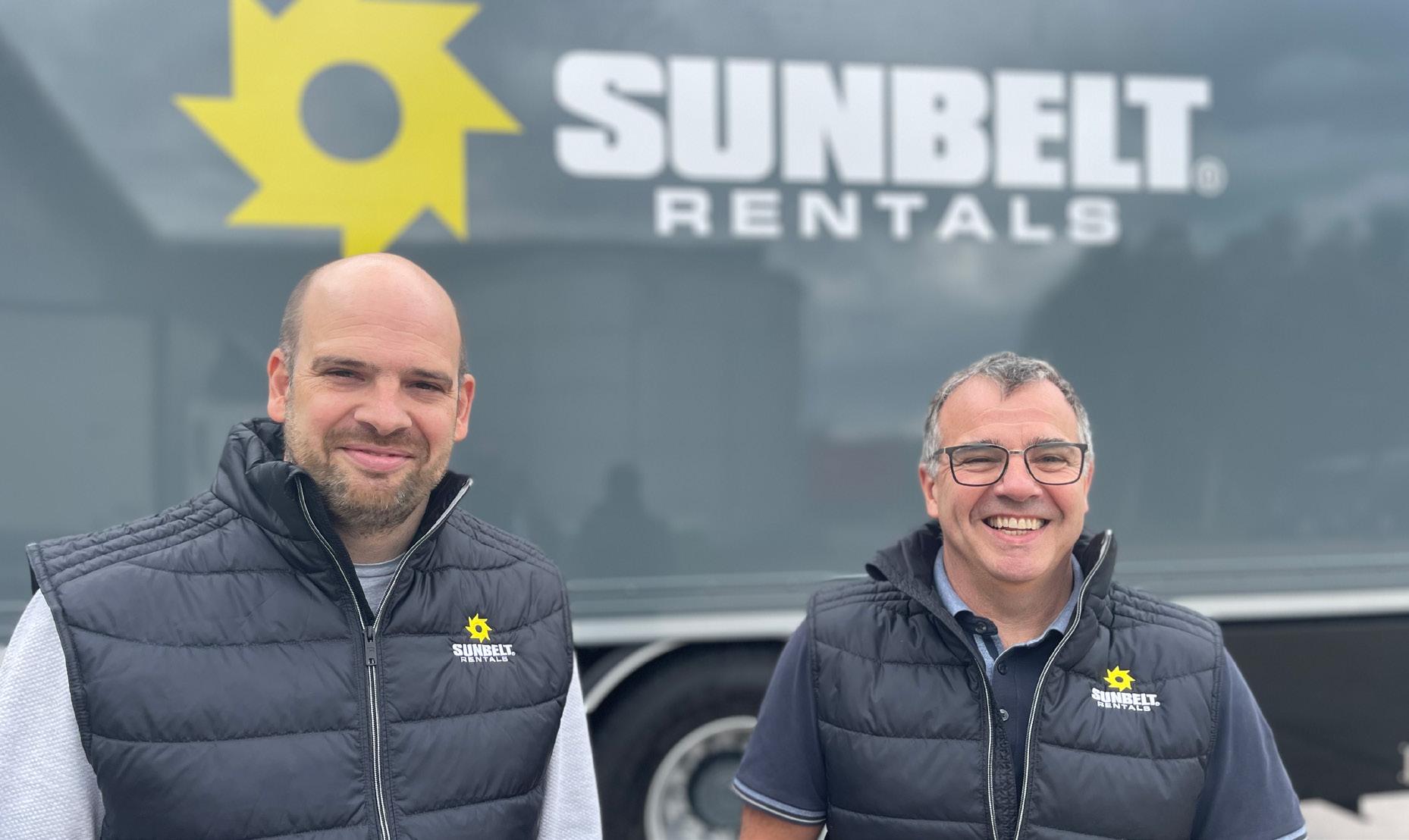
been supporting several productions shooting around Manchester and Liverpool, including BBC prison drama Time S2 (DP Paul Morris) and ITV mini-series Protection (DP John-Erling Holmenes Fredriksen). I wonder what Penny the whippet thinks about that?
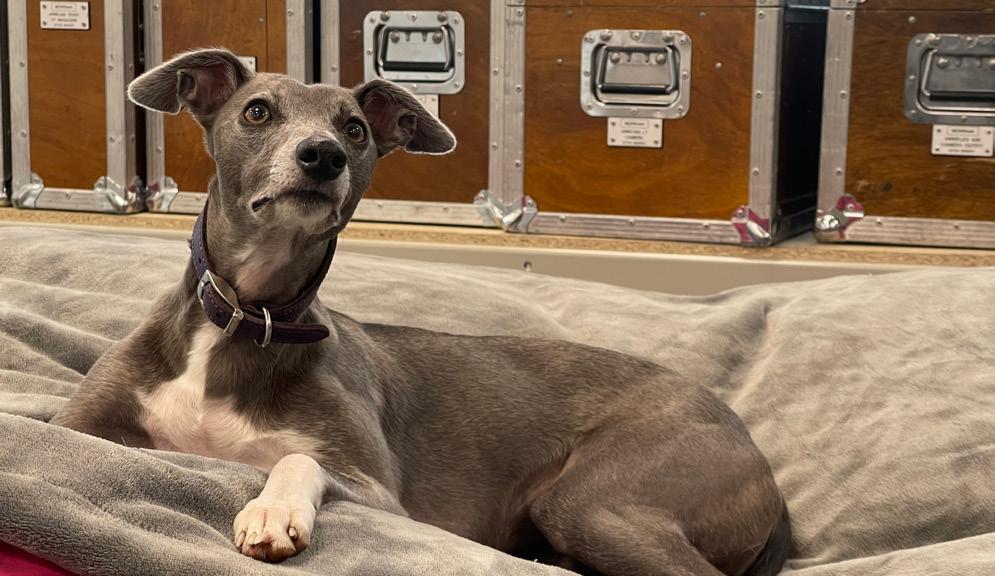
Like all these tours, time has whistled by – the best part of three hours – and tummies are rumbling. There’s just time to wolf down a cheeky Gregg’s Steak Bake (diced beef in a rich and tasty gravy, wrapped in a golden puff pastry parcel), they’ve ordered in just for me, before I head back ‘down-South’.
Whilst UK governments have, since 2010, made lots of noise about boosting economic growth in the north of England, through so-called and somewhat derided Northern Powerhouse Initiatives, Sunbelt Rentals have put their money where their mouth is. And it’s certainly very impressive.
Next-up will be what happens 200 miles away, where Mike and the Sunbelt Rentals team are eyeing up a southern depot, that is likely to be twice the size of the one ‘up-North’, stocking a huge and expanded inventory, and perhaps an LED-volume as well. It would seem they have it covered, not just ‘up-North’ but right around the British Isles. Watch this space!
The latest on-trend rock ‘n’ rock moving lights from purveyors such as Robe and Ayrton are also on the shelves, now being adopted by DPs and gaffers, plus a panoply of networking devices and programming control desks.



a direct replacement for diesel.
A further significant investment has also been made in lenses and cameras, including 50 ARRI Alexa 35s, available through its Manchester, Pinewood and Cardiff operations. Worthy of note, PKE, Movietech, MAS and Alphagrip will retain their identities for a time, but in consultation with the respective managing directors, they’ve already assumed Sunbelt Rentals branding, which is being rolled-out overtime.
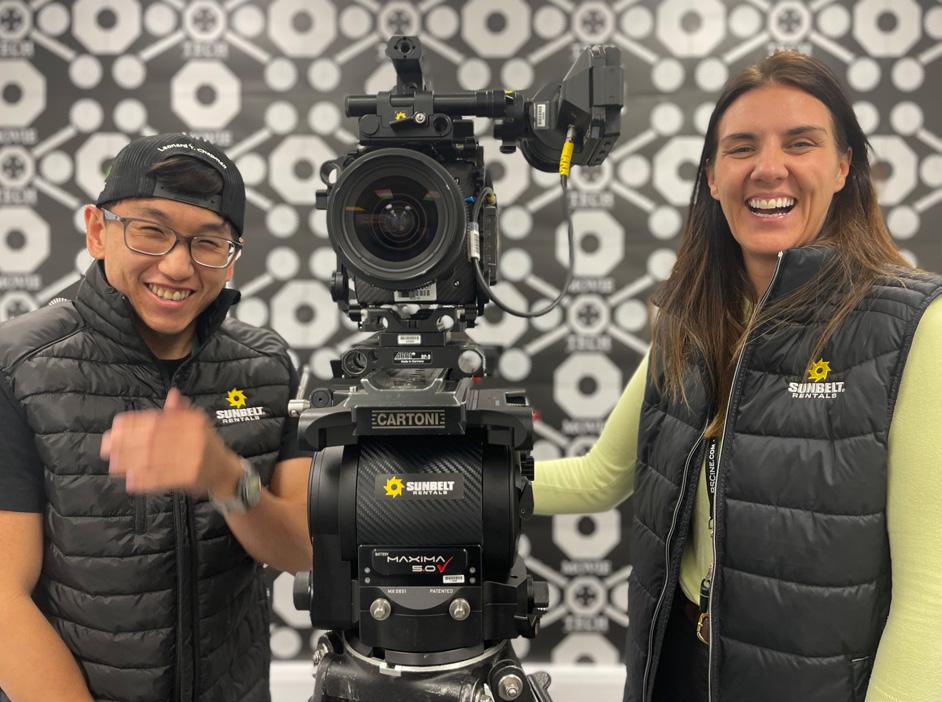
Not that proof is needed, but Mike, Matt and Jenny are keen to show me the new camera department that has sprung-up, under the watchful eye of camera/ grip operations manager Katy Kardasz, assisted by camera technician James Lau. Katy, who worked onset for a dozen years as a loader and focus-puller, ran Movietech’s Cardiff operations for four-and-a-half years, before relocating ‘up-North’, and graciously sets-up an ARRI Alexa LF with a Zeiss 21mm lens in the test bay as we chat.
At the time of writing, the camera team had already
SUNBELT RENTALS MANCHESTER•ON TOUR
Our team, their expertise and personal service to clients matter a great deal
CINEMATOGRAPHY WORLD SEPTEMBER/OCTOBER 2023 75
Values are important to us… because they bring us together
SHINING A LIGHT ON...
Selected Filmography (as gaffer unless otherwise stated)
Star Wars: The Acolyte (2023)
Shazam! Fury Of The Gods (gaffer: UK) 2023
Luther: The Fallen Sun (2023)
Operation Fortune: Ruse De Guerre (2023)
The Lost King (2022)
Memory (gaffer: London Unit) (2022)
No Time To Die (additional gaffer/rigging gaffer: Jamaica) (2021)
Venom: Let There Be Carnage (electrician) (2021)
Everybody’s Talking About Jamie (rigging electrician: additional photography unit) (2021)
Tom & Jerry (gaffer: second unit) (2021)
Wonder Woman 1984 (lighting technician) (2020)
Dolittle (lighting technician) (2020)
Aladdin (lighting technician) (2019)
The Nutcracker And The Four Realms (lighting technician) (2018)
Solo: A Star Wars Story (gaffer: splinter unit/lighting technician) (2018)
Hunter Killer (gaffer: second unit) (2018)
The Mummy (floor electrician: additional photography) (2017)
Wonder Woman (lighting technician) (2017)
Early career
I was 17 when I worked on a TV drama called Harbour Lights. I went on to get an apprenticeship with Michael Samuelson at Pinewood Studios, where I learned the equipment and did an electrical qualification at City Of Westminster College in Paddington over three years. It was a great time. I still talk of the stories and pranks we all played on each other. You wouldn’t get away with it now. But it was a very good time. Especially in the garage which was run by Mark Joiner and his ex-military work force. After the apprenticeship I started doing small units on shows I was on and I progressed from there.
Did you always want to be a gaffer?
Not at all. It just evolved naturally. I learnt the job and then I got to a point where I thought have to give it a go, otherwise I’d regret it. The more I do, the more I get comfortable with different aspects of the job. But, I have to stress it’s not for everyone. There’s a lot of time and effort put in 24/7. I secondthink what I have done and then I triple check it. Even on a Saturday evening with friends.
How did you learn the trade?
In addition to my apprenticeship training, I stood close to the gaffer and the DP on-set and listened to their conversations. I would also ask members of the different departments, and try to understand the mechanics of the film unit. If I had any questions I would ask. Don’t be afraid to ask.
How do you work with DPs?
What I think best is to follow the DP’s lead and build on it. I wouldn’t want to tread on someone’s toes and every DP has their own style. Once I work out that style, I then I try to embellish it.
HARLON HAVELAND By David Wood
Age// Born// School// Training// Lives // Hobbies//
42
Surrey, UK
Church of England Comp, Sunbury-on-Thames
Michael Samuelson at Pinewood Studios, Day Release City & Guilds Film & TV lighting

Teddington, Richmond – epicentre of the world! Hacking my way around a golf course and spending time with my cheeky, funny fiveyear-old daughter Ophelia. Also, reading facts from around the world. Did you know in 1998 there were more Barbie dolls in the world than Canadians?
It’s important to actually have a good time when you are working intensively; doing ten-hour days, 5-6 days a week for three months sat in a black tent. Crew
I’m very lucky because I grew-up with a very talented pool of electricians. So, when I need a good crew, they are not hard to find.
The majority of DPs I’ve worked with listen to suggestions and are open to them. With two DPs I know well – Larry Smith BSC ASC and James Friend BSC ASC – we take it seriously when it’s needed, but we also have a laugh. Both Larry and James like a bit of banter, a laugh and a joke, to help get the job done.
What has been your biggest challenge so far?
I found Luther: The Fallen Sun, on Netflix, quite challenging. We had three different DPs and there were a lot of nights in January. Also, we were still in Covid so that had its restrictions too. Apart from that, as long as you have the prep all sorted out, and a little bit of luck, then it should all go swimmingly.
What’s been your most difficult lighting job?
On Star Wars: The Acolyte we had an outside set, and needed to match it with material we had already shot, so we didn’t want any direct sunlight. We had 2 x 110-tonne cranes with 30 x 30 frames on and five Manitous with 20 x 20 flyswats to help us. But the wind had picked-up which meant that we

76 SEPTEMBER/OCTOBER 2023 CINEMATOGRAPHY WORLD GAFFERS CAFÉ•HARLON HAVELAND
It’s important to actually have a good time when you are working intensively
couldn’t use the cranes. There wasn’t a cloud in the sky, and we were left totally exposed.
So we had to manoeuvre 20 x 12 frames on stands with solids on to try and contain the sun. It was one of the longest weeks in my life. Strangely we had cloud and rain for about four months solid prior to that. And the one week we had outside was glorious bloody sunshine!
What are your favourite bits of kit?
ARRI SkyPanels have never let me down, especially the S60 for light boxes and the S360 for a big source around camera. I also couldn’t do a job without Astera Titans tubes. And I love the Astera AX9s and AX3s. I think they’re very underrated. On location, you can drop one anywhere for a little highlight or use it to give you layers in the shot.
How do you keep up with the latest innovations in lighting?

I have a lot of friends in big lighting companies that import new innovations to the UK who
constantly send me emails with new lights and ideas. That’s one thing the UK excels in – the adoption of new products and taking bold moves to implement them.
The rise of the desk operator as a key member of the team
No doubt about it, a good desk-op is invaluable. They’re a second set of eyes on lighting issues and they make your job a lot easier. If you want to work quickly and efficiently then a good desk-op is absolutely vital.
I’ve worked in many places around the world where they don’t have desk-ops or someone who has basic knowledge of the lighting desk. It makes the job a lot harder and slower. And, as producers are always reminding us, ‘time is money’.
What advice would you offer somebody who wanted to get into the world of film lighting?




The job isn’t just lighting a set, it goes a lot
deeper. Dealing with producers, inexperienced production staff and other difficulties that you would never imagine.
Also, there’s the stress of a shoot-day resting on your shoulders, that costs thousands and thousands. If your planning isn’t correct, it’s down to you and that has led me to many sleepless nights.
Take your time, look and listen and don’t run before you can walk.
Don’t be afraid to ask!
CINEMATOGRAPHY WORLD SEPTEMBER/OCTOBER 2023 77
HARLON HAVELAND•GAFFERS CAFÉ STUDIO LOCATION FEATURES COMMERCIALS DRAMA TELEVISION EQUIPMENT GENERATORS TRANSPORT SUPPORT INNOVATION SAFETY SUSTAINABILITY
Images: Harlon pictured on-set and fixing stuff, plus images variously from Operation Fortune: Ruse De Guerre, Luther: The Fallen Sun and Shazam! Fury Of The Gods.
As one of the industry’s premier rental resources, we are extremely proud to support crews around the world with an unrivalled collection of production solutions which embrace both the conventional and the very latest in advanced lighting technology.
MBS Equipment Company Lakeside Road, Colnbrook, Slough, Berkshire SL3 0EL +44 (0) 1753 987 888 mbseco.uk PMBS generic quarter.indd 1 12/01/2022 11:18
Whatever your production type, wherever you are, when it comes to lighting - we’ve got the lot.
GAFFERS CAFÉ•HARLON HAVELAND
ASC says…
I first met Harlon when I took over from Tom Stern AFC ASC on Luther: The Fallen Sun in January 2022. I was a bit sceptical about taking-over from another DP and inheriting a whole crew, as I’ve never done that before.
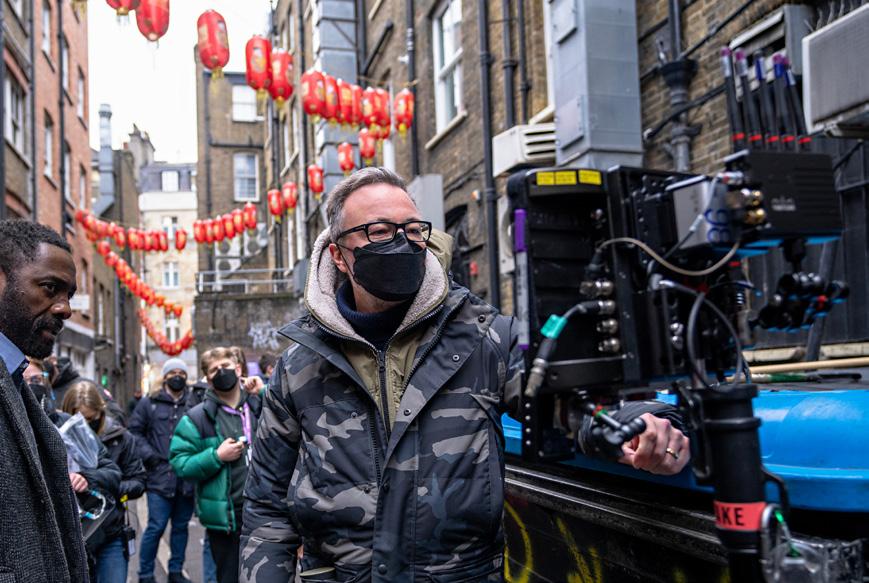


I was very, very happy that I found Harlon, because his organisational skills, and the lighting team he had around him, made my life really simple. After we completed our recces and got to shooting, I realised how organised he was and how well he
marshalled his support team.
As well as being very personable, he has a “never say no” attitude to problem solving and is eager to help all departments. Having completed on Luther: The Fallen Sun I was contracted to do a long series in Japan. I was so impressed by Harlon, that I asked him to come to Japan and thankfully he accepted the offer on what was a very challenging project. Now I will always check his availability before starting any projects.
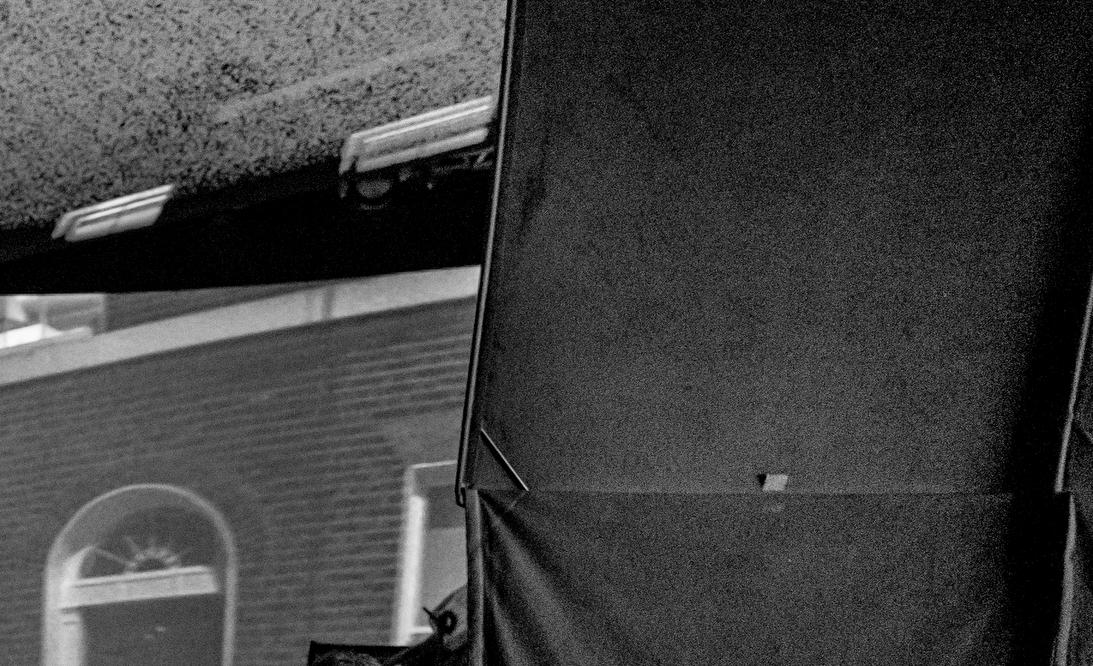
 Cinematographer Larry Smith BSC
Cinematographer Larry Smith BSC
78 SEPTEMBER/OCTOBER 2023 CINEMATOGRAPHY WORLD
Images: Top photo from Operation Fortune: Ruse De Guerre BTS photos below from Luther: The Fallen Sun.




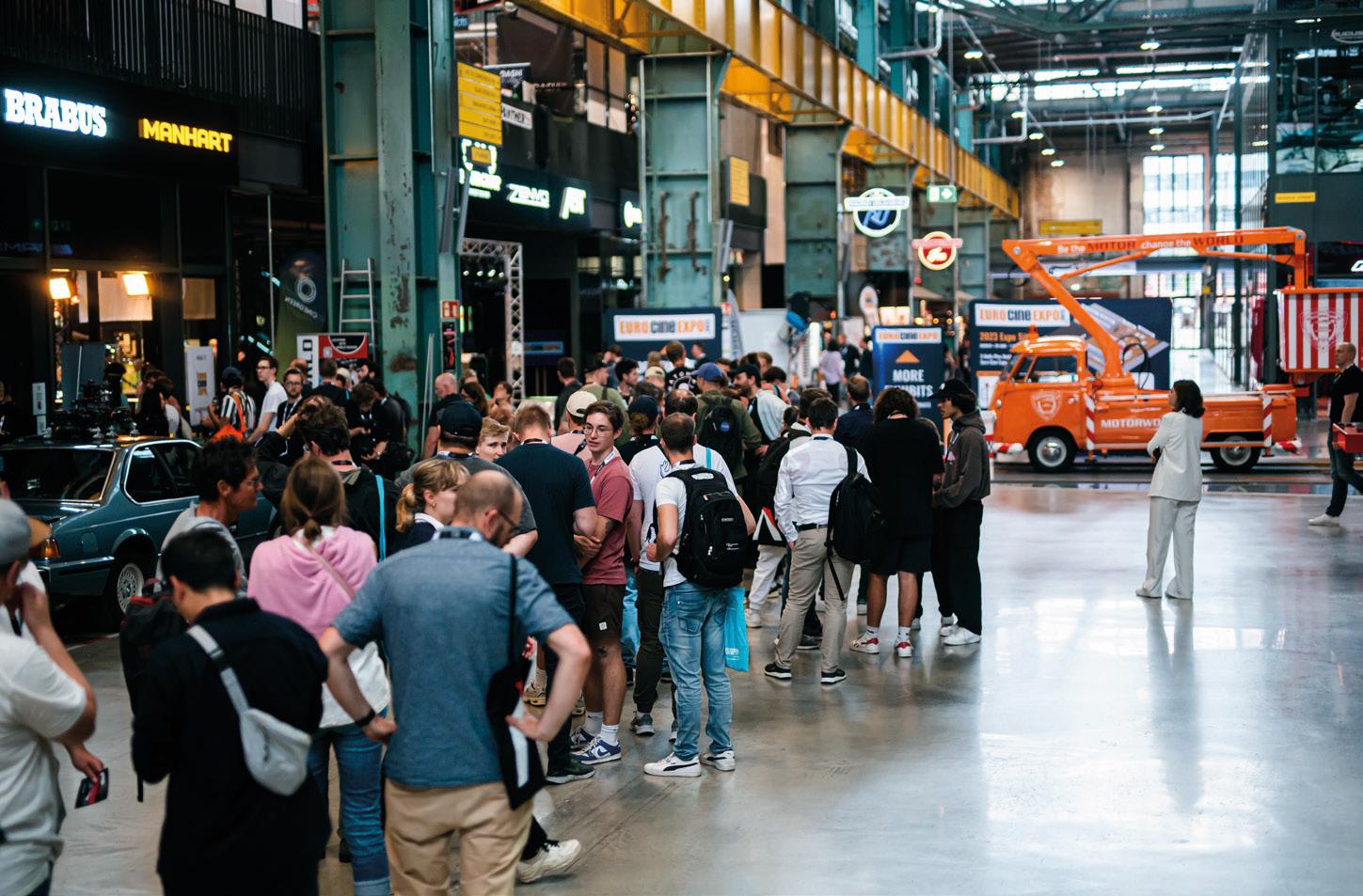
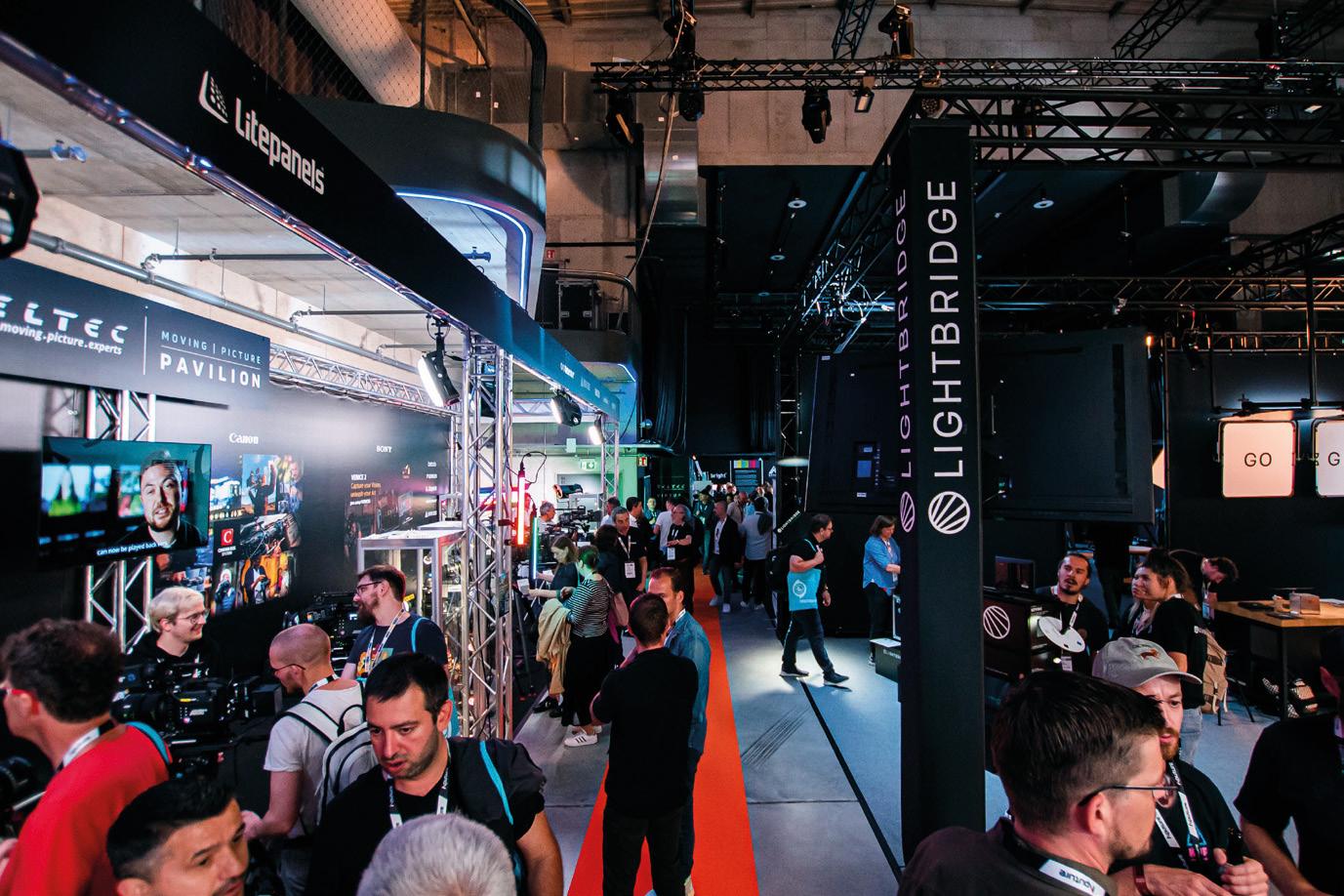

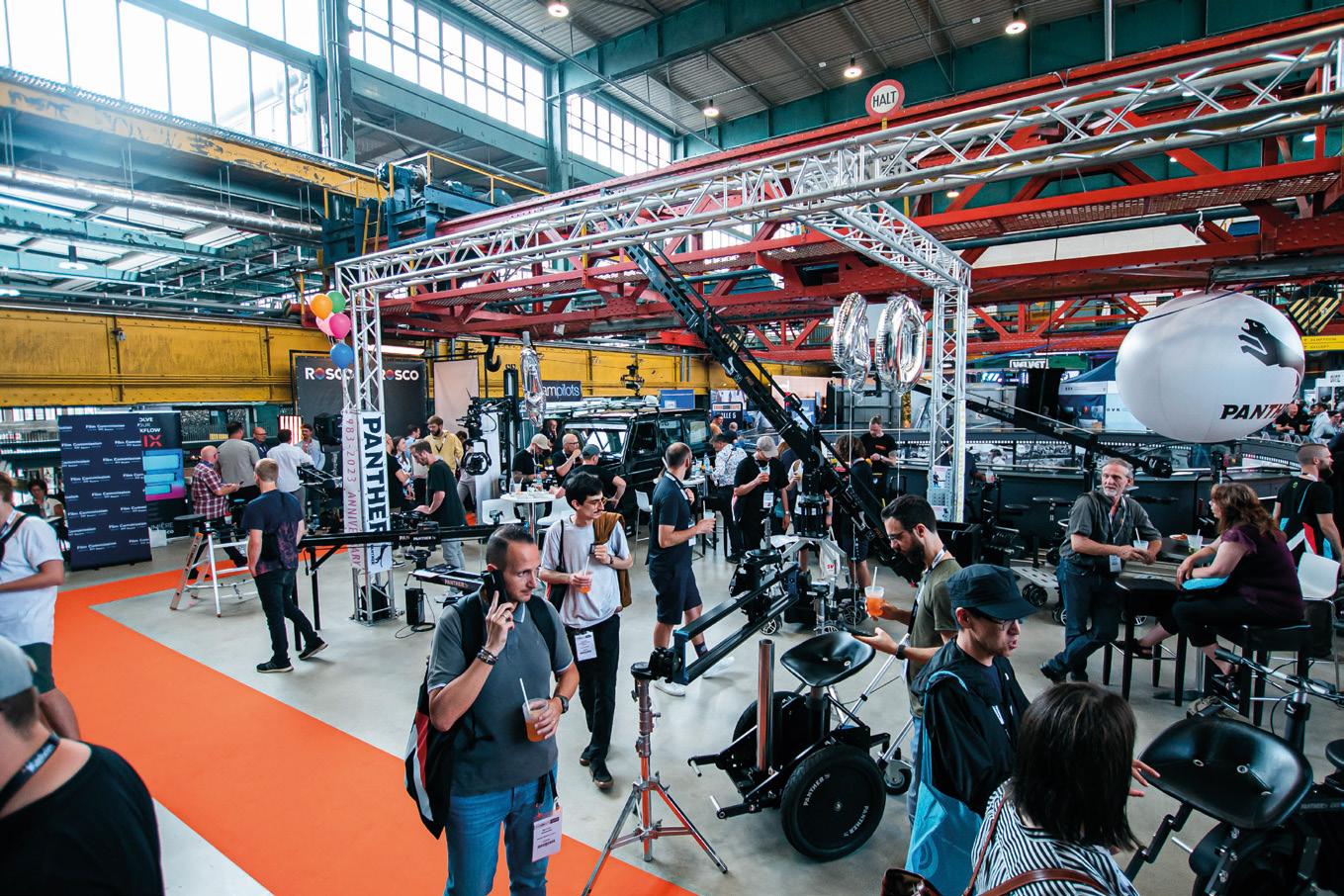
After a successful 2023 event, the Euro Cine Expo Team are pleased to announce the 2024 dates After a successful 2023 event, the Euro Cine Expo Team are pleased to announce the 2024 dates Keep updated at eurocineexpo.com and via Social Media Keep updated at eurocineexpo.com and via Social Media +44 1428 609 382 info@eurocineexpo.com 2024 EUROCINEEXPO.COM BE PART OF EUROPE’S FASTEST GROWING CINEMATOGRAPHY EVENT 27-29 JUNE 2024 EXPO AND SYMPOSIUM








































































































































































 Technical lead image science, ITC corporate member
Marc Shipman-Mueller –ARRI
Senior product manager camera systems Germany
Technical lead image science, ITC corporate member
Marc Shipman-Mueller –ARRI
Senior product manager camera systems Germany




























































 Images: BTS photos by Rafael Miralles.
Images: BTS photos by Rafael Miralles.




 Images: courtesy of Toby Strong.
Images: courtesy of Toby Strong.





























































































































 Cinematographer Larry Smith BSC
Cinematographer Larry Smith BSC








